Show HN Today: Discover the Latest Innovative Projects from the Developer Community
 ShowHN Today
ShowHN TodayShow HN Today: Top Developer Projects Showcase for 2025-06-22
SagaSu777 2025-06-23
Explore the hottest developer projects on Show HN for 2025-06-22. Dive into innovative tech, AI applications, and exciting new inventions!
Summary of Today’s Content
Trend Insights
1. **Embrace AI for Automation**: Look for repetitive, manual tasks and explore how AI, particularly computer vision and natural language processing, can automate them. This not only solves problems but creates new product opportunities. 2. **Mobile-First is Key**: Prioritize mobile accessibility. Ensure your projects can be used on mobile devices. 3. **Build for Yourself, Share with Others**: Many successful projects began as solutions to personal problems. Don't be afraid to share your solutions and build tools for your own use.
Today's Hottest Product
Name
Report idling vehicles in NYC (and get a cut of the fines) with AI
Highlight
This project uses AI to automatically extract information from videos of idling vehicles, filling out the necessary forms for reporting. The key innovation is automating a tedious process with AI, providing a mobile-first solution. Developers can learn from the application of AI for automating tasks, understanding the integration of different technologies (video processing, form filling) to solve a real-world problem.
Popular Category
AI
Mobile Development
Web Development
Game Development
Popular Keyword
AI
Open Source
API
Automation
Technology Trends
{"application":"This trend is valuable for developers because it shows how AI can be applied in many areas, like finance advisor, productivity tools, and more.","trend":"AI-powered automation for everyday tasks","value":"Using AI to automate previously manual processes, like reporting and data extraction, saves time and improves efficiency."}
{"application":"For developers, this underlines the importance of creating applications that are convenient and accessible on mobile devices, creating opportunities for new mobile applications and services.","trend":"Mobile-first application of complex tasks","value":"Building applications that allow complex tasks to be completed from a mobile device. This expands accessibility and usability."}
{"application":"Developers can explore how to build powerful, unique solutions by combining technologies. The use of AI with different tools.","trend":"Combining different technologies to build innovative solutions","value":"Many projects integrate multiple technologies to solve problems (e.g., AI with image processing, game development with graphics, and mobile app development)."}
{"application":"This trend is helpful for developers because open-source tools can increase productivity, facilitate collaboration, and promote code sharing. It also shows how you can build a tool that solves a problem for yourself and for other developers.","trend":"Open-source tools for developer productivity","value":"Several projects are releasing open-source tools that enhance developer workflows, such as code editing and automated deployments."}
Project Category Distribution
AI-powered Applications (30%)
Development Tools and Libraries (30%)
Mobile and Web Applications (30%)
Game Development (10%)
Today's Hot Product List
| Ranking | Product Name | Likes | Comments |
|---|---|---|---|
| 1 | Idle Reporter: AI-Powered Citizen Complaint Assistant | 151 | 205 |
| 2 | Lungy: Real-time Breathing Feedback with Interactive 3D Visualizations | 90 | 39 |
| 3 | LegoIsland.js: Retro Gaming with WebAssembly | 98 | 26 |
| 4 | Bunge Bits: AI-Powered Parliamentary Session Summarizer | 76 | 11 |
| 5 | Moocup: Instant Screenshot Beautifier | 36 | 28 |
| 6 | DOI2Reference: Instantly Get Paper References from DOI | 43 | 13 |
| 7 | Ariadne: Aperiodic Cryptography in Rust | 29 | 24 |
| 8 | Progressor: Goal Decomposition Engine | 31 | 17 |
| 9 | Sodalite: The Anonymous Media Retriever | 10 | 2 |
| 10 | Stacklane: Stacked PR Orchestrator | 7 | 4 |
1
Idle Reporter: AI-Powered Citizen Complaint Assistant
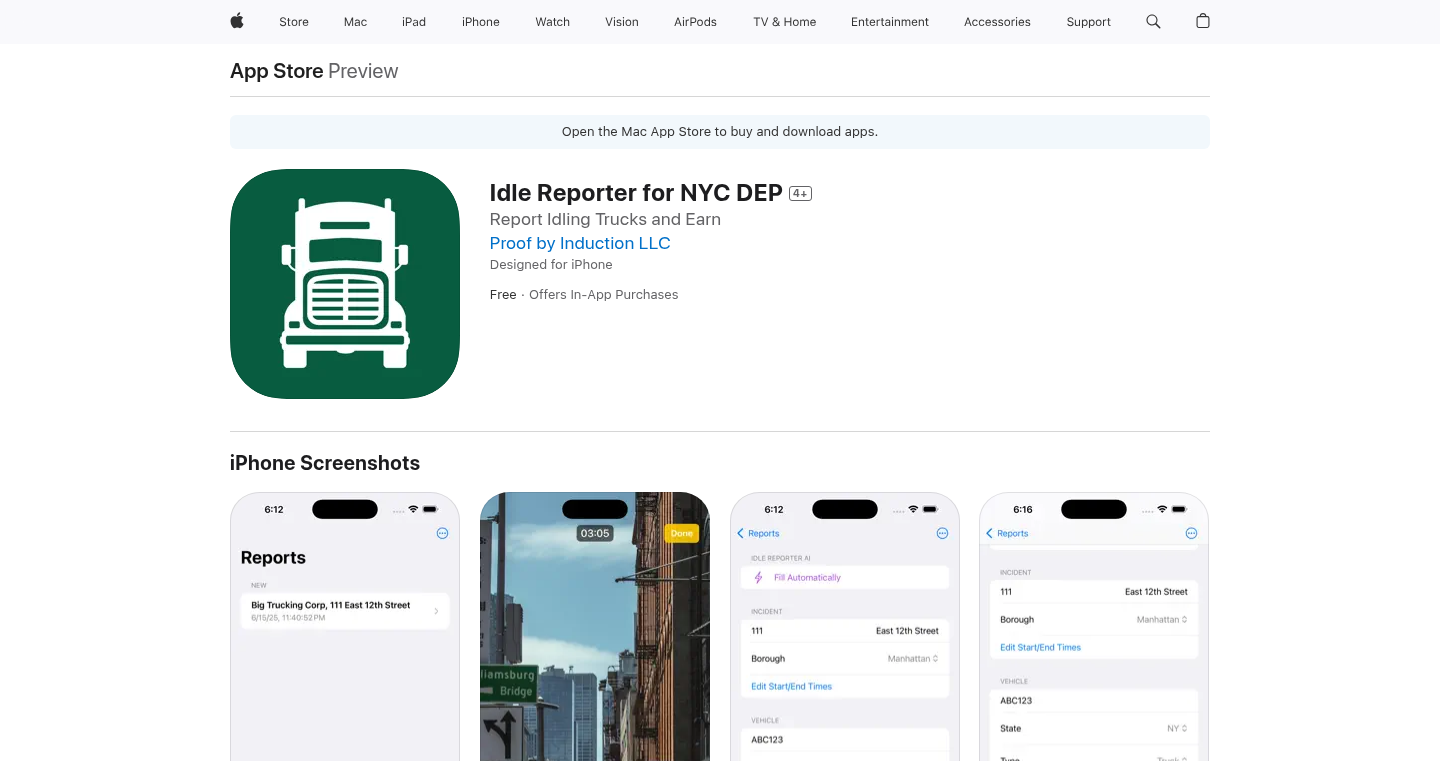
Author
rafram
Description
Idle Reporter streamlines the process of reporting idling commercial vehicles in New York City. It uses AI to automatically extract information from videos, fill out forms, and upload reports directly from your phone. The core innovation lies in its AI-powered automation, which significantly reduces the time and effort required to file complaints. This tackles the frustrating manual data entry and multi-app workflow previously needed.
Popularity
Points 151
Comments 205
What is this product?
Idle Reporter is an iOS app designed to simplify reporting idling vehicles, allowing users to receive a portion of the fines collected. It uses AI to analyze videos, identify and extract crucial information (like vehicle details and timestamps), and automatically fill out the necessary forms. This leverages Computer Vision and Natural Language Processing (NLP) to analyze video content, converting visual data into actionable text-based information. The free features provide a timestamp camera and manual form filling. This saves users significant time and reduces the risk of errors compared to manual reporting. So this allows me to easily report idling vehicles and potentially get a cut of the fines without the hassle.
How to use it?
Download the iOS app. Record a video of an idling vehicle (or upload an existing one). The AI analyzes the video and extracts necessary information, pre-filling the report form. Users can review the data, make any necessary edits, and submit the report directly through the app. A subscription unlocks the AI features, while other features (like timestamp camera) are free. So you can start reporting idling vehicles within minutes using just your phone.
Product Core Function
· {"applicationScenario":"When you witness an idling vehicle, simply record a video, and the app will handle the information gathering.","functionName":"AI-Powered Video Analysis and Data Extraction","technicalValue":"Reduces the tedious manual effort required to manually gather information. Leverages AI for automation of report creation.","userBenefit":"Saves considerable time and effort, making reporting quick and easy, and reducing the possibility of human error. So I can quickly report the violation without spending a lot of time transcribing information.","description":"The app uses AI to automatically identify and extract relevant information from video footage, like license plate numbers, vehicle type, and timestamps. This is achieved through computer vision and OCR (Optical Character Recognition) technologies. This eliminates the need for manual data entry."}
· {"applicationScenario":"After the AI extracts the data, the user can immediately submit the report, saving time and effort.","functionName":"Automated Form Filling and Submission","technicalValue":"Streamlines the reporting workflow and makes it easier to submit complaints. It automates the tedious data input.","userBenefit":"Drastically reduces the time it takes to file a complaint. So I can report violations without struggling with online forms.","description":"After extracting the necessary information, the app automatically fills out the required forms for reporting. Users can then review and submit the reports within the app."}
· {"applicationScenario":"When documenting an idling vehicle, capture the video and automatically include a timestamp and other needed visual evidence within one app.","functionName":"Timestamp Camera","technicalValue":"Simplifies the process of recording and documenting evidence and removes a step from the workflow.","userBenefit":"It solves the problem of having to use multiple apps to record and process video. So it removes complexity and improves the user experience.","description":"The app features a built-in timestamp camera which helps to comply with requirements of reporting idling vehicles. This feature is completely free and can replace multiple apps."}
Product Usage Case
· {"problem":"Manually collecting information from video footage (license plate, timestamps) and filling out online forms is time-consuming and error-prone.","solution":"Use Idle Reporter to record a video, let the AI automatically extract the required data, and then submit the report within the app. This reduces the process from perhaps 15 minutes to under 5 minutes.","scenario":"Reporting Idling Delivery Trucks","benefit":"Saves significant time and simplifies the reporting process, encouraging more people to report violations and take action. So I can quickly report violations when I see them."}
· {"problem":"The current manual process discourages citizen participation due to its complexity.","solution":"By making the reporting process easier and more accessible, Idle Reporter can empower more citizens to report idling vehicles, contributing to cleaner air and reduced pollution. The free features make the core functionality available to all.","scenario":"Community Advocacy","benefit":"Increases citizen engagement in environmental protection efforts. It reduces the barrier to entry. So I can contribute to improving the air quality in my community."}
2
Lungy: Real-time Breathing Feedback with Interactive 3D Visualizations
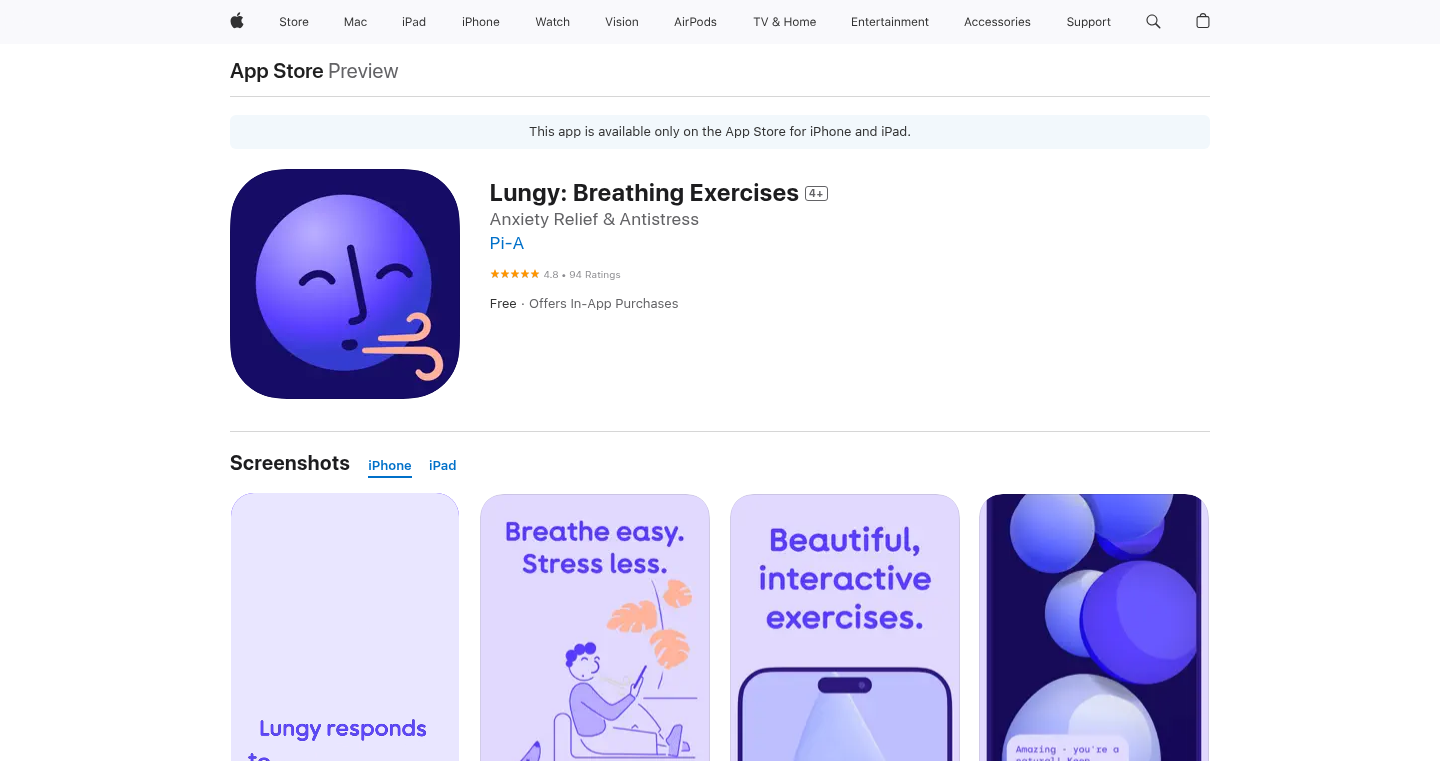
Author
lukko
Description
Lungy is an iOS app that uses your phone's microphone to detect your breathing and provides real-time interactive 3D visuals in response. It's designed to make breathing exercises more engaging and beneficial, offering customizable exercises, learning modules, and a premium version with expanded features. A version is also available for the Vision Pro, called 'Lungy Spaces'. The core technology involves Metal for 3D graphics, AudioKit for audio feedback, and machine learning for improved breath detection. This project addresses the problem of patient non-adherence to breathing exercises by gamifying the experience.
Popularity
Points 90
Comments 39
What is this product?
Lungy is a mobile app that turns breathing exercises into a fun and engaging experience. It uses your phone's microphone (and optionally, the camera) to analyze your breath in real-time. The app then translates your breath into dynamic, interactive 3D visuals – think objects inflating and deflating in sync with your breath, or fluid simulations responding to your pace. It also provides audio feedback using a built-in synthesizer, creating a calming and stimulating experience.
This app is a creative solution, tackling the problem of boring, repetitive breathing exercises typically used in physical therapy and stress reduction. The core innovation lies in the real-time interaction of breath with 3D visuals and audio. It’s an attempt to improve patient engagement by making the process more interesting and less clinical, integrating technology like Metal (for graphics), AudioKit (for audio), and machine learning (for improved breath detection) to create a truly unique experience.
So, why is this cool? Because it makes a potentially boring task – breathing exercises – into a visually appealing and interactive experience. This helps you stick with the exercise and feel more relaxed.
How to use it?
You can download the Lungy app on your iOS device (iPhone or iPad) or use the Vision Pro version, 'Lungy Spaces'. The app works by listening to your breath through your device's microphone. You then follow the on-screen prompts and the 3D visuals will react to your breath in real-time. The free version gives you access to a new breathing exercise each day. The premium version unlocks a library of exercises, allowing you to customize your practice. The integration is as simple as downloading the app from the App Store and following the prompts. No special hardware is needed.
For developers, the core technologies used (Metal, AudioKit, etc.) can be a source of inspiration. The app shows how you can combine these technologies to build a responsive and engaging user experience for physical or mental health applications. It demonstrates how simple sensors (like a microphone) can trigger complex visual and audio outputs. This could inspire developers to think creatively about how to incorporate sensory feedback into their own applications, whether it's for wellness, gaming, or other areas. The app's source code might become available in the future.
Product Core Function
· {"techDetails":"Uses the device's microphone to monitor your breath, feeding it into 3D rendering engines written using Metal. These engines create interactive visuals that respond to your breath, such as inflating objects or fluid simulations. The visuals are designed to give immediate feedback on your breathing rhythm.","functionName":"Real-time Breath Detection with Interactive Visuals","value":"This function provides a fun and engaging way to practice breathing exercises. The real-time feedback helps you to regulate your breath and track your progress. It makes a normally boring task far more interesting. So, this feature helps you actively focus on breathing and make it enjoyable. "}
· {"techDetails":"Allows users to adjust the timing of each breath phase (inhale, exhale, hold). The app provides a range of pre-set exercises, with options to build and save custom routines. You can choose the duration of each breath and the pace. This feature is built for personal and dynamic usage.","functionName":"Customizable Breathing Exercises","value":"Tailoring the exercises to your needs is important. You can create a program that precisely matches your physical state, whether you want to relieve stress or enhance lung capacity. So, this feature allows you to get the most out of your breathing sessions, making the program useful and adaptable."}
· {"techDetails":"Incorporates a polyphonic synthesizer (AudioKit) that generates sounds based on your breath. It uses a sequencer to play notes from a chosen musical scale. This provides auditory feedback, enhancing the immersive experience and creating a sense of calm.","functionName":"Interactive Audio Feedback","value":"The sound component adds another layer of immersion. The music is directly linked to your breath, which improves the overall experience, and enables relaxation and mindfulness during your breathing practices. Therefore, this feature improves the enjoyment of breathing exercises."}
· {"techDetails":"Offers learning modules on topics like self-care techniques for managing anxiety. Provides additional breathing indicators, such as breath counting, and a premium version unlocking extra content and data.","functionName":"Learning Modules and Additional Features","value":"These features provide educational information on breathing techniques. They are made to help users understand the relationship between breathing and their physical and mental state, providing guidance and tools to deal with problems like anxiety. So, these extra features provide a holistic approach to well-being."}
Product Usage Case
· {"scenario":"Managing Anxiety and Stress","description":"Users can use Lungy to guide them through specific breathing exercises designed to alleviate anxiety symptoms. The real-time visual feedback and soothing audio help in focusing on the breath, promoting relaxation and reducing stress levels. You can practice the exercises for a set time, using pre-made programs or tailored ones, to improve the breath and reduce stress. The app can be used anytime, anywhere, to calm down and feel more at ease.","value":"So, you can utilize Lungy to develop a regular practice to alleviate anxiety and promote calmness."}
· {"scenario":"Pulmonary Rehabilitation (Future Vision)","description":"The project aims to release a medical device version for patients with asthma. This platform will provide structured breathing exercises for lung rehabilitation, where the interactive visuals and feedback will encourage patients to stick with their therapy programs, leading to better health results. The gamified style can turn a medical process into an exciting one.","value":"For healthcare professionals, this offers a novel approach to patient care. It encourages patient engagement, making therapy more enjoyable and potentially improving health results. So, this helps to increase patient compliance, and enhance treatment."}
· {"scenario":"General Wellness and Mindfulness","description":"Anyone can use Lungy to enhance their breathing techniques for mindfulness, relaxation, or general wellness. The customizable exercises, coupled with the engaging visuals and audio, make it a fun tool to improve breath awareness and overall well-being. By following the programs, the user can improve their breath awareness, feel calmer, and develop better focus.","value":"So, this lets you add a fun, interactive component to your wellness routine, making breathing exercises more engaging and efficient."}
3
LegoIsland.js: Retro Gaming with WebAssembly
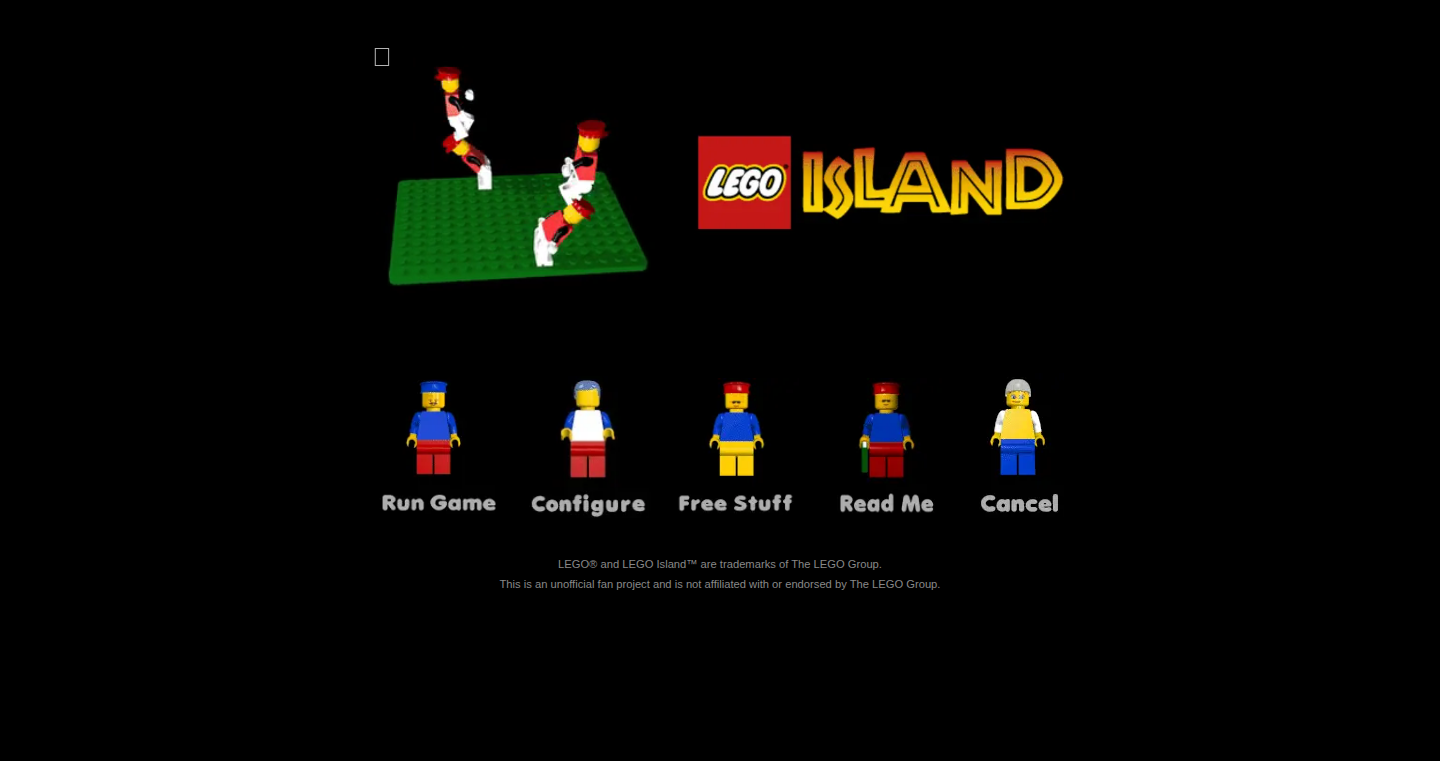
Author
foxtacles
Description
This project allows you to play the classic Lego Island game directly in your web browser. It's innovative because it leverages WebAssembly (Wasm) to emulate the original game's environment and logic, offering a nostalgic gaming experience without needing to install anything. It tackles the challenge of porting a complex, old game to a modern platform by utilizing Wasm's performance benefits and cross-platform compatibility.
Popularity
Points 98
Comments 26
What is this product?
This project is essentially a Lego Island emulator that runs in your browser. The magic behind it lies in WebAssembly (Wasm). Wasm is a technology that allows you to run code compiled from languages like C++ (the language Lego Island was likely written in) directly in your browser at near-native speeds. This means the browser can handle the game’s graphics, physics, and game logic efficiently. It's innovative because it takes an older game and makes it playable on modern devices without requiring any special plugins or software installations. So this helps preserve and make accessible a piece of gaming history, and shows the potential of Wasm for game emulation.
How to use it?
Developers and users simply need a modern web browser. The emulator runs entirely within the browser. The game assets (the game files) are loaded, and the Wasm code then emulates the original game's behavior. This showcases how developers can utilize Wasm to bring older game experiences to modern platforms. From a developer perspective, this suggests a great example of how to use Wasm to bring back old games and make them accessible to everyone by integrating into websites with a simple URL. This means, if you're a developer who loves old games, you could create websites that feature these games, make them accessible to a wider audience, or even experiment with adding new features or modifying the game logic.
Product Core Function
· {"applicationScenario":"Allows users to play the original Lego Island game in their browsers.","functionName":"WebAssembly-based Emulation","description":"The heart of the project is the use of WebAssembly to run the original game code within the browser. This means the game runs quickly and smoothly without the need for plugins. This allows for a more stable gaming experience across different browsers and devices. The value here is in demonstrating Wasm's power to emulate legacy applications. So this means, if you have an old application, there may be a way to make it accessible again with this new technology."}
· {"applicationScenario":"Players can enjoy the game on any device that supports a web browser, enhancing the game's accessibility.","functionName":"Cross-Platform Compatibility","description":"Since it runs in the browser, the game is playable on any device with a web browser, no matter the operating system. This eliminates the need for specific hardware or software to run the game. The value is in expanding accessibility. So this allows old games to reach a much broader audience, irrespective of their operating system or hardware limitations."}
· {"applicationScenario":"Players simply visit a webpage to play the game without any installation procedures.","functionName":"No Installation Required","description":"Users do not need to download or install any software to play the game, providing a streamlined and easy-to-use experience. This simplifies the user experience and reduces barriers to entry. The value here is about simplifying accessibility. So, the user can jump directly into playing the game and not get bogged down by installation processes."}
Product Usage Case
· {"useCase":"Retro Gaming Preservation","solution":"Leveraging Wasm to create a highly efficient and compatible emulation environment within the browser.","description":"The primary use case is preserving and making accessible classic games like Lego Island. By using WebAssembly, this project ensures these games can be played on modern devices even when original support has been discontinued. This highlights how technology can be applied to safeguard gaming history.","technicalChallenge":"Porting and emulating the original game’s environment and logic to a web environment."}
· {"useCase":"Web-Based Game Development","solution":"The use of Wasm showcases an effective solution to run complex programs efficiently in a web environment.","description":"This project inspires developers by demonstrating how to build complex, high-performance applications directly in the browser, using modern web technologies. It's not just about games but also about showing how a modern web browser can do much more than just display a website.","technicalChallenge":"Implementing a fully functioning game within a web browser."}
4
Bunge Bits: AI-Powered Parliamentary Session Summarizer
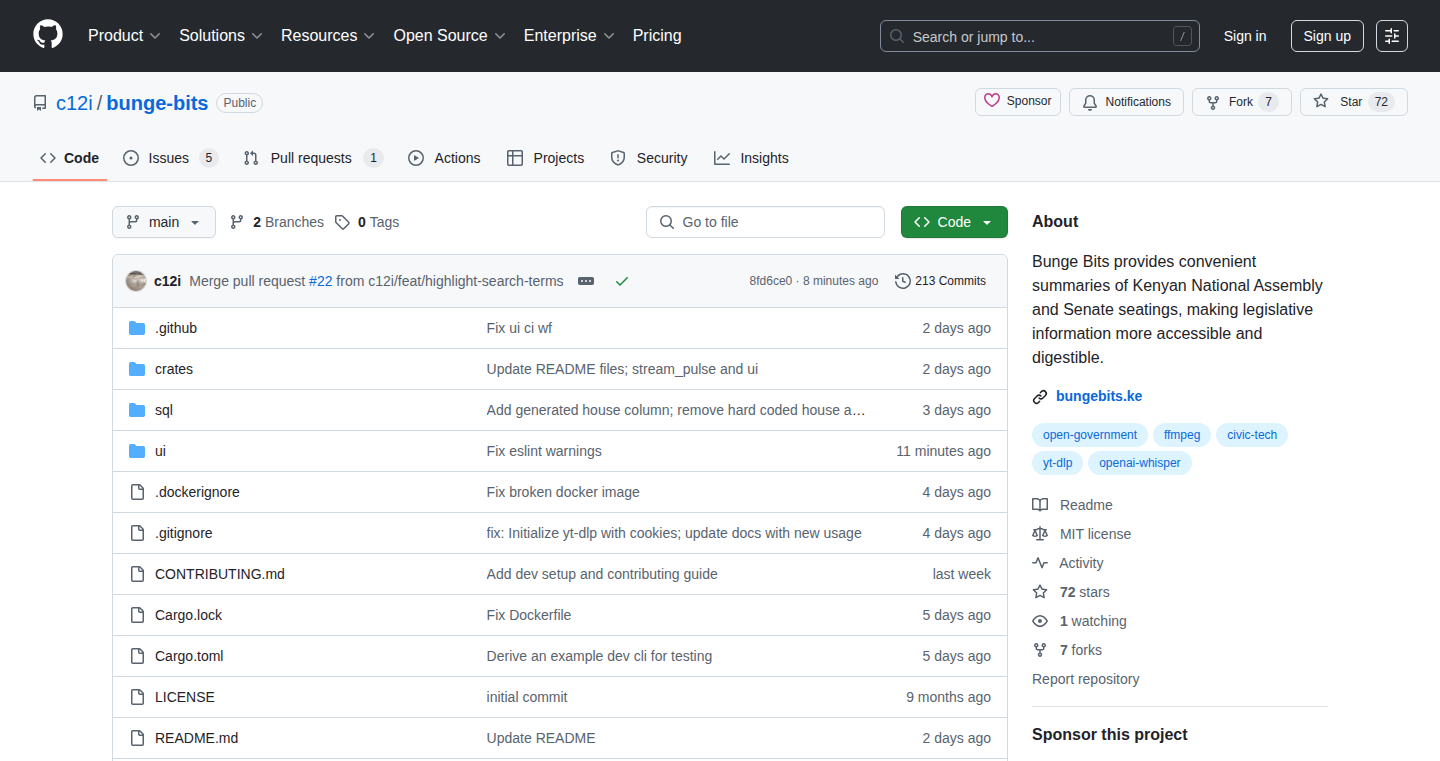
Author
collinsmuriuki
Description
Bunge Bits is a tool that automatically summarizes long parliamentary sessions from the Kenyan National Assembly and Senate. It leverages cutting-edge technologies like Rust, Whisper v3 (an open-source speech-to-text model), and GPT-4o (a powerful language model) to transcribe, break down, and summarize lengthy sessions, making political content easily accessible and searchable for the public. The innovative aspect lies in its ability to handle multilingual audio (English and Swahili), and efficiently condense hours of content into concise summaries. So, it allows you to quickly grasp key discussions and decisions, saving you valuable time and effort.
Popularity
Points 76
Comments 11
What is this product?
Bunge Bits is essentially an AI-powered news aggregator for Kenyan parliamentary proceedings. It works by first using Whisper v3, a sophisticated speech recognition model, to transcribe the audio of the sessions into text. Then, it breaks down the transcribed text into manageable chunks. Finally, it employs the advanced capabilities of GPT-4o, a large language model, to summarize each chunk, providing a clear and concise overview of the discussions. The core innovation is its ability to process multilingual audio (English and Swahili), something that can be challenging for traditional transcription and summarization tools. So, it gives you easy access to crucial political information.
How to use it?
Developers can leverage Bunge Bits by integrating its summarization capabilities into their own applications. While the Show HN doesn't expose a specific API, the underlying technologies used (Whisper and GPT-4o) are readily available. Developers could build their own interfaces to transcribe and summarize audio from any source, such as podcasts, meetings, or lectures. They can use the transcript and the summary data for further analysis and integration with existing tools. So, you can build your own content processing pipelines and make information more accessible for your users.
Product Core Function
· {"functionName":"Multilingual Transcription (Whisper v3)","description":"The system accurately transcribes parliamentary sessions recorded in both English and Swahili. The use of Whisper v3, an open-source speech recognition model, is key. This is a big step forward because it handles multiple languages. This makes it easy to create text from audio. So, if you're working with multilingual audio, this technology saves you the hassle of manually transcribing it.","value":"Efficiently converts spoken content into text for further processing and analysis. This provides a base from which analysis can take place. So, if you're working with multilingual audio, this technology saves you the hassle of manually transcribing it."}
· {"functionName":"Content Chunking","description":"Breaks the long transcriptions into smaller, more manageable segments, allowing for efficient processing by the summarization engine. This is crucial because large language models often have limitations on the amount of text they can process at once. Think of it like breaking a big book into chapters. So, this enables efficient summarization of long content.","value":"Optimizes processing and improves the accuracy and coherence of the summaries by reducing the complexity of the input for the language model. So, it makes summarizing large pieces of text possible."}
· {"functionName":"AI-Powered Summarization (GPT-4o)","description":"Utilizes the GPT-4o language model to generate concise and informative summaries of each chunk. GPT-4o understands the context and key points discussed. The generated summaries provide a quick overview. It uses advanced AI to understand the text. So, this lets you get the main points quickly.","value":"Provides a distilled overview of the session, saving users considerable time and effort by quickly identifying the key issues discussed, decisions made, and the overall tone of the proceedings. So, you can read less and understand more."}
· {"functionName":"Searchability and Accessibility","description":"The summaries make the content searchable. The text generated from the audio can be searched. This provides instant access to the content. So, you can use this to instantly search through lengthy sessions and find the information you need.","value":"Improves accessibility for the public by making political content more easily discoverable and consumable. So, it helps you find important information."}
Product Usage Case
· {"scenario":"Citizen Journalism Application","description":"A news website could integrate Bunge Bits to automatically generate summaries for all parliamentary sessions. This would make political content more accessible to their readers, increasing engagement and providing deeper insights into the decisions being made. This could also allow the user to quickly review all the transcripts to get a fast overview.","technicalBenefit":"Automates content creation, freeing journalists from manual transcription and summarization tasks, allowing them to focus on analysis and reporting. So, journalists can deliver information faster, giving them more time for analysis."}
· {"scenario":"Political Research Tool","description":"Researchers can use Bunge Bits to quickly analyze large amounts of parliamentary data. They can search for specific topics, track the evolution of policies, and identify key players and their positions. This is a powerful way to analyze the data.","technicalBenefit":"Provides efficient data mining and analysis capabilities, enabling researchers to uncover trends, relationships, and insights that would be difficult or impossible to find manually. So, it makes deep analysis of political information possible."}
5
Moocup: Instant Screenshot Beautifier
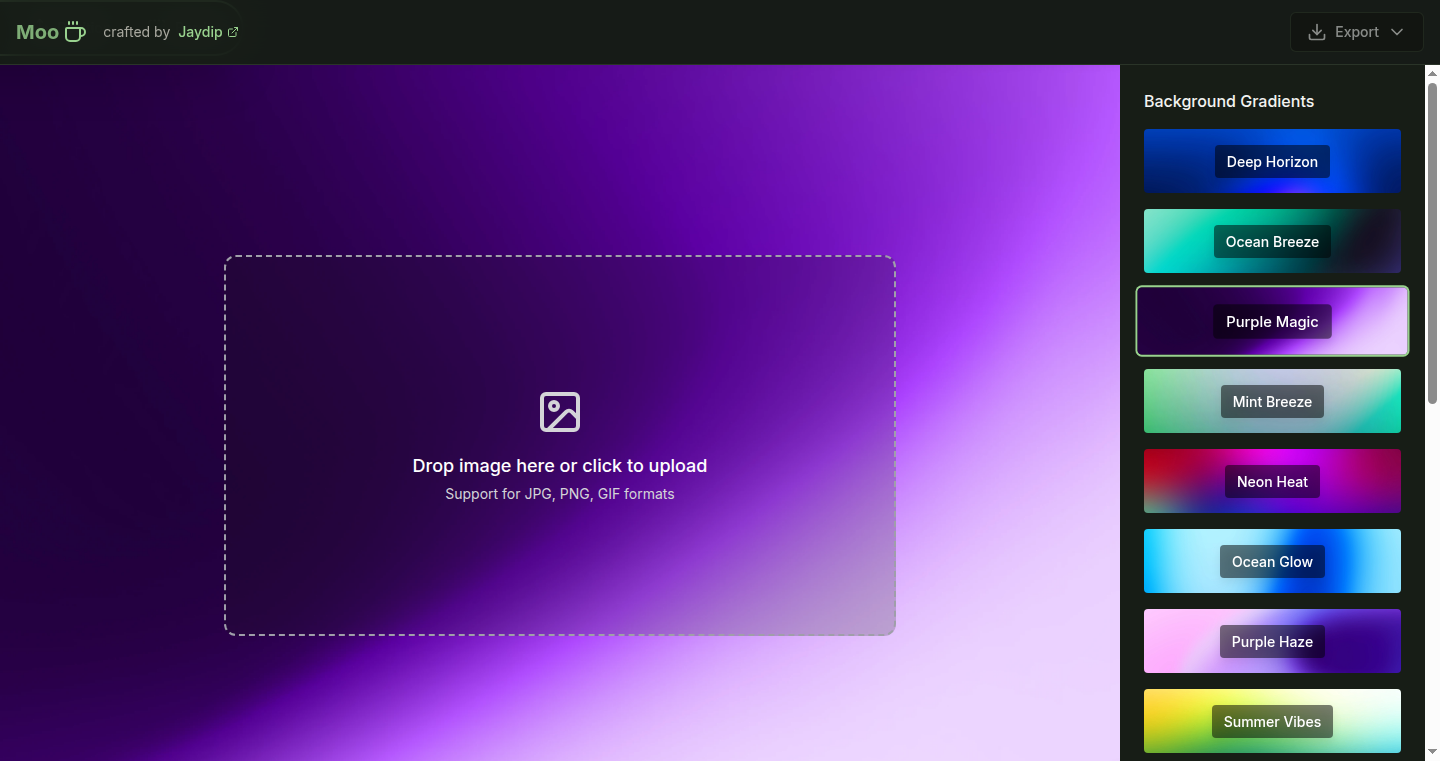
Author
jdsane
Description
Moocup is a simple yet powerful tool that lets you quickly style and beautify your screenshots. The core innovation is its ability to apply pre-designed, hand-picked gradients to screenshots with minimal effort, transforming bland images into visually appealing presentations. It addresses the common problem of developers and designers struggling to make their work stand out in crowded online spaces. By providing a fast and intuitive interface, Moocup allows users to create eye-catching visuals in seconds, enhancing their portfolio or project showcases without requiring complex design skills.
Popularity
Points 36
Comments 28
What is this product?
Moocup is a web-based tool. You upload a screenshot, choose from a curated collection of gradients, style the image, and then export it. The innovative aspect lies in its focus on speed and simplicity. It eliminates the need for complex graphic design software by offering a streamlined process for adding visual flair to screenshots. It’s technically built using web technologies (likely JavaScript, HTML, and CSS) to render the interface and apply image manipulations. This is a rapid way to visually enhance screenshots for presentations, social media, or showcasing designs. So this tool is great if you want to make your work look more polished and attractive quickly.
How to use it?
Developers and designers use Moocup to create visually stunning presentations of their work. You simply upload a screenshot of your app or website, select a gradient style, and download the enhanced image. The tool is integrated into your workflow as a fast and simple way to create compelling visuals for any project. For example, when you're showing your code or a UI design on a platform like Hacker News, a Moocup-styled screenshot will make your project look much more appealing. So you can easily integrate this tool into your workflow to quickly add flair to your work to impress others.
Product Core Function
· {"feature":"Screenshot Upload","application":"Essential for creating visually impressive presentations that grab attention.","techValue":"Standard file handling using web APIs, which is the foundation for all the other functions.","description":"Allows users to upload a screenshot from their device. This is the entry point for the entire beautification process. So, it allows you to start with any image of your choosing."}
· {"feature":"Gradient Selection","application":"Enables instant beautification of your screenshot with various eye-catching styles without requiring design skills.","techValue":"CSS-based color manipulation and image rendering techniques. So, you can create different effects with color.","description":"Provides a library of pre-designed gradients. This is the core of the visual enhancement. It removes the need to design anything from scratch. So you can choose from a diverse set of gradients to style your screenshot."}
· {"feature":"Styling Options","application":"Ensures the final image perfectly aligns with the user's aesthetic preferences.","techValue":"User interface and front-end programming to provide user-friendly customization options.","description":"Offers styling choices for fine-tuning the appearance. This might include adjustments to the gradient’s position, or other visual elements. So, this allows for specific customization of your screenshot."}
· {"feature":"Export","application":"Facilitates easy sharing and use of the styled screenshot in presentations, portfolios, and social media.","techValue":"Image encoding and file saving methods to get the final output.","description":"Enables downloading the styled screenshot in a common image format. This facilitates sharing the image easily across different platforms. So, you can download your styled image and share your work with others."}
Product Usage Case
· {"solution":"Moocup helps the app stand out in a crowded field of submissions, increasing its visibility and drawing more attention to the features and design. It helps people better understand your work.","scenario":"Showcasing a new app on Hacker News","techValue":"Easy image manipulation without complex tools, and the power to instantly make the screenshot visually appealing.","description":"A developer wants to share a new application on Hacker News. Instead of a plain screenshot of the app’s interface, they use Moocup to apply a stylish gradient and enhance its overall presentation. So, the presentation is enhanced and is eye-catching."}
· {"solution":"Moocup provides a fast, efficient way to produce high-quality images that enhance the overall aesthetic of their portfolio. It will make your work more appealing to potential clients.","scenario":"Creating a portfolio for a design website","techValue":"Simplifies image styling and enhances overall design.","description":"A designer is building a portfolio website and wants to showcase their projects professionally. They use Moocup to create visually appealing screenshots of their work with unique styles."}
6
DOI2Reference: Instantly Get Paper References from DOI
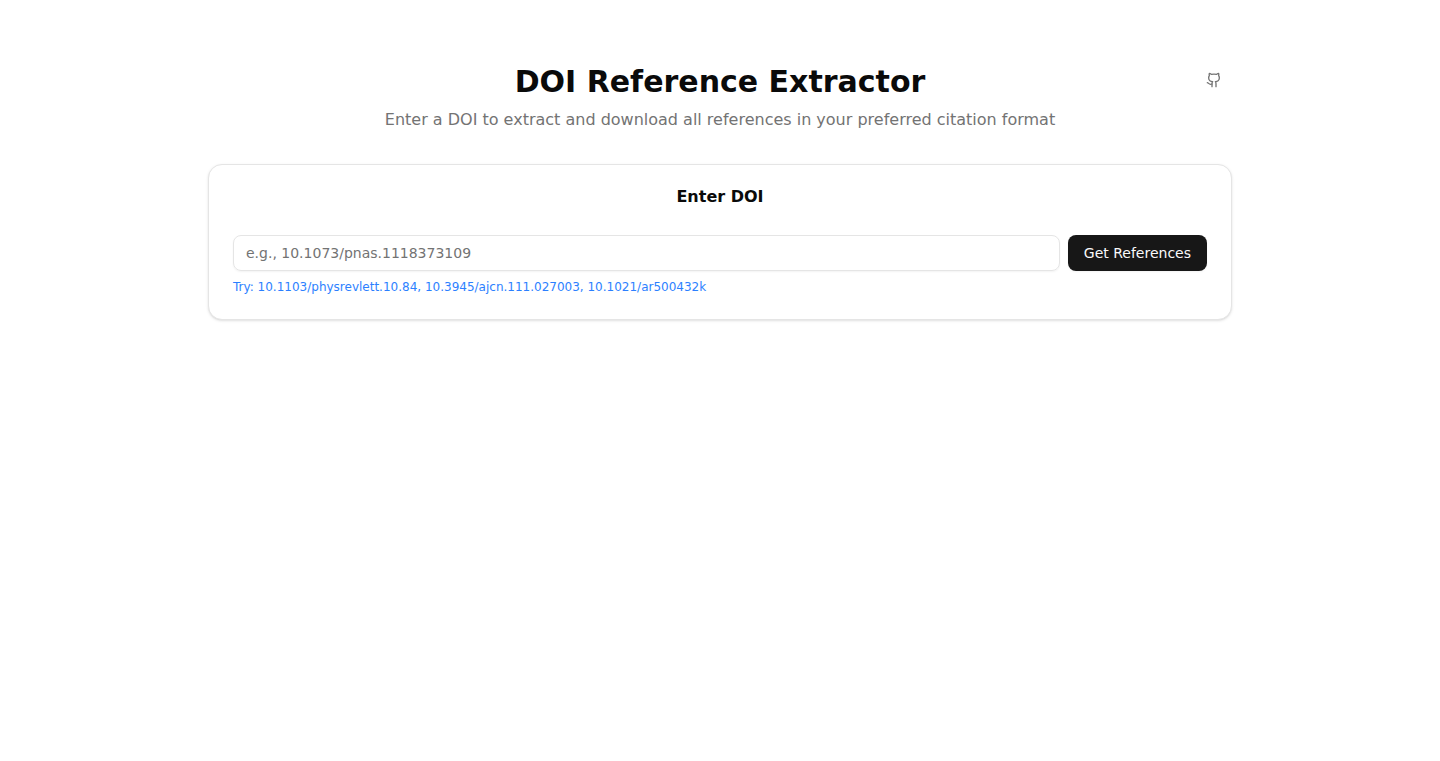
Author
mireklzicar
Description
This project provides a tool to instantly convert a paper's DOI (Digital Object Identifier) into its full reference list in formats like BibTeX and RIS. It addresses the common pain of manually formatting citations when writing academic papers or compiling bibliographies, automating a tedious and error-prone task. The core innovation lies in automating the retrieval and conversion of citation data, streamlining the research and writing process.
Popularity
Points 43
Comments 13
What is this product?
DOI2Reference is essentially a 'DOI to citation' converter. It takes a paper's unique DOI number (like a digital fingerprint for research papers) as input, and then automatically fetches the paper's bibliographic information (title, authors, journal, publication date, etc.) from various databases. Finally, it converts this information into different citation formats, such as BibTeX (commonly used with LaTeX for typesetting) and RIS (compatible with reference management software like Zotero or Mendeley).
The innovation lies in automating the entire process, replacing manual lookups and formatting. It simplifies the tedious task of creating accurate bibliographies and integrating citations into your work, saving researchers and writers significant time and effort.
How to use it?
Developers can use DOI2Reference by providing the DOI number as input, either via a web interface or potentially through an API integration. This allows developers to build tools that automatically incorporate citations into their document processing or reference management workflows. For example, you could integrate this tool into a custom note-taking app, allowing users to instantly generate citation information when saving a paper's DOI.
So, you can use it to create integrations with any application that requires citations, like a document editor, reference management tools, or a specialized research platform.
Product Core Function
· {"functionName":"DOI Input and Data Retrieval","description":"The core function is taking a DOI as input and then querying various academic databases (like Crossref or DataCite) to retrieve the paper's metadata. This involves making API requests to the databases and handling the responses, which might require dealing with different data formats and potential errors. This is valuable because it automates the data fetching process, eliminating the need for manual database searches. This is very useful if you work a lot with research papers.","value":"So, this lets you skip manually searching for the paper's metadata in various databases. It's all automated!"}
· {"functionName":"Format Conversion (BibTeX, RIS, etc.)","description":"Once the bibliographic data is obtained, the tool converts it into different citation formats like BibTeX and RIS. This requires implementing conversion logic for each format, mapping the data fields from the retrieved metadata to the corresponding fields in the target format. This is valuable because it allows users to easily integrate the citations into their chosen document processing or reference management software. You'll save a lot of time.","value":"So, it lets you easily import citations into your preferred document editor or reference manager, avoiding the time-consuming process of manual formatting."}
· {"functionName":"Error Handling and Data Cleaning","description":"This involves handling potential issues such as invalid DOIs, database errors, and inconsistent data. It may include data cleaning steps to ensure the accuracy and consistency of the output. This is valuable because it improves the robustness of the tool and ensures that users receive accurate and reliable citations. This is important for a user-friendly and reliable experience.","value":"So, this ensures the tool is resilient to errors and gives you the correct and accurate citation data, reducing potential problems."}
Product Usage Case
· {"scenario":"Research Paper Writing","description":"A researcher is writing a paper and needs to cite numerous sources. Instead of manually searching for each paper's citation details and formatting them, they simply input the DOIs into DOI2Reference and instantly generate the citations in BibTeX format to use with LaTeX. This significantly speeds up the citation process.","value":"So, you can quickly get correct citations without spending a lot of time manually searching for and formatting the citations."}
· {"scenario":"Reference Management Software Integration","description":"A developer wants to integrate citation retrieval into their reference management software. They can use DOI2Reference's API (if available) or integrate the functionality directly into their software to automatically fetch citation data when a user enters a DOI. This enhances the software's functionality, simplifying the user experience.","value":"So, this could be integrated into reference management tools to get the citation information automatically, making the user experience much easier."}
7
Ariadne: Aperiodic Cryptography in Rust
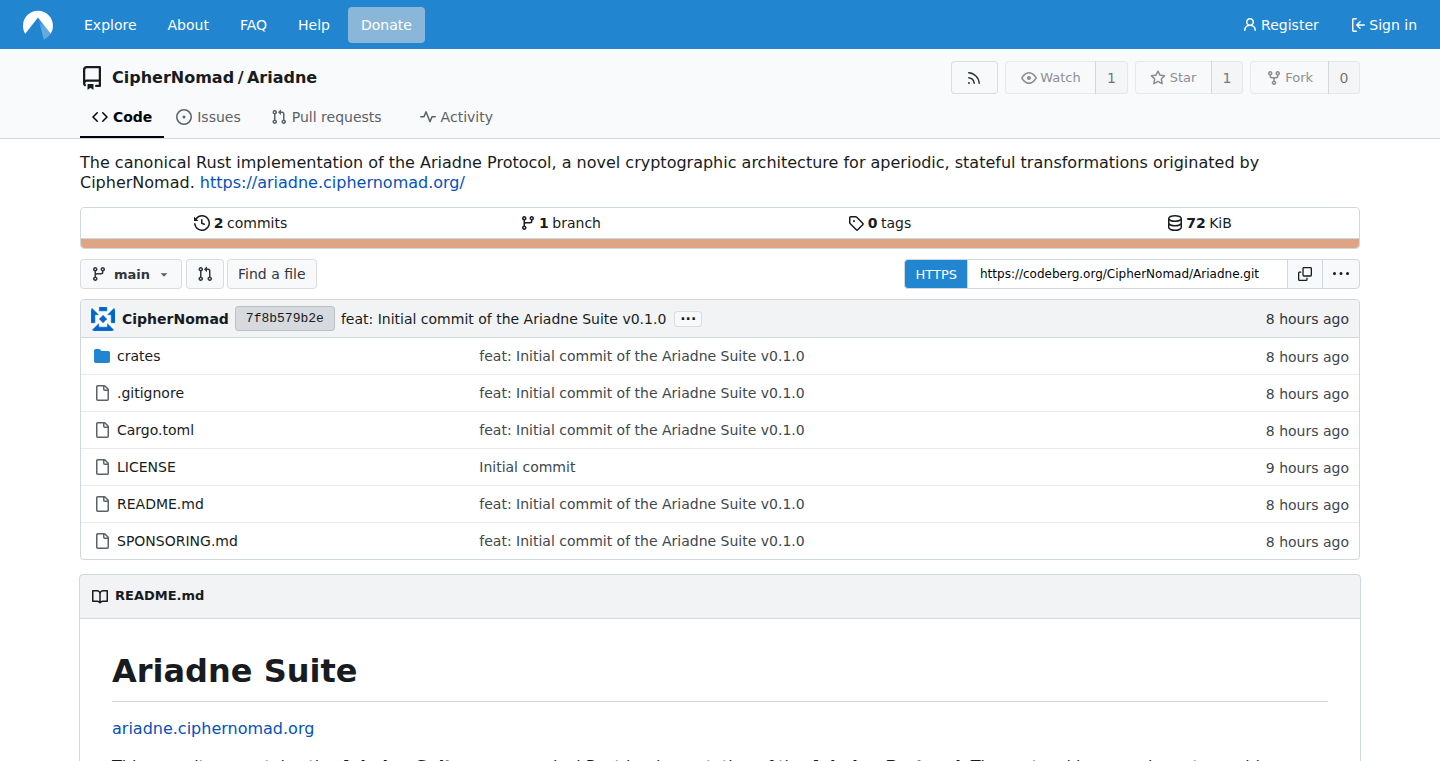
Author
ciphernomad-org
Description
Ariadne is a new approach to encryption, moving away from traditional, repeating patterns to a dynamic, unpredictable system. It uses a 'Labyrinth' – a complex structure of cryptographic operations – and a 'Thread' that winds its way through this Labyrinth, creating a unique path for each piece of data. This means the encryption process changes every time, making it much harder to crack. The core innovation is the elimination of a predefined 'Path' of operations, instead, the path is implicitly determined based on the current state and the data itself. This results in a cipher that's aperiodic (never repeats) and inherently tamper-evident. If someone tries to change the encrypted data, it will break the 'Thread' and render the result useless. Think of it as a self-healing, constantly evolving secret code.
Popularity
Points 29
Comments 24
What is this product?
Ariadne is a new type of encryption that uses a constantly changing process. Instead of following a fixed set of rules, it creates a unique path ('Thread') through a 'Labyrinth' of cryptographic operations for each chunk of data. This 'Thread' is not stored or transmitted, but is recalculated based on the current state and the encrypted data itself, making it unpredictable and resistant to attacks. It’s like a maze where the path changes every time, and you can't predict the route in advance. So, this creates a very robust method of protecting your data. The core innovation is the use of history-dependent and stateful cryptographic operations to achieve an aperiodic cipher.
How to use it?
Developers can integrate Ariadne into their applications to encrypt sensitive data. Because it is built in Rust, it can be easily integrated into a wide range of systems that use this programming language. You could use it to encrypt files, database entries, communications, or any data that needs to be kept secret. You would use it like any other cryptographic library, calling functions to encrypt and decrypt data. The implementation, being in Rust, allows for safe and efficient operation. So, you just add a few lines of code, and your data gets a next-level security upgrade.
Product Core Function
· {"name":"Aperiodic Encryption","description":"Encrypts data using a constantly changing process, making it unpredictable and resistant to attacks. The path through the Labyrinth never repeats, which enhances security significantly.","value":"This is great because it means that even if someone intercepts your encrypted data, they can't use the same techniques to decrypt it repeatedly. They would need to constantly try to find a different way to break each piece of data, making their work extremely difficult."}
· {"name":"Tamper Evidence","description":"Any modification to the ciphertext will break the 'Thread', causing subsequent decryption to fail and producing meaningless output. It's designed so that if someone changes the data, you will know immediately that the integrity has been compromised.","value":"This is a crucial feature for data integrity. If someone attempts to alter the data, the system alerts you immediately, ensuring that your data remains untouched and secure. This is vital for scenarios such as secure data storage or protecting sensitive information."}
· {"name":"Rust Implementation","description":"Implemented in Rust, this project benefits from Rust's memory safety, performance, and concurrency features, making it a robust and reliable choice.","value":"Because it is built in Rust, the implementation is highly optimized. Rust's memory safety guarantees that your program is less likely to have security flaws. This ensures that the cryptographic operations are efficient and secure without sacrificing performance."}
Product Usage Case
· {"solution":"Encrypt individual files or larger archives using Ariadne. This prevents unauthorized access to sensitive data by ensuring that only the correct decryption key can unlock the information. This is particularly useful for legal documents, private photos, or any sensitive data.","scenario":"Secure File Storage","description":"Use Ariadne to encrypt sensitive files stored on a server or in the cloud. Because the encryption process is unique for each piece of data, even if the server is compromised, the attacker cannot easily decrypt the data."}
· {"solution":"Use Ariadne to encrypt the messages before they are sent and decrypt them upon arrival. This offers an additional layer of protection against unauthorized access, keeping communications private even if intercepted. This is a great application for messaging apps to add a layer of privacy for the users.","scenario":"Encrypted Communication","description":"Integrate Ariadne into a messaging application to secure communications between users. The aperiodic nature of the encryption makes it extremely difficult to eavesdrop on the conversation."}
· {"solution":"Implement Ariadne within your database applications to protect the sensitive information in your data. This includes things like personal information, financial data, or other sensitive information.","scenario":"Database Security","description":"Encrypt sensitive database fields with Ariadne. Since each data item will have a unique encryption path, even if someone compromises your database, it would be incredibly difficult for them to decrypt the data."}
8
Progressor: Goal Decomposition Engine
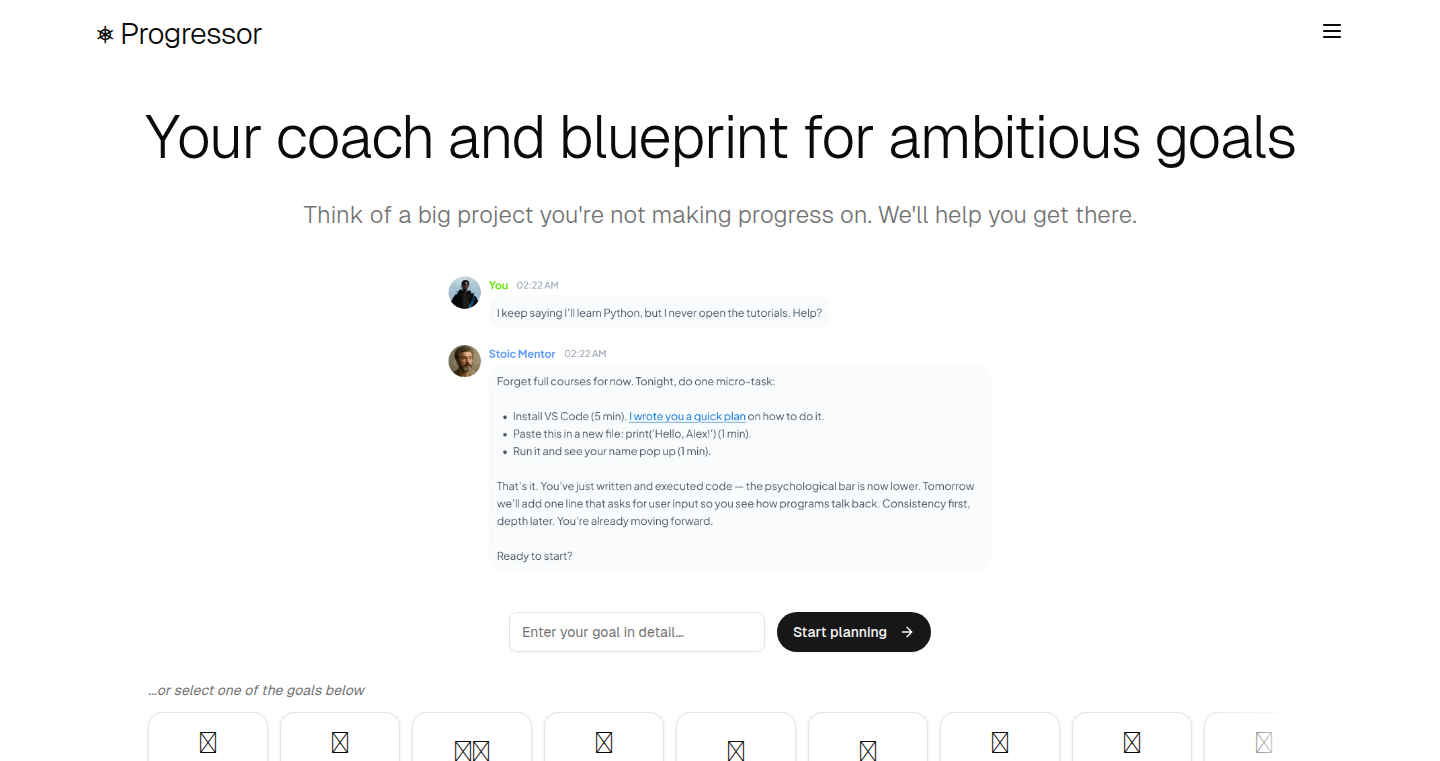
Author
murahovsky
Description
Progressor is a smart assistant designed to tackle large, ambitious goals by breaking them down into manageable, actionable steps. It addresses the common problem of feeling overwhelmed when facing complex projects or long-term objectives. The core innovation lies in its personalized approach: It asks a series of targeted questions to understand the user's goal and situation, then generates a tailored, step-by-step plan complete with guidance and resources. It goes beyond simple task management and provides a structured framework for achieving otherwise daunting goals.
Popularity
Points 31
Comments 17
What is this product?
Progressor is essentially a goal-decomposition engine. It doesn't just list tasks; it guides you through the process of achieving them. It uses an intelligent system to understand your goals, identify potential roadblocks, and create a personalized plan. Think of it like having a coach that breaks down complex projects into smaller, more manageable chunks. This means you're less likely to get stuck and more likely to stay motivated. So, it's a tool that uses smart planning to turn your big dreams into actionable steps.
How to use it?
Developers and anyone with long-term goals can use Progressor. You start by describing your goal in detail – the more information you provide, the better. Then, Progressor asks you a series of questions to understand your current situation and challenges. Based on your answers, it crafts a personalized plan with daily, focused tasks. You can adjust the plan as needed and receive reminders to stay on track. For developers, this could be used for launching a new product feature, learning a new programming language, or even planning a complex open-source project. It's easily integrated into your project management workflows.
Product Core Function
· {"applicationScenario":"Helps when starting a new project that seems difficult to complete, like writing a complicated piece of software or building a website with advanced functionality. Makes complex projects less daunting.","functionName":"Goal Decomposition","technicalValue":"Implements a custom algorithm for goal decomposition, possibly using techniques from project management and cognitive psychology. The system analyzes the goal description and generates a step-by-step plan.","description":"The core function is breaking down large, ambiguous goals into smaller, actionable steps. This helps avoid feeling overwhelmed and provides a clear roadmap. This uses an internal algorithm to guide you through planning; it's like having a smart checklist that is dynamically created based on your input."}
· {"applicationScenario":"Useful for developers who are setting personal learning goals (e.g., mastering a new programming framework). The system creates tailored tutorials and exercises based on your current knowledge.","functionName":"Personalized Plan Generation","technicalValue":"Uses a question-answering and rule-based system or possibly a simple AI for generating personalized plans, considering user responses to create a tailored set of tasks.","description":"Creates customized plans based on the user's responses to a series of targeted questions. This ensures the plan is relevant and tailored to the user's specific situation and needs. This gives you a plan made especially for you, so it's more effective."}
· {"applicationScenario":"Helpful for developers learning new technologies. If you need to learn about a particular aspect of a technology, Progressor will help find the relevant documentation, code samples, and tutorials to speed up the learning process.","functionName":"Resource Integration","technicalValue":"Involves an intelligent system that identifies relevant resources (documentation, tutorials, example code) based on the task description. Could involve a knowledge base and semantic search.","description":"Provides relevant guidance and resources for each task. This helps users understand the 'how' and 'why' behind each step. This gives you the information you need right at your fingertips. It includes links to tutorials, documentation, and other useful sources."}
· {"applicationScenario":"Ideal for software engineers on a new project, ensuring the project milestones are met, with proactive reminders and the ability to track your progress.","functionName":"Progress Tracking and Reminders","technicalValue":"Implements a notification system, which sends timely reminders and possibly provides reporting tools for tracking project progress.","description":"Sends reminders and allows users to track their progress. This helps users stay motivated and on schedule. It gives you helpful reminders so you keep going. This can be integrated into calendars, email, and other productivity tools."}
Product Usage Case
· {"scenario":"Launching a New Software Product","userBenefit":"Reduces the feeling of being overwhelmed by a large project and increase the chances of successful product launch.","description":"A developer wants to launch a new web application. Progressor would guide them through the process, breaking down the goal into tasks like: * Defining the Minimum Viable Product (MVP). * Designing the User Interface (UI). * Developing core features. * Testing the application. * Deploying to a production server. * Marketing and user acquisition.","technicalProblemSolved":"Overcoming the complexity and scope of launching a product. Progressor ensures that each step is clearly defined, and that there are resources available to guide the process."}
· {"scenario":"Learning a New Programming Language","userBenefit":"Makes learning more structured and achievable, boosting motivation and accelerating the learning process.","description":"A software engineer wants to learn Python. Progressor would decompose the task into steps such as: * Setting up the development environment. * Learning the basics of syntax. * Working with data structures. * Practicing with example projects. * Building a small Python application.","technicalProblemSolved":"Provides a structured learning path, breaking down the language into digestible, actionable steps, eliminating the frustration of trying to learn everything at once."}
9
Sodalite: The Anonymous Media Retriever
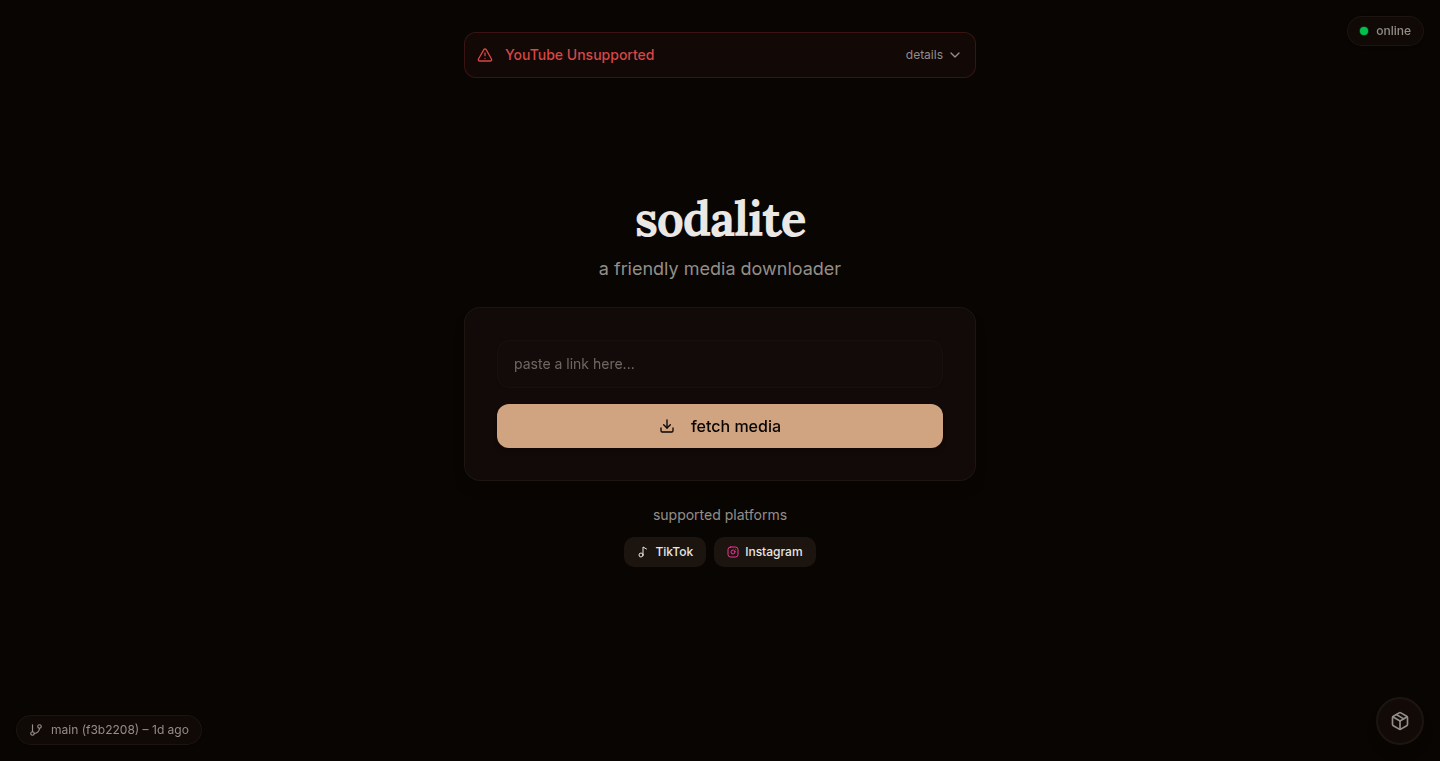
Author
oter
Description
Sodalite is an open-source media downloader designed to fetch content (like videos, audio, and images) anonymously. The innovation lies in its architecture, which incorporates a combination of strategies such as proxy rotation and sophisticated content detection to bypass restrictions and protect user privacy. It solves the core problem of securely downloading media from sources with potential censorship or geo-restrictions, ensuring the user's identity and location remain hidden. This directly reflects a concern for privacy in a world of increasing content control.
Popularity
Points 10
Comments 2
What is this product?
Sodalite is a tool, created by a developer to download media anonymously. It works by routing your requests through multiple proxy servers. This hides your real IP address, making it difficult to track your downloads back to you. It also features advanced detection mechanisms, so it identifies the media you want to download quickly and efficiently, even if the source tries to hide it. The innovation is in the combination of these techniques to create a robust and privacy-focused downloader. So this means your downloads are private and you can access content that might be restricted based on your location.
How to use it?
Developers can use Sodalite by integrating it into their scripts or applications. You might use it in a content aggregation service, a media archiving tool, or a personal media library manager. The integration involves using Sodalite's command-line interface (CLI) or potentially through an API (if exposed) within your code. To integrate, you would need to specify the media URL, the desired download location, and any optional parameters like proxy settings and output format. So, you can easily add the ability to download media anonymously to your own projects.
Product Core Function
· Anonymous Proxy Routing: This is the core of Sodalite's privacy features. It uses a rotating list of proxy servers to obscure the user's IP address, making it difficult to track the download activity. So, you get privacy, and your downloads are unlinkable to your actual location or identity.
· Content Detection and Extraction: Sodalite uses smart algorithms to identify and extract media content from various websites, even when the website structure is complex or changes. This enables reliable downloads from different sources. So, it works well across a range of websites and doesn't break when a site's structure updates.
· Format Support: Sodalite supports downloading different media formats such as MP4, MP3, JPEG, etc. This ensures compatibility with various devices and platforms. So, you can download media in a format that works with your system or desired playback.
· Command-line Interface (CLI): It provides a CLI for easy use in scripts and automation. So, you can automate the download process using scripts.
· Open Source and Customizable: The fact that it's open source means the code is available for review, modification, and improvement. Developers can adapt it to their specific needs. So, it can be modified by developers to handle specific websites or add features.
Product Usage Case
· Content Aggregation Service: A developer could use Sodalite to build a service that aggregates video content from multiple sources. By using Sodalite, the service can download videos anonymously, avoiding potential restrictions or IP bans. So, this helps you build services that aggregate content from various sources without getting blocked.
· Personal Media Library: A user could employ Sodalite to build a personal archive of videos or audio files. Sodalite allows users to download and store media without revealing their IP address. So, you can download content from the internet while keeping your download activity private.
· Research and Archiving: Researchers working with restricted or geo-blocked media can use Sodalite to anonymously download the content for study and preservation. So, researchers can access and archive media that is difficult or impossible to access otherwise.
10
Stacklane: Stacked PR Orchestrator
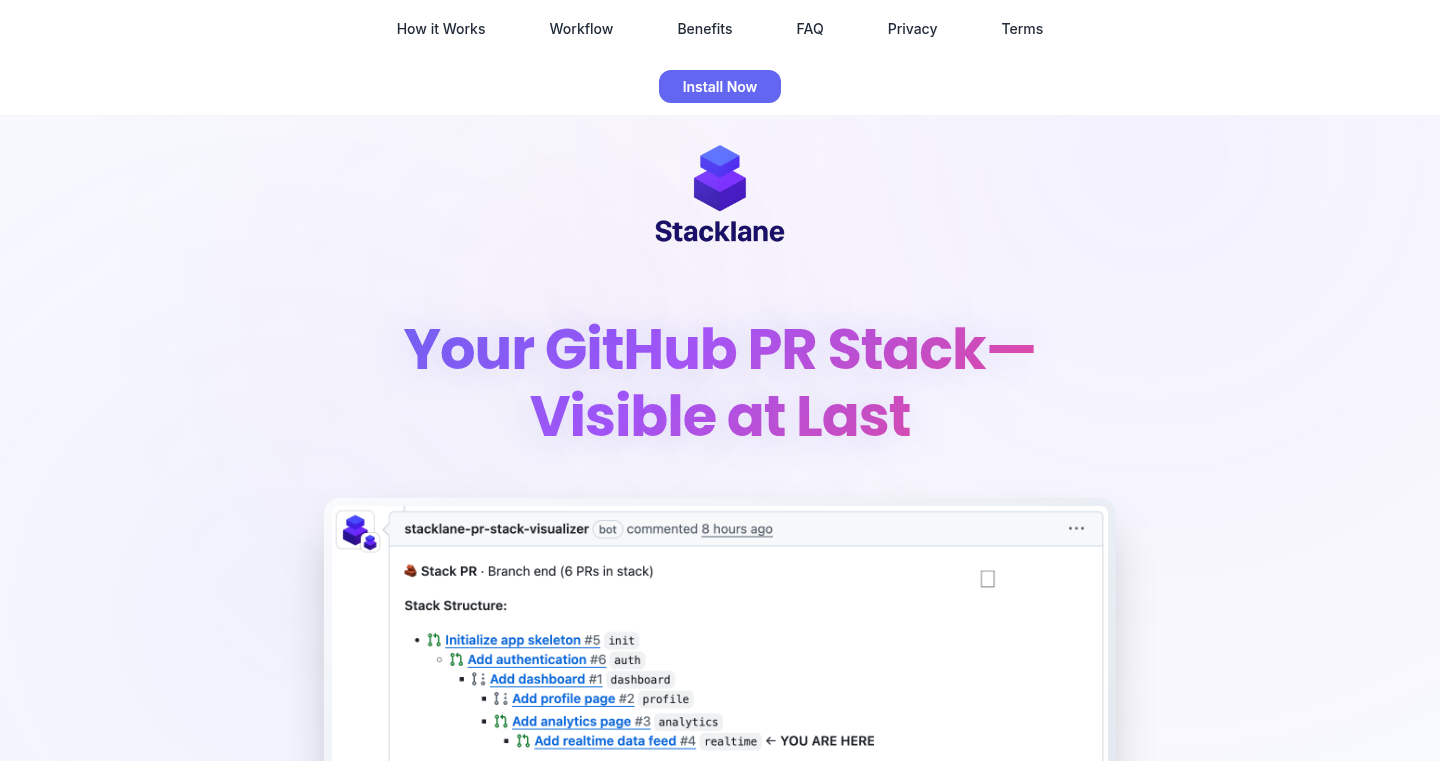
Author
nbrempel
Description
Stacklane is a GitHub App designed to improve the clarity and workflow of stacked pull requests (PRs). Stacked PRs are a way of organizing code changes by breaking them down into smaller, dependent PRs, making it easier to review and understand complex changes. Stacklane automates some of the manual processes involved in managing these dependencies, making it simpler for developers to manage complex change sets. The core innovation is in the automation of PR dependency management, using Git metadata to provide a clear visual representation of PR relationships, and simplifying the rebase and merge process for dependent PRs.
Popularity
Points 7
Comments 4
What is this product?
Stacklane is a smart tool for managing a new way of coding: stacked pull requests. Imagine you're building a house, and each room needs to be completed in a specific order. Stacked PRs are similar, where each small change (PR) depends on the ones before it. Stacklane helps automatically keep track of these dependencies. It analyzes the relationships between your code changes based on how the code is organized (using Git) and graphically shows you what changes depend on others. This removes some of the manual work from organizing the code change, and ensures everything is done in the right order. So instead of juggling complex dependencies, you have a clear picture of the changes.
How to use it?
Developers use Stacklane through a simple integration within their GitHub workflow. Once installed in a repository, Stacklane monitors pull requests. When a new PR is created or updated, Stacklane analyzes its relationship to other open PRs, providing feedback on the dependencies. Developers can then review these relationships and, with Stacklane's help, efficiently rebase dependent PRs after changes to the base PR or merge in the correct order. This saves time and drastically reduces the risk of merge conflicts in complex codebases. Integrate by simply installing it as a GitHub app to your repository. So it automatically identifies dependencies for you, so you don't have to.
Product Core Function
· {"functionName":"Automated Dependency Detection","description":"Stacklane automatically identifies dependencies between pull requests by analyzing the code changes and Git history. This helps developers visualize relationships and understand the order in which changes need to be merged.","valueAndApplication":"So this lets developers quickly identify which PRs depend on others, so they can better organize their workflow, reduce the risk of merge conflicts, and build a clear dependency map.","technicalImplementation":"Stacklane leverages Git metadata to infer dependencies between PRs. When a PR is created or updated, Stacklane compares the changes against other open PRs and identifies if one relies on another. This relationship is then displayed graphically within the PR interface."}
· {"functionName":"Visual PR Relationship Graph","description":"Provides a visual representation of the dependencies between pull requests, displaying the order in which they need to be merged. This helps developers quickly understand the overall structure of a set of changes.","valueAndApplication":"So this allows developers to get a high-level overview of their work. A visual diagram makes complicated series of changes less confusing. Knowing what goes where increases productivity.","technicalImplementation":"Stacklane renders a clear visual graph within the GitHub interface. Each PR is represented with arrows showing dependencies. Users can easily understand the dependency hierarchy, enabling them to manage their PRs more efficiently."}
· {"functionName":"Rebase and Merge Orchestration","description":"Assists with rebasing and merging dependent pull requests in the correct order, ensuring changes are integrated smoothly and in the correct order. Helps solve the problem of maintaining updated, dependent PRs after changes to the parent.","valueAndApplication":"So this gives developers a simple way to keep code changes updated and in the correct order, which keeps everything from falling apart during integration and testing. Making changes is easier and faster.","technicalImplementation":"When the base PR is updated, Stacklane provides guidance on how to rebase the dependent PRs. It uses GitHub Actions or a similar system, automating the rebasing process and presenting the results back within the pull request."}
Product Usage Case
· {"technicalImpact":"Stacklane simplifies the integration of changes. This makes it easier to work on large projects with a lot of engineers. It reduces friction and saves valuable time during the development process, which enables faster releases and faster iteration.","scenario":"Large project with frequent updates","description":"In a large project where multiple teams are working on different features, Stacklane is used to manage the dependencies of numerous pull requests. Developers create smaller PRs with related changes. Stacklane’s auto-detection ensures all dependencies are tracked. When a base PR is merged, Stacklane notifies those dependent PRs, giving them the ability to rebase, and update, minimizing conflicts, and speeding up the merge."}
· {"technicalImpact":"Developers use Stacklane to more easily manage complicated features, without worrying about dependency issues. This is useful when a new feature is difficult to design and implement, and makes it easier to collaborate with multiple developers.","scenario":"Complex Feature Development","description":"Developers are working on a complex feature that requires multiple code changes across different files and components. They split the feature into a series of smaller, dependent PRs. Stacklane visualizes the relationships between the changes, ensuring the correct order of merges, reducing the likelihood of merge conflicts, and making the review process faster and more efficient."}
11
rtrvr.ai: The Browser-Native AI Web Agent

Author
arjunchint
Description
rtrvr.ai is a cutting-edge AI agent designed to automate web tasks directly within your browser, achieving State-of-the-Art performance. Unlike traditional cloud-based agents, rtrvr.ai operates locally as a Chrome Extension, eliminating latency and bot detection issues. It interacts with web pages using the Document Object Model (DOM), enabling more robust and efficient automation. This project challenges the viability of cloud-based web automation, offering a faster, more reliable, and cost-effective solution.
Popularity
Points 8
Comments 2
What is this product?
rtrvr.ai is an AI agent that automates tasks on the web. The core innovation lies in its 'local-first' approach: it runs directly inside your web browser as a Chrome extension. This drastically reduces delays and circumvents common problems faced by cloud-based agents, like being blocked by websites. Instead of looking at the webpage like a human (visual parsing), it interacts directly with the underlying code (DOM) of the website, making it smarter and more resilient to changes. It also leverages the latest AI models like Gemini Flash for superior performance.
**So what does this mean for me?** It means you can automate repetitive web tasks – like filling out forms, scraping data, or navigating websites – much faster, more reliably, and at a lower cost. Think of it as having a super-efficient digital assistant that lives right in your browser.
How to use it?
Developers can use rtrvr.ai by installing the Chrome extension. They can then provide instructions for the agent to perform specific tasks on web pages. The agent uses the user's AI Studio API key, and specifically makes use of the free tier of Google's Gemini model. The interface is designed to be user-friendly, and the agent can be configured to interact with various websites.
**How does this help me?** You can automate your web interactions directly from your browser. No complex setup is needed. The automation can handle complex tasks, eliminating manual work, and can be integrated into other workflows to streamline your processes.
Product Core Function
· {"functionName":"DOM-Based Interaction","description":"Instead of interpreting web pages visually (like a human), rtrvr.ai directly interacts with the website's underlying structure (the DOM). This makes it more reliable and resilient to website changes. It can skip clicks and pop-ups, and the agent can work quickly and accurately.\n\n**Why is this useful?** If you are working with web automation, this feature helps to prevent errors caused by websites changing their layout. Your automation processes become less prone to breaking down. It also makes the automation faster, enabling it to handle complex tasks more efficiently."}
· {"functionName":"Local-First Operation (Chrome Extension)","description":"rtrvr.ai runs directly in your Chrome browser, eliminating the delays and restrictions of cloud-based agents. Because it is running locally, it has better access to the page and can avoid anti-bot detection. This approach improves performance and reliability.\n\n**Why is this useful?** Tasks are completed quickly, and the agent is less likely to be blocked by websites. It is a smoother, more reliable experience, and also offers better cost efficiency."}
· {"functionName":"Integration with Gemini Flash","description":"Leverages the latest AI models, such as Gemini Flash, to understand and complete tasks effectively.\n\n**Why is this useful?** Allows for more intelligent web automation with superior accuracy."}
Product Usage Case
· {"useCase":"Automated Form Filling","description":"Imagine you need to fill out the same web form repeatedly. rtrvr.ai can automate this process by understanding the form's structure (DOM) and automatically entering the necessary data. \n\n**How is this helpful?** Saves time and reduces manual effort when dealing with repetitive form-filling tasks."}
· {"useCase":"Data Scraping","description":"If you need to collect data from various web pages, rtrvr.ai can extract specific information based on DOM elements. You can set up a process that automatically gathers data and organizes it for further use. \n\n**How is this helpful?** Streamlines data collection, saving time and enabling faster data analysis."}
12
Real-time macOS Voice-to-Text Streamer

Author
irqlevel
Description
This project builds a real-time voice-to-text transcription application specifically for macOS, streaming audio input and displaying transcribed text instantly. The core innovation lies in its efficient integration of macOS's built-in speech recognition capabilities, offering a low-latency solution that bypasses cloud dependencies and provides a privacy-focused transcription experience. This directly addresses the issue of needing fast, reliable, and private transcription on a local device, unlike many cloud-based alternatives.
Popularity
Points 6
Comments 2
What is this product?
This is a macOS application that converts spoken words into text in real-time. It leverages Apple's native speech recognition engine, ensuring quick and local processing. The innovation is in its streamlined implementation, providing a direct and efficient stream of transcribed text. Think of it like live subtitles, but for your own voice, running entirely on your computer, so everything stays private.
How to use it?
Developers can use it in several ways: As a standalone utility for transcription needs, easily capturing spoken notes or meeting minutes. It can be integrated into other applications, such as note-taking software or accessibility tools, by capturing the text output. Imagine you are building an application for musicians, and you want to transcribe your jam sessions. The application could use the transcribed output from the tool, which enables you to generate lyrics for the music automatically. The source code is available, so developers can learn from it or customize the tool to meet their particular requirements.
Product Core Function
· {"applicationScene":"For quick note-taking, transcribing meetings, or any scenario where immediate text output from speech is needed. So this is useful for efficiently capturing information during discussions or lectures.","function":"Real-time Transcription","value":"The core function is to transcribe speech into text as the user speaks. This is achieved by continuously listening to the microphone input and feeding it to macOS's speech recognition engine. The transcription result is then updated in real time. The implementation uses standard macOS frameworks for audio input and text display."}
· {"applicationScene":"Crucial for sensitive information or when a reliable internet connection is unavailable. So this is important when you value your privacy, because your data stays on your computer.","function":"Local Processing","value":"All processing happens locally on the user's Mac. No audio data is sent to external servers. This enhances user privacy and eliminates latency caused by network connections. This uses the built-in macOS speech recognition capabilities instead of relying on the cloud."}
· {"applicationScene":"Enables real-time feedback and interaction, making it ideal for dictation or accessibility applications. So this means you get to see the text as soon as you speak it, making it great for writing or interacting with your computer through your voice.","function":"Low Latency","value":"Due to local processing, the application provides very low latency, meaning the text appears almost instantly after the user speaks. This is essential for a smooth user experience."}
Product Usage Case
· {"technicalSolution":"The application streams the audio from the lecture hall to the macOS's speech recognition, translating the speech into text. This allows the student to review the text later, annotate it, and even search for specific keywords without having to write everything manually. So this is useful for quickly converting spoken words into text for note taking and easy search.","description":"A student is attending a lecture and wants to record the key points. They can run the application, which will transcribe the lecture in real time, allowing them to focus on listening and understanding the concepts.","scene":"Note-Taking"}
· {"technicalSolution":"The application listens to the user's voice and converts it to text. This text is then used as the input for the command, controlling the cursor movement and other computer functionalities. So this is useful because it empowers users who are not able to use the mouse and keyboard, as an additional means to communicate with the computer.","description":"A person with a hearing impairment wants to use a computer hands-free. They can speak their commands, and the application will transcribe their speech into text which would then be sent as input. This would provide real-time feedback of the spoken command to confirm their intent.","scene":"Accessibility Tool"}
13
Nomad: The Foldable 3D Printer
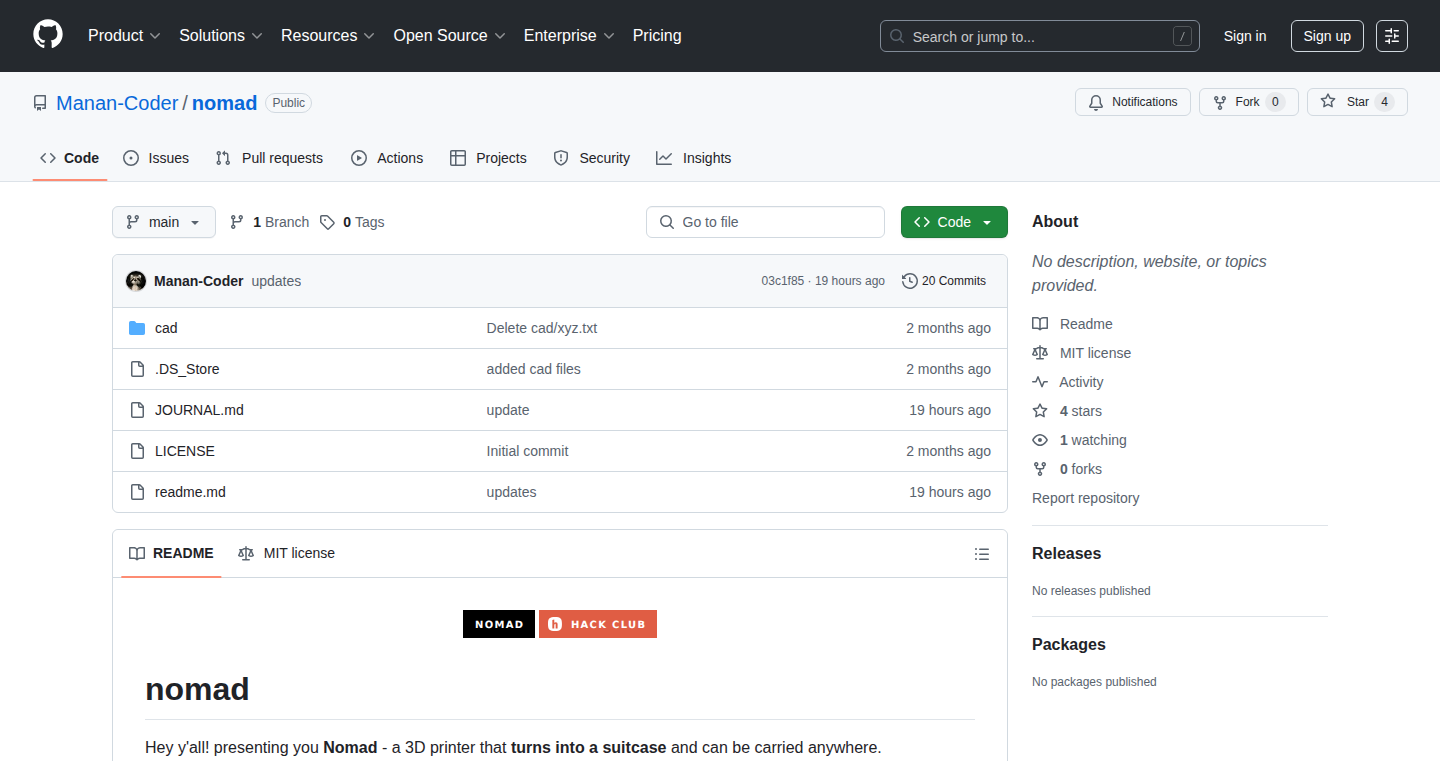
Author
Manan-Coder
Description
Nomad is a prototype 3D printer designed to fold into a suitcase, making it highly portable. The innovative design utilizes telescopic rails and hinges, allowing for a compact form factor. This project tackles the problem of 3D printer size and portability, offering a solution for creators who need to work on the go. It represents a practical application of mechanical engineering and open-source principles to solve a common user problem.
Popularity
Points 3
Comments 3
What is this product?
Nomad is a 3D printer built with portability in mind. It's based on the Cartesian printer design, which means it moves the print head along three axes (X, Y, and Z). The key innovation is its folding mechanism. The printer uses telescopic rails (like those found in drawers) and hinges to collapse into a compact size, much like a suitcase. This design makes it easy to transport and store. So, it's a 3D printer you can easily carry around!
How to use it?
Developers can use Nomad by either replicating the design or modifying it to fit their needs. The open-source nature allows for customization of the printer's dimensions, print volume, and material compatibility. It can be used by anyone involved in 3D printing, from hobbyists to professionals needing a mobile printing solution. The project’s CAD models are available on Github, which allows developers to understand the mechanical structure and design. The open-source nature also opens the door for software/firmware customization to enhance the user experience or add more printing features. So, it’s open to adapt and build your own 3D printer with portability as your design goal!
Product Core Function
· {"soWhat":"So, you can create things quickly, perfect for testing out your ideas or building custom parts!","function":"Cartesian Printing Mechanism","description":"The core technology involves a standard Cartesian 3D printer setup (X, Y, Z axes). This technology is mature and allows the print head to move precisely across the print bed. Value: Provides the ability to build 3D objects layer by layer, enabling the creation of physical prototypes and custom parts. Application: Rapid prototyping, small-scale manufacturing."}
· {"soWhat":"So, you can easily carry your printer with you and 3D print anywhere. This feature makes it perfect for creators on the go.","function":"Telescopic Rail and Hinge System","description":"The folding mechanism utilizes telescopic rails and hinges. Telescopic rails allow sections of the printer to slide inside each other, reducing its footprint. Hinges allow the frame to fold. Value: This design innovation drastically reduces the printer's size, making it portable. Application: Portability for makers, limited space for 3D printing enthusiasts."}
· {"soWhat":"So, you can learn from the design, adapt it to your needs, and even improve it yourself. Great for learning about 3D printer design!","function":"Open-Source Design (Github)","description":"The entire design is open-source and available on Github. This means the CAD models and potential firmware are available for developers to inspect, modify, and improve. Value: Fosters collaboration, allows for customization, and encourages community contributions. Application: Allows for adaptation to different printing needs, sharing and improving the design collaboratively."}
Product Usage Case
· {"scenario":"Mobile Prototyping","techProblemSolved":"The ability to create physical prototypes on-demand, regardless of location. Eliminate the need to send designs out for printing and waiting for delivery.","description":"A product designer can use Nomad to quickly prototype designs while traveling. They can print small parts at client sites or during meetings, drastically speeding up the design process.","techUsed":"3D modeling software, slicing software, Nomad 3D printer."}
· {"scenario":"Education and Workshops","techProblemSolved":"Easier accessibility to 3D printing technology for educational purposes, making it a valuable tool for teaching STEM (Science, Technology, Engineering, and Mathematics) skills. ","description":"Teachers can bring Nomad to workshops and schools to introduce students to 3D printing without the limitations of a bulky stationary printer. The small size and portability make it easy to set up and take down.","techUsed":"3D modeling software, slicing software, Nomad 3D printer."}
14
Mqutils: The Swiss Army Knife for Go Message Queues
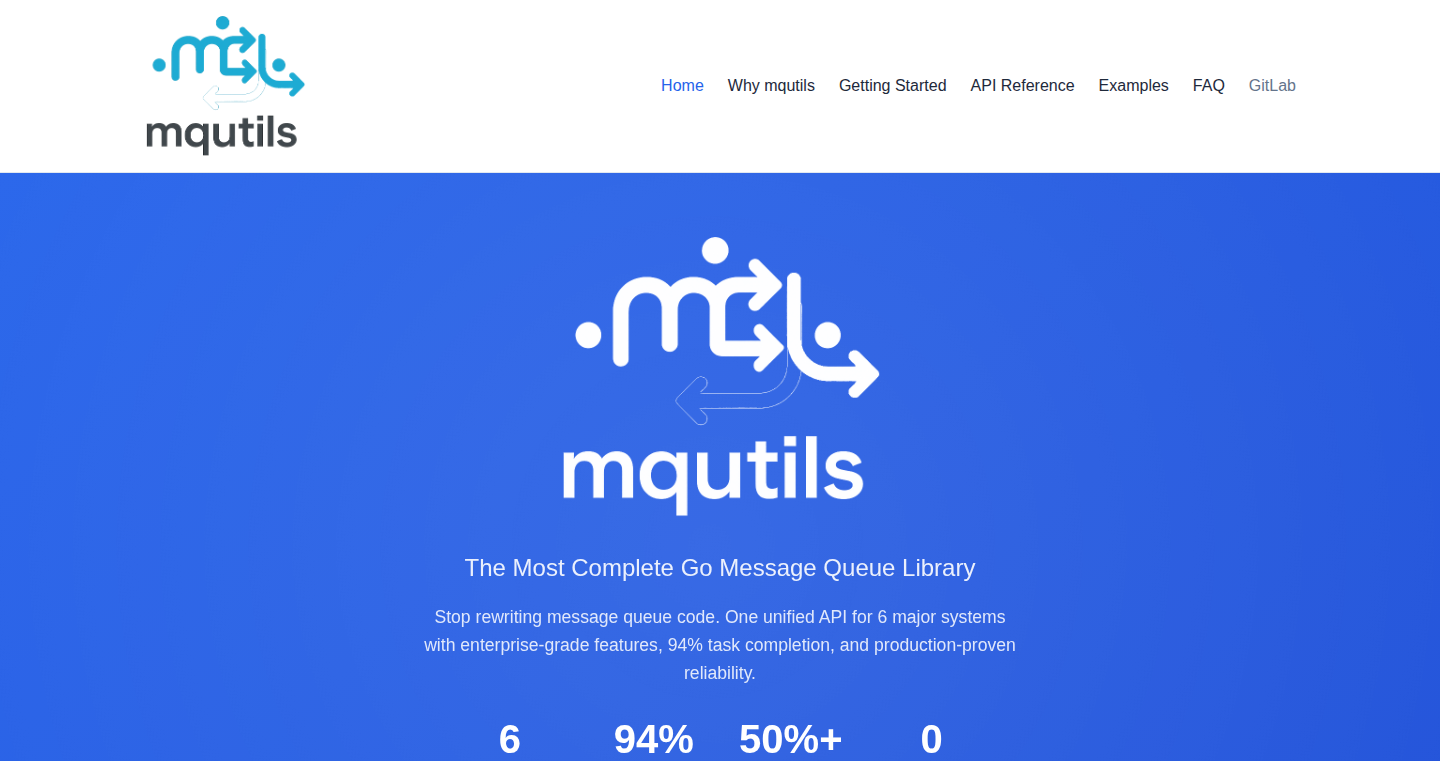
Author
DjGilcrease
Description
Mqutils is a Go library that provides a single, unified API for interacting with various message queue systems like RabbitMQ, Kafka, SQS, and more. The core innovation lies in its ability to abstract away the complexities of different queue systems, allowing developers to switch between them with simple URL changes. This significantly reduces the learning curve and simplifies the process of building and maintaining applications that rely on message queues. It solves the common problem of needing to learn and manage multiple SDKs and their intricacies.
Popularity
Points 6
Comments 0
What is this product?
Mqutils is a Go library that acts as a universal translator for message queues. Think of it as a common interface for talking to different messaging services. Instead of learning the specific APIs for RabbitMQ, Kafka, SQS, etc., you use the Mqutils API. The library then translates your commands to the appropriate service. The innovation is in providing a single API for all of these systems, and doing so while maintaining performance, reliability, and providing advanced features like health monitoring and distributed tracing. So, if you want to switch from RabbitMQ to Kafka, you only change the URL in your code. It’s that simple. This is achieved through clever abstraction and careful design that handles the different internal mechanics of each messaging system.
How to use it?
Developers use Mqutils by importing the library into their Go projects and then using its `NewConsumer` and `NewProducer` functions. You specify the message queue system by providing a URL, such as `amqp://localhost:5672/orders` for RabbitMQ or `kafka://localhost:9092/orders` for Kafka. You then register handlers to process messages, and the library handles the underlying communication with the queue. Think of it like using a single universal remote to control different TVs.
**For Developers**: Use Mqutils to standardize your messaging code. Replace vendor-specific SDKs with a single, unified API. Reduce development time and effort required to learn and manage different queue systems.
Product Core Function
· {"function":"Unified API","description":"Mqutils offers a consistent API across various message queue systems. This eliminates the need to learn multiple SDKs and reduces the learning curve.","value":"Simplifies development and maintenance. Write your code once, and switch message queue providers with a simple configuration change. So this is great for teams who have to manage multiple queue systems or are considering migrating between them.","technicalImplementation":"The library uses a combination of interfaces, abstract classes, and adapter patterns. It defines a common set of operations (e.g., `Consume`, `Publish`) and then provides concrete implementations for each supported message queue. This design allows Mqutils to handle the differences in APIs, error handling, and other nuances of each system internally."}
· {"function":"Health Monitoring","description":"Provides built-in health checks to monitor the status of all connected message queue systems.","value":"Ensures reliability and helps in quickly identifying and resolving issues. So you can be proactively alerted to problems with your messaging infrastructure.","technicalImplementation":"Mqutils periodically checks the connection to the message queues, monitors throughput, and detects errors. It can also integrate with monitoring tools."}
· {"function":"Batch Processing","description":"Enables batch processing of messages with configurable timeouts.","value":"Improves performance and reduces latency, especially for high-volume message processing. So this makes your applications more efficient.","technicalImplementation":"Mqutils groups messages together and processes them in batches, improving efficiency. It uses internal timers to handle timeouts and ensure timely processing."}
· {"function":"Context Propagation","description":"Supports context propagation for distributed tracing.","value":"Improves debugging and monitoring capabilities, especially in microservices architectures. So, it helps you understand where your message is at any point in time.","technicalImplementation":"Mqutils integrates with tracing libraries (e.g., OpenTelemetry) to propagate context information across different services. This allows developers to track the flow of messages and diagnose issues."}
· {"function":"Thread-safe Operations","description":"Ensures thread-safe operations with built-in race condition prevention.","value":"Improves reliability and prevents data corruption in concurrent environments. So, it makes your app more robust.","technicalImplementation":"Mqutils uses mutexes and other synchronization mechanisms to prevent race conditions and ensure that operations are safe in multi-threaded environments."}
· {"function":"Graceful Shutdown","description":"Provides mechanisms for graceful shutdown and resource cleanup.","value":"Prevents data loss and ensures a clean exit. So, it prevents data corruption and downtime.","technicalImplementation":"Mqutils implements graceful shutdown procedures to ensure that connections are closed properly and that all resources are released before exiting."}
Product Usage Case
· {"solution":"Mqutils simplifies communication by providing a unified API. Developers can easily switch between queue systems by changing the URL in their code. Health monitoring and context propagation features help in debugging and monitoring the distributed system. This makes it easier to add, change, or remove queueing backends without rewriting the entire code base. So, this will drastically simplify adding a new microservice that relies on a queue.","scenario":"Microservices Architecture","description":"A company uses multiple microservices that communicate via message queues. Different services use different queue systems (e.g., RabbitMQ for reliability, Kafka for streaming)."}
· {"solution":"With Mqutils, the migration process is significantly simplified. Developers only need to update the URLs in their code to point to the Kafka brokers, and the rest of the code remains the same. This drastically reduces the amount of time and effort required. So you don't need to rewrite hundreds of lines of code and retraining developers.","scenario":"Migrating from One Queue to Another","description":"A company decides to migrate from RabbitMQ to Kafka due to performance or cost concerns."}
· {"solution":"Mqutils allows developers to easily switch between queue systems for testing purposes. They can quickly point their applications to a local RabbitMQ instance, a local Kafka instance, or even an in-memory queue for faster development. This streamlines the testing process. So, this will improve your developer's workflow by making it simple to test code and reduce the feedback loop.","scenario":"Testing and Local Development","description":"Developers need to test their applications against different message queue systems, and have a simple local development setup."}
15
Nethole: Silent WPA3 Disconnection via ARP Spoofing
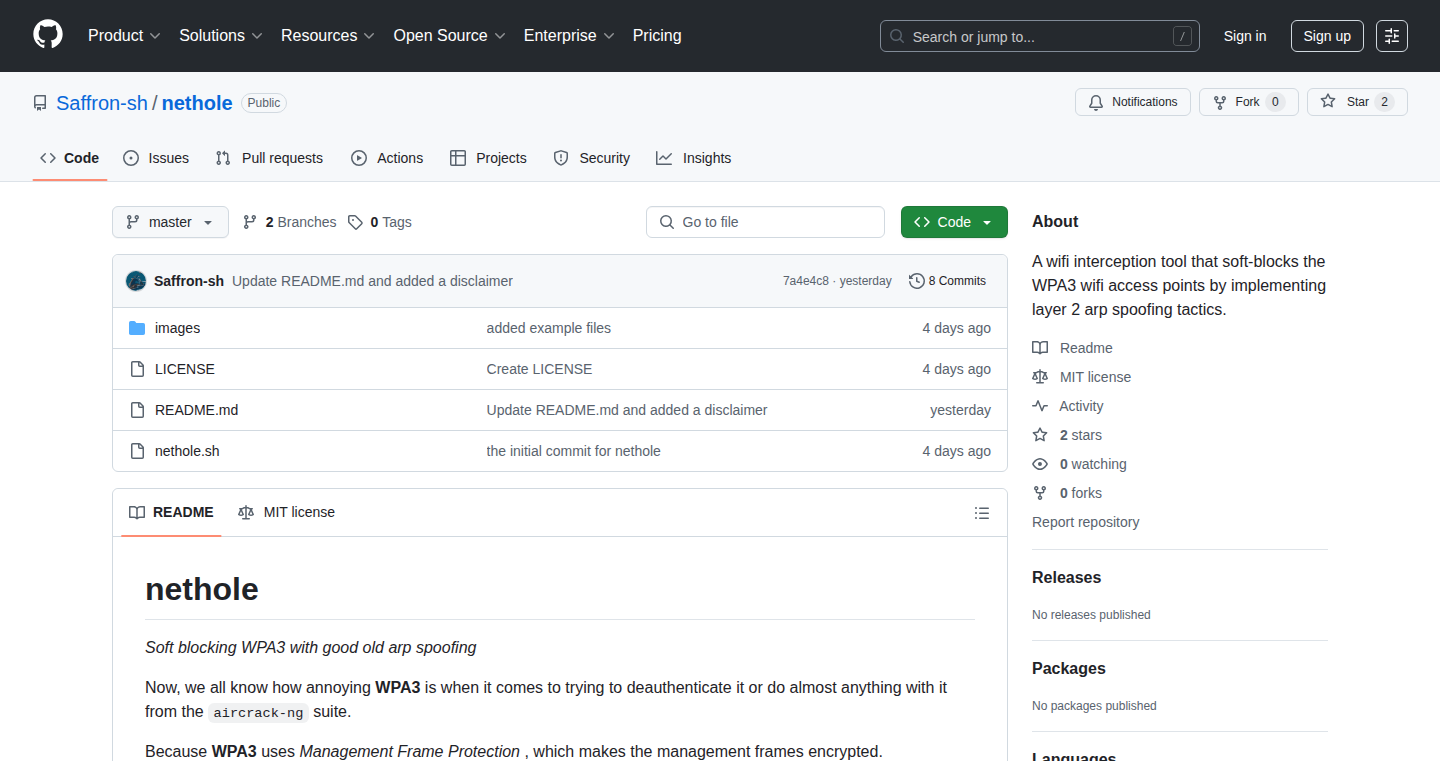
Author
qwertySaffron
Description
Nethole is a clever bash script that softly disconnects devices from Wi-Fi networks secured by WPA3. Instead of the usual methods like de-authentication (forcing devices to reconnect) or capturing network traffic, it uses ARP spoofing to create a 'man-in-the-middle' situation, then prevents internet access by disrupting IP forwarding. This results in the device appearing connected to the Wi-Fi, but unable to browse the internet. The key innovation is a 'quiet' denial-of-service attack against WPA3, bypassing defenses that protect against traditional Wi-Fi hacking tools.
Popularity
Points 5
Comments 0
What is this product?
Nethole is a security tool that targets the WPA3 wireless security protocol. It uses a technique called ARP spoofing, which is like tricking devices into thinking they're talking directly to the router when, in reality, their network traffic is being rerouted through the attacker's device. After establishing this 'man-in-the-middle' position, Nethole disables IP forwarding. This causes the targeted device to buffer data indefinitely, effectively cutting off its internet connection without the user realizing why. This approach sidesteps WPA3's improved security measures. So this means you can test the security of your network in a novel way and understand how devices react to unusual network conditions.
How to use it?
A developer would use Nethole by first installing the necessary tools (like arpspoof and a bash interpreter). Then, they would run the script, specifying the target device's IP address and the gateway's IP address. The script then silently intercepts network traffic, effectively isolating the target device from the internet. It's intended as a research tool. You could use it in a controlled, ethical hacking environment to test the resilience of Wi-Fi networks or for educational purposes. So this means developers can explore security vulnerabilities, contributing to more robust network security designs.
Product Core Function
· {"functionName":"ARP Spoofing Setup","technicalValue":"This is the foundation of the 'man-in-the-middle' attack, allowing the attacker to control the flow of data to and from the target. So this provides a direct method for understanding network traffic manipulation.","description":"The core function uses `arpspoof` to associate the attacker's MAC address with the target device's IP address, and the gateway's IP address. This intercepts the network traffic."}
· {"functionName":"IP Forwarding Disable","technicalValue":"This creates a denial-of-service condition, but without obvious signs such as a forced disconnection. It showcases a subtle, less detectable attack approach. So this enables developers to design solutions that are more resilient to deceptive attacks.","description":"After the ARP spoof is set up, the script disables IP forwarding. This blocks packets from leaving the attacker's device and reaching the target. The device appears connected, but can't access the internet."}
· {"functionName":"Compatibility Testing and Adaptation","technicalValue":"Testing and adapting for different devices and defenses is crucial for understanding the scope and limitations of the attack. So this helps to build tools that can adapt to different security environments.","description":"The script's creator tested it on various operating systems and devices. It notes resistance on some Xiaomi phones due to ARP table hardening. This allows the developer to adapt and improve the tools."}
Product Usage Case
· {"scenario":"Penetration Testing","description":"A security professional could use Nethole to test the resilience of a WPA3 network. By silently disconnecting devices, they could gauge how well the network detects and responds to unexpected behavior. So this helps identify vulnerabilities in WPA3 implementations."}
· {"scenario":"Network Security Education","description":"Network security students could use Nethole as a learning tool to understand ARP spoofing and denial-of-service attacks. It provides a practical example of how these techniques work against WPA3. So this allows students to study these concepts in real-world scenarios."}
· {"scenario":"Researching WPA3 Behavior","description":"Researchers could use Nethole to analyze how different devices behave under network stress or unusual network conditions. It helps them understand how to build devices that are more resilient against this type of attacks. So this leads to better network hardware and software design."}
16
Kichan.ai: Web Augmentation Chrome Extension
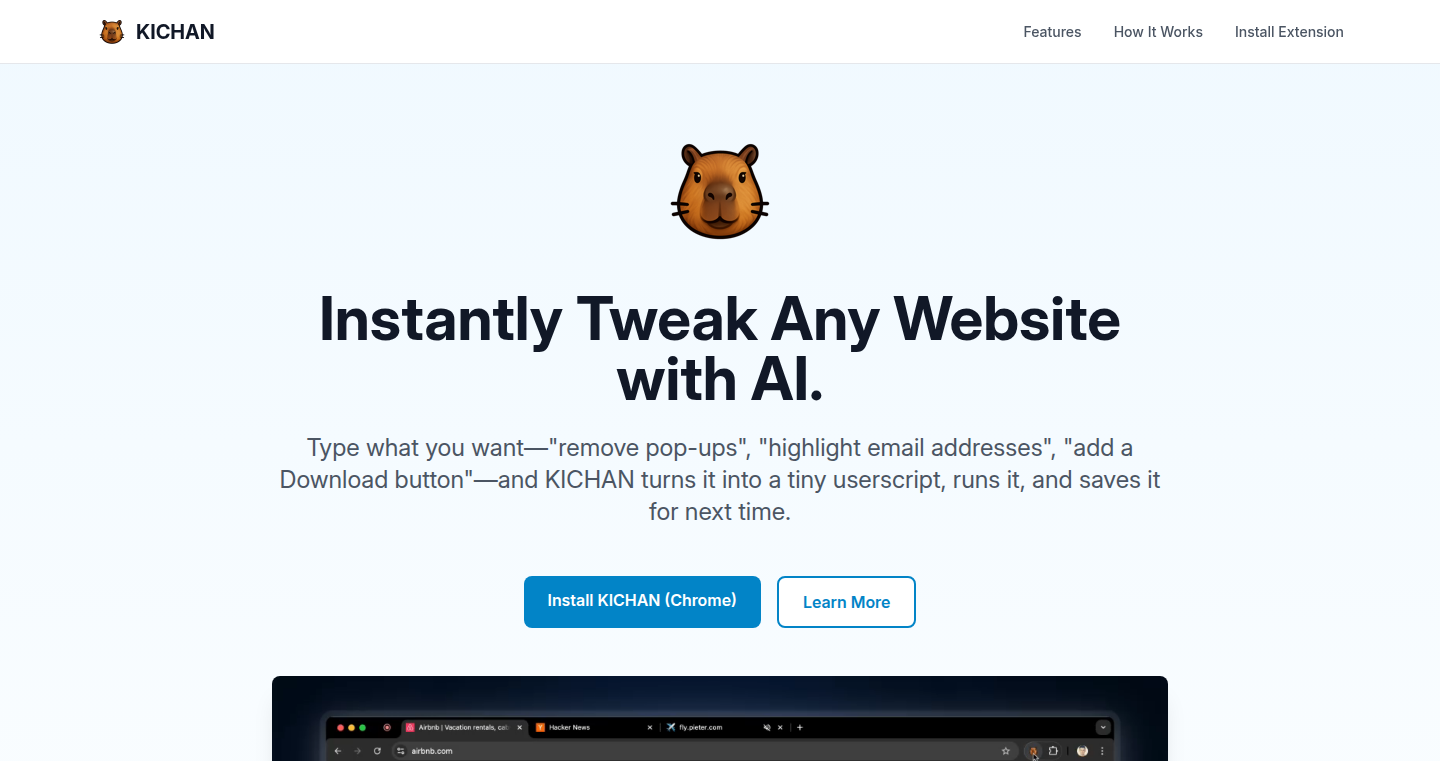
Author
k1rd
Description
Kichan.ai is a Chrome extension that empowers you to modify and enhance any website you visit using custom scripts. Think of it as a powerful tool to personalize your web browsing experience. It solves the limitations of websites by allowing users to inject JavaScript code, effectively altering the website's behavior, appearance, and functionality to fit their specific needs. The innovation lies in its ease of use, enabling users to create and run scripts without deep technical knowledge, and its flexibility in adapting websites to various personal or professional workflows.
Popularity
Points 3
Comments 2
What is this product?
Kichan.ai is a Chrome extension that allows you to write JavaScript code (user scripts) that will run on any webpage you visit. It works by injecting your custom scripts into the webpage's environment. This means you can change how websites look, how they behave, and add entirely new features. It provides a simple interface for writing and managing these scripts, allowing non-technical users to easily modify websites. So, it lets you personalize the web to suit your needs.
How to use it?
You install the Kichan.ai extension in your Chrome browser. Then, you write your JavaScript code, which can range from simple style changes (like changing font sizes or colors) to complex functionality modifications (like adding features to a web application or automating tasks). When you visit a webpage, Kichan.ai detects if there are scripts associated with that page (based on URL matching or other criteria) and executes them. This is incredibly useful for anyone who wants more control over their browsing experience, or needs to adapt websites to specific workflows or accessibility requirements. You can use it to make websites more readable, more efficient, or even to add missing features. For example, you can add a dark mode to websites that don't offer it, or automatically fill forms.
Product Core Function
· {"functionName":"User Script Injection","valueAndApplication":"This allows you to alter any website's behavior. Want a different layout? Change the fonts? Add features? This is how you do it. For example, you could make a website easier to read by changing font sizes, remove annoying ads, or automate filling in forms. So, it is useful for customizing any website.","technicalImplementation":"The core functionality is based on injecting JavaScript code into the target webpages. This is achieved via the Chrome extension API which allows developers to listen to webpage loading events and then inject code. This is a powerful feature which enables modifications that is not directly offered by websites."}
· {"functionName":"User Script Management Interface","valueAndApplication":"This makes it easy to create, edit, and organize your scripts. No need to be a programming expert! It's simple to test, and deploy your modifications. This improves productivity and reduces the time needed to create custom modifications. So, this helps to create and manage web modifications easily.","technicalImplementation":"Kichan.ai provides a user-friendly interface for writing, saving, and managing user scripts. It likely includes a code editor with syntax highlighting and potentially debugging features. This simplifies the process of writing and maintaining user scripts and abstracts away some of the complexities of the browser extension development."}
· {"functionName":"URL-Based Script Matching and Execution","valueAndApplication":"This automates the process of applying your modifications. You can set up scripts to run automatically when you visit a specific website or page. For example, have a script that always enables dark mode on your favorite news site without having to manually click anything. So, it personalizes the web based on website address.","technicalImplementation":"Kichan.ai likely uses a system to map scripts to specific websites or patterns (e.g., matching a script to a specific domain or URL). When a matching website is visited, the corresponding script is automatically executed."}
Product Usage Case
· {"scenario":"Customizing a Work Dashboard","userBenefit":"It streamlines their workflow by putting the most important information front and center. So, it makes your workflow more efficient.","description":"A developer uses Kichan.ai to modify their project management dashboard to highlight critical tasks in a different color and automatically sort tasks based on priority. This provides an immediately more effective view of the tasks.","technicalBenefit":"Leveraging the extension’s script injection capabilities, the developer adds custom JavaScript code to manipulate the existing elements in the dashboard. The result is increased work efficiency."}
· {"scenario":"Improving Accessibility","userBenefit":"Making content accessible and easier to read for a broader audience. So, it helps the users to make any website more accessible.","description":"A user with visual impairments employs Kichan.ai to increase the font size on a news website that lacks a built-in accessibility option and simplifies the page layout, making it easier to read.","technicalBenefit":"The user injects a custom script that modifies the website's CSS (Cascading Style Sheets) to adjust the font and page layout. This illustrates how the tool can empower users by granting them the power to customize their online experience."}
· {"scenario":"Automating Data Entry","userBenefit":"It speeds up data entry and reduces errors. So, it increases productivity by automatically filling in form fields.","description":"A user, working with a website that requires manual data entry, uses Kichan.ai to create a script that automatically fills in form fields with pre-defined data. This is especially helpful for repetitive tasks.","technicalBenefit":"The user leverages JavaScript to interact with the website's HTML forms. The script can identify the correct fields and input the data accordingly."}
17
go-mapper: Struct Mapping for Go with Generics
Author
davitostes
Description
go-mapper is a lightweight Go package that automates the mapping between different Go structs, similar to AutoMapper in C#. It uses Go's generics (introduced in version 1.18) to provide a type-safe and flexible way to transform data structures. It's designed to simplify the tedious process of converting data transfer objects (DTOs) to domain models, and vice versa. This project addresses the common problem of repetitive and error-prone manual field-by-field mapping, allowing developers to write cleaner and more maintainable code.
Popularity
Points 4
Comments 0
What is this product?
go-mapper is a library that helps developers easily and safely transform data between different Go structs. Imagine you have one struct representing how data comes in (like a form submitted by a user), and another struct representing how you store that data in your application's core (like a database model). Instead of writing a lot of manual code to copy fields from one struct to another, go-mapper lets you define rules and mappings, and then it automatically handles the conversion. The core technology behind it leverages Go's generics, allowing for type-safe mapping and custom transformations. So, if you're converting a user's password from plain text to a secure hash before storing it, go-mapper can help you do that seamlessly. This is all about reducing boilerplate code and increasing code readability.
How to use it?
Developers integrate go-mapper into their Go projects by importing the package and defining mapping profiles. A mapping profile specifies how fields from one struct should be mapped to fields in another struct. You can use a fluent API to customize the mapping rules, including: 1) Shallow copying fields (copying the values directly); 2) Performing custom field transformations using custom functions (e.g., hashing passwords, formatting dates); 3) Implementing optional interfaces for struct-level control to allow complex data transformation logic. The developer then calls the mapper with the source and destination structs. For example, you might use it in a web application when receiving data from an API and converting it to a database-ready format. Another use case could be transforming data for different presentation layers or serialization formats. This simplifies the code and reduces the risk of errors during data transformations. So, you can easily integrate it where you want to convert data from one struct to another.
Product Core Function
· {"applicationExample":"Consider a scenario where you are receiving data from a third-party API and need to store specific user data in your application's database. go-mapper can automatically copy all common fields such as email or user ID from the external API data to your database schema, so you don't have to write these operations by hand.","name":"Shallow Field Copying","description":"This feature enables quick and simple mapping of fields with the same name and type between structs. It saves developers time and effort by automating the direct copying of values. The library simply copies the values of the corresponding fields. For example, when dealing with a user's name, which should stay the same across different data formats, go-mapper can automatically copy the user's name.","value":"Saves developers time by automating the mapping process and minimizing boilerplate code. It also prevents errors and improves code readability."}
· {"applicationExample":"In the user registration process, when the user provides a password, a custom transformation function can be used by go-mapper to generate a secure hash of the password before saving it into the database, enhancing security without developers' manual operations.","name":"Custom Field Transformations","description":"Allows developers to define custom logic for mapping specific fields. This is crucial when you need to transform data during the mapping process. For instance, you might need to hash a password before storing it in a database, or format a date to a specific string format. The library enables developers to supply custom logic to tailor transformations. This functionality is accomplished using fluent API syntax.","value":"Enables complex data transformation operations, enhancing the versatility of go-mapper. It promotes the transformation of specific data fields, improving data security and formatting according to the application's needs."}
· {"applicationExample":"When creating custom transformations, the fluent API makes it easier to define how to map and transform fields. Developers can configure many mapping rules with a single configuration statement.","name":"Fluent API for Configuration","description":"Provides a user-friendly and intuitive interface for configuring the mapping rules, using a fluent style. This makes it easier to define and understand mapping configurations, streamlining the code and improving maintainability. Developers can create complex transformations using a clear and understandable approach.","value":"Improves the readability and maintainability of the code by creating clearer, more manageable mapping definitions."}
· {"applicationExample":"When mapping data between various systems, you might need to perform advanced data validation operations before saving the data to the database. This functionality is useful to maintain data consistency and integrity.","name":"Optional Interface for Struct-Level Control","description":"Offers struct-level customization, so developers can add more complex data transformation rules. This allows the developers to implement more advanced mapping logic or execute additional operations before and after the data is mapped. This allows for a high degree of customization.","value":"Provides flexibility to implement complex data transformation operations. It helps in applying custom logic before and after mapping to fulfill advanced use cases."}
Product Usage Case
· {"solution":"go-mapper's fluent API is used to define a profile mapping `CreateUserDto` to `User` with custom transformations (like hashing the password).","scenario":"Data Transfer Object (DTO) to Domain Model Conversion","description":"In a web application, when receiving data from an external source (e.g., an API request), the data is usually structured as a DTO. Before storing this data in the application's core (domain model), it's often necessary to convert the DTO to a domain model. go-mapper simplifies this process, allowing developers to define clear mapping rules for converting the DTO fields to the corresponding fields in the domain model. For example, you could easily map a `CreateUserDto` to a `User` struct.","benefit":"Reduces the amount of boilerplate code required and reduces the risk of manual errors. Improves the readability and maintainability of the code."}
· {"solution":"go-mapper is used to create a profile for converting the domain model to a DTO before serialization, and another profile for converting the received DTO to the domain model.","scenario":"Data Serialization and Deserialization","description":"When interacting with external systems, data is often serialized into formats like JSON or XML. You will need to serialize your domain models into JSON and deserialize the data received from external systems. Go-mapper can be used to convert a domain model to a DTO (for serialization) and a DTO to a domain model (for deserialization).","benefit":"This simplifies the conversion process, preventing manual copy-paste operations. It increases the overall development speed and avoids potential errors."}
· {"solution":"go-mapper defines a mapping profile for translating core data to a representation model.","scenario":"Data Formatting and Transformation for Presentations","description":"Before presenting data to a user in a user interface, the data may need to be formatted or transformed (e.g., formatting dates, converting currency values, or changing the display of certain fields). go-mapper can be used to transform data from the core representation to presentation models.","benefit":"Provides the presentation layer with correct data formatting, improving the user experience and ensuring consistency in the data display."}
18
LLMOne: Automated LLM Deployment Engine
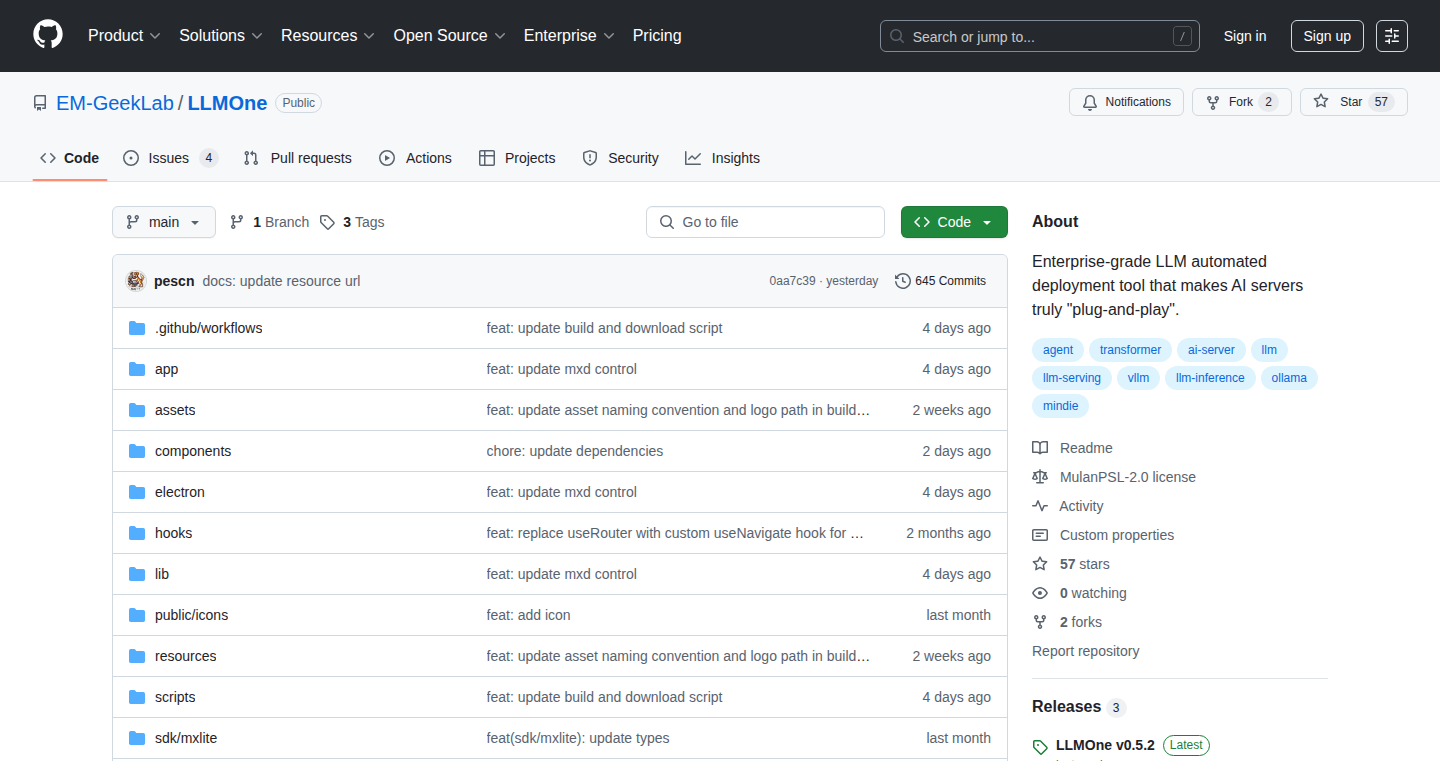
Author
pescn
Description
LLMOne automates the complex process of deploying Large Language Models (LLMs) on various hardware, from bare metal servers to existing infrastructure. It tackles the common headaches of installing operating systems, drivers, inference engines (like vLLM), and deploying models, reducing deployment time from days to hours. The core innovation lies in its automated orchestration, allowing developers to quickly and easily set up LLMs without the need for extensive manual configuration, particularly on diverse hardware including non-NVIDIA accelerators. It leverages Redfish for BMC (Baseboard Management Controller) integration, providing remote OS installation and management. This simplifies the entire lifecycle from bare metal setup to model deployment, maximizing efficiency and minimizing vendor lock-in.
Popularity
Points 4
Comments 0
What is this product?
LLMOne is a system designed to automate the deployment of Large Language Models (LLMs) on servers. It's like a one-click deployment tool for LLMs. Instead of spending days manually installing the operating system, drivers (like NVIDIA's), the inference engine (like vLLM or TensorRT-LLM), and then deploying the LLM itself, LLMOne automates these steps. It simplifies the process from bare metal installation (via BMC, like iDRAC or iBMC) or SSH to running LLMs in production environments. The project is open source, using a permissive license, offering flexibility and avoiding dependence on specific vendors. It is tailored to make the complex world of LLM deployment more accessible and less time-consuming, which is especially helpful when using non-NVIDIA hardware.
How to use it?
Developers can use LLMOne to deploy LLMs on existing servers or bare metal machines. If the server has BMC (like Dell iDRAC or Huawei iBMC), LLMOne can remotely install the OS. For existing servers or environments without BMC support (coming soon), it will support SSH access. You provide the server details and the model you want to deploy, and LLMOne handles the rest. This includes selecting the appropriate drivers, configuring inference engines, and deploying the model. It can also deploy applications, such as Open WebUI or Dify, alongside the deployed models.
So this simplifies the process: if you have a server and want to deploy a LLM, this automates all the steps so you can run your LLM much faster.
Product Core Function
· {"technicalValue":"Utilizes Redfish API for BMC integration, enabling remote OS deployment, reducing manual intervention and deployment time.","name":"Automated OS Installation and Driver Setup","description":"LLMOne automatically installs the operating system and appropriate drivers (NVIDIA, Huawei Ascend, etc.) on your server. This removes the need for manual OS installation and driver configuration, which can be time-consuming and error-prone, especially on different hardware configurations. \n\nSo this saves you the hassle of manually installing an OS and drivers, especially on less common hardware."}
· {"technicalValue":"Orchestrates Docker containers and selects the optimal inference engine based on the hardware, increasing performance and reducing manual configuration.","name":"Inference Engine and Model Deployment","description":"It automatically sets up containerized environments with inference engines (vLLM, MindIE, or OpenVINO), and deploys selected LLMs. This includes downloading the models and configuring the inference engine to utilize the available hardware effectively. \n\nSo this means you don't need to worry about configuring complex inference engines like vLLM, it does it for you."}
· {"technicalValue":"Provides integrated and easily deployed applications around the core LLM, improving usability and practical application of the LLM.","name":"Application Deployment","description":"LLMOne can deploy applications, like Open WebUI or Dify, alongside your deployed LLMs. This provides a pre-configured interface to interact with your LLMs. \n\nSo you can easily integrate your LLM with applications like chat interfaces and document processing tools."}
· {"technicalValue":"Supports a variety of hardware architectures, including NVIDIA GPUs, Huawei Ascend, and potentially Intel NPUs, enabling broader adoption.","name":"Hardware Agnostic","description":"It provides compatibility with different hardware, including non-NVIDIA accelerators, allowing you to deploy LLMs on a wider range of hardware.\n\nSo you can deploy LLMs on a wider range of hardware, including less common hardware."}
· {"technicalValue":"Provides automated performance analysis to assess the efficiency of the deployed LLM on specific hardware.","name":"Benchmarking and Performance Monitoring","description":"LLMOne automatically runs performance benchmarks like Evalscope. This means you have clear performance metrics to understand how well your model is performing on the deployed hardware.\n\nSo you know exactly how fast your LLM is running."}
Product Usage Case
· {"solution":"Instead of spending days manually setting up a new server with the OS, drivers, inference engine, and model, LLMOne automates the entire process. A system administrator can use LLMOne to provision a bare metal server and deploy an LLM in a couple of hours.","scenario":"Deploying LLMs on a new server","problemSolved":"Drastically reduces the time and effort required to bring a new server with an LLM online, freeing up IT staff to focus on other tasks."}
· {"solution":"A research team needs to deploy an LLM on both NVIDIA GPUs and Huawei Ascend accelerators. LLMOne handles the driver and inference engine configuration specific to each hardware type, allowing the team to run the same model on different hardware. The team can easily select from a range of supported inference engines via the command line.","scenario":"Deploying LLMs on diverse hardware","problemSolved":"Simplifies the deployment process across diverse hardware architectures, providing efficiency and cost savings to users."}
· {"solution":"A developer wants to quickly test different LLMs for a chatbot application. Using LLMOne, they can easily switch between different models without manually reconfiguring the environment, and test several model backends.","scenario":"Rapid prototyping with different models","problemSolved":"Enables faster experimentation and iteration with different LLMs, accelerating the development cycle."}
19
Chisel: Local-Feeling AMD GPU Development in the Cloud
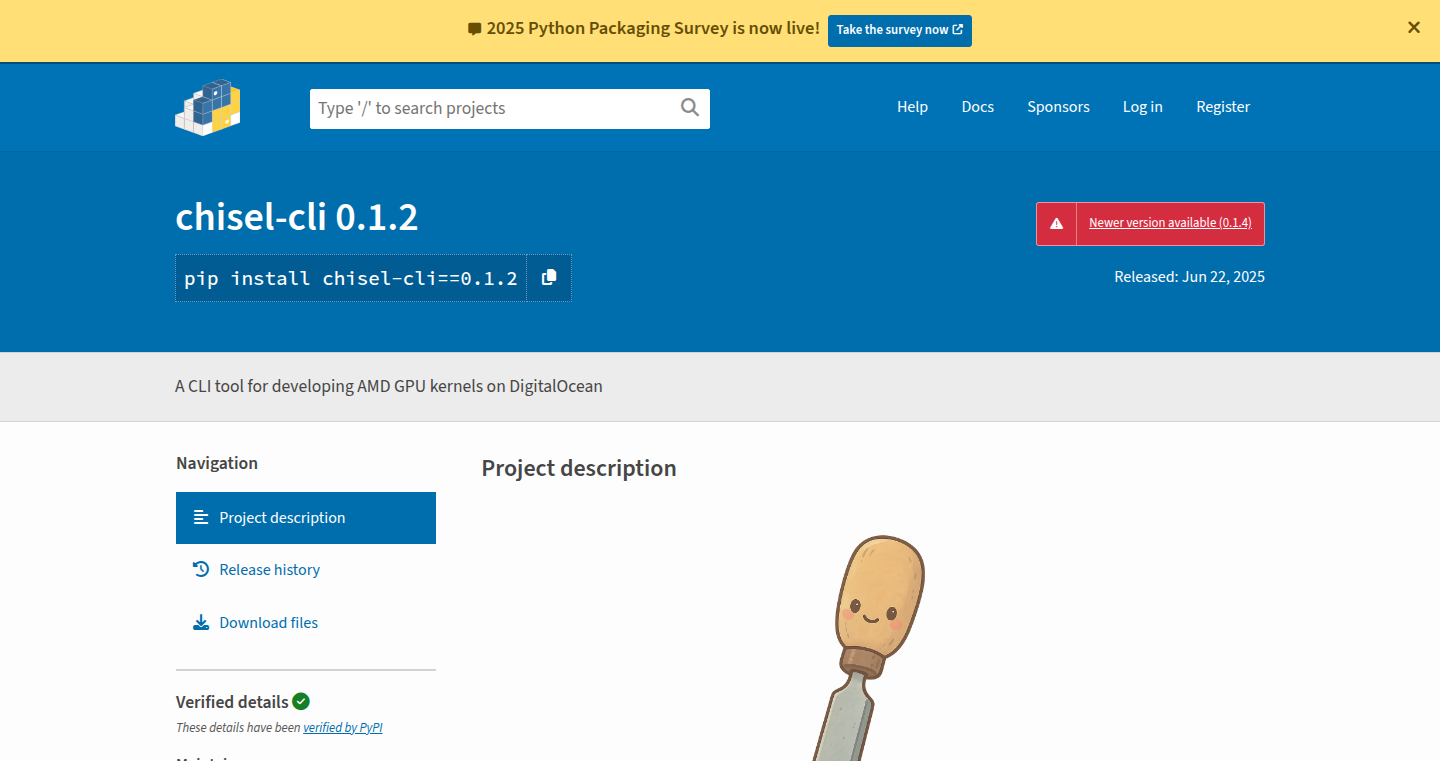
Author
technoabsurdist
Description
Chisel is a command-line tool designed to streamline AMD GPU development in the cloud, specifically targeting the MI300X. It solves the infrastructure management headache associated with remote GPU access by automating code synchronization, compilation, profiling with ROCm, and result retrieval. This allows developers to focus on optimizing their GPU kernels rather than wrestling with SSH connections, file transfers, and server setup. The tool leverages cloud infrastructure, making powerful AMD GPUs accessible at a fraction of the hardware cost.
Popularity
Points 2
Comments 2
What is this product?
Chisel is a command-line interface (CLI) that simplifies the workflow for AMD GPU development using ROCm on cloud instances. It handles the complexities of remote access by automating processes like creating a cloud instance, syncing code, compiling and profiling GPU kernels, and downloading the results. The main innovation lies in abstracting away the tedious infrastructure management, allowing developers to work on remote hardware as if it were local. It uses SSH, rsync, and ROCm tools under the hood, but provides a user-friendly interface. So this is a game-changer because it gets rid of the annoying parts of developing on a powerful GPU you don’t physically own.
How to use it?
Developers use Chisel through simple commands. For example: `chisel up` creates an AMD MI300X cloud instance. `chisel sync` pushes updated code. `chisel profile kernel.cpp` compiles, profiles, and downloads the profiling data. It integrates with ROCm's profiling tools (rocprof). It's aimed at developers working on GPU kernels, machine learning applications, or anyone leveraging AMD GPUs in the cloud. So, you use this if you want to easily use remote powerful GPUs without having to learn the complex tools to do it manually.
Product Core Function
· {"soWhat":"So you can start developing on a powerful GPU almost instantly, saving time and effort on setup.","application":"Quickly provision cloud-based AMD GPU instances, enabling rapid prototyping and development.","function":"chisel up","techValue":"Automates the setup of a remote GPU environment, removing the manual process of provisioning and configuring cloud resources. It hides the complexity of launching and managing the instance. ","description":"Spins up an AMD MI300X cloud instance in seconds."}
· {"soWhat":"So you spend less time waiting for your code to upload and more time coding.","application":"Efficiently updates code on the remote GPU instance, accelerating the development workflow.","function":"chisel sync","techValue":"Uses incremental synchronization (rsync) to optimize the transfer of code, reducing upload times and bandwidth usage.","description":"Pushes only changed files to the remote instance."}
· {"soWhat":"So you can easily find and fix performance bottlenecks in your GPU code, making it run much faster.","application":"Streamlines the process of profiling and optimizing GPU kernels, a critical step in performance tuning.","function":"chisel profile kernel.cpp","techValue":"Integrates with ROCm profiling tools (rocprof) to simplify kernel optimization. This removes the need for manual compilation, profiling, and result retrieval.","description":"Compiles, profiles, and downloads profiling traces (rocprof) automatically."}
· {"soWhat":"So you can easily see the performance metrics of your code without having to manually download them.","application":"Makes it easy to analyze results and iterate on the development process.","function":"chisel pull","techValue":"Simplifies the process of retrieving results, logs, and other artifacts from the remote instance.","description":"Grabs artifacts back to local machine."}
· {"soWhat":"So you don’t waste money on cloud resources you’re not using.","application":"Prevents runaway cloud bills and ensures efficient resource utilization.","function":"Auto cleanup","techValue":"Ensures resources are efficiently managed by automatically terminating unused cloud instances, minimizing costs.","description":"Prevents zombie droplets."}
Product Usage Case
· {"soWhat":"So you can get your machine learning models running faster on AMD GPUs.","scenario":"GPU Kernel Optimization","techProblemSolved":"Reduces the time and effort required to iterate on GPU kernel optimizations.","description":"A developer working on optimizing a machine learning model's GPU kernel uses Chisel to quickly deploy their code to an AMD MI300X instance, profile it with `chisel profile`, and download the profiling results. They iteratively modify the kernel, sync the changes with `chisel sync`, and repeat the profiling process until the kernel's performance is maximized. This saves a lot of time compared to manually using SSH and ROCm profiling tools."}
· {"soWhat":"So you can easily compare different implementations of your code on AMD GPUs.","scenario":"AMD GPU Experimentation","techProblemSolved":"Simplifies the process of conducting experiments on remote GPU hardware.","description":"A researcher wants to benchmark different implementations of an algorithm on an AMD GPU. They use Chisel to quickly set up a cloud instance with ROCm, push their code, and run their experiments. Chisel simplifies the infrastructure setup, allowing the researcher to focus on the experiment results rather than managing the cloud environment. The tool then automatically downloads the results for analysis."}
20
Kira.Art: The AI-Powered Design Assistant
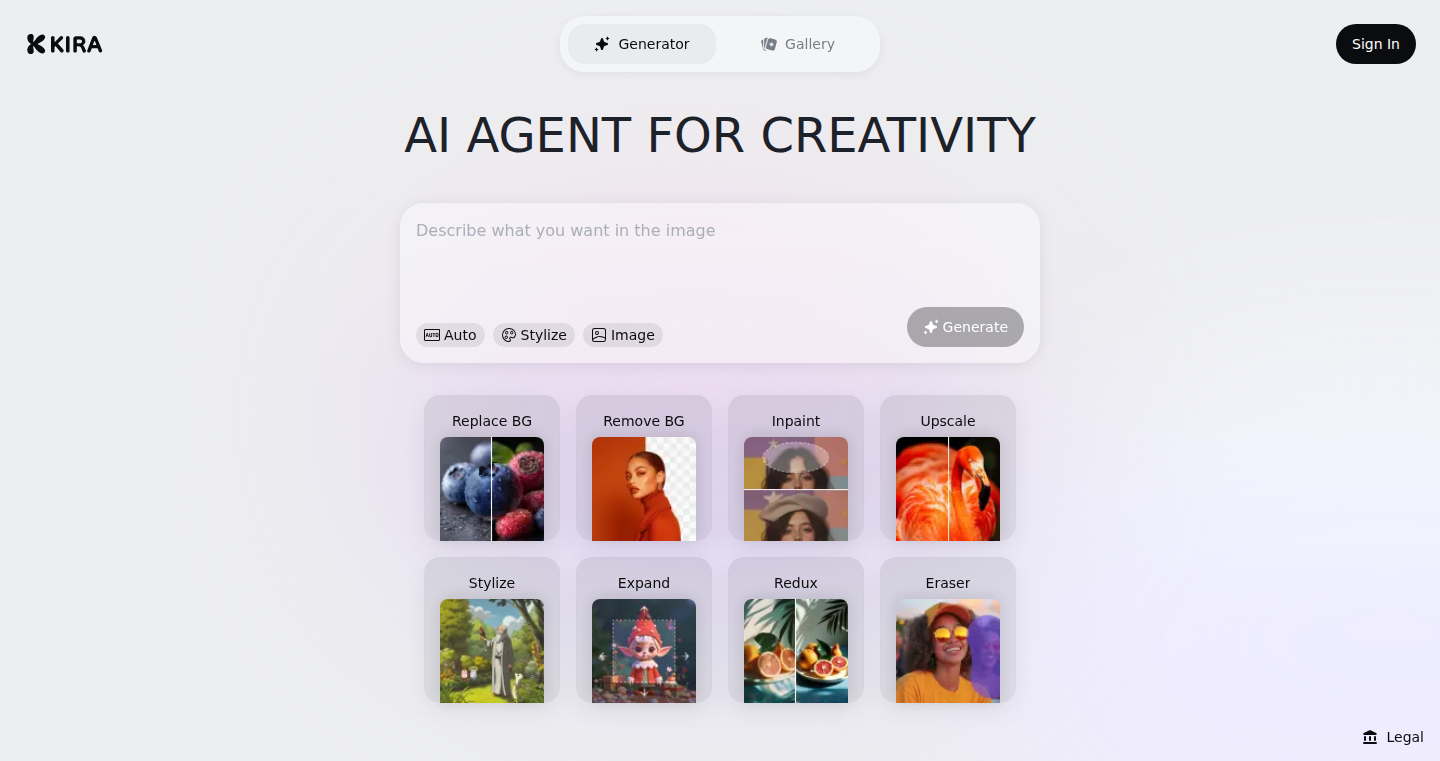
url
Author
nukedelevan
Description
Kira.Art is an AI agent designed to assist designers in generating creative content. It leverages the power of artificial intelligence, specifically focusing on diffusion models, to translate text prompts into visual outputs. The innovation lies in its ability to streamline the design process, allowing designers to quickly iterate on ideas and explore a wider range of creative possibilities. It tackles the problem of 'creative block' and accelerates concept visualization.
Popularity
Points 3
Comments 1
What is this product?
Kira.Art is essentially a smart assistant for designers. Imagine giving it a sentence like "a futuristic cityscape with neon lights" and it generates a corresponding image. It uses complex algorithms called 'diffusion models' that learn from vast amounts of image data to create new images based on your descriptions. This is a significant advancement because it allows designers to rapidly prototype ideas and explore different visual styles without the traditional constraints of manual creation. So this is like having a super-powered brainstorming partner that can generate visual concepts instantly.
How to use it?
Developers and designers can interact with Kira.Art through an API or a user interface. The core usage involves providing text prompts, selecting style preferences, and receiving generated images. These images can then be used as starting points for design projects, mockups, or even complete finished products. You can integrate it into existing design workflows by using its API to automate image generation based on user input or design specifications. So you can quickly visualize your ideas and make informed design choices.
Product Core Function
· {"applicationScenario":"Imagine designing a website and needing a unique background image. You can describe the image and Kira.Art will generate it, saving you time and effort.","functionName":"Text-to-Image Generation","description":"The primary function is generating images from text descriptions. The underlying technology, diffusion models, allows the AI to understand and interpret complex concepts and transform them into visual representations. The value here is the ability to quickly generate visual concepts without requiring a designer to start from scratch. This is very useful for prototyping, generating mood boards, or exploring different design directions."}
· {"applicationScenario":"You are working on a product brochure and need images that match your brand’s specific style. Kira.Art allows you to specify the desired style, ensuring the generated images are consistent with your brand image.","functionName":"Style and Parameter Control","description":"The ability to control the style (e.g., photorealistic, abstract, cartoon) and other parameters (e.g., color palettes, lighting) of the generated images is crucial. This allows designers to fine-tune the output to match their desired aesthetic. The value is in providing greater control over the AI's output, ensuring it aligns with the designer's vision and brand guidelines. So you can tailor the output to your specific design needs and brand identity."}
· {"applicationScenario":"You're unsure about the best visual representation for a user interface element. You can experiment with different prompts and parameters to generate variations and choose the one that best suits the UI design.","functionName":"Iterative Design Exploration","description":"This allows for quick iteration and exploration of different design options. Users can refine the prompts and parameters to explore a wide range of creative possibilities. This empowers designers to test multiple ideas and converge on the best solution efficiently. So this will greatly speed up the design process by allowing quick exploration of different options"}
Product Usage Case
· {"scenario":"Rapid Prototyping","description":"A UI/UX designer is designing a new mobile app. Instead of manually creating multiple mockups, they can use Kira.Art to generate various screen designs based on textual descriptions. This accelerates the design process and enables quick testing of different visual layouts. So it reduces the time to create initial designs allowing the designer to visualize multiple variations quickly.","value":"Saves time, improves efficiency, and allows for quicker iteration cycles."}
· {"scenario":"Content Creation for Marketing","description":"A marketing team needs images for a new advertising campaign. They can describe the desired visuals to Kira.Art, which generates multiple variations. This provides them with a range of options, saving them the cost and time of hiring photographers or designers. So it allows content creation teams to quickly generate visual assets and reduce the overall marketing costs.","value":"Reduces reliance on external creatives, speeds up content creation, and provides more creative options."}
· {"scenario":"Concept Visualization for Artists","description":"An artist needs a visual representation of a complex concept. Using Kira.Art, they can create a base image from a description and then further refine it using image editing tools. This is very useful for concept art and visualizing ideas before starting a manual creation process. So it can help accelerate idea generation and facilitate the creation of early drafts and concepts.","value":"Helps artists visualize complex ideas and provides a starting point for creative projects."}
21
Remotely Good: AI-Powered Career Navigator for Social Impact Jobs
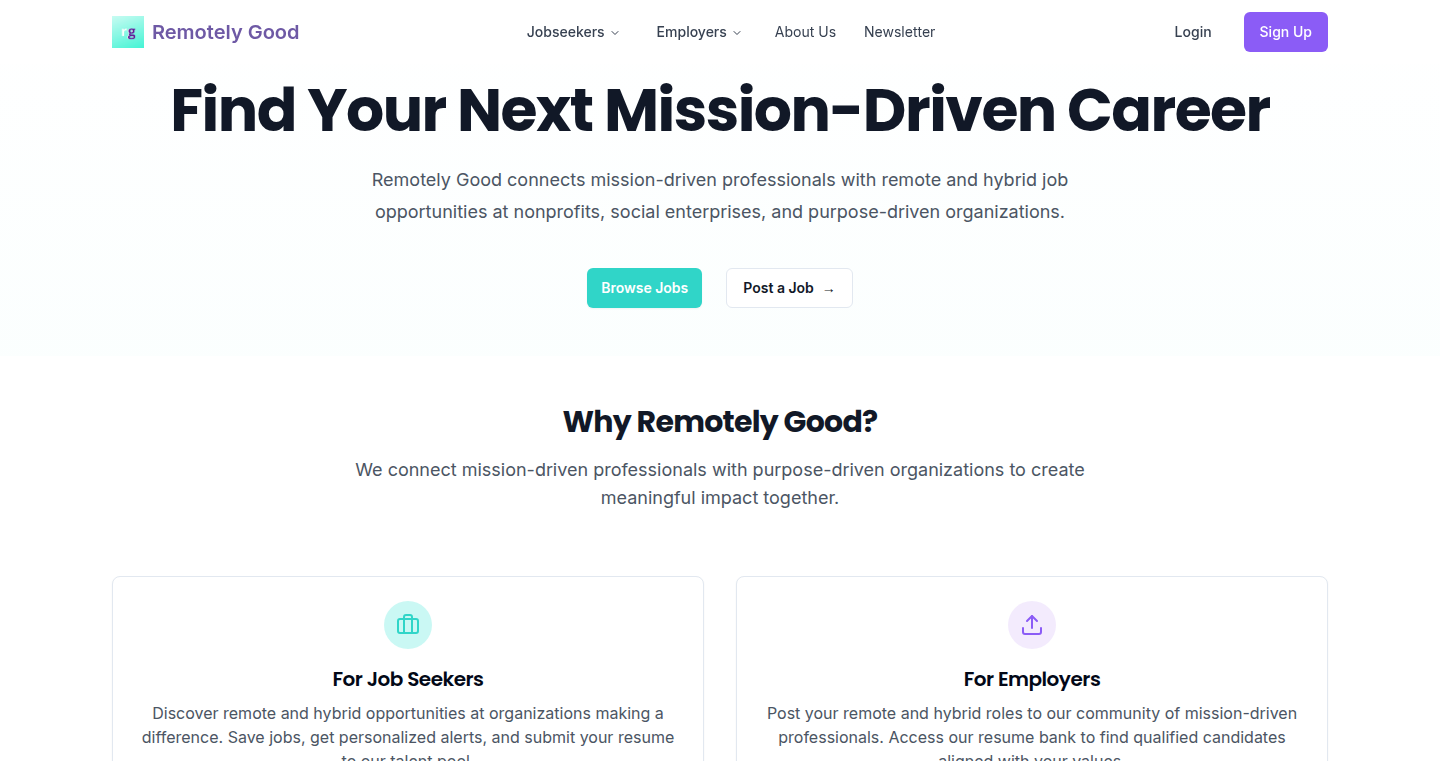
Author
Theresa_i_a
Description
Remotely Good is an AI-driven platform designed to connect individuals with remote and hybrid job opportunities within mission-driven organizations like non-profits and social enterprises. It leverages AI to curate job listings, provide personalized career tools (resume enhancement, job matching, cover letter generation, and interview prep), and offer a coaching marketplace. The project demonstrates a commitment to using AI to solve a real-world problem: making it easier for people to find meaningful work that aligns with their values. This involves innovative uses of AI for natural language processing (NLP) to match candidates with jobs and generate personalized career advice.
Popularity
Points 4
Comments 0
What is this product?
Remotely Good is a career platform utilizing AI to help users find remote and hybrid jobs, particularly those in the social impact sector. It works by using AI algorithms to analyze job descriptions, resumes, and user profiles. This allows for intelligent job matching, suggesting opportunities that are the best fit. The AI also generates personalized career tools. For example, it can enhance a user's resume to highlight relevant skills, create tailored cover letters, and prepare users for interviews. The innovation lies in applying AI, specifically NLP and machine learning models, to the career search process to automate and personalize job hunting and career development. So, it gives you an edge in the job market by saving time and effort.
How to use it?
Users can access Remotely Good through its web platform. To get started, you’d likely create a profile, upload your resume, and specify your desired job type, location preferences, and cause areas of interest. The AI then begins matching you with relevant job listings. Users can utilize tools like the resume enhancer by uploading their existing resume, which is then analyzed and improved. Similarly, they can generate cover letters by providing information about their skills and the specific job they're applying for. Interview prep tools might involve simulations or automated feedback. So, this can give you a customized job search experience.
Product Core Function
· {"functionName":"AI-Powered Job Matching","technicalValue":"Improves the efficiency of job searching and increases the likelihood of finding a good fit, reducing the time and effort required for both job seekers and employers.","description":"The platform uses AI to analyze job descriptions and user profiles, matching candidates with suitable positions. This is likely done by using NLP to understand the meaning of the job requirements and comparing them against the skills and experience listed in the user's profile. This involves techniques like keyword extraction, semantic similarity, and possibly even sentiment analysis to understand the nuances of both job listings and candidate profiles. So, it finds jobs that fit you, even if you aren't sure what to search for."}
· {"functionName":"Resume Enhancement","technicalValue":"Enhances a resume's effectiveness in the application process by optimizing it for applicant tracking systems (ATS) and human readers.","description":"The AI analyzes a user's resume and suggests improvements, such as adding keywords, highlighting relevant skills, and formatting the document for readability. This likely uses NLP to identify the core skills and experiences and comparing them against industry standards and job requirements. So, it makes your resume look better and increases your chances of getting noticed."}
· {"functionName":"Cover Letter Generation","technicalValue":"Automates the creation of high-quality cover letters, saving time and increasing the chances of securing an interview by highlighting the most relevant aspects of a candidate's profile.","description":"The platform generates cover letters tailored to specific job applications. This uses AI to personalize the letter based on the job description and the user's profile, highlighting relevant skills and experiences. This could involve fine-tuning pre-written templates using large language models (LLMs). So, it saves you time and effort creating customized cover letters."}
· {"functionName":"Interview Preparation","technicalValue":"Provides targeted interview preparation, improving candidates' confidence and performance during interviews.","description":"The AI provides tools to help users prepare for interviews. These may include simulated interviews, practice questions, and feedback on responses. This potentially uses speech recognition, NLP to analyze a user’s responses, and offer suggestions for improvement. So, it helps you practice and gain confidence."}
Product Usage Case
· {"solution":"The user creates a profile on Remotely Good, specifying their interests and skills. The AI identifies suitable job listings based on these criteria. They use the resume enhancer to make their resume more competitive and then generate a cover letter specifically tailored to the requirements of each job. The user prepares for interviews using the platform's practice tools. This will reduce the time in searching for suitable jobs, helps them to improve their job application materials, increasing the likelihood of getting hired, and prepares them for the interview, boosting their confidence.","scenario":"A job seeker struggling to find remote positions in environmental conservation.","technicalBenefit":"Leveraging NLP and AI matching algorithms to quickly find relevant jobs, while AI-powered tools help to optimize the application for success."}
· {"solution":"The organization can use Remotely Good to post job openings and gain access to a pool of candidates who are actively seeking remote work in the mission-driven space. The AI-powered matching system helps the organization find the most suitable candidates. So, the organization will reach the ideal candidates quickly, helping to fill positions faster.","scenario":"A non-profit organization needing to find qualified candidates to fill remote roles.","technicalBenefit":"Streamlines the hiring process by quickly matching the organization with a curated list of potentially qualified candidates."}
22
Sherlog-MCP: AI Agent Collaboration Workspace with Persistent Memory
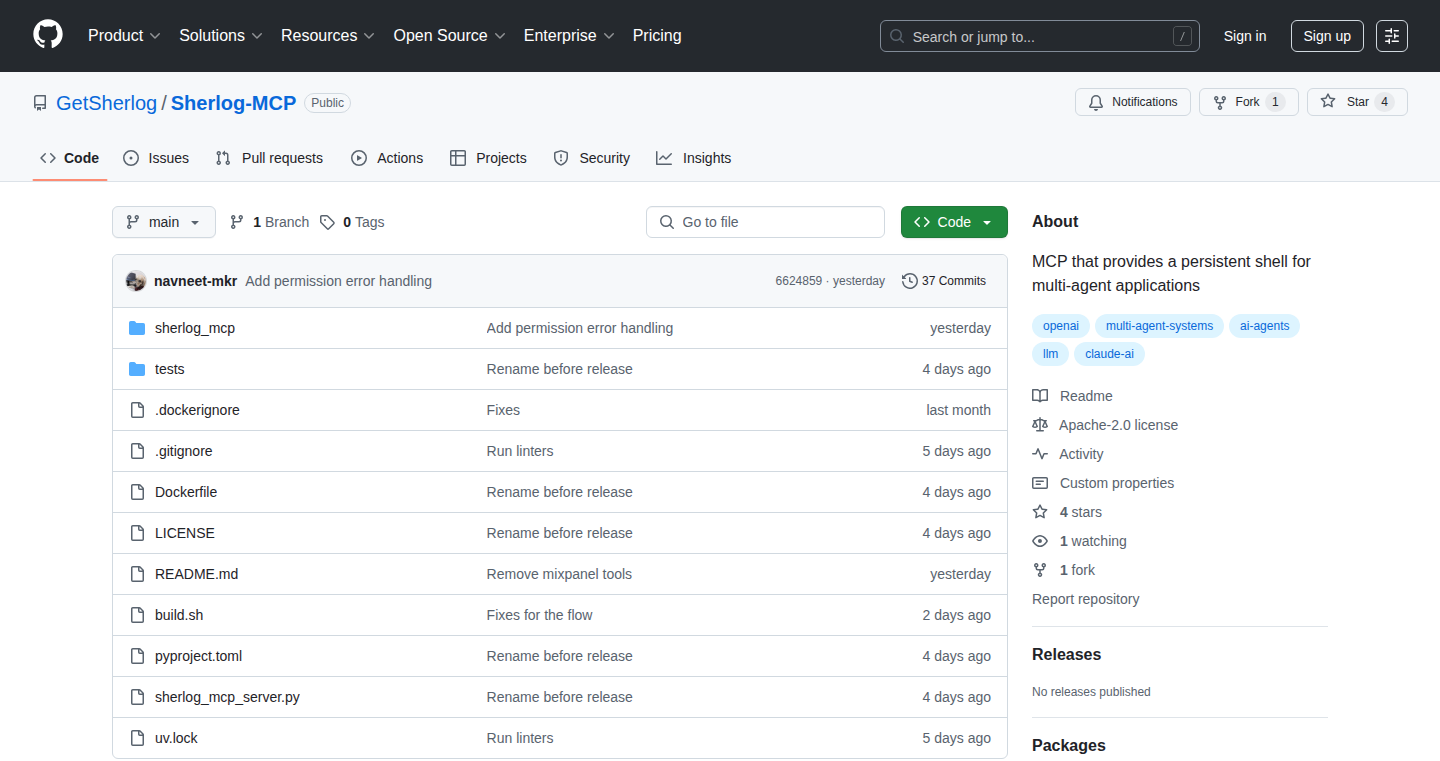
Author
teenvan_1995
Description
Sherlog-MCP is a novel approach to building multi-agent AI applications by leveraging an IPython shell as a persistent workspace. This means the AI agents can collaboratively tackle tasks, share information, and retain memory of their interactions. The core innovation lies in using the REPL (Read-Eval-Print Loop, or the interactive shell) as a central memory layer, allowing for a more fluid and collaborative AI workflow, especially for debugging. It's like giving multiple AI assistants a shared notepad and the ability to instantly execute and review their notes. This is particularly useful for bug investigations, as it allows AI agents to trace and analyze issues in a shared, accessible environment.
Popularity
Points 4
Comments 0
What is this product?
Sherlog-MCP is essentially a collaborative, persistent workspace built around an IPython shell, designed for multiple AI agents. Think of it as a shared 'brain' for AI agents. The 'brain' is the REPL (Read-Eval-Print Loop) – a place where agents can interact, store information (memory), and execute code. The key innovation is using this REPL as the primary memory layer, allowing AI agents to collaborate more effectively, especially when diagnosing and fixing software bugs. It's a departure from typical AI agent setups which often lack a shared persistent memory and collaborative execution environment. This persistent context allows the agents to learn from each other and build on previous findings.
How to use it?
Developers would interact with Sherlog-MCP by integrating their AI agents with the IPython shell. They would define how these agents can access and manipulate data, run code within the shell, and share information. The primary use case is for debugging AI systems and other software applications. Imagine a scenario where multiple AI agents are examining a bug. They can each write notes (code, observations) within the shell, share those notes, and execute them to test hypotheses. Developers would likely use it by: 1. Defining the tasks for the AI agents. 2. Setting up their access to the shared IPython shell (which becomes their shared brain). 3. Monitoring the agents' interactions and results within the shell to understand their reasoning and identify root causes of issues.
Product Core Function
· {"applicationScenario":"Debugging complex software issues, long-running investigations where context is important.","name":"Persistent Workspace","description":"The IPython shell acts as a persistent workspace for AI agents. The agents have a shared memory, so they can store context and learnings across sessions, leading to better understanding of problems. The value is allowing AI agents to retain context and build knowledge over time. This provides efficiency in problem-solving. So what? This means your AI debugging assistant doesn't forget what it learned yesterday; it remembers the previous steps and builds on that. For instance, it could remember an error you faced days ago and proactively look for related issues in a new problem."}
· {"applicationScenario":"Complex bug investigation, automated code review, complex data analysis.","name":"Multi-Agent Collaboration","description":"The system allows multiple AI agents to collaborate within the same workspace. Agents can share data, execute code, and provide feedback to each other. The value here is improved efficiency and accuracy through parallel processing and cross-validation. So what? This allows multiple AI agents to work in parallel. One agent can focus on finding the error, another on reproducing it and a third on suggesting solutions."}
· {"applicationScenario":"Interactive debugging sessions, rapid prototyping of AI workflows, educational tools for understanding AI agent collaboration.","name":"IPython Shell as the Memory Layer","description":"Using the IPython shell (with its built-in REPL) as the primary memory layer is a clever hack. This gives the AI agents an interactive and easily accessible environment. This allows agents to interact with each other easily. The value is in its simplicity and efficiency, providing immediate feedback and ease of interaction. So what? This means the agents can quickly run code, see the results, and instantly share their findings. It makes the debugging process much more intuitive."}
Product Usage Case
· {"technicalBenefits":"Parallel processing of debugging tasks, shared memory of the investigation, efficient validation of fixes.","scenario":"Automated Bug Investigation","description":"Imagine a software application with a persistent bug. Sherlog-MCP could deploy a team of AI agents: one agent analyzes error logs, another reproduces the error, and a third proposes possible fixes. The IPython shell serves as the central memory layer, allowing them to share findings, build hypotheses, and execute code to validate them. So what? This leads to faster bug fixes and reduced developer time spent on tedious debugging tasks."}
· {"technicalBenefits":"Automated identification of code issues, collaborative code analysis, quicker feedback cycles.","scenario":"AI-Assisted Code Review","description":"In a code review scenario, multiple AI agents could analyze a code base for potential issues. The IPython shell allows them to share information about code smells, potential vulnerabilities, and style inconsistencies. The agents could collectively run tests, suggest improvements, and provide feedback to the developer. So what? This improves code quality and reduces the risk of introducing bugs early in the software development lifecycle."}
23
URPAL: AI-Powered Communication Summarizer
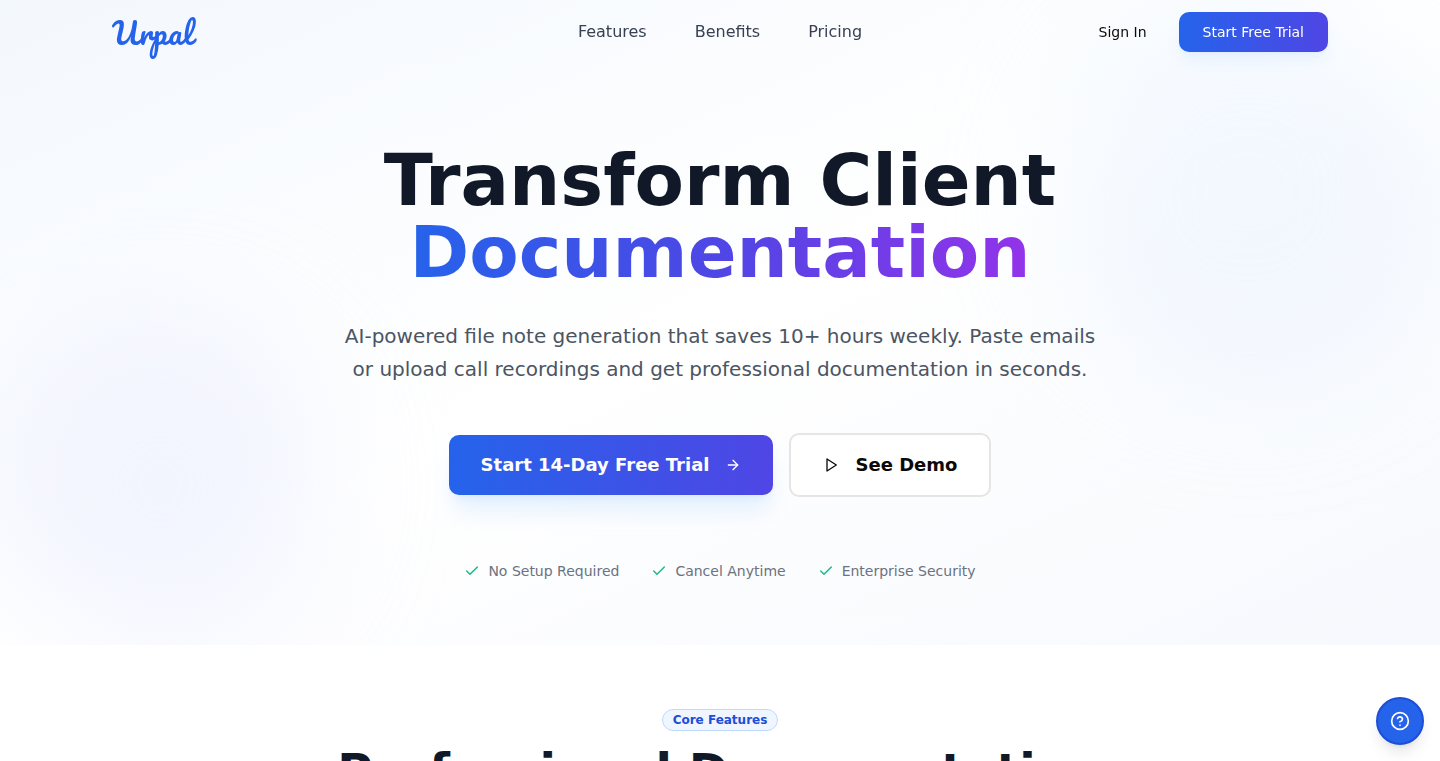
Author
lovetobuild
Description
URPAL is an AI assistant designed to transform emails and call recordings into professional file notes, specifically targeted at legal and consulting professionals. The key innovation lies in its smart detection of communication direction (e.g., did you send or receive the email/call?), leveraging pattern matching instead of solely relying on AI predictions. This approach prioritizes accuracy and reliability in understanding the context of the communication.
Popularity
Points 4
Comments 0
What is this product?
URPAL is a tool that automatically creates summaries and file notes from your emails and phone calls. It uses a combination of technologies: a React-based front-end (for the user interface), a Node.js backend (for handling data and logic), PostgreSQL (a database for storing information), OpenAI's GPT-4o (for understanding and summarizing the content), and Stripe (for managing payments). The most innovative part is how it figures out whether you sent or received an email or call. Instead of just guessing with AI, it uses clever rules and pattern matching to make sure it gets the direction right. So this uses smart, reliable techniques to help you organize and manage your communications more efficiently.
How to use it?
Developers can use URPAL to integrate with their existing productivity workflows. They can upload email conversations or call recordings. URPAL will then process these inputs and generate summaries, key takeaways, and organized file notes. Integration could involve connecting the application to email servers or call recording systems using APIs. This product can be incorporated into larger legal or consulting workflow platforms. So, developers can build their own solutions on top of the core functionality by integrating with the provided API.
Product Core Function
· {"functionName":"Communication Direction Detection","technicalValue":"This innovative approach enhances the reliability of the entire system by focusing on accuracy rather than complex AI analysis. This reduces errors and improves the overall performance of note generation.","description":"URPAL accurately identifies the direction of communication (sent/received) using pattern matching. This is a crucial feature for proper note generation. This is better than relying on AI only. It makes sure that the right information is associated with the right person. So this means more accurate and useful summaries."}
· {"functionName":"AI-Powered Summarization (GPT-4o)","technicalValue":"This uses the power of advanced AI to extract and summarize the critical information. This will help you save a lot of time.","description":"Leveraging OpenAI's GPT-4o, URPAL summarizes lengthy communications into concise and easily digestible file notes. This includes extracting key information, identifying action items, and highlighting important details. So, this means you can quickly get the gist of an email or call without reading everything."}
· {"functionName":"Integration with Email and Call Data","technicalValue":"This increases productivity by seamlessly importing data, saving the user from manual data entry.","description":"The application supports integration with various email and call recording systems, allowing users to automatically import and process communication data. So this means you can automatically get notes for all your communications without extra steps."}
· {"functionName":"Structured File Note Generation","technicalValue":"This focuses on user-friendliness and ease of use by structuring the output for better readability and faster information retrieval.","description":"URPAL organizes summarized information into structured file notes, making it easier for users to quickly find relevant details. So, you get a clean and easy-to-understand format."}
Product Usage Case
· {"useCase":"Legal Professionals","soWhat":"So, this lets lawyers spend more time on legal strategy and less time on paperwork.","description":"Lawyers can upload emails and call recordings related to a case. URPAL will generate summaries and notes, quickly highlighting key facts, agreements, and deadlines. This saves time and reduces the risk of missing critical details.","technicalExplanation":"By analyzing communication direction, URPAL accurately differentiates between client instructions and internal discussions, creating a more organized and reliable record of each case."}
· {"useCase":"Consulting Firms","soWhat":"So, this will allow consultants to collaborate more effectively and deliver better results.","description":"Consultants can use URPAL to convert client meeting recordings into actionable meeting notes. They can then quickly share insights and action items with their teams and clients. This leads to improved client communication and project management.","technicalExplanation":"The use of pattern matching ensures that the source of the information is accurately identified, leading to better context and note generation."}
24
Cutmuse: AI-Powered Personalized Style Advisor
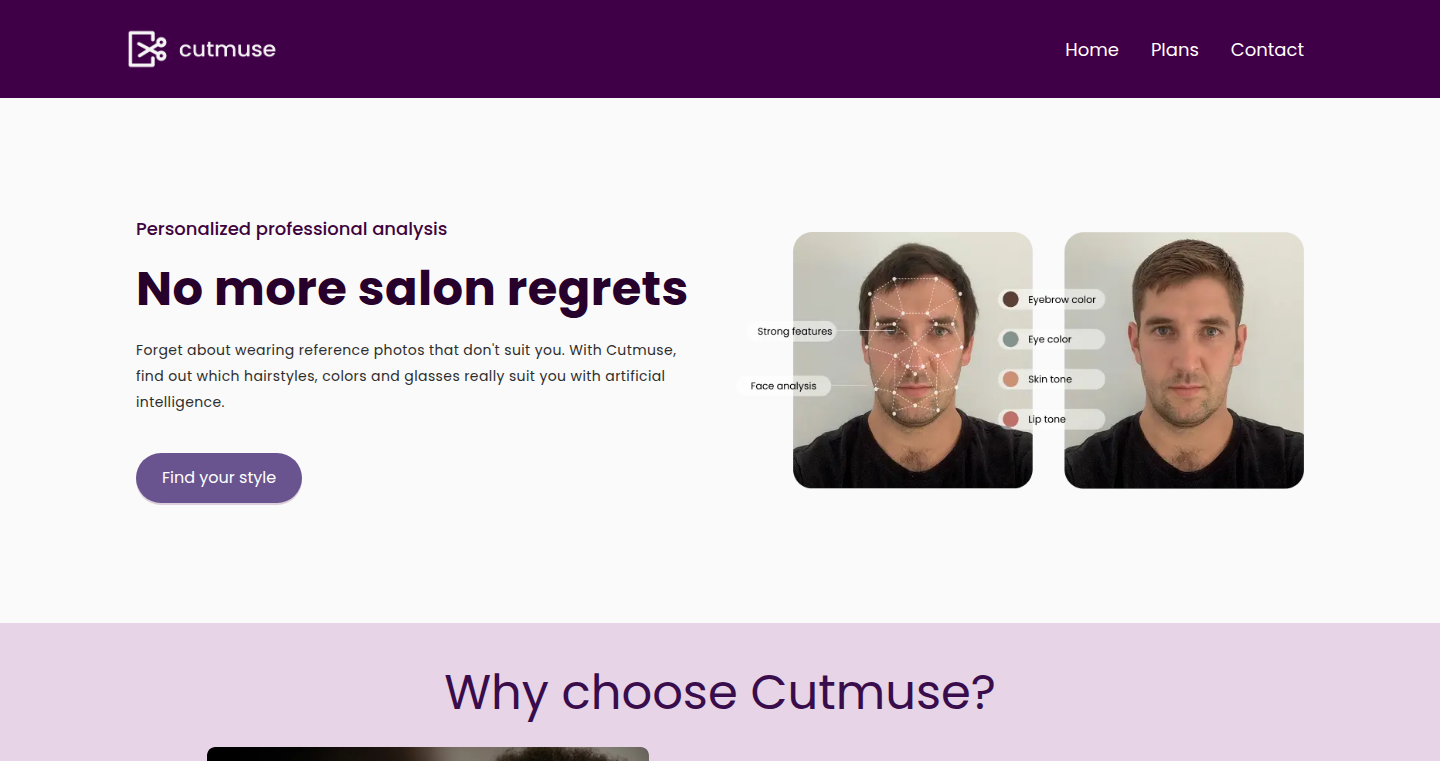
Author
josepablomujica
Description
Cutmuse is an AI-powered tool that analyzes your facial features to recommend personalized haircuts, hair colors, and glasses. It uses advanced computer vision techniques like facial landmark detection and color analysis, along with principles from professional image consulting (visagism). This allows Cutmuse to provide structured and tailored style recommendations, going beyond simple filter-based approaches. It solves the common problem of not knowing which hairstyles or colors best suit an individual's face and features.
Popularity
Points 3
Comments 0
What is this product?
Cutmuse is a web application leveraging Artificial Intelligence to provide style recommendations. It works by first analyzing a user-uploaded photo of their face. Behind the scenes, it uses computer vision algorithms to detect key facial landmarks (like the corners of your eyes, nose, and mouth). This data is then used to determine your face shape and other relevant characteristics. The system then applies visagism principles – a method used by image consultants – to suggest haircuts, hair colors, and glasses frames that best complement your unique features. The AI engine combines handcrafted logic with feedback from users to refine its suggestions. So, Cutmuse helps you get personalized style advice without needing an expensive consultation.
How to use it?
To use Cutmuse, simply upload a photo of yourself (no login required for the free version). Within minutes, you receive a personalized style report. You can use this report to get inspiration for your next haircut, hair color, or even your next pair of glasses. You can integrate Cutmuse's recommendations into your daily style choices. This is especially useful before a haircut appointment or when shopping for eyewear or new hair products.
Product Core Function
· {"functionName":"Facial Landmark Detection","description":"Cutmuse uses AI to identify key points on your face (eyes, nose, mouth, etc.). This allows the system to understand your facial structure, including shape and proportions. \n\n**So this is useful because:** It's the foundation for understanding your face, allowing the AI to make relevant style recommendations."}
· {"functionName":"Face Shape Analysis","description":"Based on the facial landmarks, Cutmuse determines your face shape (round, oval, square, etc.). This is critical because different face shapes suit different hairstyles. \n\n**So this is useful because:** It avoids the 'one-size-fits-all' approach and helps you find haircuts that flatter your face shape."}
· {"functionName":"Color Analysis (Skin Tone)","description":"The AI also analyzes your skin tone to suggest hair colors that complement your complexion. \n\n**So this is useful because:** This helps you choose hair colors that make your skin look vibrant, avoiding colors that might wash you out."}
· {"functionName":"Style Recommendations","description":"Based on the analysis, Cutmuse provides personalized recommendations for haircuts, hair color, and glasses frames. This involves applying principles from image consulting. \n\n**So this is useful because:** It offers data-driven and tailored advice, saving you time and potentially money, and avoiding style missteps."}
Product Usage Case
· {"scenario":"Before a Haircut Appointment","description":"You are unsure which hairstyle would suit your face. You use Cutmuse to upload a photo. The system analyzes your face shape and suggests several haircuts that flatter your features. Armed with these recommendations, you go to your hairstylist, making the consultation more efficient and you more confident in your decisions. \n\n**So this is useful because:** You're less likely to end up with a haircut you dislike and are more likely to achieve a look you love."}
· {"scenario":"Online Glasses Shopping","description":"You are shopping for new glasses online and find the selection overwhelming. You use Cutmuse to get recommendations for glasses frames that match your facial proportions, narrowing down your choices. This simplifies the decision-making process and helps you find frames that look great on you.\n\n**So this is useful because:** You avoid the hassle of endless browsing and potentially ordering glasses that don't fit or suit you."}
25
MonitorLLM: Affordable LLM SEO Tracking
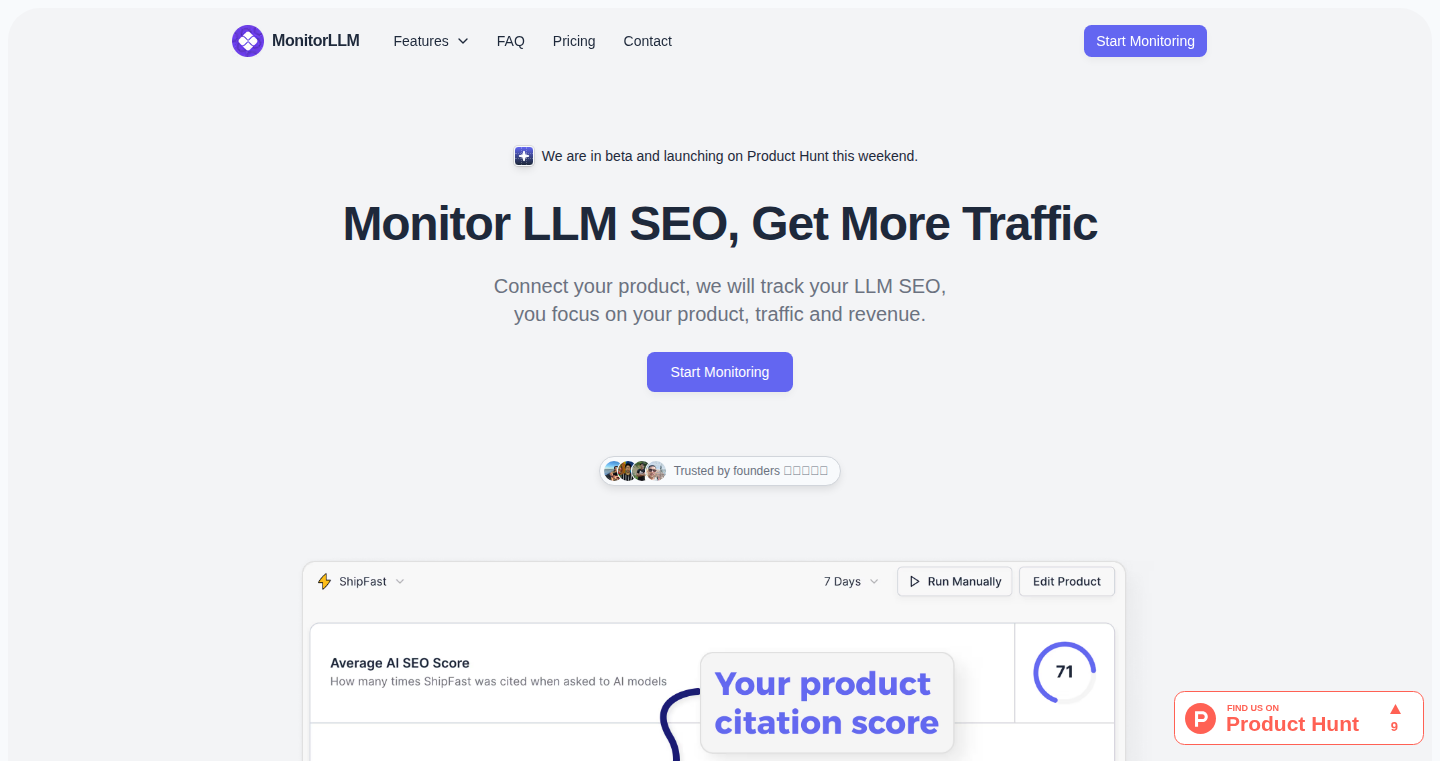
Author
amittambulkar
Description
MonitorLLM is a tool designed to track and analyze the Search Engine Optimization (SEO) performance of Large Language Models (LLMs) at a significantly lower cost than existing solutions. It focuses on providing insights into how your content is performing in the context of LLMs, helping you optimize content to increase its visibility and get cited more often by AI models. The core innovation lies in its cost-effectiveness and its focus on the LLM SEO landscape, providing a practical solution for content creators and businesses to navigate the evolving world of AI-driven search.
Popularity
Points 2
Comments 1
What is this product?
MonitorLLM helps you understand how your content is performing in the context of LLMs. Instead of relying on expensive SEO tools, it offers an affordable way to monitor your content's visibility and identify opportunities for improvement. It analyzes factors that influence how LLMs interact with your content, helping you get cited more often by AI models. The innovation is its affordability and the targeted focus on LLM SEO, making this niche accessible to everyone.
How to use it?
Developers can integrate MonitorLLM by providing content URLs or keywords. The tool will then analyze the content, track its performance, and provide actionable insights, such as opportunities to enhance your content to rank higher in LLM results. You can then integrate those insights into your content strategy. So, this means that you can quickly identify and address SEO gaps specifically related to how LLMs are using and showcasing your content.
Product Core Function
· {"applicationScenario":"Content creators aiming to optimize their articles for LLM-powered search results.","functionName":"LLM-Specific SEO Analysis","description":"Analyze content for factors relevant to how LLMs process and present information. This includes things like structured data, clarity of information, and authority signals. This analysis helps creators tailor their content to be easily understood and cited by LLMs. So what? It makes it much easier for your content to be used and recognized by the AI models that are increasingly important to discoverability. "}
· {"applicationScenario":"Competitive SEO analysis and benchmarking in the LLM-driven search environment.","functionName":"Competitor Monitoring","description":"Monitor how competitors' content is performing in the LLM landscape, helping to identify best practices and potential areas for improvement in your own content strategy. Understanding what other people are doing provides valuable strategic intelligence. So what? It gives you a clear understanding of what works and what doesn't, so you don’t have to start from scratch."}
· {"applicationScenario":"Startups and content creators seeking budget-friendly SEO tools.","functionName":"Cost-Effective SEO","description":"Provide cost-effective SEO insights, making sophisticated SEO analysis accessible to a wider range of users. A key innovation is the accessibility to the core service. So what? It means you can track, and optimize your content even if you're working on a budget."}
· {"applicationScenario":"Content creators who want to be told exactly what to improve to boost performance in LLM results.","functionName":"Actionable Insights and Action Items","description":"Based on the analysis, MonitorLLM provides actionable recommendations for improving content. It goes beyond just presenting data; it tells you what to do. So what? It offers practical guidance, making it easier to improve SEO performance by providing very clear next steps."}
Product Usage Case
· {"solution":"MonitorLLM provides easy to apply insights that directly lead to improved SEO.","scenario":"A blog owner notices their articles aren't showing up in LLM search results. They use MonitorLLM to analyze their content, identify areas for improvement (like missing structured data or unclear language), and make adjustments. After re-optimizing their content, their articles are increasingly cited by LLMs, leading to more traffic."}
· {"solution":"MonitorLLM provides the ability to benchmark and get a clear overview of the landscape.","scenario":"A company wants to monitor how their competitors' content is performing in LLM search results. They use MonitorLLM to track the competitor's SEO strategies, identify best practices, and tailor their own content to compete effectively. The advantage is a deeper understanding of the market."}
26
Beast 2D: Unleashing the Canvas for Browser-Based Game Development
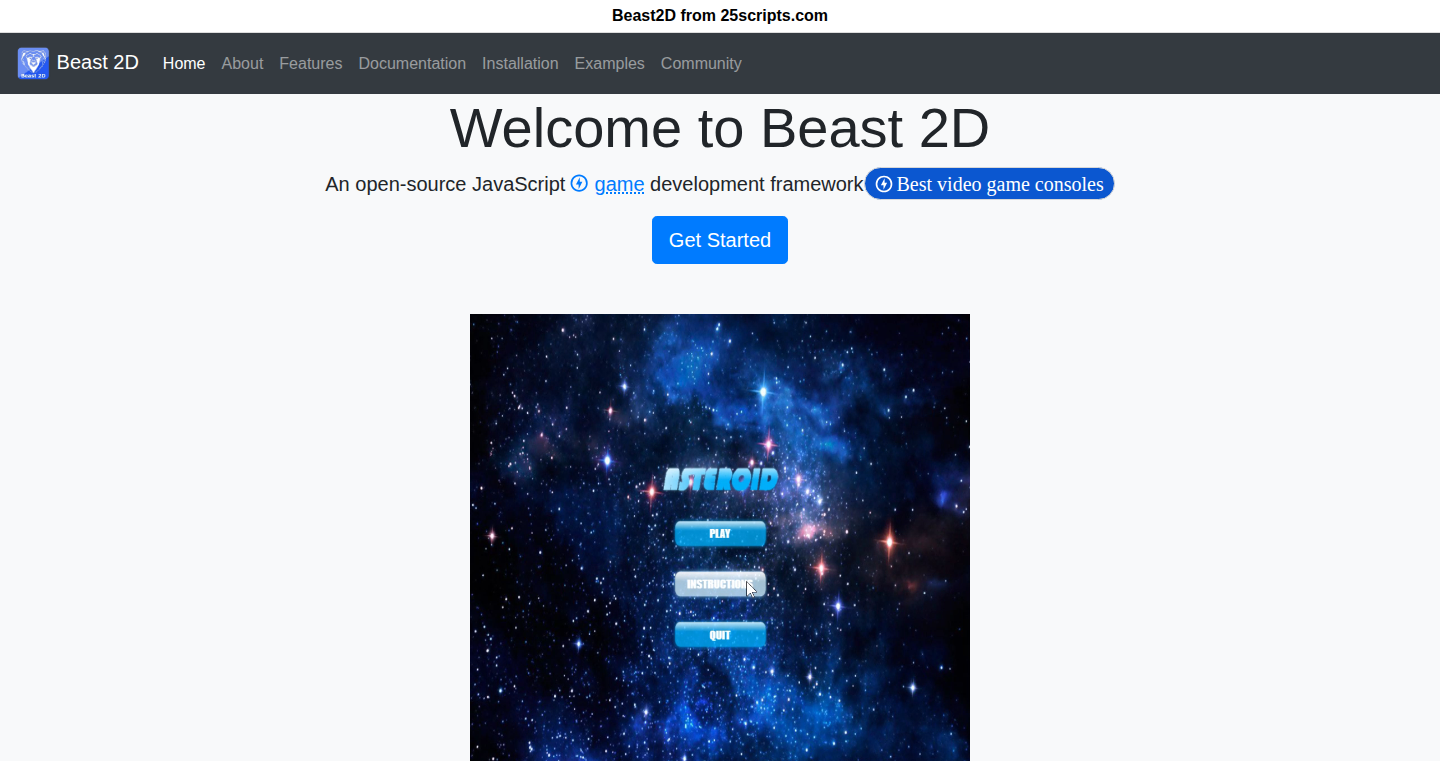
Author
cewblog
Description
Beast 2D is an open-source JavaScript framework designed to simplify the creation of 2D games within a web browser. It leverages HTML5's canvas element for rendering, and offers essential features such as sprite animation, event handling, physics simulation, and a component-based entity system. The project stands out by its simplicity: no build tools are needed, just include the framework in your HTML file and start coding. This focuses on ease of use and quick prototyping.
Popularity
Points 3
Comments 0
What is this product?
Beast 2D is essentially a toolkit for building 2D games that run directly in your web browser. It works by using the HTML5 canvas, which is like a digital drawing board. The framework simplifies the complex parts of game development, like making moving characters (sprite animation), reacting to player actions (event handling), simulating how things move and interact (physics), and organizing game elements in a modular way (component-based entity system). So, it takes the pain out of writing low-level code and lets you focus on the fun part: creating your game. The innovative part is its simplicity; you don't need complicated setup steps or special tools – just plain JavaScript.
**So this helps me because:** it lets you quickly create games without needing to master complex build processes or specialized software. It's ideal for beginners and experienced developers alike, letting you focus on game logic and creativity rather than the technical hurdles.
How to use it?
To use Beast 2D, you simply include the framework's JavaScript file in your HTML file. Then, you can use the framework's built-in functions to create game objects (sprites), handle user input, animate characters, and simulate physics. Developers can use it for various game development scenarios, like creating casual web games, educational games, game prototypes, and interactive visualizations. For example, a developer could create a platformer game by defining character sprites, setting up collision detection, handling player controls, and implementing game mechanics like jumping and running.
**So this helps me because:** it gives you a simple way to start building games right away. It removes the friction of setting up a development environment, making it easier and faster to bring your game ideas to life.
Product Core Function
· {"functionName":"Sprite Animation","description":"Beast 2D provides tools to create and manage animated sprites. This allows developers to create moving characters, dynamic objects, and visually engaging game elements. It manages the sequences of images and how they appear over time to create the illusion of movement. The value here is in simplifying the animation process, which would otherwise require writing complex code to control image frames and timing.\n\n**So this helps me because:** you can bring your game characters and environment to life with dynamic animations with minimal effort."}
· {"functionName":"Event Handling","description":"The framework handles user input, such as keyboard presses, mouse clicks, and touch events. This lets you easily detect when players interact with the game. This abstraction saves developers from the complexities of directly interacting with browser events.\n\n**So this helps me because:** you can easily make your game react to player actions, which is essential for any interactive game."}
· {"functionName":"Physics Engine","description":"Beast 2D includes a basic physics engine that simulates object movement, collision detection, and gravity. This allows developers to create realistic or stylized physics interactions within the game world, such as character movement, object interactions, and game world simulations. Instead of having to write all the collision and physics logic yourself, you can use this.\n\n**So this helps me because:** you can quickly add realistic interactions to your game without having to build them from scratch."}
· {"functionName":"Component-Based Entity System","description":"Beast 2D uses a component-based entity system to organize game objects. This system allows developers to build complex game objects by combining smaller, reusable components. This approach promotes code reusability, maintainability, and makes it easy to modify and extend game objects. Instead of all the code being messy, you can separate the different parts of a game element into easy to manage components.\n\n**So this helps me because:** it helps organize the code and makes it easier to build, modify, and expand your game."}
Product Usage Case
· {"scenario":"Building a Simple Platformer Game","description":"Developers can use Beast 2D to quickly create a basic platformer game. They would define character sprites, implement platforming controls using event handling, simulate jumping and gravity with the physics engine, and use sprite animation for character movement. The component system could be used to define character behavior like health, attack, or movement speed.\n\n**So this helps me because:** it would significantly reduce the time and effort needed to build such a game."}
· {"scenario":"Creating Educational Games or Prototypes","description":"Developers can utilize Beast 2D for educational games to teach fundamental physics principles, create interactive tutorials, or design game prototypes to test new game mechanics rapidly. The ease of use and minimal setup enables rapid iteration and experimentation. For example, one could rapidly create a game demonstrating Newtonian physics concepts.\n\n**So this helps me because:** it removes the technical barriers so you can focus on experimenting with game ideas and getting quick results."}
27
Display-Adaptive Font Scaling for Gnome Shell
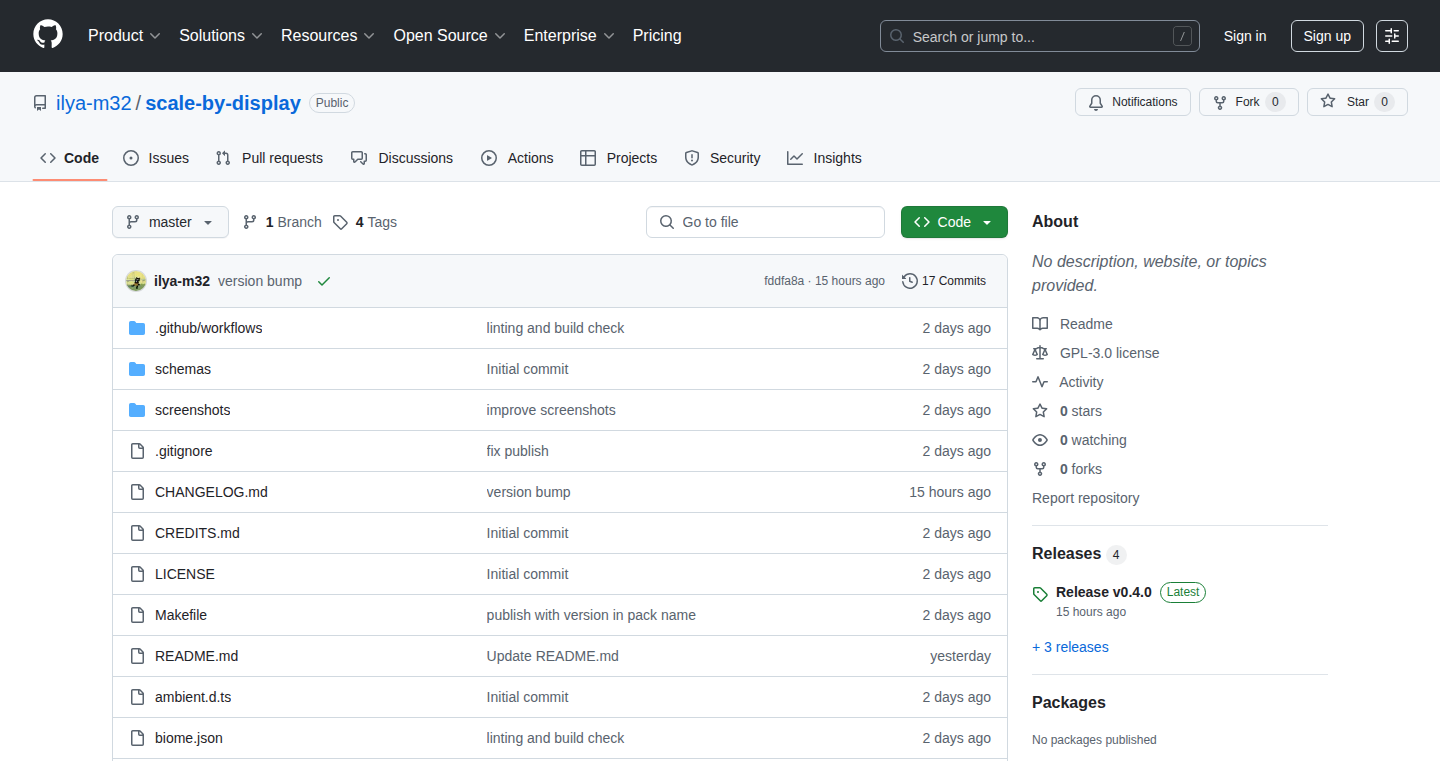
Author
k0tan32
Description
This is a "Quality of Life" extension for Gnome Shell (a popular desktop environment on Linux). It intelligently adjusts the size of the text and interface elements on your screen based on the display you're currently using. This addresses the common problem of text appearing too small or too large when switching between different monitors or connecting to a laptop with varying display resolutions. Instead of relying on potentially buggy fractional scaling, it uses a more reliable approach to provide a smoother user experience.
Popularity
Points 3
Comments 0
What is this product?
This extension automatically changes the font size on your Linux desktop. It figures out the pixel density (how many pixels are packed into an inch) of your display and adjusts the font size accordingly. Think of it like this: if you have a high-resolution screen, it will make the text bigger so you can easily read it. If you have a lower-resolution screen, it will make the text smaller so it fits better. It works by calculating a scaling factor based on the current display profile. The extension avoids fractional scaling which can sometimes cause issues, especially with older apps and those built using Electron. This provides a more stable and reliable solution, maintaining a good user experience across various setups.
How to use it?
Install this extension on your Gnome Shell desktop. It will then automatically detect your display and adjust the font scaling. It integrates with Dash to Dock (a popular dock for Linux), so your icons and other interface elements will also scale correctly. You don't need to manually configure anything most of the time. You simply install it and forget about it. So, if you dock your laptop at your desk, the font will scale for your big screen, but when you unplug it to go, the font will switch again to match the laptop's screen.
Product Core Function
· {"functionName":"Automatic Font Scaling","description":"The core function is to automatically determine the correct font size for each display. The extension calculates a scaling factor based on your screen's pixel density (PPI). This is critical for providing a good user experience across different displays. This is a real improvement over having to manually adjust font sizes every time you plug your computer into a new screen. This helps avoid eye strain and makes your desktop usable, regardless of the display you're using.","value":"So this means you don't have to fiddle with settings every time you connect to a new monitor or use your laptop on the go. It just works!"}
· {"functionName":"Integration with Dash to Dock","description":"This extension also seamlessly integrates with the Dash to Dock extension, so the dock icons and layout will scale appropriately with your screen. This ensures that all elements of the desktop, not just the text, are consistent and easy to see. The integration guarantees a coherent appearance by changing the font size along with your apps. So, the interface elements will scale automatically, giving a fluid experience.","value":"So your whole desktop looks good – not just the text. This feature gives a more cohesive and user-friendly experience, so everything is easy to read, and the design is consistent."}
· {"functionName":"Compatibility with Wayland and X11","description":"This extension supports both Wayland and X11, which are different ways Linux handles displaying graphics. This broad compatibility ensures that the extension works on almost all Linux systems. This provides broad appeal and applicability.","value":"This makes the extension more universally useful. Whether you are using a newer or older Linux system, it should work for you!"}
Product Usage Case
· {"solution":"When you bring your laptop to work and connect it to an external monitor, the text and interface elements will automatically adjust to the proper size. Similarly, when you take your laptop home, the font size changes again to display correctly on the laptop screen. This is automatic so that the change is seamless.","scenario":"Using a laptop at home and in the office","value":"So no more tiny text when you connect to a larger monitor or huge text when on your laptop screen!"}
· {"solution":"When presenting with a laptop connected to a projector, the font size automatically adjusts to be easily seen by everyone. You can then display the content clearly without manual adjustments.","scenario":"Connecting a laptop to a projector","value":"No more squinting at the screen while presenting. Your audience will thank you!"}
· {"solution":"If you use multiple displays with varying resolutions, the font size will adjust automatically to the resolution of the window moved on each screen. So the content is readable. You can move windows easily, knowing the scaling is handled automatically.","scenario":"Working with multiple displays of different resolutions","value":"The text will be readable, regardless of the monitor it is displayed on."}
28
TCP-Insight: Your Network Detective
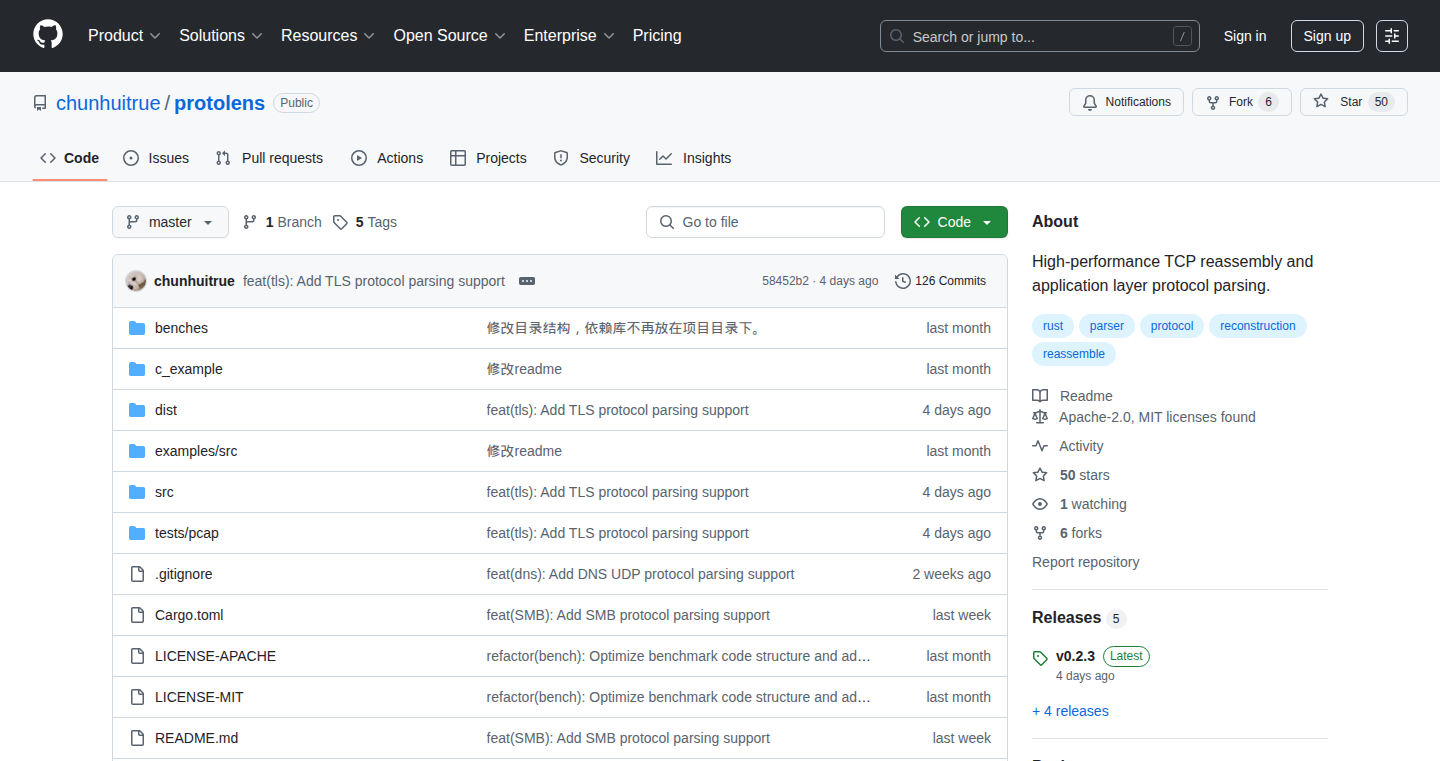
Author
chunhui_true
Description
TCP-Insight is a library that allows you to reconstruct and analyze network traffic. It's like a detective that reassembles fragmented messages sent over the internet (TCP packets) and examines their content. The key innovation lies in its ability to parse application-layer protocols, allowing you to understand the 'language' being spoken by different applications. This is especially helpful when debugging network issues or investigating security incidents.
Popularity
Points 2
Comments 1
What is this product?
TCP-Insight is a library built to understand network communication. Imagine the internet as a giant conversation broken into many tiny packets. TCP-Insight's job is to reassemble these packets into complete messages, and then understand what those messages mean. This involves reassembling TCP streams and parsing common application-layer protocols such as HTTP or FTP. So you don't just see the raw data; you understand the context. This is innovative because it provides a simplified way to interact with network traffic, usually very complex data. So this is for developers that need detailed insights into how network applications behave. So what is in it for me? You can troubleshoot network problems much faster, understand how your application communicates, and identify potential security vulnerabilities. This tool helps unravel the complex world of network traffic.
How to use it?
Developers can integrate TCP-Insight into their projects. You would typically feed it raw network data (captured packets, maybe from tools like Wireshark) and then use its functions to reconstruct the TCP streams and interpret the application layer data. You might integrate it within a larger application, network monitoring tools, or security solutions. For instance, you could write a tool to automatically flag suspicious network activity, or build a custom web proxy that logs all HTTP requests and responses. So how do you use it? You can import this library into your existing code (e.g., Python). You then 'feed' it network packets, and the library provides methods to view and analyze the assembled data. For instance, imagine you're debugging a website. You could use TCP-Insight to watch the HTTP traffic and see if the server is responding correctly.
Product Core Function
· {"applicationScenario":"Debugging a web application where some requests/responses are taking too long to complete. You use this to reconstruct the HTTP traffic and pinpoint the slow part.","functionName":"TCP Stream Reassembly","description":"This function takes fragmented TCP packets and puts them back together into a complete data stream. It handles out-of-order packets, retransmissions, and missing packets. The value lies in providing a complete picture of the communication.","value":"So this is useful for understanding the flow of data, especially when diagnosing network performance issues. It ensures you have the complete context of the communication happening."}
· {"applicationScenario":"Analyzing the security of your web applications. You can quickly identify suspicious HTTP requests (e.g., those containing malicious payloads).","functionName":"Application-Layer Protocol Parsing (e.g., HTTP, FTP)","description":"This function understands the 'language' of common protocols like HTTP. It extracts meaningful information from the data, such as HTTP requests, responses, headers, and data. This goes beyond raw packets to giving you the context of what is being transmitted.","value":"So it makes it easy to understand what's going on 'inside' the network traffic. It provides a higher-level understanding of the communication."}
· {"applicationScenario":"Building your own custom network monitoring tool. You use TCP-Insight to process packets, then feed the extracted data into your monitoring platform to generate dashboards and alerts.","functionName":"Data Export and Analysis","description":"The library allows you to extract and export the reassembled data and parsed information. You can then easily integrate with other analysis tools to further analyze the information.","value":"So this is valuable because it allows you to integrate TCP Insight's functionality into your existing workflows, whether for security, performance monitoring, or debugging."}
Product Usage Case
· {"solution":"TCP-Insight provides clear insights into the application's network behavior, leading to faster troubleshooting and performance improvements.","scenario":"Network Troubleshooting for a Slow Web Application","description":"A developer is experiencing performance issues with their web application. They use TCP-Insight to analyze the HTTP traffic between the client and server. The library reconstructs the HTTP requests and responses and identifies that the server is taking a long time to respond to certain requests. So, this tells them where the problem lies and helps them target the cause of the performance bottleneck, such as slow database queries."}
· {"solution":"TCP-Insight helps detect and analyze security incidents by providing deep visibility into network communication and application-layer data.","scenario":"Security Auditing for a Web Service","description":"A security analyst uses TCP-Insight to examine the network traffic of a web service. The library reconstructs HTTP requests and responses, and the analyst identifies a suspicious HTTP request that contains a potentially malicious payload. So, the analyst can use this information to identify and neutralize potential threats."}
29
Cognition-Wheel: Parallel LLM Fusion for Robust Reasoning
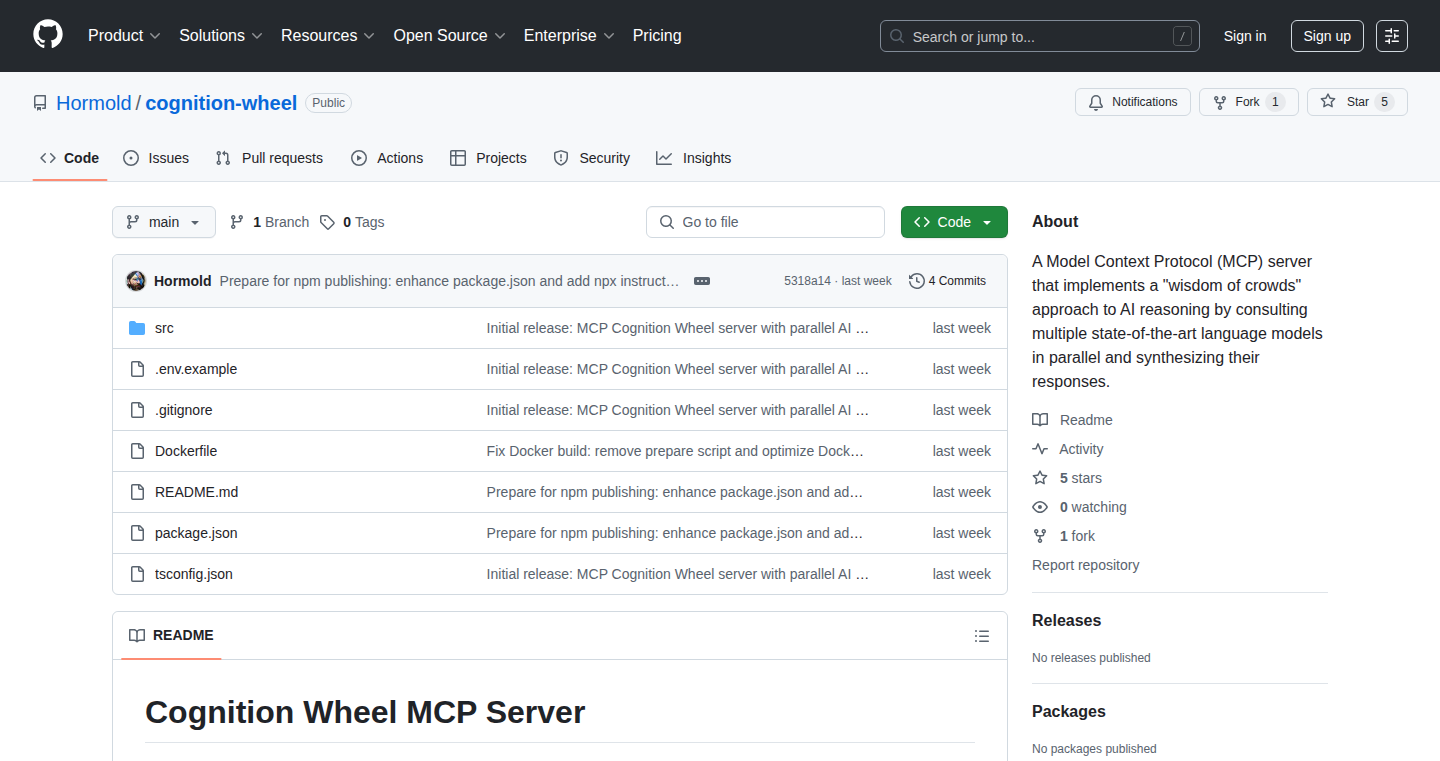
Author
Hormold
Description
Cognition-Wheel tackles the problem of unreliable Large Language Models (LLMs) by running three top-tier LLMs (Claude-4, Gemini 2.5, and OpenAI o3) in parallel, masking their identities to prevent bias, and then using a random judge model to synthesize their answers. This innovative approach solves the issues of conflicting outputs, brand bias, and single-model failures, offering a more reliable and robust way to utilize LLMs for complex tasks. So this gives you a more trustworthy AI assistant that's less likely to be wrong or biased.
Popularity
Points 3
Comments 0
What is this product?
Cognition-Wheel is a system that utilizes the power of multiple LLMs to enhance the reliability and accuracy of AI-driven reasoning. It works by simultaneously querying three different, top-performing LLMs. To avoid the influence of the models' specific branding or built-in biases, the responses are anonymized. A 'judge' model then analyzes these anonymized outputs and synthesizes them into a single, consolidated response. The core innovation lies in parallel processing and the aggregation of knowledge from different models to create a more robust and reliable output. So this is like having three experts instead of one, ensuring a more well-rounded and trustworthy answer.
How to use it?
Developers can integrate Cognition-Wheel into their projects by sending their input to the system. It's designed to be used in conjunction with sequential-thinking models for step-by-step reasoning. Developers can first use a sequential-thinking model to break down a problem into manageable steps and then pipe the output into Cognition-Wheel for a quick cross-validation and consensus check. This can be deployed as a command-line tool (using `npx mcp-cognition-wheel`) or integrated into existing agent flows. So you can easily add a layer of reliability to your AI projects without getting bogged down in complex configurations.
Product Core Function
· {"functionName":"Parallel LLM Execution","description":"Cognition-Wheel runs three different LLMs simultaneously. This eliminates the risk of relying on a single model, mitigating the impact of model failures or biases. This also increases the likelihood of generating diverse answers, and improves overall reasoning ability. This results in more reliable and comprehensive results.","value":"So you avoid putting all your eggs in one basket when working with AI."}
· {"functionName":"Bias Masking","description":"The project anonymizes the responses from each LLM (e.g., using 'Alpha,' 'Beta,' and 'Gamma') to remove the influence of model branding and any inherent biases in the models. This helps ensure the synthesized answer is based on the information itself, not on the specific model that provided it. This minimizes the possibility of getting a biased response.","value":"This ensures you get answers that are based on the facts, not the specific reputation or biases of a particular AI model."}
· {"functionName":"Random Judge Model Fusion","description":"A 'judge' model is used to analyze the anonymized outputs and combine them into a single final answer. This aggregation process creates a consensus output, leveraging the strengths of all the different LLMs. It can also help in identifying and resolving contradictions among models, offering a more accurate, reliable, and unified result.","value":"This is like a smart editor that cleans up the different answers from the LLMs and gives you a combined, more accurate and reliable response."}
Product Usage Case
· {"scenario":"Complex Question Answering","description":"When developing a chatbot that needs to provide answers to complex questions (e.g., in a financial, legal, or medical context), you can use Cognition-Wheel. First, a sequential-thinking model can be used to break down the question. Then, Cognition-Wheel is used to get a cross-validated and consensus-based answer. If any of the three LLMs have different answers, Cognition-Wheel can reduce the possibility of wrong answers, and provide more trustworthy and well-reasoned results.","value":"This helps in building more reliable and informative chatbots that can assist users in making important decisions."}
· {"scenario":"Data Analysis and Summarization","description":"For applications that require analyzing large datasets and summarizing complex information, Cognition-Wheel can be invaluable. The different LLMs could analyze the data, provide summaries from different perspectives and identify potential biases, and the judge model then creates a consolidated summary. This allows the data analysis system to create high-quality summaries without the biases or errors from a single model.","value":"This significantly improves the accuracy and reliability of data-driven decisions."}
30
PlainC-ColorPicker: A C-Language Color Picker
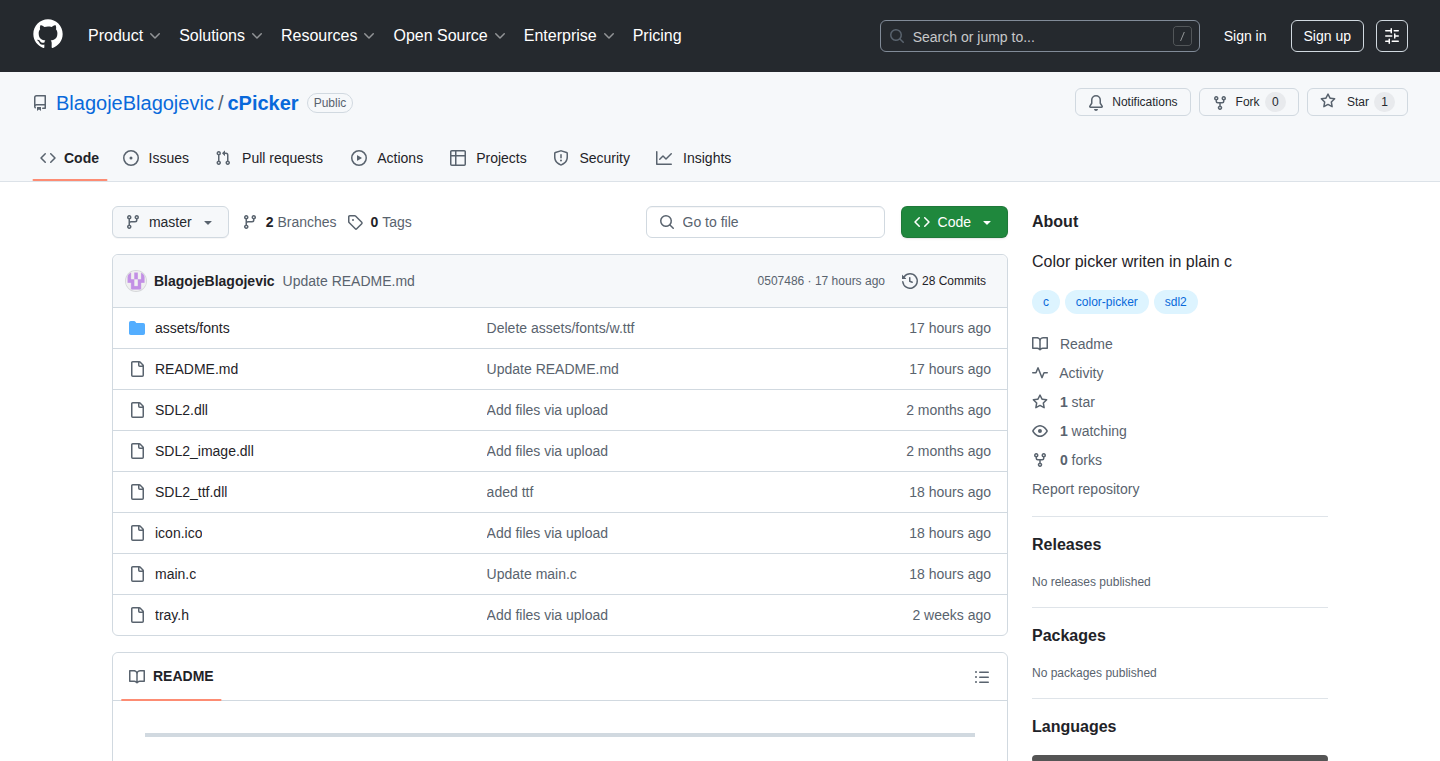
Author
rbb1389
Description
This project is a simple color picker built entirely in the C programming language. It demonstrates a low-level approach to color selection, allowing developers to understand how color representation works at a fundamental level. It addresses the technical challenge of creating a user interface for color selection directly within a C application without relying on external libraries, showcasing a deep understanding of graphics principles and system programming.
Popularity
Points 3
Comments 0
What is this product?
This is a color picker, meaning a tool that allows you to visually choose a color and get its corresponding code (e.g., RGB values). The innovation lies in its implementation: it's written purely in the C language, which is a low-level language often used for operating systems and embedded systems. This means it doesn't rely on fancy graphical libraries like those found in web browsers or desktop applications. Instead, it interacts directly with the system to draw the color selection interface. The 'so what?' is that it's a stripped-down example of how to build interactive interfaces, providing insight into fundamental concepts of computer graphics and operating systems.
How to use it?
Developers can use this project as a building block or as inspiration. You could incorporate its core logic into your C/C++ based projects where color selection is needed. For example, you might be building a custom graphics editor, a command-line tool that colors text output, or a tool for embedded systems that doesn't have much memory to spare. The integration involves understanding how the C code handles user input, draws graphics primitives (lines, rectangles, etc.), and translates mouse clicks into color values. So, if you're building a graphics app in C/C++, this provides a starting point.
Product Core Function
· {"applicationScenario":"Useful in projects requiring custom UI elements or low-level graphics programming, like game engines or system utilities. So you can build your own interactive color-selection window instead of relying on bulky external libraries. ","functionName":"Interactive Color Selection","technicalValue":"Demonstrates fundamental UI design and event handling using low-level C functionalities.","description":"The primary function allows users to visually select a color using a GUI (Graphical User Interface) built with minimal system dependencies. The color picker visualizes a color space. When a user interacts with this color space (e.g., clicks on a color), it provides the selected color value. This gives developers direct control over color selection in their C/C++ projects."}
· {"applicationScenario":"Beneficial for developers working with image processing, computer graphics, or any application where understanding color representation is critical. So it helps you better understand how colors are stored and manipulated in your code when dealing with images or graphics.","functionName":"Color Representation Understanding","technicalValue":"Provides insights into color space concepts and low-level graphics.","description":"The code likely uses RGB (Red, Green, Blue) or other color models to represent colors. By examining the code, developers can understand how these color models work internally – how each color is composed of its component values, and how to convert them into specific color displays. The project reveals how colors are represented in computer memory and how they're displayed on the screen."}
· {"applicationScenario":"Good for developers aiming to design cross-platform tools or needing to run the same color picker code on various systems, or to write embedded systems software. This reduces dependency on platform-specific libraries and streamlines development.","functionName":"Cross-Platform Compatibility (Potential)","technicalValue":"Highlights portability aspects and low-level coding techniques.","description":"Since it is built in C, it has the potential for cross-platform compatibility. The core logic can be adapted and recompiled on different operating systems (Windows, Linux, macOS). It can be a good choice when portability is essential for a program. This project demonstrates a core concept with minimal external dependencies."}
Product Usage Case
· {"soWhat":"Allows you to build your own graphics tool tailored precisely to your needs and avoid reliance on large, often inflexible libraries.","technicalBenefits":"Directly integrates with the game engine's low-level graphics system, giving control and minimizing overhead.","scenario":"Custom Graphics Editor Development","description":"A game developer needs to create a custom color selection tool for a game engine. The C-based color picker can be integrated directly into the game engine's code, providing a streamlined and efficient color selection mechanism, avoiding large graphics library dependencies. "}
· {"soWhat":"Provides a lightweight and efficient solution when you need to manage colors in embedded devices with limited resources.","technicalBenefits":"Small code footprint and minimal dependencies make it suitable for resource-constrained systems.","scenario":"Embedded System Application","description":"An engineer building a control panel for an embedded system needs to allow users to select colors for LED displays. They can adapt the C-based color picker for the embedded environment, where memory and processing power are often limited."}
31
Studygraph: Adaptive Learning Platform Powered by AI
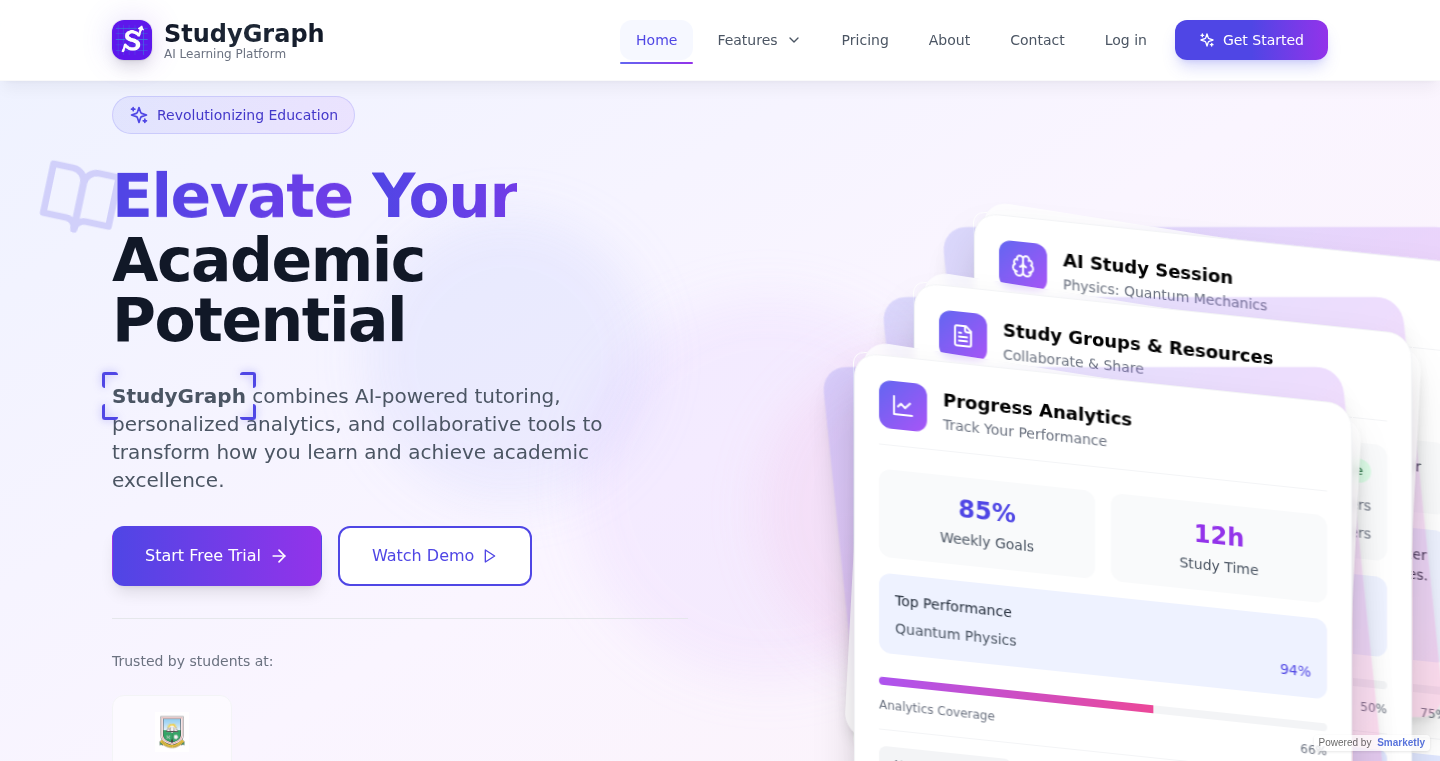
Author
abilafredkb
Description
Studygraph is a personalized learning platform designed to adapt to individual learning styles and pace, leveraging AI to provide customized explanations, smart flashcards, and a research assistant. It aims to solve the problem of one-size-fits-all education by creating a learning experience that molds itself around each student's unique needs.
Popularity
Points 3
Comments 0
What is this product?
Studygraph is a web-based platform that uses artificial intelligence to personalize the learning experience. Imagine having a personal tutor that adjusts to your understanding and learning preferences. The platform analyzes your interaction with the material, identifies your strengths and weaknesses, and tailors the content delivery accordingly. It creates smart flashcards automatically, provides personalized explanations, and assists with research. The core innovation lies in its adaptive learning engine, which dynamically adjusts the difficulty and presentation of the content based on your performance.
**So what's the value?** This helps students understand and remember information better by accommodating individual learning styles, unlike traditional education methods.
How to use it?
Users access Studygraph through a web browser. The platform integrates with existing learning materials by allowing students to upload or import them. The AI then analyzes the material, generating personalized study guides and flashcards. Students can then use Studygraph to study by reading, taking quizzes, and reviewing flashcards. The platform tracks their progress and adapts the content accordingly.
**So what's the value?** Students can use Studygraph to make the study process more effective and personalized, potentially leading to better understanding and improved grades.
Product Core Function
· {"technicalValue":"Uses Natural Language Processing (NLP) and Machine Learning (ML) to understand the content and generate tailored explanations.","name":"AI Tutoring","description":"Provides personalized explanations and guidance tailored to the student's learning style. The AI engine assesses how the student understands the material and delivers explanations accordingly. This is like having a tutor that 'gets' how you learn. \n\n**So what's the value?** Students who struggle with understanding the material can get personalized explanations to improve their understanding, therefore, the learning experience becomes more effective and relevant."}
· {"technicalValue":"Employs algorithms to identify key concepts and generate flashcards that are optimized for spaced repetition, a proven memory technique.","name":"Smart Flashcards","description":"Automatically generates flashcards from the student's study materials, optimized for retention patterns. This saves students the time and effort of manually creating flashcards and ensures the flashcards are relevant and effective.\n\n**So what's the value?** Students can save time on creating flashcards and learn efficiently, thus, improving the understanding and memory retention."}
· {"technicalValue":"Uses web scraping, information retrieval, and summarization techniques to streamline the research process.","name":"Research Assistant","description":"Helps students find, organize, and synthesize information for assignments. It's like having a research assistant that helps you sift through the noise and find the important stuff.\n\n**So what's the value?** Students who struggle with research will get help organizing and synthesizing information, therefore, the research process is more efficient."}
· {"technicalValue":"Uses real-time collaboration features with privacy controls to enable group studying while maintaining personalized learning experiences.","name":"Collaborative Tools","description":"Allows students to study with classmates while maintaining their individual learning styles. This makes learning social and offers the students different perspectives while maintaining personalized learning style.\n\n**So what's the value?** Enables effective study group learning by supporting collaboration while also preserving individual learning preferences."}
· {"technicalValue":"Employs machine learning models to track student performance and adjust content difficulty, presentation, and pace dynamically.","name":"Adaptive Learning","description":"The platform continuously monitors the student's performance and adjusts the content difficulty and presentation accordingly. This ensures that students are challenged but not overwhelmed. This is like having a tutor that adjusts the difficulty level based on the student's performance.\n\n**So what's the value?** Ensures that the student will continue to receive an appropriate challenge and stays engaged, leading to better learning outcomes."}
Product Usage Case
· {"problem":"The student struggles to keep up with the fast pace of lectures and has difficulty understanding complex concepts.","solution":"The student uses Studygraph to upload lecture notes and textbook chapters. The AI generates personalized explanations and creates smart flashcards. The student uses the flashcards and personalized explanations to study. The platform adapts the content based on the student's performance. If the student struggles with a concept, the platform provides additional explanations or presents the information in a different way. \n\n**So what's the value?** The student better understands the material and is more confident for the exam.","scenario":"A college student preparing for an exam."}
· {"problem":"The student struggles to find and organize relevant information.","solution":"The student uses Studygraph's research assistant to find and organize sources. The AI summarizes the key information and helps the student synthesize the information into a coherent paper. \n\n**So what's the value?** The student is able to efficiently write a research paper and produce high-quality work.","scenario":"A high school student working on a research paper."}
32
CSV API Weaver

Author
houqp
Description
This project allows you to instantly turn your CSV (Comma Separated Values) files into functional, ready-to-use APIs (Application Programming Interfaces). It's like giving your data a voice, allowing other applications and systems to easily access and interact with the information stored within your CSV files. The technical innovation lies in its ability to parse and structure the CSV data on-the-fly, automatically generating endpoints and handling basic data retrieval functionalities. This simplifies data sharing and integration, eliminating the need for complex backend development for simple data access requirements.
Popularity
Points 1
Comments 1
What is this product?
CSV API Weaver takes your plain CSV files and magically transforms them into APIs. Think of it as a translator: it understands the structure of your CSV data and creates an interface that other software can understand. It does this by analyzing your CSV file, creating routes based on the column headers, and providing the ability to query the data. So, if you have a list of products in a CSV, you can use the API to retrieve information about specific products, filter them by price, or search by name. The innovation is the rapid deployment and ease of use; you avoid all the complex coding involved in creating a traditional API. So this is useful because it quickly enables data accessibility.
How to use it?
To use CSV API Weaver, you would typically upload or point the tool to your CSV file. Then, the system automatically generates API endpoints that correspond to the columns and data within your CSV. Other applications can then access the data using standard HTTP requests (like GET or POST). For example, you can integrate the API into your website to display product information, or use it to feed data into a mobile application. So this is useful because you can easily connect CSV data to other applications without heavy development.
Product Core Function
· {"applicationScenario":"Quickly sharing product catalogs with e-commerce platforms or building a simple data access service for internal teams.","functionName":"Automatic API Endpoint Generation","description":"The tool automatically creates API endpoints based on the column headers of your CSV file. This means that each column becomes a searchable field, allowing you to easily retrieve specific data. For instance, if your CSV has a column called 'product_name', the API will create an endpoint (e.g., `/products?product_name=yourProduct`) to search for products by name. This drastically reduces manual configuration. So this is useful because it removes the need to manually define each API endpoint and its query parameters, saving time and effort."}
· {"applicationScenario":"Building dashboards, creating data visualizations, or filtering data for a customer relationship management (CRM) system.","functionName":"Data Querying Capabilities","description":"The generated APIs support querying capabilities like filtering, sorting, and searching. You can filter the data by specific values in a column, sort it based on a numerical or textual column, or search for partial matches. This makes it easy to retrieve only the data you need. For example, you could search for products within a specific price range. So this is useful because it provides flexibility in data retrieval, enabling users to extract the data most relevant to them."}
· {"applicationScenario":"Connecting a marketing database to a sales application, or integrating a customer order CSV into a reporting dashboard.","functionName":"Simplified Data Access and Integration","description":"By exposing the data as an API, CSV API Weaver allows for easy integration with other applications and systems. The API can be used by web applications, mobile apps, or other backend services. This facilitates data exchange and collaboration across different parts of your organization. So this is useful because it reduces data silos and makes data accessible across various platforms and tools."}
Product Usage Case
· {"problemSolved":"Eliminated the need to manually code a backend API to manage and serve product data.","caseName":"Instant Product Catalog API","description":"A small e-commerce business has a product catalog in a CSV file. Using CSV API Weaver, they can instantly create an API that allows their website to display product information. When a customer searches for a product, the website uses the API to query the data, retrieve the product details, and display them. So this is useful because it enables the e-commerce business to quickly update and share product information on their website without the need for complex database management."}
· {"problemSolved":"Simplified data sharing and collaboration between teams by providing a readily available API endpoint for accessing customer feedback data.","caseName":"Internal Team Data Sharing","description":"A marketing team has a CSV file containing customer feedback data. Using the API, they can easily share this data with the sales team, allowing them to analyze customer feedback and improve their sales strategies. The sales team can use the API to filter customer feedback by product, location, or date. So this is useful because it allows the sales and marketing teams to work with the same data in a structured way, enabling data-driven decision-making."}
33
Kameo: The Open-Source Form Crafting Engine
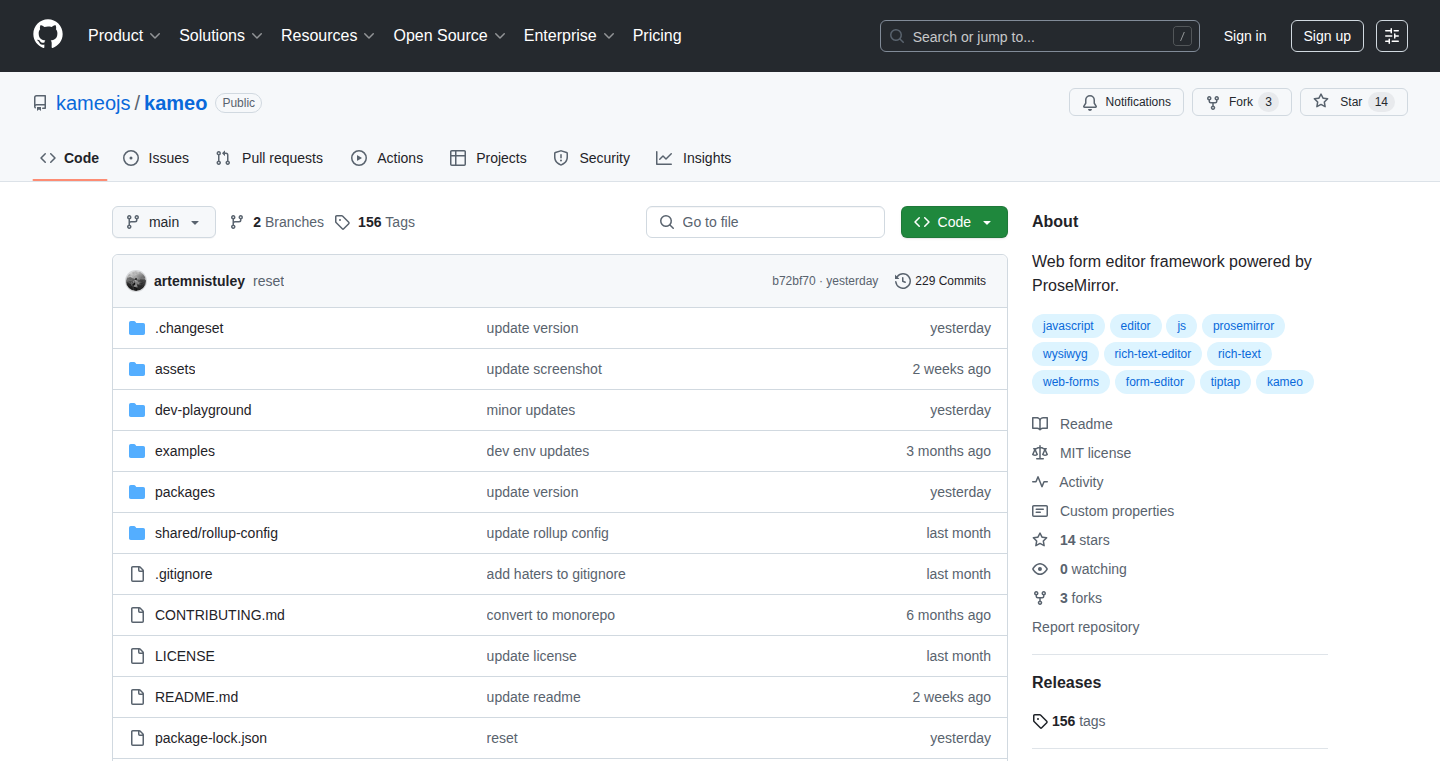
Author
nistuley
Description
Kameo is an open-source project that lets you build and display forms. What's cool is it's designed to work directly within your web application, allowing for a smooth, interactive experience for your users. It tackles the challenge of creating custom forms without having to write a ton of code, and it gives developers a flexible way to manage and present form data. Think of it as a toolkit to make building forms, both visually and behind the scenes, much easier.
Popularity
Points 2
Comments 0
What is this product?
Kameo is essentially a form-building and display engine. It's built around the idea of using a special type of data format to define how a form looks and what information it captures. The project provides tools to create these forms (using visual editors or code) and then a component that knows how to render them on your website. Its innovative aspect lies in its flexibility: you can design complex forms, manage their data, and integrate them seamlessly into your web applications. So, it streamlines form creation, making it easier for developers to build and deploy forms for various purposes. So this helps me create dynamic forms without having to write all the rendering logic from scratch.
How to use it?
Developers can use Kameo in a few ways. First, you define your form using a specific format, often in a configuration file or with a visual form builder. Next, you integrate Kameo's component into your web application. Finally, you provide the form definition to the component and it automatically renders the form, handles user input, and manages form data. Think of it as a plug-and-play form solution: you tell it how the form should look (what fields, what layout), and it handles the rest. You can use this within JavaScript frameworks like React, Vue or Angular. This saves you tons of time and reduces the amount of code you write for each new form. So this saves me time and effort whenever I need to create forms in my projects.
Product Core Function
· {"functionName":"Form Definition","description":"This allows you to declare the structure and content of forms. You can use various ways to define your forms like configuration files or visual interfaces. This allows you to define things like text fields, dropdowns, date pickers, and how they're laid out. This is the core part of Kameo because it makes forms very flexible. So this gives me full control over the look and features of my forms.","value":"It gives developers a clear way to describe forms and a consistent way to use them. It promotes reuse and makes it easier to update forms later. It also enables the use of visual form builders to make the form design process much easier."}
· {"functionName":"Form Rendering","description":"Kameo's rendering engine takes your form definitions and turns them into interactive forms that users can see and interact with. It handles the visual display of the form elements (text boxes, buttons, etc.) and manages the user input. This means it does all the work of drawing the form on the screen, freeing you from writing the code to do that yourself. So this gives me the power to easily display my forms in different ways.","value":"It drastically reduces the amount of custom code needed. It also ensures a consistent and responsive user experience across different browsers and devices. Makes it easier to focus on the form's data and logic instead of the user interface."}
· {"functionName":"Data Handling","description":"Kameo can handle the submission of form data. It allows you to collect, validate, and process data. This can include validating the user input (checking for errors, making sure fields are filled in correctly), formatting the collected data (like dates or numbers), and sending the data to other parts of your application (saving it to a database, sending emails, etc.). So this handles complex data management for my forms","value":"It eliminates the need to build individual data validation and processing logic for each form. This streamlines the workflow and ensures data integrity."}
Product Usage Case
· {"application":"Creating Customer Surveys","description":"Imagine you're building an e-commerce website. You could use Kameo to create dynamic customer surveys directly on your site. Using Kameo, you could rapidly design and deploy a survey to ask customers about their experience after a purchase. This eliminates the need to develop a bespoke survey system from scratch. So I can create great surveys that give me feedback from my customers.","technicalBenefit":"Rapid prototyping and deployment of dynamic forms."}
· {"application":"Building Interactive Training Applications","description":"Kameo could be incorporated into an internal training application, creating interactive forms that guide users through learning modules. Forms can be used to ask questions, collect responses, and track progress. Instead of coding a complete training program, you use Kameo to handle the forms aspect, allowing you to focus on creating the learning content itself. So I can easily build engaging learning tools.","technicalBenefit":"Simplified integration and user interface for education and training."}
34
Ziip: Open-Source Graph Puzzle Solver

Author
alexandergekov
Description
Ziip is an open-source puzzle game inspired by LinkedIn's Zip puzzle. It tackles the challenge of generating solvable puzzles based on graph theory principles, specifically Hamiltonian paths and pathfinding algorithms. The project demonstrates how a complex problem like puzzle generation can be approached using graph theory, offering developers a learning resource and a customizable game platform. This showcases how to take a simple game and build on a complicated underlying mathematical foundation. The developer used web technologies like Nuxt for the front end, providing a smooth and responsive user experience.
Popularity
Points 2
Comments 0
What is this product?
Ziip is a puzzle game where you connect nodes on a graph. The core innovation lies in its puzzle generation logic, which leverages graph theory concepts (Hamiltonian paths) to ensure all puzzles are solvable. The developer, not being a graph theory expert, learned and implemented these concepts, showing the power of applying mathematical principles to practical problems. This means that players will always find a path to solve the puzzle. The project also utilizes technologies like Nuxt for its framework.
How to use it?
Developers can use Ziip as a learning resource to understand graph theory applications. The open-source code is available on GitHub, allowing developers to study the puzzle generation logic, integrate the game into their own projects, or customize the game mechanics. For example, you could use it as a template for building your own logic puzzles, or for creating learning tools that visualise graph theory problems, such as pathfinding or network optimization. The developer's GitHub repo and live game are readily available.
Product Core Function
· {"functionName":"Puzzle Generation based on Hamiltonian Paths","description":"This is the heart of the project. The game ensures that every puzzle has a solution by generating puzzles based on finding Hamiltonian paths within a graph. This means that a player can always solve the puzzle. This is a core principle in graph theory, and finding a Hamiltonian path is considered a complex problem. By using this to build the puzzles, the puzzles are guaranteed to have a correct solution. So this is essentially the core mathematical logic of the game.","value":"This demonstrates a practical application of graph theory concepts, providing a reusable solution for puzzle generation and a learning resource for developers interested in graph algorithms. It makes the game inherently fun and solvable, something that other puzzles often struggle with."}
· {"functionName":"Nuxt Frontend Implementation","description":"The front-end uses Nuxt, a framework built on top of Vue.js. This provides a smooth user interface and responsive animations, showcasing how modern web frameworks enhance user experience. The project uses it to allow for a smooth and appealing user experience.","value":"Shows the use of a modern Javascript framework for a fast and responsive web application, allowing you to learn about web-based game development. If you want to create a similar experience with puzzles, this is a great demonstration."}
· {"functionName":"Open-Source and Customizable","description":"The project's open-source nature allows developers to access, modify, and learn from the code. This allows for full control and exploration of the code base. In addition to being easy to learn from, the open-source nature allows for experimentation and modification to customize any parts that the user wishes. ","value":"It's a great starting point for anyone wanting to build their own puzzle game or wanting to delve into the puzzle game generation process."}
Product Usage Case
· {"solution":"Using Ziip's code as a base, a developer can focus on enhancing the learning experience, such as providing explanations, hints, or visualizations of graph algorithms. In addition to learning from the code, you could easily modify the game's mechanics to focus on different topics","scenario":"Building a Learning Game","description":"A game developer could use Ziip's puzzle generation logic to create an educational game to teach graph theory concepts. You could adapt the graph layouts, puzzle rules, and the visual interface. The underlying code, which handles the hard task of making the puzzles, is open source. "}
· {"solution":"The developer could adapt the puzzle generation logic to fit their game's specific requirements, ensuring that players can always find a solution to the puzzle and never get stuck on unsolvable ones. This will make the game more fun and less frustrating.","scenario":"Developing a Puzzle-Solving Engine","description":"A developer working on a game with puzzle elements could integrate Ziip's core logic to ensure solvable puzzles, saving time and effort. They could use it, or modify it to be useful for any other problem."}
35
GloriaMundo: Persistent Memory Chatbot Orchestra
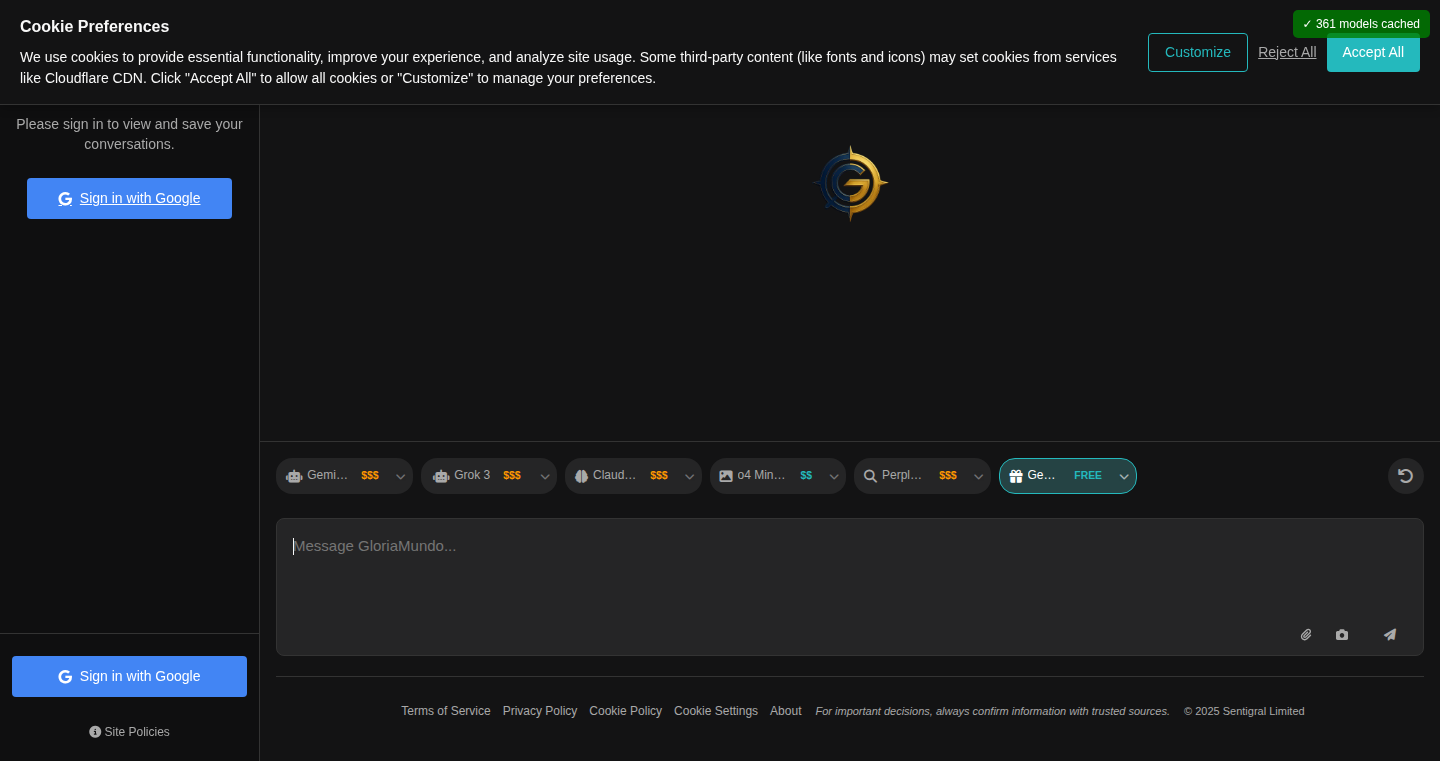
Author
AndySurtees
Description
GloriaMundo is a multi-LLM (Large Language Model) chatbot with persistent memory. It allows users to interact with multiple AI models simultaneously, leveraging a memory system to maintain context across multiple conversations and over time. This project explores the orchestration of various LLMs, improving the coherence and long-term recall of chatbot interactions, fundamentally addressing the limitation of single-model chat history loss. It's like having a team of AI assistants working together, remembering everything you've discussed.
Popularity
Points 1
Comments 1
What is this product?
GloriaMundo brings together multiple AI brains (LLMs) and gives them a really good memory. Imagine having several smart assistants who not only can talk to you, but also remember everything you've told them, even from previous conversations. The cool part is that it's not just one AI, but several working together. The technology is all about orchestrating different LLMs and managing a persistent memory system – think of it as a super-powered filing cabinet for all your chats.
How to use it?
Developers can use GloriaMundo by integrating it into their own applications or using it as a base for building more complex AI-powered tools. You could integrate it into a customer service chatbot, a personal assistant app, or even a creative writing tool. You provide the prompts (your requests), and GloriaMundo's engine takes care of managing the communication with multiple LLMs, maintaining the context, and providing the answers.
Product Core Function
· {"functionName":"Multi-LLM Orchestration","description":"GloriaMundo manages simultaneous interactions with different LLMs. It decides which AI model is best suited to respond to a specific query. This is incredibly valuable because it allows you to choose the right 'tool' for the job, optimizing the response quality.","value":"So this is useful because you get the best of different AI models, increasing the accuracy and expertise of your chatbot."}
· {"functionName":"Persistent Memory Management","description":"It uses a persistent memory to store and recall past interactions and user preferences. This allows the chatbot to maintain context over time and across different conversations. It avoids 'forgetting' previous exchanges.","value":"So this is useful because your conversations feel more natural and informative. The chatbot remembers everything, allowing for complex tasks and more personalized interactions."}
· {"functionName":"Contextual Awareness & Coherence","description":"GloriaMundo analyzes the current conversation in relation to the saved memory to maintain coherence in the responses. It ensures that the chatbot replies make sense given past discussions and the overall objectives.","value":"So this is useful because your AI assistant is much smarter and the conversation is smoother and more relevant. It avoids repeating information and sounds more natural."}
· {"functionName":"Modular Design & Extensibility","description":"The project is likely structured to allow the easy addition of new LLMs or memory components. This means it can evolve and adapt to new technologies and advancements in AI.","value":"So this is useful because as new AI models come out, GloriaMundo can be easily updated, staying up-to-date with the latest advancements in AI."}
Product Usage Case
· {"scenario":"Customer Service Chatbot","description":"Instead of using a single AI, which can sometimes give incorrect answers, GloriaMundo can route questions to different LLMs based on their expertise (e.g., one for product information, another for technical support, etc.). It also remembers past conversations, leading to faster and more accurate responses and more satisfied customers.","value":"So this is useful for customer service because it provides quick and correct answers, improves user experience, and reduces the need for human intervention."}
· {"scenario":"Personal Productivity Assistant","description":"Imagine having a single interface for all your AI-related tasks. GloriaMundo can help you by summarizing emails (one model), scheduling meetings (another), and drafting creative text (a third). The memory keeps all this connected.","value":"So this is useful for productivity because it simplifies workflows and improves efficiency by providing a single point for interacting with multiple AI services."}
· {"scenario":"Research and Development Tool","description":"Researchers can use GloriaMundo to experiment with the combination of various AI models for specific tasks, compare the performance of different LLMs, and build AI-powered tools more efficiently.","value":"So this is useful for researchers and developers because it provides a platform for quickly testing and deploying AI innovations."}
36
SprintDojo: Daily Wins Tracker with Pattern Recognition

Author
vladceo
Description
SprintDojo is a simple system designed to log your daily accomplishments, acting as a digital journal focused on progress. The core innovation lies in its pattern recognition capabilities. It goes beyond simple logging by analyzing your entries over time to identify hidden trends and uncover areas where you might be unconsciously avoiding work. This provides valuable self-awareness and helps users understand their working habits, leading to improved productivity and focus.
Popularity
Points 1
Comments 1
What is this product?
SprintDojo is essentially a digital diary where you record your daily wins – the things you accomplished. The clever part is that it doesn't just store your entries; it analyzes them. Imagine a smart system that looks for recurring themes in your 'wins' and also spots things you consistently *don't* mention. This analysis helps you see patterns you wouldn't otherwise notice, like projects you keep putting off or areas where you excel. So, it helps you understand yourself better and work smarter.
How to use it?
You can think of SprintDojo like a simple app or website where you write down your wins each day. You might type a few sentences about what you achieved – finishing a task, making a sales call, or learning a new skill. The system takes these entries and, over time, starts to see patterns. To use it, you'd simply log your wins daily. As your data builds up, SprintDojo reveals insights. For example, developers could use it to track progress on different projects, monitor their time spent on various tasks, and identify bottlenecks in their workflow.
Product Core Function
· {"feature":"Daily Wins Logging","application":"Use it daily. Write down what you accomplished, no matter how small.","description":"The primary function is simple: a place to record your daily achievements. This is the foundation for all other analysis. Value: Provides a structured method to track accomplishments, fostering a sense of progress and motivation. So this is useful because it helps you see how much you are achieving, boosting your morale and keeping you focused."}
· {"feature":"Pattern Recognition & Trend Identification","application":"Review the analysis provided by SprintDojo regularly. This helps you understand your own habits and make informed decisions about where to focus your time and energy.","description":"The system analyzes your logged wins to identify repeating themes and trends. It looks for common tasks, projects, or positive outcomes. Value: Helps users discover their strengths and weaknesses, recognizing patterns in their productivity and working habits. So this is useful because it uncovers hidden trends, revealing what you are good at and where you might be procrastinating."}
· {"feature":"Avoidance Detection","application":"Use this insight to address avoidance patterns. If you see recurring absences, ask yourself why you're avoiding that task. Perhaps break it down into smaller parts, or ask for assistance.","description":"The system identifies activities or projects that are consistently absent from your wins. This is based on analysis over time. Value: Highlights areas where you might be avoiding certain tasks or projects. It points out the things you aren't doing or consistently putting off. So this is useful because it flags areas where you may need to change your habits or seek help."}
· {"feature":"Personalized Insights & Reporting","application":"Regularly check the insights generated by SprintDojo. This allows you to adjust your strategies based on the specific feedback it provides.","description":"Provides reports summarizing your wins, patterns, and areas for improvement, allowing users to view progress over time and stay on track. Value: Offers actionable insights based on your individual data. It's not a generic report but tailored to your work habits. So this is useful because it gives you personalized insights to help make better choices."}
Product Usage Case
· {"scenario":"Software Developer Project Tracking","problemSolved":"Identifying and addressing project delays, improving time management, and avoiding procrastination on specific tasks.","description":"A software developer could use SprintDojo to log daily progress on different projects. By analyzing the entries, the system can identify the projects where the developer is most productive and the ones that consistently get delayed. It can also help pinpoint specific types of tasks (like writing documentation or debugging) that are avoided, leading to process improvements. So, it’s beneficial because it helps developers identify bottlenecks and improve their project management skills."}
· {"scenario":"Freelancer Task Management","problemSolved":"Optimizing time allocation, identifying time-wasting activities, and optimizing project work.","description":"A freelancer can use SprintDojo to track the tasks they complete each day, along with the time spent on each. The analysis will reveal recurring task types, common client projects and potential procrastination areas. SprintDojo can highlight how much time they spend on invoicing or marketing versus the actual work. This gives them insights into what’s working well and what areas need adjustment, e.g., pricing and client work. So, it's beneficial because it helps freelancers optimize their workflow and improve their billing process."}
37
WebGL Chip-8 Emulator: A Browser-Based Retro Gaming Marvel
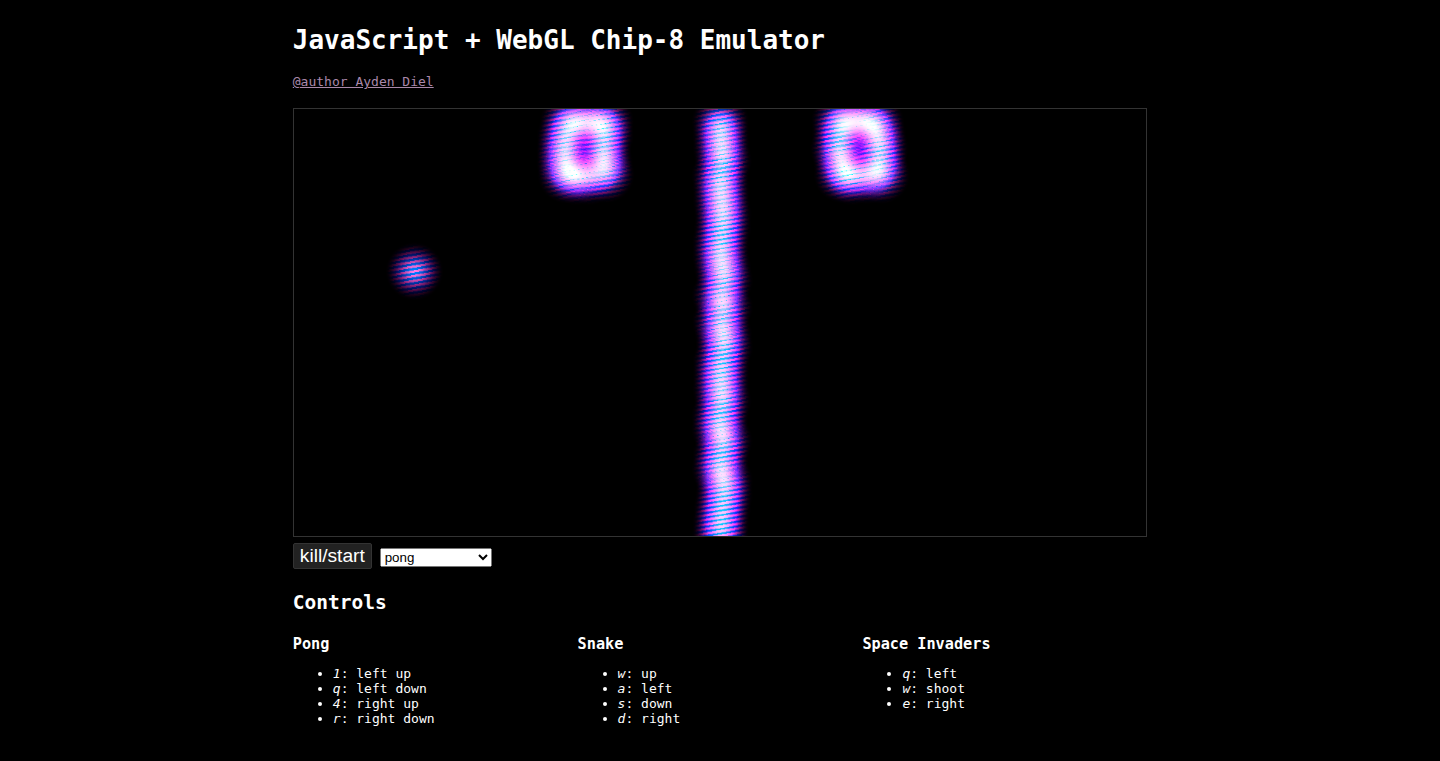
Author
otherayden
Description
This project is a Chip-8 emulator, a virtual machine that runs classic video games, built entirely in JavaScript and rendered using WebGL (a technology that lets websites create 3D graphics). The innovative part is that it runs entirely in your web browser, with no extra software needed, and it uses WebGL for a super-fast and visually appealing experience. It solves the problem of how to easily play retro games without installing complicated programs or dealing with compatibility issues.
Popularity
Points 2
Comments 0
What is this product?
It's a Chip-8 emulator. Think of it like a tiny computer inside your browser that understands old-school game code. This emulator translates the game code into visuals you can see. The cool part? It's all done with JavaScript and WebGL. WebGL makes the games look good and run smoothly. So, instead of needing a special program, you can play games like Pong right in your browser. The innovation lies in the browser-based, dependency-free implementation, offering a seamless retro gaming experience. So, this is about playing classic games easily.
How to use it?
As a developer, you'd likely use this as a learning tool. You could study the JavaScript code to understand how emulators work. Or you could use it as a base to build upon, maybe adding features or integrating it into other projects. For end users, you just open it in a web browser and load a Chip-8 ROM file (the game itself). The emulator handles the rest. Imagine it as a digital time machine, ready to launch retro games.
Product Core Function
· {"applicationScenario":"Understanding how the instruction set of a retro gaming system functions. Use it to learn about low-level programming and how virtual machines function. So, this is for anyone interested in how games actually function.","soWhat":"So you get the knowledge of how old games work internally, which can inspire new game ideas or allow to emulate other retro systems.","functionName":"Chip-8 Instruction Decoding and Execution","description":"The emulator takes the Chip-8 game instructions (like drawing a sprite or jumping to a new location) and translates them into JavaScript code that the browser understands. So, this is the core of how the game's logic is executed, and it's where you can study how the game commands are interpreted. The value is in understanding how these instructions bring the games alive."}
· {"applicationScenario":"Building fast and visually appealing graphics in a web application. You can learn the usage of WebGL by inspecting the code. This is useful for any web developer looking to create engaging visual experiences.","soWhat":"It gives a blueprint to create smooth graphics in web applications. Great for things like browser-based games and data visualization.","functionName":"WebGL Rendering for Graphics","description":"Uses WebGL to render the game's graphics. This provides fast, smooth visuals without relying on slow browser rendering techniques. It's the secret sauce that makes the games look good and run fast. So, the faster the game renders, the better experience. The value is how the project uses modern techniques like WebGL to replicate the experience of older hardware."}
· {"applicationScenario":"Adding realistic sound effects to retro games and building educational projects around computer audio. Useful for anyone wanting to recreate the full experience of the games.","soWhat":"It helps developers recreate a more authentic experience by understanding the sound element of retro gaming.","functionName":"Sound Emulation (Potentially)","description":"While not explicitly mentioned, a complete emulator also often includes sound emulation, mimicking the classic sounds of the games. The value is in reproducing the authentic retro gaming audio experience. This element typically completes the entire retro experience."}
Product Usage Case
· {"soWhat":"It lets you learn the basics of emulating older systems, leading to a better understanding of game design.","solution":"The developer can inspect the JavaScript code, understand the logic, and even modify the emulator to add new features or improve its performance. This promotes an environment for studying the technology used to create retro games, and inspires new ideas on creating browser games.","scenario":"Retro Game Emulation Education","description":"A developer uses the emulator to learn about the inner workings of a Chip-8 virtual machine, studying how game instructions are executed and graphics are rendered. This project provides a straightforward example, making it easier to study the different functionalities and how to translate them into modern web technologies."}
· {"soWhat":"Quickly add classic games to your web projects to engage users and showcase your skills.","solution":"The developer could easily integrate the emulator code into an existing website, adding a new section with playable classic games. Users can play games without needing to install or download anything. The project serves as a quick solution for people wanting to easily launch retro games in their projects.","scenario":"Web-Based Retro Gaming Integration","description":"Another developer integrates the Chip-8 emulator into their website to offer users a collection of retro games that run directly in the browser. Using this project, developers can rapidly deploy retro games in any project."}
38
Agentic Job Application Tool
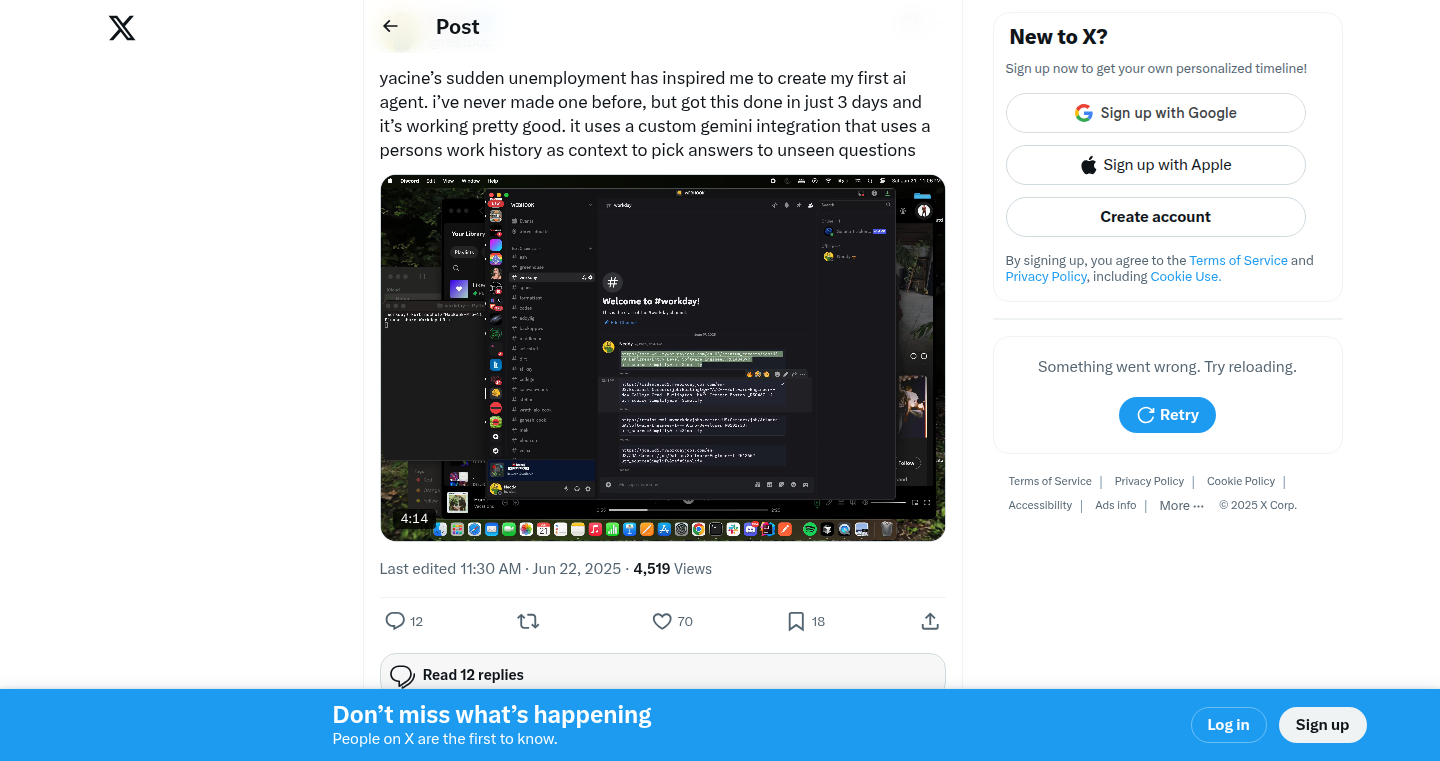
Author
korbinschulz
Description
This tool automates the job application process using AI agents. It leverages a combination of Large Language Models (LLMs) and advanced web scraping techniques to identify suitable jobs, tailor cover letters and resumes, and even apply for jobs automatically. The key innovation lies in its ability to act autonomously, navigating job boards and company websites as a digital agent, significantly reducing the time and effort required for job searching and application.
Popularity
Points 2
Comments 0
What is this product?
It's a smart bot that helps you apply for jobs. Think of it as a personal AI assistant for your job search. It uses AI, specifically Large Language Models like GPT, to understand job descriptions, write custom cover letters and resumes, and even submit applications on your behalf. The innovative part is that it doesn't just rely on pre-set templates; it analyzes each job and adapts its approach, effectively acting like a human applicant, but much faster and more efficient. This approach overcomes the tedious task of manually sifting through job postings and tailoring application materials. So this tool lets you automate your job application process.
How to use it?
Developers integrate this tool by providing their desired job criteria (e.g., specific roles, technologies, location). They would then connect it to their chosen job boards or website using their existing API or through web scraping if needed. The tool then takes over, finding jobs, and adapting your application materials for each opening. It is easy to set up as a script or integrate with existing job portals. Developers can also customize the AI's behavior through prompt engineering or parameter adjustments. So you can easily build a more efficient job hunting system.
Product Core Function
· {"functionName":"Job Board Scraping and Parsing","description":"This module automatically scans job boards (like LinkedIn, Indeed, etc.) and extracts job listings. It then parses the text, identifying key requirements, and the type of job, location and keywords. This is the first step and the most important function, giving the system the data it needs. So this enables the system to rapidly analyze a large number of job postings automatically."}
· {"functionName":"AI-Powered Content Generation (Cover Letters, Resumes)","description":"The tool utilizes LLMs to create personalized cover letters and adapt resumes tailored to each job description. It considers keywords, skills, and experience, dynamically adjusting the content to maximize the chances of getting noticed. So you can automate the tedious process of writing individual cover letters, helping your applications stand out."}
· {"functionName":"Automated Application Submission","description":"It can automate the process of filling out job application forms and submitting them on your behalf. This is where the 'agentic' part comes in. It navigates the application process, potentially using web scraping to interact with application forms. So it saves a lot of time by taking care of the mundane process of applying for jobs."}
· {"functionName":"Feedback Loops and Iteration","description":"This feature allows for feedback. The system learns from successful applications and failures, improving its future performance. It might track which applications receive responses and adjust its content generation strategy accordingly. This function gives the agent a learning capability and improves its effectiveness over time. So you can automatically improve your application strategy."}
Product Usage Case
· {"scenario":"Building a Career Portal Integration","description":"A developer could integrate this tool into a career portal. The portal could offer users an option to automatically apply for jobs using AI. This integration would save users a lot of time and effort in applying to jobs. So you can create a convenient and automated job-hunting experience for users, boosting user engagement and potentially leading to more successful job placements."}
· {"scenario":"Internal Recruitment Automation","description":"A company could use this tool internally to automate the process of identifying and contacting potential candidates, streamlining the hiring process, and decreasing recruitment lead times. This helps recruiters find suitable candidates more efficiently. So it can greatly reduce the time and resources required to find qualified candidates, allowing recruiters to focus on other essential tasks, such as interviewing and onboarding."}
39
Zeno: Gamified YouTube Learning with AI Summarization
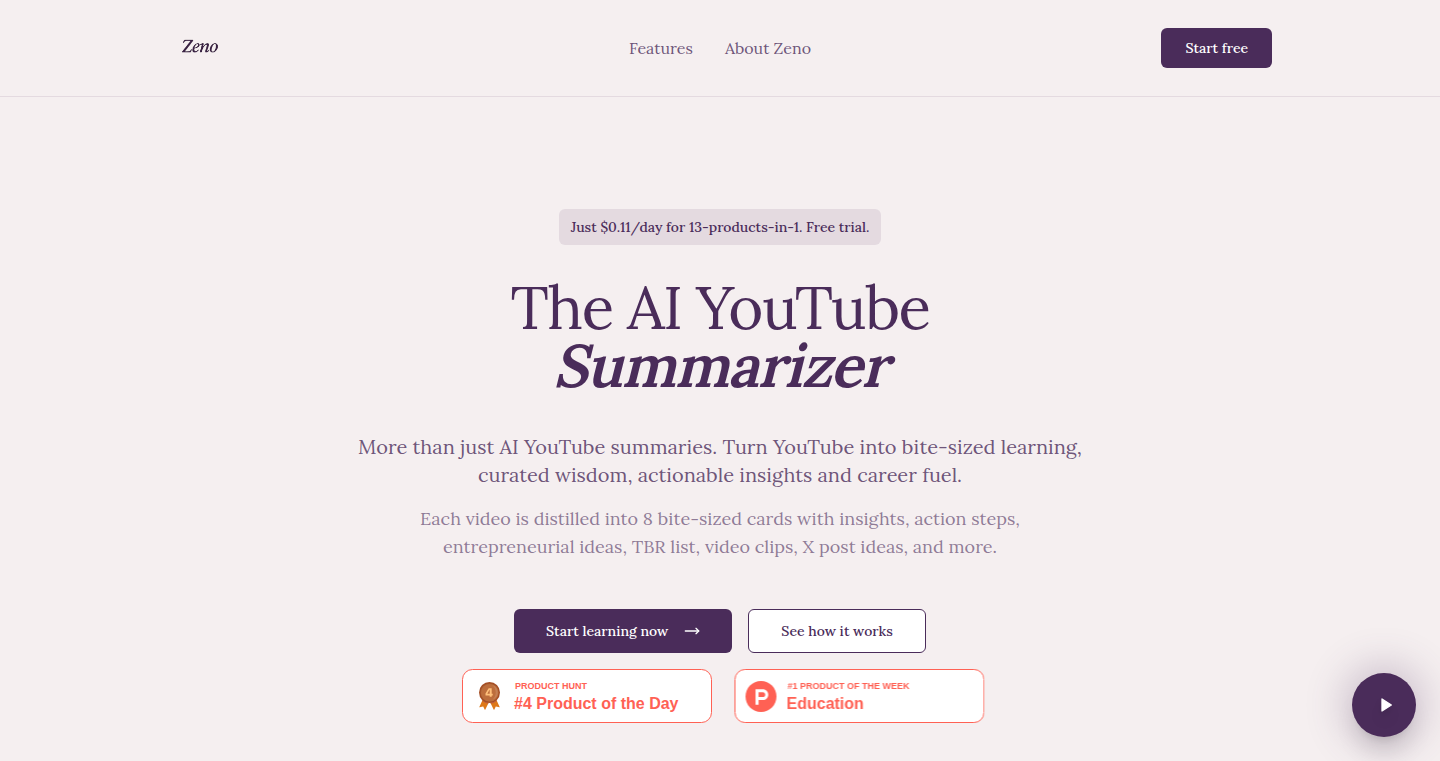
Author
BUILDERMARCUS
Description
Zeno is a tool designed to transform the way people learn from YouTube content. It leverages AI to summarize YouTube videos, allowing users to quickly grasp key information. The project gamifies the learning process, encouraging users to engage more actively with the content. The core innovation lies in the combination of AI-powered summarization and gamification to improve knowledge retention and user engagement. This addresses the common problem of wasting time on long videos without effective learning.
Popularity
Points 2
Comments 0
What is this product?
Zeno uses AI to create concise summaries of YouTube videos. Think of it like getting the Cliff's Notes for every video you watch. This is done by feeding the video's audio or transcript into an AI model, which then extracts the most important points. Furthermore, Zeno integrates gamification elements, like tracking progress and rewarding users for completing learning 'missions,' turning passive watching into active learning. So this helps you learn faster and remember more.
How to use it?
Users can access Zeno through a web application or a mobile app. You simply provide a YouTube video link. Zeno then generates a summary. You can then read the summary, take quizzes based on the video content, and track your progress. For developers, this means you could integrate Zeno's summarization API into your own learning platforms, content management systems, or even note-taking apps. This lets developers easily add a powerful knowledge extraction feature. So this lets you create smarter learning tools or enhance existing ones.
Product Core Function
· {"functionName":"AI-Powered Video Summarization","description":"Automatically generates concise summaries of YouTube videos. The AI analyzes the video's content, extracts key information, and presents it in an easy-to-understand format. This saves users significant time by allowing them to quickly grasp the core concepts of a video. This allows users to learn efficiently and quickly grasp the most important information.","value":"So this means less time watching videos, and more time actually learning."}
· {"functionName":"Gamified Learning Experience","description":"Incorporates game-like elements such as progress tracking, quizzes, and rewards to motivate users and enhance their engagement with the content. This transforms passive viewing into an active learning experience, increasing knowledge retention. This is a great way to make learning more enjoyable and effective.","value":"So this motivates you to learn, making learning fun and improve retention."}
· {"functionName":"YouTube Integration","description":"Seamlessly integrates with YouTube, allowing users to access summaries and engage with gamified learning directly from their favorite video platform. This makes the learning process more convenient. This is a way to connect with the content on the platform you use every day.","value":"So this allows you to enhance your YouTube experience and learn effectively."}
Product Usage Case
· {"scenario":"Personal Learning","description":"Use Zeno to quickly understand the content of long educational YouTube videos. For example, if you're learning a new programming language, Zeno can summarize tutorials and provide quizzes to test your understanding. This helps you master the subject matter quickly and efficiently. ","value":"So this helps you learn new skills faster."}
· {"scenario":"Content Creators","description":"Content creators can use Zeno's summarization API to create interactive learning resources for their audience. This adds extra value to their content and encourages viewers to engage more deeply. For example, a YouTuber can use Zeno to generate summaries and quizzes for their videos, making them more engaging. ","value":"So this helps you to offer your audience a richer learning experience."}
40
Chisel: Local-Like AMD GPU Kernel Development
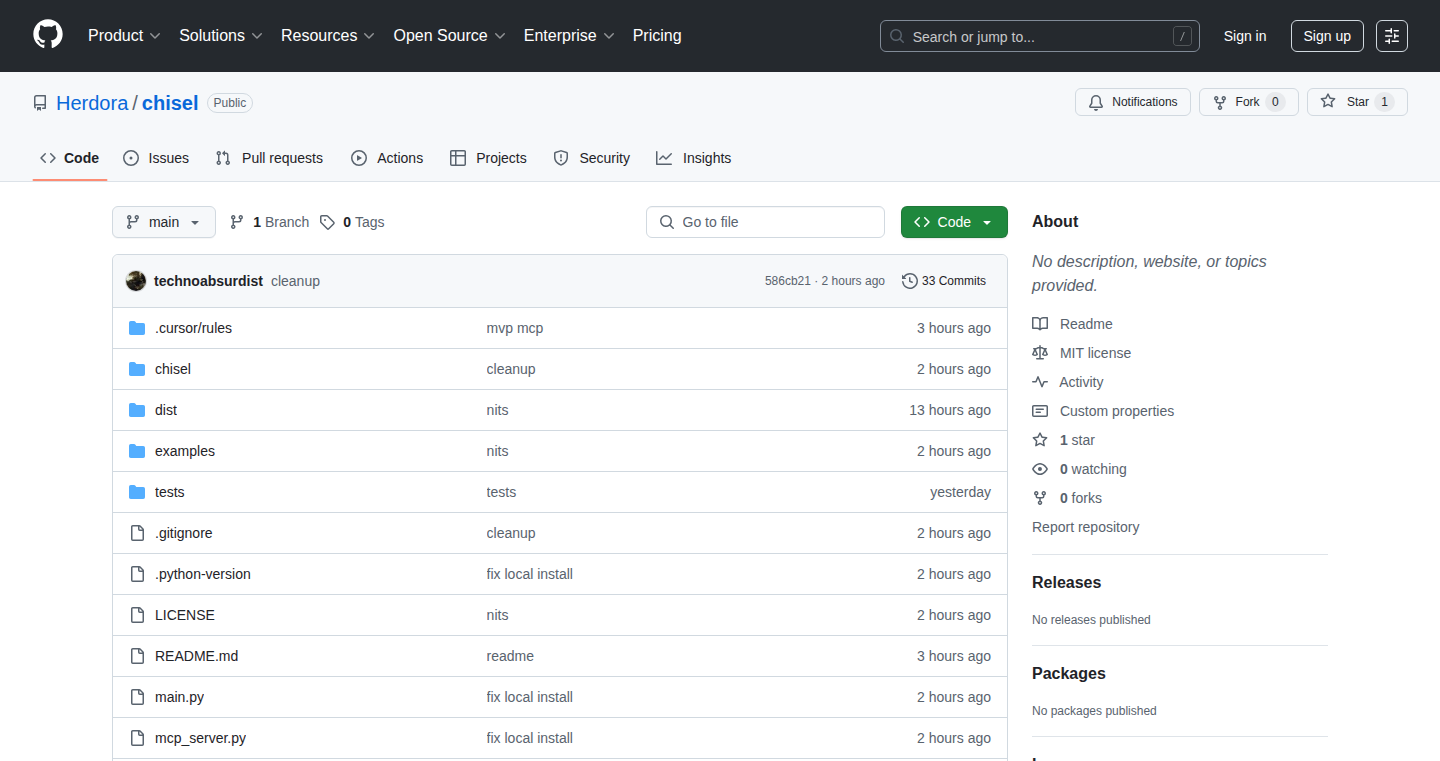
Author
technoabsurdist
Description
Chisel is a command-line tool designed to simplify the development and profiling of AMD GPU kernels, specifically targeting the MI300X series. It addresses the common pain points of remote development: constant SSH juggling, slow code uploads, and manual result downloads. Chisel automates the setup, code synchronization, profiling, and teardown processes on cloud-based AMD GPU instances, making the development experience feel local. The core innovation lies in its integration with `rocprof` (AMD's profiling tool) and its ability to manage the entire workflow from code upload to result retrieval with a single command, drastically reducing the time spent on infrastructure management.
Popularity
Points 2
Comments 0
What is this product?
Chisel is like a toolbox for AMD GPU developers. It lets you treat a remote AMD GPU in the cloud (like those available on DigitalOcean) as if it were sitting right next to you. It uses a simple command-line interface to handle all the tedious tasks: setting up the remote machine, transferring your code, compiling and running your GPU code, and downloading the results. The magic is in how it streamlines the process, especially the integration with `rocprof` which allows you to quickly find performance bottlenecks in your GPU code. This is a huge time saver. So, instead of spending hours fighting with servers, you can focus on writing and optimizing your GPU code.
How to use it?
Developers can use Chisel primarily through the command line interface (CLI). After installing it using `pip install chisel-cli`, you typically use commands like `chisel up` to launch a cloud instance, `chisel sync` to upload your code, `chisel profile kernel.cpp` to compile, profile, and download results, and `chisel pull` to get any artifacts back to your local machine. It is designed to be used primarily by developers who are working on GPU programming using AMD GPUs and the ROCm software stack. It is integrated into your existing development workflow as a wrapper around the remote execution and profiling process.
Product Core Function
· {"name":"chisel up","techValue":"Automates the provisioning of the necessary cloud infrastructure. This eliminates the manual setup process, like choosing the right cloud provider and configuring the server, which can be time-consuming and error-prone. This allows users to quickly get to work on their GPU code.","appScenario":"So, if you're starting a new project and need an AMD GPU, `chisel up` quickly gives you a development environment.","description":"Creates a cloud instance with an AMD MI300X GPU in seconds."}
· {"name":"chisel sync","techValue":"Uses efficient file transfer mechanisms, like rsync, to minimize upload times. This is crucial when you’re iterating on your code; you only need to upload the changes, not the entire codebase every time. It saves a lot of time and bandwidth.","appScenario":"So, if you've made a small change in your code and want to test it on the GPU, `chisel sync` makes it super-fast.","description":"Efficiently pushes only changed files to the remote instance."}
· {"name":"chisel profile kernel.cpp","techValue":"Integrates directly with AMD's profiling tools (rocprof) to provide performance insights. This is the core of the tool, providing critical information about how your code runs on the GPU, identifying performance bottlenecks, and offering a simple, automated profiling process.","appScenario":"So, if you're optimizing your GPU code, `chisel profile` gives you the data you need to identify and fix performance problems, letting you get the most out of your GPU.","description":"Compiles the specified code, profiles the kernel performance using rocprof, and downloads the trace files."}
· {"name":"chisel pull","techValue":"Simplifies downloading the results of your experiments. It ensures that you get the compiled binaries, trace files, and other relevant data back to your local machine for analysis.","appScenario":"So, if you've run your GPU code and want to analyze the output, `chisel pull` gets the results in a single command.","description":"Grabs build artifacts and results back to your local machine."}
· {"name":"Auto cleanup","techValue":"Ensures that cloud resources are properly terminated after use, preventing unexpected costs from running cloud resources unnecessarily. ","appScenario":"So, if you are done with the development and profiling process, auto cleanup helps prevent wasted money by automatically cleaning up cloud resources.","description":"Automatically prevents zombie droplets. "}
Product Usage Case
· {"problem":"Setting up the environment, transferring the code, and profiling the kernels on remote cloud instances is very time-consuming.","solution":"Using Chisel, they can use simple commands like `chisel up`, `chisel sync`, and `chisel profile`, to speed up the iterative development process, allowing to focus on optimizing the machine learning model's performance.","scenario":"A researcher is optimizing a machine learning model for AMD GPUs."}
· {"problem":"The infrastructure setup and profiling takes too long to iterate on kernel code and benchmark them.","solution":"Chisel streamlines the development workflow and gives them an edge by automating the infrastructure management and profiling steps, enabling faster iterations, more experiments, and therefore, more competitive results.","scenario":"A developer is participating in a GPU optimization competition."}
41
AI Distiller (aid): Hallucination-Reducing Code Companion
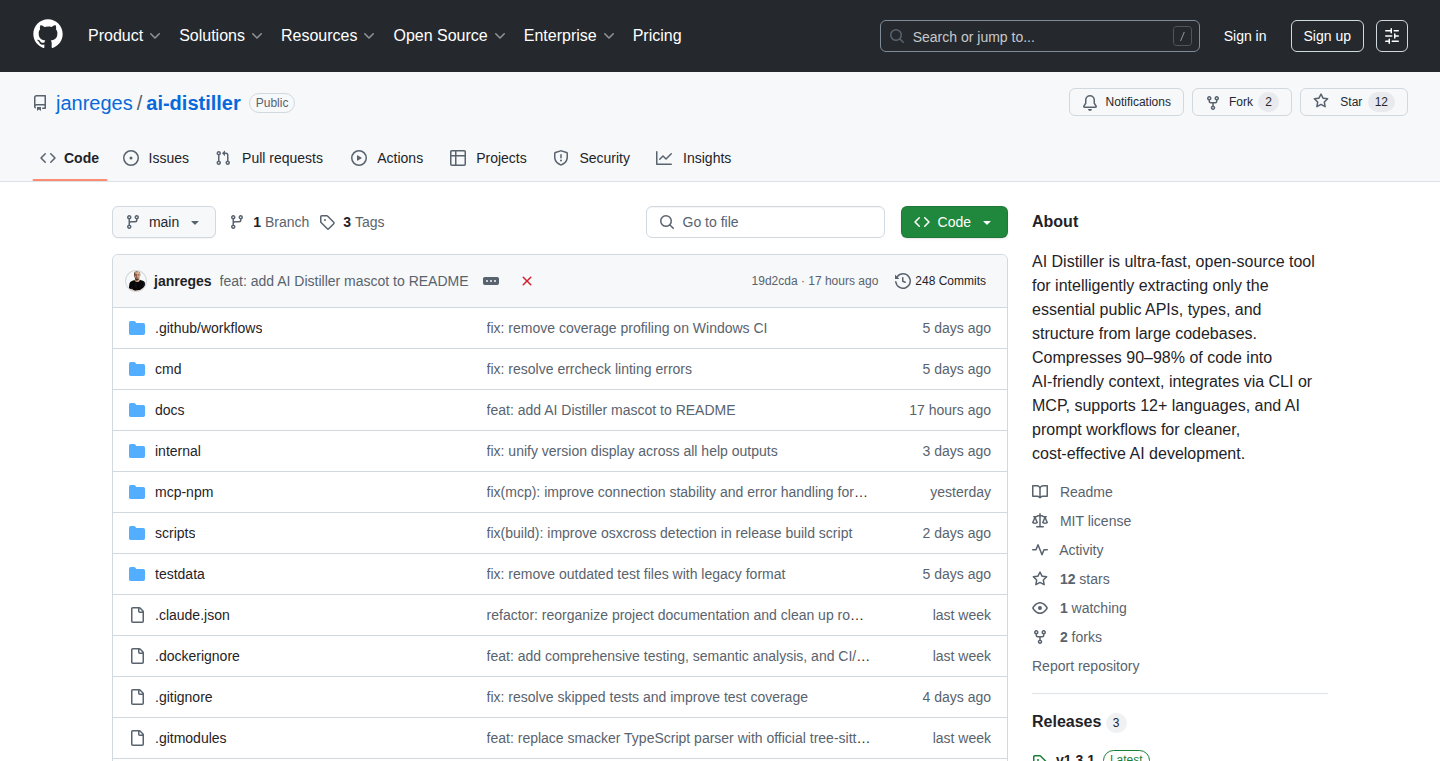
Author
jregmail
Description
AI Distiller (aid) is a tool designed to mitigate the issue of 'hallucinations' in code generated by AI. This means it aims to reduce the occurrence of the AI generating code that seems correct but actually doesn't work. It achieves this by distilling the AI's output, validating and refining the generated code to ensure its reliability and correctness, particularly in the context of 'vibe coding' or rapid, iterative code generation based on instinct. The technical innovation lies in its ability to analyze and filter AI-generated code to improve accuracy and reduce errors. This is a significant improvement for developers relying on AI assistance for code generation.
Popularity
Points 2
Comments 0
What is this product?
AI Distiller (aid) is essentially a code validator. When you use an AI to write code, sometimes it makes mistakes. AI Distiller acts like a quality control check. It takes the code the AI spits out, examines it, and tries to fix any potential problems. It's especially useful when you're quickly generating code, like when you're 'vibe coding' – where you're intuitively writing code based on gut feeling and rapid experimentation. Its core technical principle involves post-processing the AI's generated code, applying static analysis and potentially running tests to verify code correctness before it's integrated into a development environment. So, it is a tool that helps programmers quickly, and more reliably, build software with the help of AI.
How to use it?
Developers can use AI Distiller (aid) as a plugin or integrated component within their development environment. When using AI for code generation, the generated code would first be piped through aid for validation. This could involve simple checks like looking for syntax errors, or more complex analysis like verifying code logic through unit testing or static code analysis. The developer would then receive a 'distilled' version of the code, with potential errors corrected or warnings highlighted. This can be integrated directly into an existing IDE or as a pre-commit hook in your Git workflow. For example, if you are using GitHub Copilot or similar tools, you could configure aid to automatically review and refine the generated code before you commit it. So, it makes the entire AI-assisted coding process more reliable and efficient.
Product Core Function
· {"function":"Code Analysis and Validation","description":"The core function is analyzing the AI-generated code. This includes checking for syntax errors, code style violations, and potential logic flaws. This process could involve a combination of static analysis (looking at the code without running it) and perhaps even executing the code to ensure it works as intended. It helps to identify 'hallucinations' or the code that 'seems' correct but isn't. This saves a developer from wasting time debugging faulty code. So, it's like having an automated code reviewer.","value":"This is valuable because it catches errors early in the development process, reducing debugging time and improving overall code quality. It helps developers using AI-assisted tools to avoid the time-consuming and frustrating task of manually finding and fixing code mistakes. So, it reduces the time wasted on incorrect code, which improves productivity."}
· {"function":"Hallucination Reduction","description":"This feature focuses on the specific problem of AI-generated 'hallucinations.' It uses various techniques, potentially including statistical analysis, code comparison, and testing, to identify and mitigate incorrect code segments. It's designed to specifically address the issue of AI generating code that seems correct on the surface but fails to function properly. The process attempts to rewrite or refine the problematic code sections. So, it's a system for detecting and correcting potentially inaccurate code.","value":"This is important because it directly addresses the most significant pain point of using AI for code generation: the risk of unreliable code. By reducing hallucinations, AI Distiller (aid) makes the AI-assisted coding experience much more trustworthy, allowing developers to be confident in their AI-generated code. So, it makes AI-assisted coding significantly more trustworthy and practical."}
· {"function":"Code Refinement and Suggestion","description":"Beyond just identifying problems, AI Distiller (aid) potentially offers suggestions for improving the code. This may involve suggesting alternative implementations, fixing errors, or optimizing the code for performance or readability. It could use natural language processing (NLP) techniques to understand the code's purpose and suggest improvements. So, it's an active tool that works towards producing better code.","value":"This is valuable as it goes beyond basic error detection and helps developers write better, more efficient, and more maintainable code. It can accelerate the development process by providing intelligent suggestions for code improvement. This not only saves time but also helps developers learn best practices. So, it improves code quality and helps developers to write better code."}
Product Usage Case
· {"scenario":"Rapid Prototyping with AI","description":"Imagine a developer quickly building a mobile app using an AI-powered code generator. The developer uses 'vibe coding', generating code based on their intuition and rapid experimentation. The AI initially produces code with subtle errors or logic flaws. By integrating AI Distiller (aid) into their workflow, the developer automatically validates and refines the generated code, preventing errors and speeding up the prototyping process.","technicalBenefit":"AI Distiller (aid) prevents the developer from needing to spend a lot of time debugging and fixing issues that are quickly found by the tool. This allows the developer to iterate rapidly and get to a working prototype faster, significantly boosting productivity and efficiency. So, it significantly speeds up the prototyping phase of software development."}
· {"scenario":"Integrating AI-Generated Code in a Team","description":"In a team environment, different developers might generate code using AI tools. AI Distiller (aid) is used to maintain code consistency and quality across the team. The tool validates each team member's AI-generated code, ensuring that the code adheres to the project's coding standards and does not introduce unexpected bugs. This streamlines the code review process and reduces the risk of introducing bad code into the project.","technicalBenefit":"AI Distiller (aid) provides consistency and quality across the team's code. It reduces the need for time-consuming code reviews and helps maintain a higher overall standard of code quality across the project, making debugging and maintenance easier for the team. So, it ensures code quality and consistency, leading to better team collaboration and easier project maintenance."}
42
BuffetBot: Interactive AI for Financial Wisdom

Author
hydershykh
Description
This project allows you to chat with a virtual financial advisor, leveraging AI to emulate the investment strategies and advice of Warren Buffett. The core innovation lies in the use of large language models (LLMs) to personalize financial guidance based on a user's specific needs and profile, while also grounding the advice in a simulated knowledge base and historical investment data. This tackles the challenge of providing accessible and personalized financial advice, democratizing access to insights often reserved for high-net-worth individuals.
Popularity
Points 2
Comments 0
What is this product?
BuffetBot is an AI-powered chatbot that acts as a virtual financial advisor, channeling the principles of Warren Buffett. It uses advanced natural language processing (NLP) and LLMs to understand user queries, provide investment recommendations, and explain financial concepts in a relatable manner. The innovation lies in its ability to combine a vast knowledge base with personalized insights, creating a dynamic and educational user experience. So, it is an AI that can give you financial advice.
How to use it?
Developers can interact with BuffetBot via a simple API (Application Programming Interface). This enables integration into existing financial applications, personal finance tools, or even educational platforms. By sending user queries, the developer receives personalized investment advice, explanations of financial concepts, and potential investment strategies. For example, you could integrate it into a budgeting app to provide users with contextually relevant financial advice as they plan their spending. It's like adding a financial guru to your application. So, you can build financial tools with added value.
Product Core Function
· {"functionName":"Personalized Financial Advice","technicalValue":"The use of LLMs allows for dynamic and context-aware advice, going beyond static rules or canned responses. This offers the user with a much richer and more helpful interaction.","description":"Provides investment recommendations tailored to the user's risk tolerance, financial goals, and investment horizon. This leverages LLMs to analyze user input and generate advice that's directly relevant to their specific situation. So, this helps people make informed decisions about their money."}
· {"functionName":"Investment Strategy Explanations","technicalValue":"The LLMs are trained on a vast corpus of financial literature and can translate complicated concepts into accessible information.","description":"Explains complex financial concepts and investment strategies in simple, easy-to-understand language, as if explained by Warren Buffett himself. This helps users to understand the 'why' behind investment decisions. So, users can learn why they're doing things, rather than just what to do."}
· {"functionName":"Simulated Portfolio Analysis","technicalValue":"This relies on data analysis and predictive modelling, using historical market data to provide realistic performance estimations.","description":"Offers the ability to simulate portfolio performance based on different investment strategies and market conditions. This allows users to test different approaches without risking actual capital. So, they can see the results without gambling real money."}
· {"functionName":"Risk Assessment and Management","technicalValue":"Algorithms assess the user’s risk appetite and suggest different investment options based on it.","description":"Assesses the user's risk tolerance and provides guidance on how to manage and mitigate investment risks. This is essential for responsible financial planning. So, it can help minimize financial losses."}
Product Usage Case
· {"technicalBenefits":"The API integration enables seamless data exchange between the budgeting app and BuffetBot, allowing for personalized advice based on the user's spending and saving habits. The LLMs provide the intelligence.","scenario":"Integrating into a Budgeting App","description":"A budgeting app could integrate BuffetBot to provide context-aware investment advice. For example, when a user saves a certain amount each month, the app could suggest investment options aligned with their risk profile and financial goals. So, users receive investment insights exactly when they need it."}
· {"technicalBenefits":"The platform utilizes the API and the chatbot, offering students interactive financial knowledge.","scenario":"Developing a Financial Education Platform","description":"An educational platform could use BuffetBot as an interactive learning tool. Users can ask financial questions, understand financial jargon, and test investment strategies, all guided by the virtual advisor. So, this makes learning about money much easier."}
· {"technicalBenefits":"This allows the website to give personalized financial advice.","scenario":"Personal Finance Website","description":"Create a website that offers financial advice to users. By using the API, the website can interact with the BuffetBot to provide financial advice."}
43
Dev-AI Toolkit: A Curated Collection of Ad-Free Developer and AI Utilities
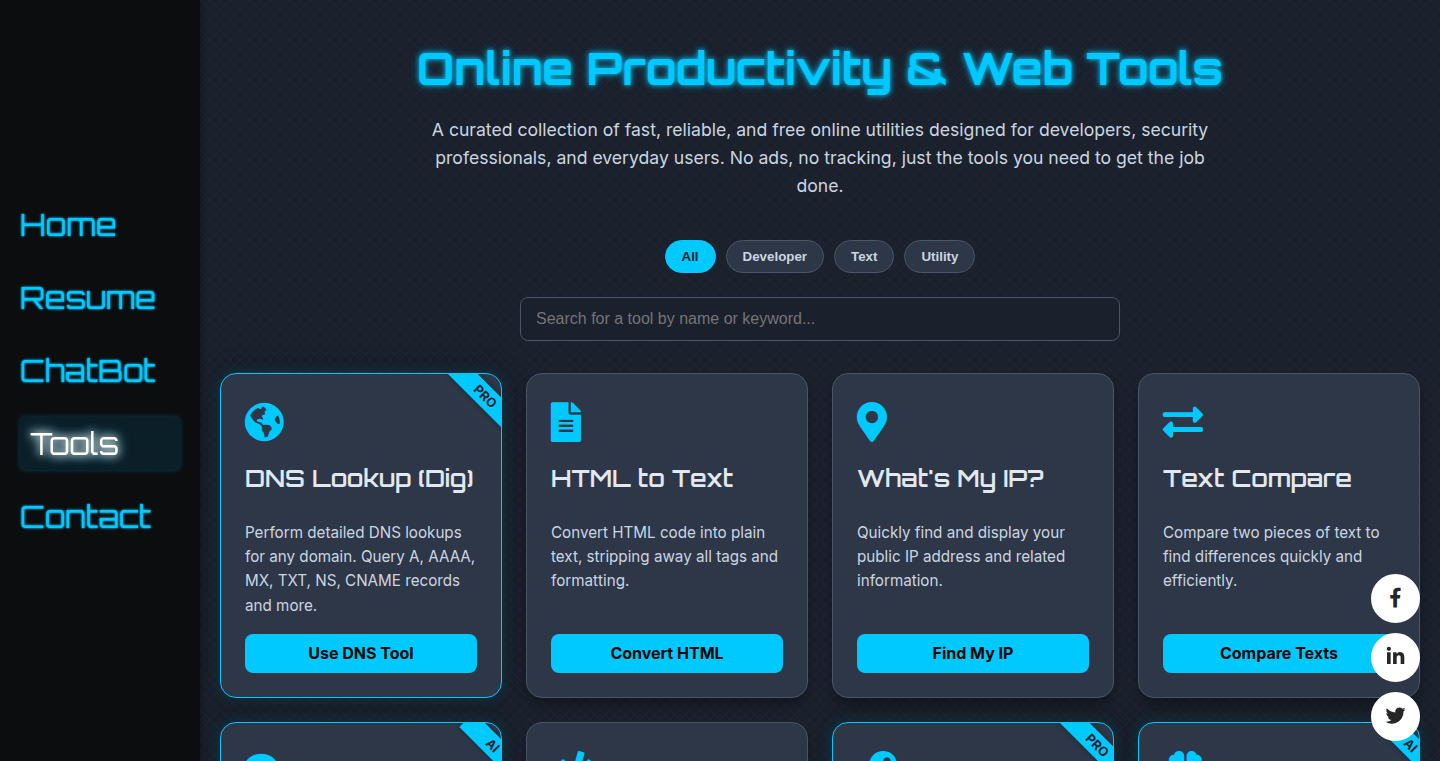
Author
kasakaybarahay
Description
This project is a curated collection of free, ad-free tools specifically designed for developers and AI enthusiasts. It aims to provide a central hub for essential utilities, addressing the pain points of constantly searching for reliable and cost-effective tools. The core innovation lies in its focus on practical, no-nonsense utilities, eliminating distractions and providing a clean development experience.
Popularity
Points 1
Comments 1
What is this product?
This project gathers a bunch of useful tools, like things developers use all the time and some new AI-powered helpers. The cool part? They're all free and, importantly, they don't bombard you with ads. Think of it as a well-stocked toolbox for coding, testing, and even getting a little help from AI, all in one place. So, it's built with practicality in mind and helps developers focus on their work.
How to use it?
Developers can use this collection by simply browsing the available tools and selecting the ones that fit their needs. Imagine you need to convert some data format or debug some code; you can use a tool from the collection. The integration depends on the specific tool, but it often involves simple copy-pasting, API calls, or command-line interactions. The goal is to make these tools easy to discover and integrate into your workflow. So, it is easy to find and use the right tool at the right time and integrate it into your everyday work.
Product Core Function
· **Code Formatters and Linters:** Tools to automatically clean up your code and make it easier to read. *So this helps you write cleaner, more consistent code, making it easier to spot errors and collaborate with others.*
· **Data Conversion Utilities:** Tools to convert data between various formats, like JSON, CSV, and XML. *So, this helps you easily move data between different systems or platforms without manually converting them.*
· **Debugging Tools:** A suite of utilities designed to help developers find and fix errors in their code. *So, this enables you to identify and resolve issues faster, saving you time and frustration.*
· **AI-Powered Code Generation & Assistance:** Tools leveraging AI to help write code snippets, offer suggestions, or automate repetitive tasks. *So, it can boost your coding speed and potentially reduce the time you spend writing boilerplate code.*
· **Network Testing Tools:** Utilities that help test network connectivity and analyze network traffic. *So, this helps diagnose network problems and ensures your applications work smoothly over the internet.*
Product Usage Case
· **Web Development:** A developer building a website can use the CSS/HTML validator from the collection to ensure their code is error-free and compatible with different browsers. *So, this helps ensure the website looks and functions correctly across all browsers.*
· **Data Analysis:** A data scientist can use the collection’s data format converter to convert data from a CSV file to JSON format for use in a machine learning model. *So, this simplifies the data preparation process for analysis.*
· **Mobile App Development:** A mobile app developer can use the collection's debugging tools to quickly identify and fix bugs in their app. *So, this helps you release more stable and reliable apps.*
44
Warka: React-Powered E-Ink Display Framework
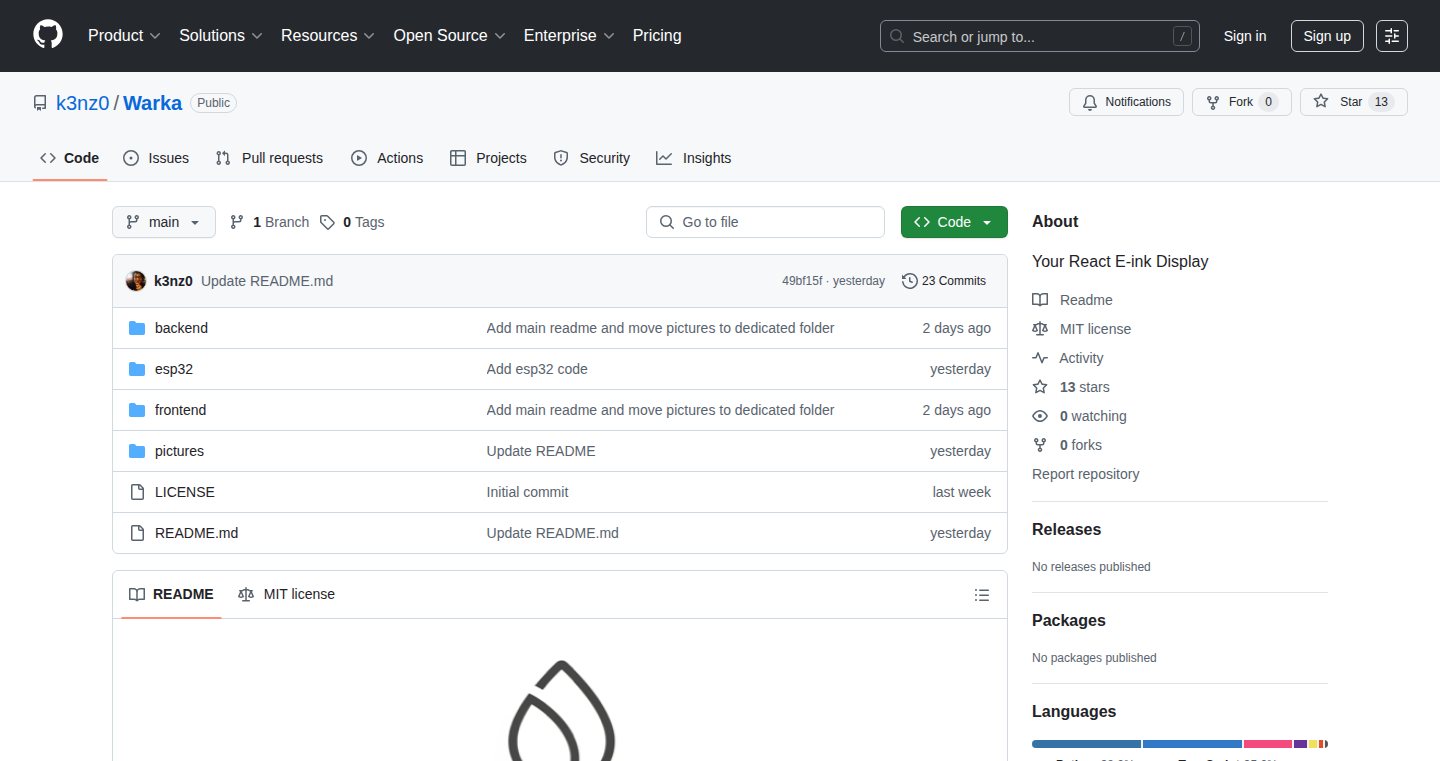
Author
k3nz0
Description
Warka is a framework that lets you build dynamic displays for e-ink screens (like those in e-readers or digital nameplates) using React for the front-end and Python for the back-end. The cool part? It gets the image for the e-ink screen from a lightweight program on an ESP32 microcontroller. This means you can design the display using the familiar React framework and then have it update quickly on your e-ink device. No more struggling with complicated C++ code to draw simple things. It solves the problem of cumbersome and slow development cycles for e-ink displays.
Popularity
Points 2
Comments 0
What is this product?
Warka is a system that uses React (a popular web framework) to design what you want to show on an e-ink display. The magic happens behind the scenes: a Python server handles communication, and a tiny program on a small microcontroller (ESP32) quickly grabs an image created by React and displays it on the e-ink screen. This allows for rapid iteration and design flexibility. The key innovation is abstracting the low-level complexities of driving the e-ink display, letting developers focus on the user interface and design using web technologies they already know. So, it's like making websites for e-ink screens.
How to use it?
Developers use Warka by building their display layout using React, the same way they'd build a website. The React code then generates an image which is sent to the Python backend. The backend then sends this image to the ESP32, which displays it on the e-ink screen. You would typically use Warka when you want to create a customized e-ink display for showing information, like a smart calendar, a weather dashboard, or a news feed. You could integrate it into a home automation project, build a digital signage solution, or create a display for displaying sensor data. It's about making the e-ink display development process much faster and more flexible, allowing the developer to quickly iterate.
Product Core Function
· **React-Based Frontend:** This lets you use the familiar and powerful React framework to design your e-ink display. You can easily create complex layouts, add dynamic content, and handle user interactions. *So what?:* Faster development, better design flexibility, and access to a huge ecosystem of React components. This is great for making attractive and interactive displays quickly.
· **Python Backend:** The Python server handles the communication between the React frontend and the ESP32 microcontroller. It's responsible for generating the image from your React design and sending it to the display. *So what?:* It makes the whole system easier to manage and ensures smooth image transfer. This removes the complexities of low-level hardware control.
· **ESP32 Microcontroller with Lightweight C++:** This is a small, low-power computer that runs a very efficient program to receive the image from the Python server and display it on the e-ink screen. *So what?:* It makes the system work reliably and efficiently, making sure your e-ink display updates quickly and uses very little power. This ensures the e-ink display refreshes rapidly and is ideal for battery-powered applications.
· **Fast Iteration Cycle:** Because you're using web technologies, you can quickly make changes to your display and see the results on the e-ink screen. No more slow compilation and upload times. *So what?:* You can quickly experiment with different designs, layouts, and functionalities. This drastically improves the development process.
Product Usage Case
· **Smart Calendar Display:** Create an e-ink display that shows your daily schedule, appointments, and reminders. You could use a React component to fetch the calendar data from a service like Google Calendar and display it in a clear and readable format. *So what?:* Have a low-power, always-on display showing your schedule, so you are constantly updated on events without needing to turn on a phone or computer.
· **Weather Dashboard:** Build a weather display showing current conditions, forecast, and other weather information. The React frontend could fetch data from a weather API, and the display would update automatically. *So what?:* Always know what's going on with the weather at a glance, and save power by avoiding the need for a full-fledged screen.
· **Home Automation Control Panel:** Design an e-ink display to control smart home devices. You could create buttons and indicators that allow you to turn on lights, adjust the thermostat, and monitor sensors. *So what?:* Control your smart home more efficiently and create a custom interface that fits your exact needs.
· **Digital Nameplate/Signage:** Build an e-ink display that shows personalized messages, or other information. Update the display remotely using the React frontend. *So what?:* Display important information, that can be updated easily in an office, public area or your home.
45
Lazycontainer: Terminal UI for Apple Containers
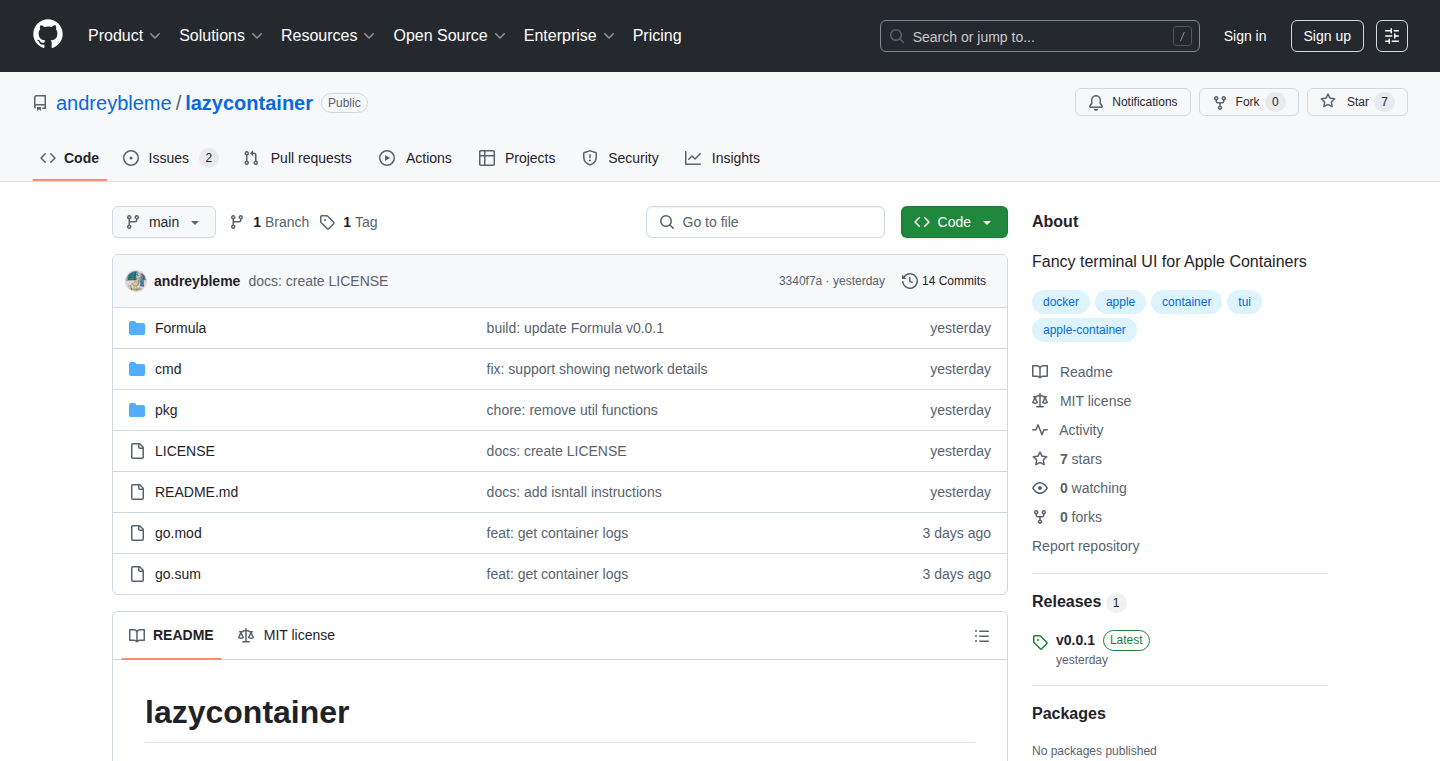
Author
andreybleme
Description
Lazycontainer is a terminal-based user interface designed to simplify the management of Apple containers. It's like a command center for your containers, offering an easy-to-use interface within your terminal window. The innovative aspect is its specific focus on Apple's native container implementation, which is a fresh area. This tackles the problem of lacking a user-friendly terminal interface for managing these containers, similar to how 'lazydocker' did for Docker. So this gives you a more accessible way to work with Apple's containers.
Popularity
Points 2
Comments 0
What is this product?
Lazycontainer is essentially a visual tool you use from your terminal. It lets you manage Apple containers and images, just like a graphical user interface, but directly within your text-based terminal. The innovation is in its targeted support for Apple containers, filling a gap in existing tools. It works by giving you a clear, navigable display of your containers' status, allowing you to easily start, stop, inspect, and manage them. So this is a streamlined and intuitive way to handle your Apple containers without having to type out complicated commands.
How to use it?
Developers can use Lazycontainer by simply running it from their terminal. It's typically installed using package managers or building it from source. Once running, you can navigate the interface using keyboard shortcuts to view container details, see logs, and perform actions. You'd integrate this into your workflow whenever you're working with Apple containers – for tasks like building, testing, or deploying applications that rely on containerization. So this makes it super easy to check container health, understand error messages, or rapidly make changes to your containers' configuration.
Product Core Function
· **Container Management:** Allows you to view a list of running and stopped containers, their statuses, resource usage (like CPU and memory). This is valuable because it provides a real-time overview of your containerized applications, enabling quick identification of issues and easy management of the containers.
· **Image Management:** Provides information about container images (the building blocks of containers), including their size, creation date, and tags. So this helps you monitor what's running, clear out unused images, and generally keep your development environment tidy.
· **Log Viewing:** Displays the output logs of your running containers. This is crucial for debugging applications; you can see what's going on inside your containers without needing to jump around different tools. So this lets you quickly diagnose problems.
· **Basic Actions (Start, Stop, Restart):** Enables you to execute common container management actions directly from the terminal UI. So this offers quicker management without memorizing commands.
Product Usage Case
· **Development Workflow:** Imagine you're building a web application using Apple containers. You can use Lazycontainer to quickly start and stop your database container, view the logs of your application container to debug problems. So this means you can streamline development and debug faster.
· **Testing Environments:** If you're setting up a test environment, you can use Lazycontainer to quickly spin up different containerized services and monitor their behavior. So this makes setting up and maintaining test environments easier.
· **Deployment Monitoring:** In a deployment scenario, Lazycontainer provides a quick way to check the status of running containers on the server, viewing logs, and quickly restart any containers if necessary. So you're now able to monitor your deployments in real time and quickly resolve issues that arise.
46
YourTaste: LLM-Powered Movie Recommender

Author
boratanrikulu
Description
YourTaste is an AI-powered movie recommendation engine that analyzes your Letterboxd profile to understand your movie preferences. It uses Large Language Models (LLMs) and your existing movie likes, ratings, and reviews to provide personalized suggestions. You can also search by 'vibe' or use natural language prompts to find movies. The project focuses on leveraging LLMs to understand and predict user taste in movies based on limited, user-provided data. This solves the problem of finding movies that truly resonate with you, beyond simple genre or star-based recommendations.
Popularity
Points 2
Comments 0
What is this product?
YourTaste is a movie recommender that uses Artificial Intelligence (AI) to understand your movie preferences based on your Letterboxd profile. Think of it as a smart friend who knows your taste and suggests movies you’ll love. It uses cutting-edge 'Large Language Models' (LLMs) – the same technology behind powerful chatbots – to analyze your existing movie ratings, reviews, and likes. The innovation lies in its ability to understand the nuances of your taste, going beyond simple genres or actors. This allows for recommendations based on 'vibe' (e.g., 'uplifting dramas') or specific prompts (e.g., 'similar to X but with a different ending'). So this allows you to discover hidden gems and tailor recommendations to very specific needs.
How to use it?
You can use YourTaste by simply linking your Letterboxd profile. The AI will then analyze your movie history. You can then receive recommendations tailored to your taste. You can also search using keywords describing the 'vibe' you're looking for or by providing natural language prompts. The system provides recommendations based on these analyses. Integration is effortless since all you need is the Letterboxd profile link. So, it's super easy for anyone using Letterboxd to get better movie suggestions.
Product Core Function
· {"functionName":"Profile Analysis via LLMs","description":"The core of YourTaste is its ability to analyze your Letterboxd data using LLMs. This involves processing your movie ratings, reviews, and liked films to understand your specific preferences. The LLMs are trained to identify patterns, themes, and emotional tones in your taste. This goes beyond basic filtering, providing nuanced understanding. \n\n**So this helps you get more relevant suggestions, because it understands the 'why' behind your movie choices, not just the 'what'.**","value":"It provides highly tailored movie recommendations."}
· {"functionName":"Vibe-Based Search","description":"Users can search for movies by describing a certain 'vibe' or mood (e.g., 'feel-good comedies', 'dark thrillers'). The AI will then sift through its database using the analyzed taste information to find movies that match the described emotion or tone. This functionality allows users to easily discover movies appropriate for specific moods or desired atmospheres. \n\n**So this lets you find movies based on how they make you feel.**","value":"Enables discovery of movies based on mood or desired tone."}
· {"functionName":"Natural Language Prompting","description":"Users can describe what they are looking for in plain English (e.g., 'movies similar to X but with a different ending'). The LLMs understand the intent behind these prompts and uses that to make better recommendations based on analyzing the existing movie knowledge. The AI is trained to understand context and semantics, this opens up a wide range of possibilities for movie exploration. \n\n**So this allows you to be very specific with your requests and uncover movies you may never have found otherwise.**","value":"Offers flexible and precise movie discovery based on natural language queries."}
Product Usage Case
· {"solution":"You describe your preferences as 'thought-provoking dramas' in the search. YourTaste analyzes your Letterboxd data, takes into account your previous rating, reviews, and taste and gives you recommendations of movies that aligns with your taste.","scenario":"You're in the mood for a thought-provoking drama but you don't know what to watch","value":"It helps you find the perfect movie for the moment, saving you time and improving your chances of watching something you'll genuinely enjoy."}
· {"solution":"You use a natural language prompt: 'Movies similar to Aftersun but with a hopeful ending.' YourTaste then uses its LLM to process the prompt and recommends movies that align with the description.","scenario":"You loved the movie 'Aftersun' and are looking for something similar, but with a more optimistic ending.","value":"This allows to discover films that match the specific emotional needs, opening up an avenue for more personalised movie discovery"}
47
MCP Random: True Random Number Generation via Atmospheric Noise
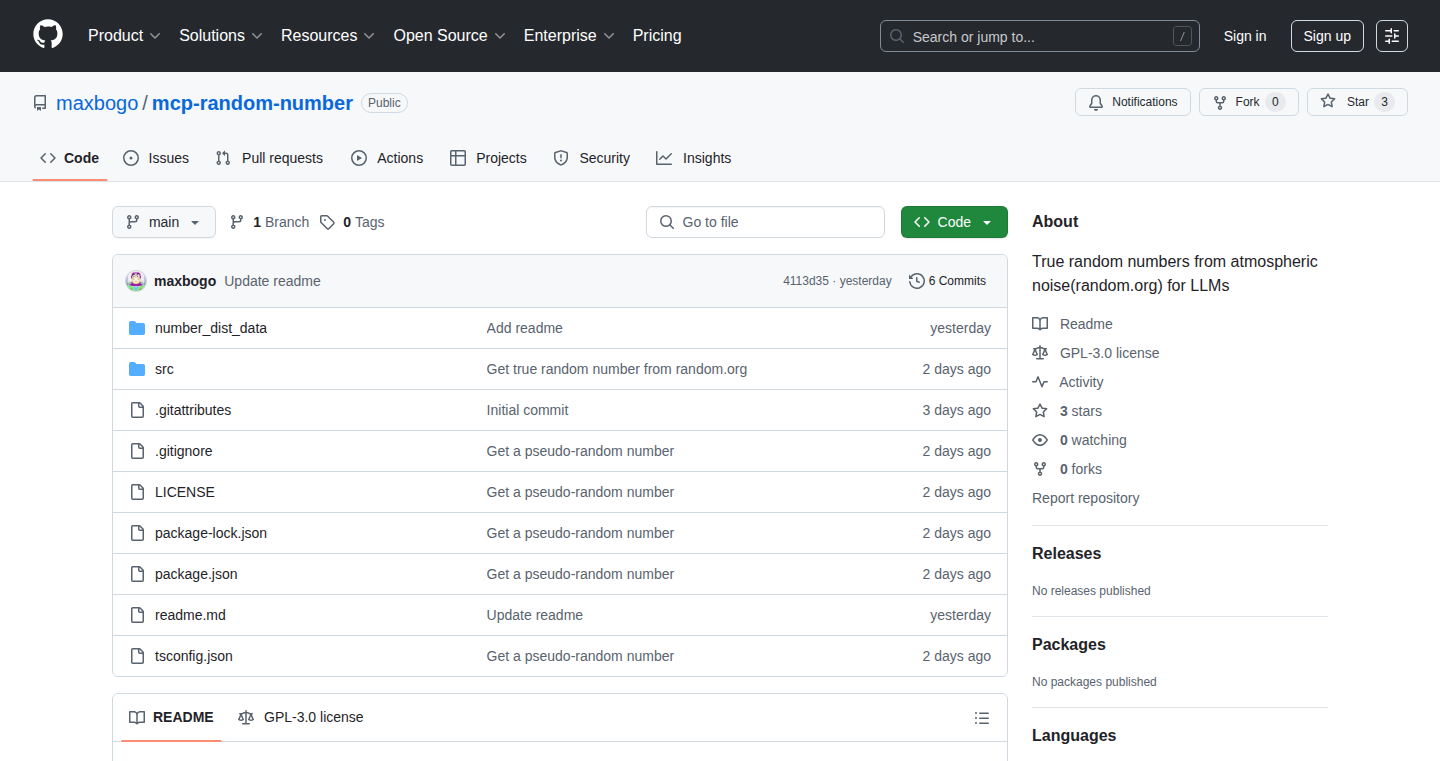
Author
maxim_bg
Description
This project, 'MCP Random,' provides a way to generate random numbers within a specified range by tapping into the true randomness provided by the atmospheric noise from random.org. The key innovation is its ability to fetch truly random numbers, unlike the potentially biased or predictable random numbers that might be generated by Large Language Models (LLMs). This solves the problem of LLMs exhibiting a bias toward specific numbers, making it useful for simulations, games, and any application where unbiased randomness is crucial.
Popularity
Points 2
Comments 0
What is this product?
MCP Random is a tool that fetches random numbers from an external, verifiable source (random.org) that relies on atmospheric noise. This is more robust than relying on the LLM's internal random number generation, which can be surprisingly biased. The project ensures that the numbers generated are truly random and thus useful in various fields. This is an important point because the number generation within LLMs can be predictable, which defeats the purpose of randomness. The project addresses this with a solution rooted in verifiable, external randomness.
How to use it?
Developers can integrate MCP Random into their projects to replace or supplement the random number generators built into LLMs or other systems. You would typically request a range of numbers (e.g., from 1 to 100) and MCP Random would fetch these numbers for your application. This ensures the numbers you use in your game, simulation, or research are not biased. The project can be integrated as an API call or a library import within your project. So you will benefit from a truly random number generator that ensures your results are unbiased.
Product Core Function
· {"functionName":"Random Number Retrieval","techValue":"Ensures the generated numbers are not predictable or biased. This is particularly important in scenarios like simulations, games, or any application requiring true randomness. So this functionality protects your work by providing the unbiased results you need to make accurate predictions.","description":"Fetches random numbers from random.org within a specified range. This is the core function, providing the raw material for all other functionalities. It uses the random.org API, which extracts randomness from atmospheric noise, offering a high degree of unpredictability."}
· {"functionName":"Range Specification","techValue":"Provides flexibility in using the tool for various purposes. So this function makes the tool extremely adaptable and useful for different applications.","description":"Allows users to specify the minimum and maximum values for the random number generation. This allows you to adapt to the project's requirements, such as choosing the number from 1-100, or 1-10, or whatever is needed by your task. This is a simple but very important feature of random number generation."}
· {"functionName":"API Integration","techValue":"Allows the project to be easily integrated into various software development environments, making it a versatile tool. So, you don't have to be a developer to benefit from this, as the tool can easily fit into any project.","description":"The project can be easily integrated into other applications via its API, allowing for easy use within other software or services. So this function makes it easier for other programs to use this random number generator."}
Product Usage Case
· {"applicationScenario":"Game Development","description":"In games, random numbers are used for everything from dice rolls to determining enemy behavior. MCP Random could be used to ensure that the dice rolls or enemy movements within a game are not predictable or biased, enhancing the fairness and replayability of the game.","techSolution":"MCP Random's true random number generation replaces the game's internal random number generator. So, in games, every result will be truly random, which means a better experience and less predictability."}
· {"applicationScenario":"Scientific Simulations","description":"Scientists often use simulations that depend on random numbers to model complex systems. Using MCP Random ensures that the simulation results are based on true randomness. If these random numbers are not unbiased, it may invalidate your research. ","techSolution":"Integrating MCP Random assures that the simulations are based on truly random, unbiased data. So you can trust your simulation results."}
· {"applicationScenario":"LLM Training and Evaluation","description":"When training and evaluating LLMs, it's useful to use randomness for certain tasks. As the author notes, LLMs can show biases. Using an external, verifiable random number source can help ensure the integrity of such tests.","techSolution":"MCP Random ensures that the LLM evaluations are based on unbiased random inputs, improving the reliability of the evaluation. So, you will know that the results are accurate."}
48
Rotta-Rs: A Rust-Powered Deep Learning Framework for the Simplicity-Obsessed
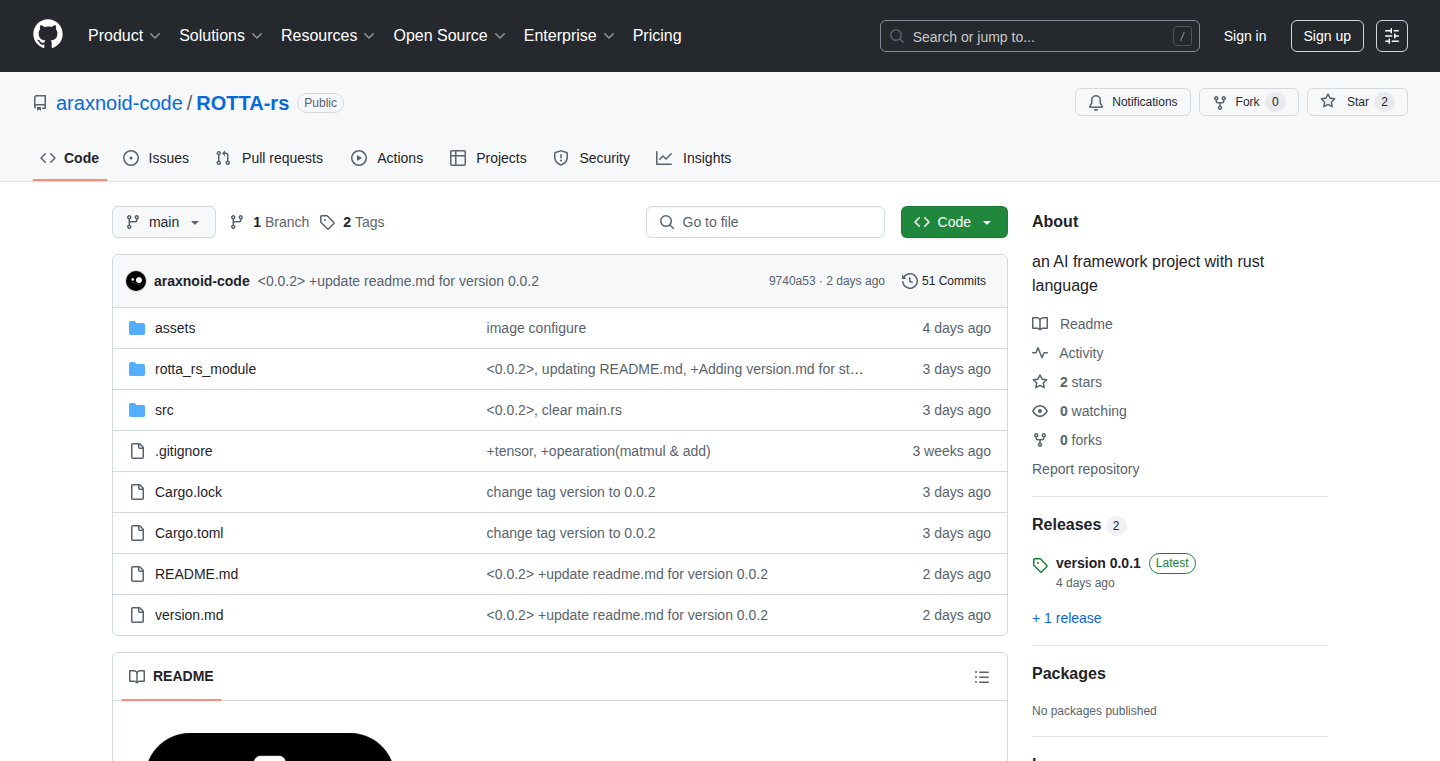
Author
araxnoid
Description
Rotta-Rs is a deep learning framework written in Rust, specifically designed to make building machine learning models simpler. While still in its early stages (version 0.0.2), and therefore potentially buggy, it prioritizes ease of use in model creation. It tackles the complexity often associated with deep learning by using the power of Rust to create a streamlined experience. So, this simplifies the process of building AI models.
Popularity
Points 2
Comments 0
What is this product?
Rotta-Rs is a tool that allows developers to build artificial intelligence models, focusing on making the process as straightforward as possible. It's built using Rust, a programming language known for its speed and safety. The innovation lies in its simplified approach to deep learning model construction, aiming to reduce the complexities often encountered with other frameworks. Instead of wrestling with intricate code, developers can potentially build models with less friction, thanks to the structure provided by Rust.
How to use it?
Developers can use Rotta-Rs by integrating it into their Rust projects. This could involve defining model architectures, training the models with data, and using the trained models to make predictions. Think of it like using LEGO bricks. Instead of designing each brick from scratch, you're provided with pre-made components (the framework) that you assemble (the model) to build something new. So, if you are a Rust developer wanting to experiment with AI, this is a tool that could get you started quickly.
Product Core Function
· {"applicationScenario":"Building custom image recognition models, text classification systems, or predicting stock prices.","functionName":"Model Definition","technicalValue":"Simplicity in specifying network topology, reducing boilerplate and promoting faster iteration.","description":"Allows developers to define the structure (architecture) of their neural networks. The goal is to make it easier to specify layers, connections, and activation functions. For example, you could specify a simple model with input layers, hidden layers, and an output layer. So, this lets you easily define the 'blueprint' of your AI model."}
· {"applicationScenario":"Training an AI model to recognize handwritten digits, analyze customer sentiment, or personalize product recommendations.","functionName":"Training with Data","technicalValue":"Abstracts away low-level details of training, making it simpler to experiment with different datasets and algorithms.","description":"Facilitates the process of training a model with data. This includes the steps of feeding data into the network, calculating errors, and adjusting the model's parameters to improve its performance. So, this helps your AI model learn from data."}
Product Usage Case
· {"soWhat":"So, you can prototype AI solutions faster, whether its image classification or any other task.","solution":"Using Rotta-Rs, the developer defines a convolutional neural network (CNN) architecture to process the image data. They then load a dataset of flower images, train the model using the framework, and test its accuracy. This allows them to quickly experiment with different model configurations and data augmentations to achieve the desired performance.","scenario":"A developer wants to create a model that recognizes different types of flowers from images.","technicalBenefit":"Reduced the time and effort required to set up and train the model, allowing faster experimentation."}
· {"soWhat":"So, you could build and evaluate models quickly, enabling data-driven decisions.","solution":"They use Rotta-Rs to define a simple neural network with input features representing customer behavior. After that, the developer trains this model on historical customer data. This can get the user a preliminary model faster that can be further refined.","scenario":"A researcher wants to quickly prototype a model to predict customer churn.","technicalBenefit":"Enables faster iteration and testing of different model configurations."}
49
QuizGenius: An AI-Powered SRS Quiz Generator
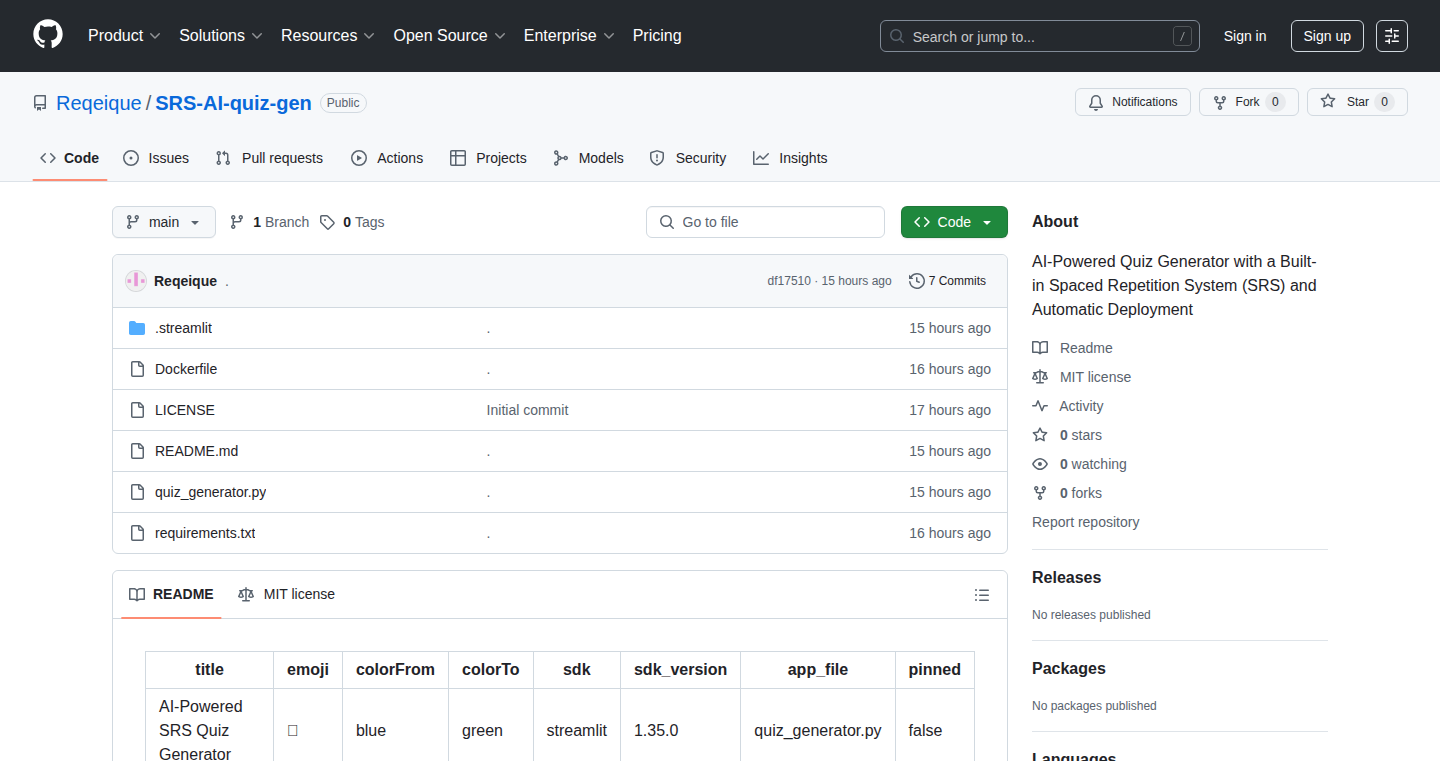
Author
Reqeique
Description
QuizGenius leverages the power of Artificial Intelligence to automatically generate quizzes from any text input and integrates with Spaced Repetition Systems (SRS) for optimized learning. It addresses the common problem of tedious quiz creation and manual flashcard generation, streamlining the learning process and boosting knowledge retention. The innovation lies in its automated generation of quizzes, its seamless SRS integration, and its one-click deployment for easy sharing.
Popularity
Points 1
Comments 1
What is this product?
QuizGenius is an AI-powered tool that turns any text (articles, notes, books, etc.) into quizzes. It uses Natural Language Processing (NLP) to understand the text and create questions, and then formats these questions for SRS like Anki. This is like having a smart assistant that creates flashcards for you automatically. So, it solves the time-consuming problem of manual quiz and flashcard creation. It offers a way to learn and remember information more effectively.
How to use it?
Developers can feed text into QuizGenius through its API or integrated web interface. They can then export the generated quizzes into a format compatible with their preferred SRS platform. This can be useful for building educational apps, personalized learning platforms, or even tools for studying technical documentation. Imagine automatically generating quizzes from your technical blog posts to improve your readers' understanding. This allows developers to focus on other tasks, such as creating educational content or improving the interface rather than creating quizzes manually. By using it, you can save time and focus on the value of your content rather than the task of creating quizzes.
Product Core Function
· {"functionName":"AI-Powered Quiz Generation","description":"This core function uses advanced AI models to understand the text and generate different question types: multiple-choice, fill-in-the-blanks, and true/false. The AI also attempts to generate distractors that are plausible but incorrect. This is the brains behind the operation. So, it saves you from manually thinking up questions; the AI does it for you. You don't need to spend hours coming up with questions to test yourself or your students.","value":"Saves time and effort in creating quizzes, enables efficient content consumption and knowledge testing."}
· {"functionName":"SRS Integration (Spaced Repetition System)","description":"QuizGenius generates quizzes compatible with popular SRS platforms like Anki. SRS is a learning technique that uses spaced repetition to help users memorize information effectively. This means you see the questions at intervals determined by how well you've learned them. This function makes the quizzes optimized for memory retention. So, it helps you learn things faster and remember them longer. This allows you to review what you've learned at the perfect time for maximum retention.","value":"Maximizes learning efficiency and knowledge retention through intelligent scheduling and review."}
· {"functionName":"One-Click Web Deployment","description":"QuizGenius offers a one-click deployment feature, meaning you can easily share the quizzes via a web link. This functionality helps in sharing the quizzes instantly, making it incredibly easy to deploy and share quizzes with others. So, it simplifies the sharing process, eliminating the need for complex setups to make the quizzes accessible to others. You can quickly share your quizzes with others in a very convenient way and gather valuable feedback.","value":"Simplifies quiz sharing and collaboration, increasing accessibility and user engagement."}
Product Usage Case
· {"scenario":"Educational App Development","description":"A developer building an educational app can use QuizGenius to automatically generate quizzes for any subject matter. They can input textbooks, lecture notes, or other educational materials and instantly create interactive quizzes for their users. So, it automates the process of creating educational content. This helps make the app more engaging and efficient. In other words, you can quickly add quizzes to your educational content and focus on building a great user experience."}
· {"scenario":"Technical Documentation Testing","description":"A technical writer could use QuizGenius to create quizzes from their documentation to ensure readers understand the concepts presented. By providing self-assessment quizzes, developers can make sure that their documentation helps their target audience and identifies any gaps in their understanding. So, you can ensure that readers comprehend complex technical concepts. This ensures that your audience understands your documentation and quickly finds the information they need.","value":"Improves documentation comprehension and user engagement."}
· {"scenario":"Personal Study Aid","description":"Students can use QuizGenius to create flashcards and quizzes from their lecture notes or textbooks. This allows them to quickly generate study materials and improve their knowledge retention. So, this simplifies the study process and allows for better learning. You can spend less time creating study materials and more time studying."}
50
AD-Assess: Active Directory Security Assessment Tool
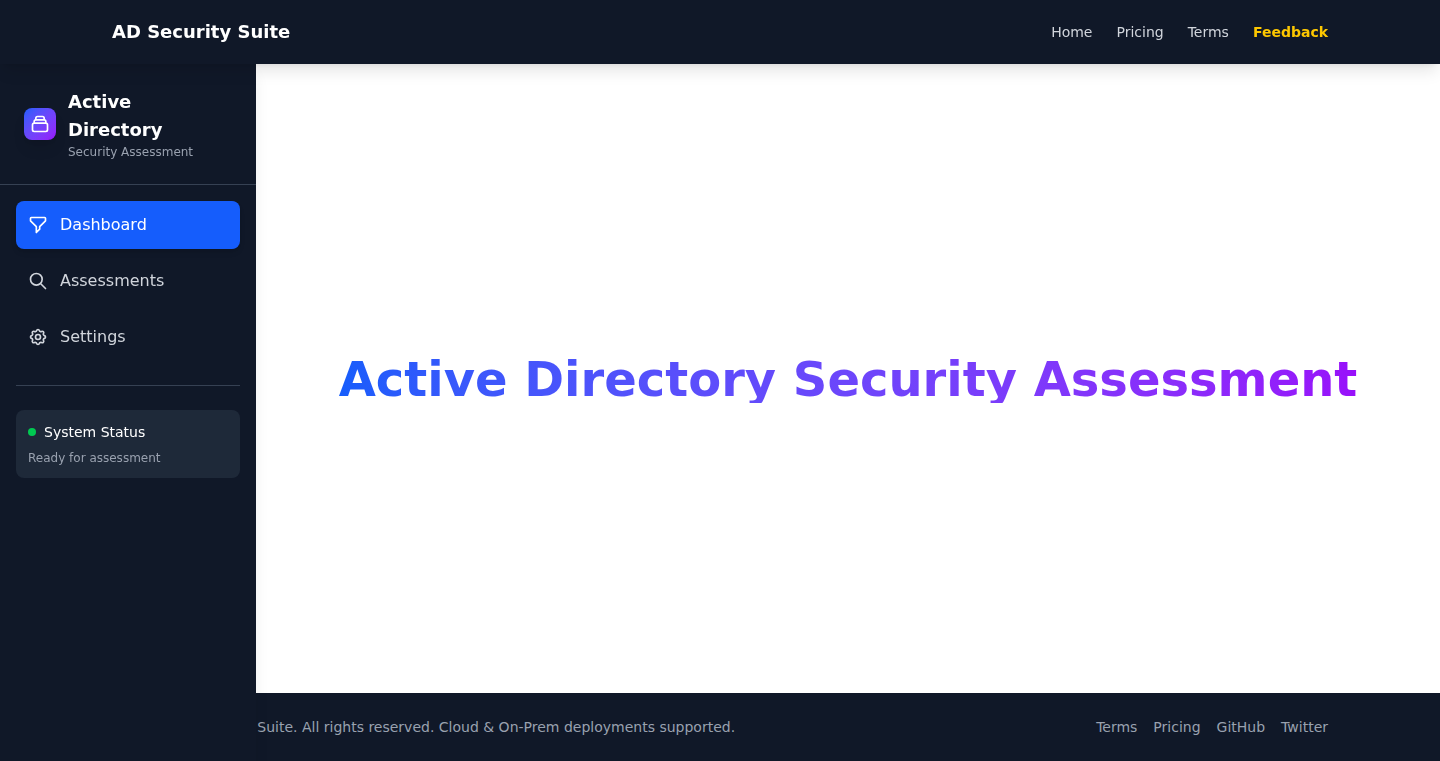
Author
Shazeb
Description
AD-Assess is a weekend project created by a penetration tester to simplify Active Directory (AD) security assessments. It offers a user-friendly interface and automates common tasks like password spraying, user enumeration, SMB scanning, and Kerberoasting. The core innovation lies in its ability to streamline complex security tasks, making them accessible even to users without extensive technical expertise. This tool aims to identify common vulnerabilities and provide actionable insights for improving AD security, ultimately saving time and effort for security professionals.
Popularity
Points 2
Comments 0
What is this product?
AD-Assess is a tool built for evaluating the security of Active Directory environments. Think of Active Directory as the central control system for many companies’ computers and networks. The tool automates tasks that are usually done manually by security experts, like checking for weak passwords (password spraying), finding all the users (user enumeration), checking for shared folders (SMB scan), and looking for ways to steal secret credentials (Kerberoasting). The innovation is to provide a simple interface for these complex tasks. This helps security teams and even people without deep technical knowledge to quickly identify weaknesses in their systems.
How to use it?
Developers can use AD-Assess by running it against their Active Directory domain. They'll likely need to provide credentials and point the tool at the domain controller. The tool then performs a series of automated checks, generating reports that highlight security issues. Users might integrate this tool into their existing security testing workflows or use it as a standalone solution for regular security audits. For example, you might run it weekly to monitor changes or immediately after making security changes to quickly verify if those changes improved security.
Product Core Function
· {"techExplanation":"Attempts to log in with common passwords across many user accounts to find compromised ones.","application":"Security audits, penetration testing, and continuous security monitoring.","function":"Password Spraying","value":"Helps identify users with weak passwords, which attackers can exploit. So this is useful for proactively identifying and addressing a significant security risk."}
· {"techExplanation":"Lists all user accounts within the Active Directory domain.","application":"Assessing user account management, identifying orphaned accounts, and preparing for social engineering attacks.","function":"User Enumeration","value":"Reveals the attack surface – what accounts an attacker might target. So this is useful to know which user accounts exist and where there are potentially inactive accounts that could be a risk."}
· {"techExplanation":"Scans for open SMB shares, which are shared folders that may be accessible on the network.","application":"Identifying vulnerabilities in file sharing configurations, assessing data exposure risk, and performing network security audits.","function":"SMB Scan","value":"Identifies potential data leaks and unauthorized access to sensitive information. So you can quickly find if sensitive company data is easily accessible."}
· {"techExplanation":"Exploits Kerberos authentication to extract password hashes of service accounts.","application":"Identifying weaknesses in service account security and assessing the overall risk of credential compromise.","function":"Kerberoasting","value":"Helps find weak passwords used by services, which can lead to complete network compromise. So this helps you proactively find service accounts that are vulnerable to attack."}
· {"techExplanation":"Lists actively logged in users and computers connected to the domain.","application":"Real-time monitoring, incident response, and identifying compromised systems.","function":"Active Users & Computers","value":"Provides an up-to-the-minute view of your network and active endpoints. So this is useful for detecting unusual activities or potential intrusions"}
Product Usage Case
· {"benefits":"Saves time by automating the assessment, and prevents potential security breaches.","scenario":"A security engineer runs AD-Assess after a major infrastructure upgrade.","problemSolved":"Quickly identifies misconfigurations in the new environment, such as unintended SMB shares that expose sensitive data, or accounts with weak passwords. So, the engineer avoids an attack by ensuring new changes didn't inadvertently weaken security."}
· {"benefits":"Improves the efficiency and effectiveness of penetration testing by identifying low-hanging vulnerabilities quickly.","scenario":"A penetration tester uses AD-Assess during a security audit.","problemSolved":"Automates time-consuming tasks such as password spraying and Kerberoasting, allowing the tester to focus on more complex attack vectors. So, the tester gets a more comprehensive picture of the attack surface faster."}
51
Worldnews24.tv: A Multi-Perspective News Stream Aggregator

Author
departed
Description
Worldnews24.tv is a website that aggregates news streams from a diverse range of sources across the globe, offering 24/7 access to different viewpoints on world events. The core innovation lies in its automated aggregation of live streams, particularly from YouTube and HLS (HTTP Live Streaming) channels, providing a unique perspective on global news consumption. It addresses the challenge of information silos and promotes critical thinking by exposing users to various perspectives, especially in a world increasingly dominated by echo chambers. It redirects users to a random channel upon opening the site, encouraging exposure to varied viewpoints. The core technological challenge is continuous stream monitoring to check if a Youtube/HLS stream has ended.
Popularity
Points 2
Comments 0
What is this product?
This project is a live news aggregator, constantly pulling content from news sources worldwide. It's like having a global TV, but instead of choosing just one channel, you get access to many, all the time. The innovative part is how it automatically collects these live streams, making it easy to switch between different perspectives. It tackles the problem of getting trapped in a single viewpoint, offering a wider understanding of global events by aggregating diverse sources. The site uses technology to fetch and display these streams in a single interface, which can automatically redirect users to different channels each time the site is opened to promote discovery of different viewpoints. The innovative technology behind the scenes is in constant live stream monitoring, which keeps the project up to date.
How to use it?
You can simply visit the Worldnews24.tv website to start watching. Each time you visit, you're randomly directed to a different news channel, forcing you to explore content from different regions and perspectives. This encourages you to step outside your comfort zone and engage with a broader range of news sources. The website acts as a central hub to access various live streams, offering a simple interface to consume news from diverse channels. The website also includes a bookmarking feature allowing you to return to specific sources. So, it's very simple to use and offers a fresh news experience.
Product Core Function
· {"name":"Automated Stream Aggregation","description":"The core function is automatically finding and integrating live news streams from various sources. This involves identifying channels, fetching the streams, and displaying them within a single interface. This feature simplifies the process of accessing global news, providing a single source to view events from many different viewpoints. \n\n**So this is useful for you because:** It saves you the time and effort of manually searching for and switching between different news sources. It automatically brings the world’s news to you.","technicalInsight":"The project likely uses web scraping techniques (gathering content from websites) to identify live stream sources, and technologies like HTML, CSS, and Javascript to present the live video streams."}
· {"name":"Random Channel Redirect","description":"The website redirects users to a different channel upon each visit, encouraging exposure to various perspectives. This feature is intended to break users out of their existing news bubbles and force them to explore alternative viewpoints. This feature helps facilitate exposure to perspectives that users may not usually encounter, and encourages a more balanced understanding of the world.\n\n**So this is useful for you because:** It helps prevent you from getting stuck in an echo chamber of the news you agree with. You are randomly exposed to different perspectives, expanding your awareness.","technicalInsight":"Implemented with JavaScript, this functionality likely uses the `location.href` or similar methods to randomly select and redirect the user to a different stream URL upon page load or refresh."}
· {"name":"Continuous Stream Monitoring","description":"The project's author is looking for advice on how to monitor and detect the end of YouTube/HLS streams. The ability to actively monitor if a news stream is still live and to switch streams when one ends is a crucial part of ensuring that the news aggregator functions properly and provides a continuously available experience for users. This provides a continuous viewing experience, ensuring that users are always watching live content and are never left with a broken or non-functional channel. \n\n**So this is useful for you because:** You get a smooth news viewing experience. The system is designed to ensure that streams are always active and available.","technicalInsight":"This likely involves periodically checking the stream for activity using the HLS protocol, and for YouTube streams, monitoring of API and stream status."}
· {"name":"Diverse Source Integration","description":"The project aggregates news streams from various regions. This approach provides a broader understanding of global events by aggregating diverse sources. This allows the user to have access to varied viewpoints.\n\n**So this is useful for you because:** It helps you view information from many different perspectives.","technicalInsight":"The project uses techniques to discover news sources from all around the globe."}
Product Usage Case
· {"scenario":"During a major international conflict","description":"A user can visit Worldnews24.tv and immediately access live news coverage from various countries involved, including their state media outlets. By switching between these different perspectives, the user can get a deeper understanding of how the event is being framed and interpreted by different cultures and governments, compared to any single source of information. They can also use the bookmarking functionality to save sources for comparison.","technicalProblemSolved":"The project avoids the challenges associated with the information silo of consuming only one type of news, and makes accessing different viewpoints very easy."}
· {"scenario":"Monitoring and understanding global economic trends","description":"A financial analyst can use Worldnews24.tv to monitor live news feeds from different financial sectors. They can stay updated on global financial news, identify trends, and assess how different regions are reacting to the same financial events. They can then compare the analysis provided on different streams and see how certain financial markets are reported by different channels.","technicalProblemSolved":"It allows easy access to information from different financial sectors, increasing access to various information that might not be easily available."}
52
Witmo: In-Game AI Coach - Screenshot Analysis for Elden Ring & Beyond

Author
myyke
Description
Witmo is an open-source, terminal-based tool that acts as your in-game AI coach. It analyzes screenshots from your gameplay, providing contextual advice using the power of AI models like OpenAI. It's designed to answer your in-game questions without the hassle of typing long prompts or repeatedly searching. Essentially, it automates the process of getting help in games by understanding what you're seeing on screen. This is a practical solution for gamers struggling with puzzles or needing quick information, improving gameplay by reducing interruptions. So, if you're stuck in a game, Witmo can help!
Popularity
Points 1
Comments 0
What is this product?
Witmo works by connecting to your Android phone (via USB and adb) to capture screenshots of your game. It then sends those screenshots to an AI model (like OpenAI's) for analysis. The AI interprets the image, identifies what's happening in the game, and provides advice based on a pre-defined prompt (which could be about a specific area, a boss fight, or anything else). It’s like having a smart walkthrough that understands what YOU are doing in REAL-TIME.
Key technical innovations include:
* **Automated Screenshot Capture:** Seamlessly grabs screenshots from your Android phone. So what? This removes the manual step of taking and uploading screenshots, allowing for a faster and more streamlined process.
* **Image Analysis with AI:** Uses AI to understand what’s happening in your game based on visual input. So what? Enables Witmo to give specific advice that is relevant to your exact situation, making it way more helpful than a general walkthrough.
* **Contextual Advice:** Presents advice based on the in-game situation and your defined prompts. So what? Delivers the right information at the right time, enhancing your in-game learning and problem-solving capability.
How to use it?
Developers use Witmo by cloning the project from GitHub and following the installation instructions (which involve installing Python and necessary libraries). Once installed, you connect your Android phone to your computer, start the game, and use Witmo to analyze screenshots. You choose or create prompts that define what kind of advice you need. The advice appears directly in your terminal, providing you with information without leaving your game.
Integration is simple. Essentially, you set up Witmo and then focus on playing the game while the tool helps you out. It doesn't require any modification to the game itself. So what? This means it's easy to use, and it doesn’t affect your game. You can use it with any game that runs on your Android and has visual elements.
Product Core Function
· {"applicationScenario":"When playing games on Android, Witmo saves time by not requiring the player to manually take screenshots and upload them to the AI or enter a prompt.","soWhat":"This is useful because you no longer have to switch between the game and another device or service to get help.","technicalValue":"This streamlines the entire process of getting in-game assistance, removing manual steps and improving efficiency. It utilizes ADB (Android Debug Bridge) for direct communication with the Android device and integrates with image processing libraries.","name":"Screenshot Capture & Processing","description":"Automatically captures screenshots from your Android device and pre-processes them for AI analysis (e.g., image cropping)."}
· {"applicationScenario":"Help players navigate levels, identify enemies, or solve puzzles in real-time.","soWhat":"This is how you get smart, tailored advice about your game, so you don't have to do all the work yourself.","technicalValue":"The core of Witmo, which provides the intelligence. The use of these models enables Witmo to accurately interpret visual game data and provide relevant advice. It leverages prompt engineering to obtain specific information needed by the user.","name":"AI-Powered Image Analysis","description":"Uses AI models (like those from OpenAI) to analyze the captured images and understand the current in-game situation."}
· {"applicationScenario":"Provides real-time solutions and guidance in games. For example, identifying the best strategy for a boss fight or the location of a key item.","soWhat":"Helps you understand your game and make the most of it, so you can focus on having fun.","technicalValue":"It takes AI's interpretation and combines it with user-defined parameters to produce helpful, specific advice. This allows for a personalized and adaptive user experience that caters to individual needs and preferences.","name":"Contextual Advice Generation","description":"Generates in-game advice based on the AI's analysis, incorporating user-defined prompts and preferences."}
· {"applicationScenario":"Displays game information in a non-intrusive way.","soWhat":"So you can get help without ruining your immersion in the game.","technicalValue":"It is focused on accessibility and ease of use. This allows the user to receive information without leaving their main focus - the game.","name":"Terminal-Based User Interface","description":"Presents advice directly in the terminal window, minimizing disruptions to the gameplay."}
Product Usage Case
· {"scenario":"Elden Ring Gameplay","technicalSolution":"It would use AI to find key details in the screenshot. Using this AI understanding along with the user prompt, Witmo could provide the most relevant and valuable game advice.","description":"When a player is in a new area, Witmo can take a screenshot, analyze the surroundings, and give clues on the next steps, possible enemies, or hidden items based on a preset prompt.","value":"Players can get helpful information without needing to search the internet, which helps them keep playing without needing to pause the game to find out the next thing to do, which improves the gameplay experience."}
· {"scenario":"Puzzle Solving in a Strategy Game","technicalSolution":"It would analyze the positions of pieces on a board game and determine which pieces are important and useful.","description":"If a player is stuck on a puzzle, Witmo can analyze the game board, identify the pieces, and provide suggestions for the next move based on the player's prompt.","value":"By taking the thinking out of problem solving, the player can get answers to questions quickly, allowing them to improve their skill in the game."}
53
UserPath: Cursor-based User Behavior Analytics

Author
stewones
Description
UserPath provides a novel approach to user behavior analytics by focusing on the user's cursor movements. Instead of relying solely on traditional clickstream data, it analyzes cursor paths, dwell times, and other cursor-related events to understand how users interact with a website or application. This innovative approach uncovers subtle interaction patterns that might be missed by standard analytics tools. It tackles the problem of gaining deeper insights into user engagement and usability issues by leveraging the user's direct interaction as indicated by their mouse or touch inputs.
Popularity
Points 1
Comments 0
What is this product?
UserPath is like a 'microscope' for user behavior. Instead of just seeing where people click, it observes how they *move* their cursor. Imagine tracking where you point your finger before clicking a button. UserPath captures similar data for your website. This means analyzing cursor trajectories, how long the cursor lingers on specific elements, and the velocity of cursor movements. This is a significant innovation because it provides a much richer understanding of user intent and attention compared to standard analytics that primarily focuses on clicks and page views. So, the technical innovation is the focus on the user's cursor actions to get more detailed user experience data.
How to use it?
Developers can integrate UserPath into their websites or applications using a simple JavaScript snippet. Once implemented, it starts tracking cursor movements. The tracked data is then processed and visualized in a dashboard, showing users' 'paths' across the website and providing metrics like dwell time on elements. Think of it like adding a new layer of data to your existing analytics setup. You might embed the tracking code into your website and then access a dashboard to analyze user behavior. This can be done by simply adding some JavaScript code to your webpage. So this is really useful for web developers who want to know how users interact with their sites, to improve usability and design.
Product Core Function
· {"techImplementationValue":"Captures x,y coordinates over time to reconstruct the user's cursor movement path. The value lies in revealing user browsing patterns and attention, highlighting areas of interest and potential usability pain points. So this feature allows you to visualize how users navigate your website, helping you understand what they see and what they ignore.","functionName":"Cursor Path Tracking","description":"Records the precise path of the user's cursor on the screen. This allows for visualizing the user's navigation and focus areas."}
· {"techImplementationValue":"This is achieved by timing how long the cursor hovers over specific elements (like buttons, text blocks, images). This helps to infer user engagement. So this is great for identifying potential problems on your website, like a button that people linger on because they don't understand it.","functionName":"Dwell Time Analysis","description":"Measures the time the cursor spends over specific elements on the page. This can indicate user interest or areas where users might be struggling."}
· {"techImplementationValue":"This is the ability to link a click to the preceding cursor movement. For example, you can correlate a click with the user's path to see how they arrived at that point, revealing user intent. So this feature helps you better understand what users are trying to do on your website, connecting their actions to their thought process.","functionName":"Click and Action Correlation","description":"Correlates cursor movements with clicks and other user actions, providing context to user interactions."}
· {"techImplementationValue":"Uses a color gradient (e.g., red for high-dwell time, blue for low) to visually represent cursor activity on a webpage, so you can spot which areas of your site get the most attention. This helps you find the important parts and potential problems on your pages. So, you can visually see which parts of your website are grabbing the user's attention, making it easy to prioritize design improvements.","functionName":"Heatmap Visualization","description":"Provides heatmaps visualizing areas where the cursor spends the most time, giving a visual representation of user attention."}
Product Usage Case
· {"scenario":"E-commerce Website Optimization","description":"By analyzing cursor paths, a developer can identify areas on a product page where users spend a lot of time before clicking 'add to cart'. This suggests potential confusion or areas needing clearer information (e.g. on the product details).","technicalBenefit":"Identifying points of friction, such as complex descriptions that need simplification or a poorly placed call to action. So, by seeing where users are hesitating, you can streamline the purchase process."}
· {"scenario":"Usability Testing and UI/UX Improvement","description":"Developers can use UserPath to conduct A/B testing on different website layouts. By comparing cursor behavior between variations, they can determine which design leads to better user engagement and a more intuitive user experience.","technicalBenefit":"This is the ability to directly measure the impact of UI changes by tracking user focus and interaction patterns. So, you can know what version of your website's design attracts more attention, helping in better UI and UX decisions."}
· {"scenario":"Content Optimization and Readability Analysis","description":"The tool can pinpoint areas of a webpage with high dwell times, indicating parts of the content that users are actively reading or struggling with. This allows for better content structuring and optimization.","technicalBenefit":"Analyzing dwell times on text to optimize content structure and language used to make it more engaging. So, you can improve the clarity of your content by identifying and resolving areas of confusion."}
54
FixO Dev: Instant AI-Powered GitHub Code Fixes
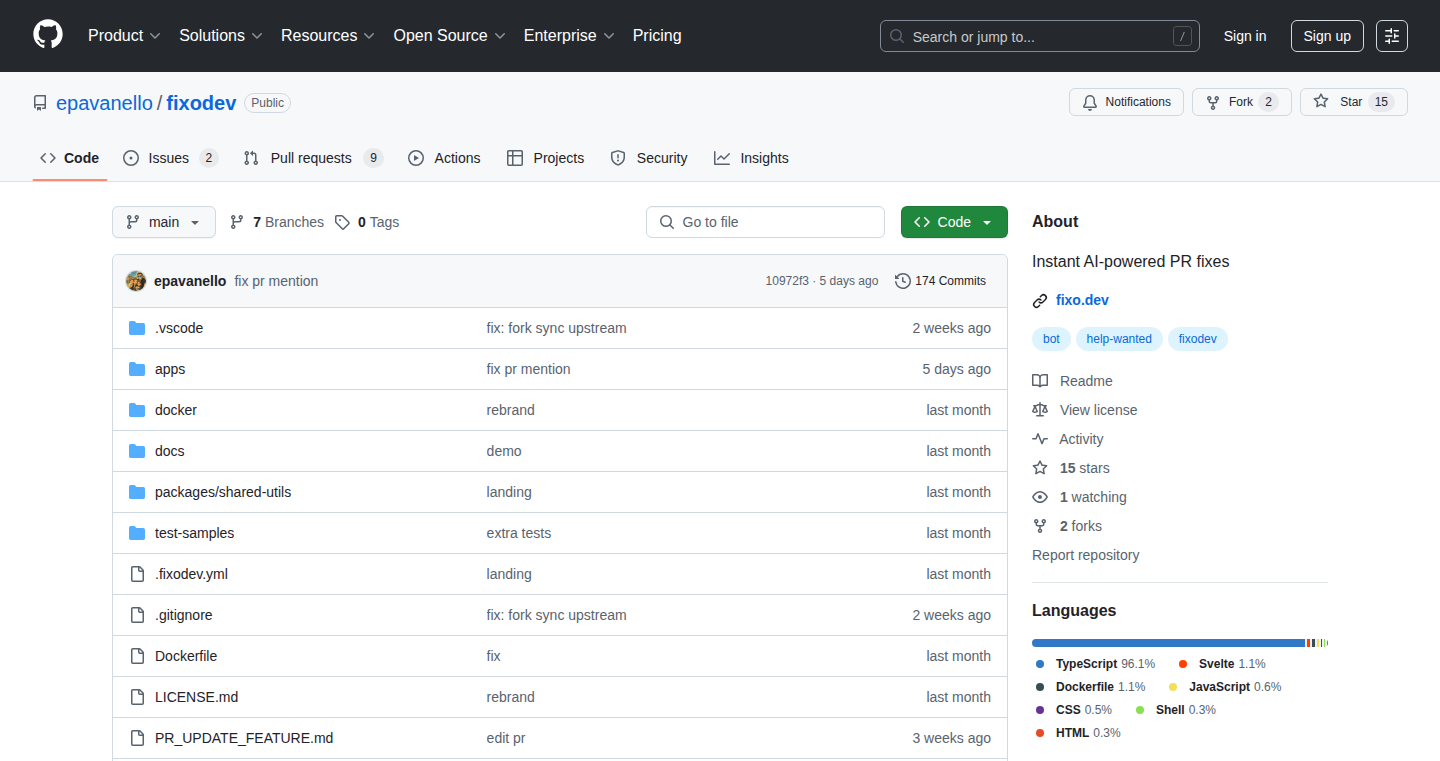
Author
emadev
Description
FixO Dev is an open-source agent that instantly transforms GitHub issues into high-quality pull requests. It leverages AI to automatically fix code issues directly within GitHub, enabling developers to resolve problems quickly and efficiently, even on mobile devices. This project offers a streamlined solution for addressing code improvements and maintaining code quality, removing the need for developers to switch between tools and providing a more agile development process.
Popularity
Points 1
Comments 0
What is this product?
FixO Dev is like having an AI assistant integrated directly into your GitHub workflow. When you mention @fixodev in a GitHub issue or pull request comment, it analyzes the problem and generates a pull request with a proposed fix. The core technology uses AI to understand the issue, generate the correct code, and ensure it integrates well with the existing codebase. This removes the friction from fixing small bugs and lets developers focus on more complex tasks.
**So what does this mean?** It means you can fix bugs and improve code with a simple mention, saving you time and effort. For instance, if someone reports a bug in your code, you can use your phone to command FixO Dev to fix it instantly.
How to use it?
To use FixO Dev, simply mention `@fixodev` within a GitHub issue or pull request comment. The agent will then automatically analyze the issue and generate a pull request with the suggested code changes. Developers can then review, merge, or further refine the generated changes. The AI supports multiple programming languages, including JavaScript, TypeScript, and Python. You can integrate it into your workflow, whether you work on open-source projects or in a corporate environment.
**How it works in practice?** Imagine you are reviewing a pull request on your phone. You notice a small coding error. With FixO Dev, you can mention the bot and generate a fix in a matter of seconds! You can then review the suggested changes directly from your phone.
Product Core Function
· {"useCase":"A developer is reviewing a pull request and identifies a small bug. Instead of manually fixing the error, the developer mentions @fixodev in the comment, which generates a fix. The developer reviews the generated code and merges it, all within minutes.","functionName":"Automated Code Fix Generation","description":"FixO Dev automatically generates code fixes for issues reported on GitHub. This is achieved by leveraging AI to analyze the issue description and generate code. The generated fixes are presented as pull requests, streamlining the development process. \n\n**Why is this valuable?** This saves you the time and effort of manually writing code fixes, allowing you to focus on other important aspects of your project. If you're working on-the-go, you can fix bugs directly from your phone."}
· {"useCase":"A developer uses JavaScript for a web project and Python for backend scripts. FixO Dev can seamlessly handle fixes in both languages, maintaining code quality across the entire project.","functionName":"Multi-Language Support","description":"FixO Dev supports multiple programming languages, including JavaScript, TypeScript, and Python. This broadens the applicability of the tool and makes it useful for projects using diverse tech stacks. \n\n**Why is this useful?** It allows you to fix code issues in different languages without learning a new tool or workflow."}
· {"useCase":"A company that values security can leverage FixO Dev without worrying about data breaches or code vulnerabilities.","functionName":"Secure and Isolated Execution","description":"FixO Dev executes its code fixes within a secure, isolated environment using Docker. This ensures the security of your code, preventing sensitive data from being exposed, and maintaining the integrity of the codebase. The tool does not retain any data. \n\n**Why is this important?** This provides a secure and reliable way to automatically fix code without compromising your project's security."}
Product Usage Case
· {"scenario":"On-the-Go Code Fixes","description":"A developer is away from their primary workstation but identifies a bug in a project on GitHub. Using their phone, they mention @fixodev in the relevant issue. The agent generates a fix, which the developer can review and merge, all within minutes. \n\n**So what's the value?** This reduces the time it takes to address bugs and keeps development moving forward, even when you don’t have access to your development environment."}
· {"scenario":"Automating Repetitive Code Improvements","description":"A development team frequently encounters minor, repetitive code issues such as style violations or simple bugs. By integrating FixO Dev into their workflow, the team can automate these fixes, improving code quality and reducing the workload of manual fixes. \n\n**Why is this useful?** You can automate some tasks which are boring. By automating repetitive code improvements, the team can maintain high-quality codebases on the fly. This leads to faster iterations and fewer headaches from constant code clean-ups."}
55
GrugTranslate: Website Translation for the Primitive Brain
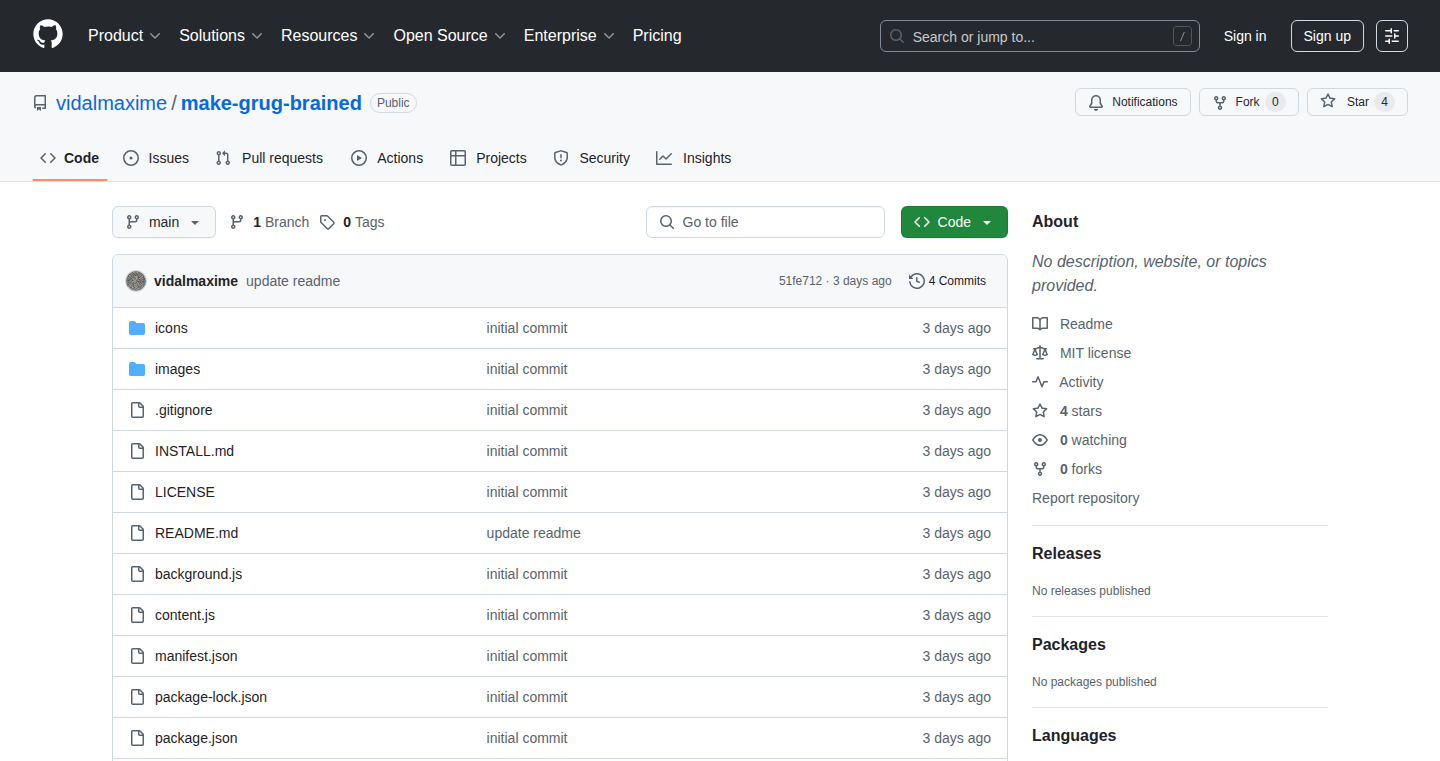
Author
vmax1
Description
GrugTranslate tackles the problem of website localization in a ridiculously simple way. Instead of complex, server-side translation systems, it provides a single JavaScript snippet that, when injected into a webpage, uses the power of Google Translate to dynamically translate the page in your browser. This removes the need for developers to manage language files, translation APIs, or server-side configurations. The innovation lies in its simplicity and immediate applicability – it offers instant website translation without requiring any code changes on the original website.
Popularity
Points 1
Comments 0
What is this product?
GrugTranslate is a client-side website translator. It works by injecting a small piece of JavaScript into a webpage. This JavaScript uses Google Translate to instantly convert the text on the page to a language you choose. The clever part? It happens entirely within your browser. It's like a magical overlay that translates things as you read them. The main technical innovation is its reliance on client-side processing, avoiding server-side complexity, and its easy integration - just copy and paste a line of code.
How to use it?
Developers can use GrugTranslate to instantly make their websites accessible to a broader audience. By adding a single script tag, they can offer basic, automatic translation without the usual development overhead. You can add the script to the page’s `<head>` section or use a browser extension manager like Tampermonkey. It is particularly useful for prototyping, testing multi-language support, or providing a quick and dirty translation for internal tools or documentation. So, if you need a fast way to reach international users without the hassle, this is it.
Product Core Function
· {"useCase":"Quickly testing a multi-language site's appearance or providing basic multilingual support for a prototype website.","functionName":"Client-Side Translation","technicalValue":"Reduces server load and simplifies deployment by eliminating server-side translation logic. Offers immediate value to users without waiting for a full server deployment.","description":"This is the core functionality. The script dynamically translates the webpage using Google Translate API, directly within the user's browser. This avoids the need for server-side translation. So, this makes your site instantly accessible to a wider audience without any backend work."}
· {"useCase":"Rapid prototyping for a multilingual website or adding temporary translation capabilities to a static site.","functionName":"Easy Integration with a Single Script Tag","technicalValue":"Streamlines the translation process, making it easy to implement without requiring a specialized skill set or extended setup time.","description":"The entire system operates with a single line of JavaScript, making integration incredibly straightforward. Just paste the script into the HTML of your webpage. So, no complicated setup or configuration is necessary."}
Product Usage Case
· {"scenario":"A developer building a personal blog wants to make it accessible to a wider international audience but lacks the resources for comprehensive localization.","technicalSolution":"By adding the GrugTranslate script, they can instantly provide auto-translation, enabling readers to understand the content in their preferred language. This expands the reach of the blog with minimal effort.","value":"The blog gains wider reach without significant effort, enabling international readers to consume content. This expands the author's audience and potentially increases engagement and influence."}
· {"scenario":"A team working on internal documentation wants a quick way for international team members to understand the content.","technicalSolution":"The developers inject the GrugTranslate script into the HTML files of the documentation website. This immediately allows all team members to view the documentation in their language. So, it promotes clear communication and collaboration across different language capabilities.","value":"Team members can easily understand documentation and collaborate more effectively, resulting in increased productivity and less confusion."}
56
Image Radio: Visuals to Melodies with Lyria

Author
devvalladares
Description
Image Radio is a project that transforms images into music, leveraging Google's Lyria model, a cutting-edge image-to-music translator. It lets you 'listen' to images, creating musical interpretations based on the visual content. It addresses the creative problem of bridging the gap between visual and auditory experiences, enabling a novel form of artistic expression. So this is a new way to experience art and potentially create music.
Popularity
Points 1
Comments 0
What is this product?
Image Radio uses Lyria, a machine learning model trained to analyze images and generate corresponding music. The model identifies features within an image – colors, shapes, compositions – and translates these visual elements into musical parameters like melody, harmony, and rhythm. This approach allows for an innovative form of artistic creation and exploration, turning static images into dynamic audio experiences. So this is a tool that makes art in a new way, using artificial intelligence.
How to use it?
Users can provide any image – from a personal photo to a piece of art – and Image Radio will generate a musical piece based on its visual data. The output can be listened to directly, integrated into other creative projects, or used as a source of inspiration. Developers can potentially integrate the Lyria model into their applications through APIs, opening up possibilities for creating interactive visual-audio experiences. So this is very easy to use - you just give it an image, and it does the rest.
Product Core Function
· {"functionName":"Image-to-Music Generation","technicalValue":"Demonstrates the practical application of machine learning in creative fields, specifically music generation based on visual input. Showcases advancements in AI’s ability to interpret and translate visual information into other sensory forms.","description":"The core function is the transformation of any given image into an audio track using the Lyria model. The system analyzes the image’s visual properties and generates a corresponding musical composition. This allows the user to create unique, AI-generated soundtracks for images. So this lets you create music in a unique way - based on pictures."}
· {"functionName":"User-Friendly Interface","technicalValue":"Emphasizes the importance of user experience in making complex technologies accessible to a wider audience. This design choice promotes widespread adoption of the underlying technology.","description":"The project likely features a simple and accessible user interface that allows anyone to upload images and generate music without requiring technical expertise. The interface provides users with a quick and easy way to turn their images into music and experience them in a novel way. So this means anyone can use it easily."}
· {"functionName":"Potential for Customization and Integration","technicalValue":"The project shows the potential of AI to integrate with other technology and allows developers to build their own applications on top of this technology.","description":"The design may include the ability to customize the music generated and provide tools to seamlessly integrate the output into other applications or projects, like videos, presentations or video games. So this gives you more control over the music and allows you to use it in many ways."}
Product Usage Case
· {"useCase":"Music for Art Exhibitions","description":"Artists could use Image Radio to create unique musical accompaniments for their artwork, enhancing the viewer's experience. By generating music based on the visual elements of the artwork, they could create a more immersive and engaging presentation of their work. So this gives artists a new way to add music to their art.","technicalBenefit":"It opens opportunities to use AI to automatically create custom soundtracks that perfectly complement the artwork."}
· {"useCase":"Educational tools for learning art","description":"Students could use the tool to explore the relationship between visual arts and music, fostering a deeper understanding of both disciplines. For example, they could generate audio tracks from famous paintings and analyze the musical output, learning new ways to interpret images. So this helps you learn art and music at the same time!","technicalBenefit":"This can be a great tool for interdisciplinary learning, where students could learn new information based on how the AI model interprets images, and it encourages critical thinking."}
57
Request-Response Replacer: A Framework for Mocking API Interactions
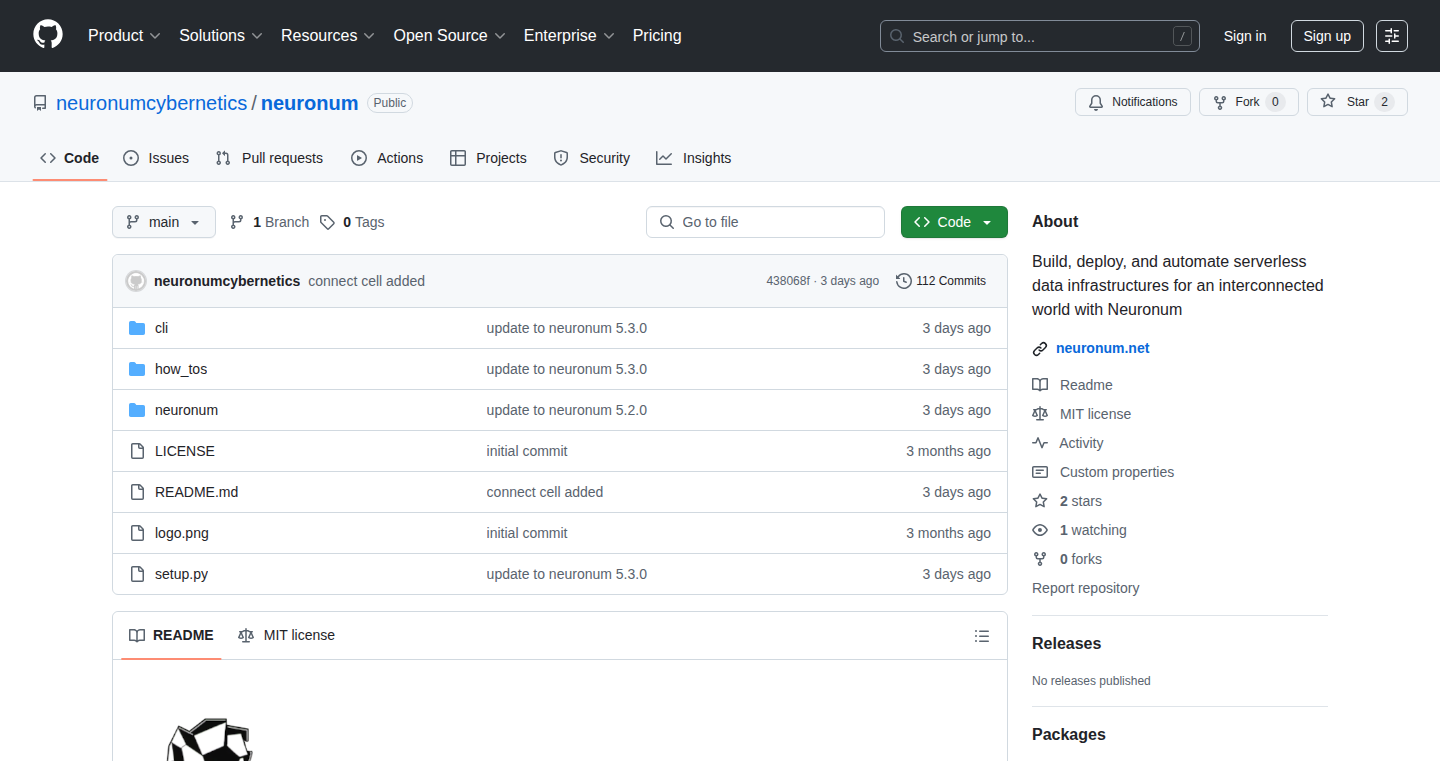
Author
yannisscherer
Description
This project introduces a framework that allows developers to easily mock API requests and responses. It tackles the common problem of needing to test code that relies on external APIs without actually making real API calls. The core innovation lies in its flexible and adaptable architecture, enabling developers to define custom rules for intercepting and replacing HTTP requests with predefined responses. This simplifies testing, speeds up development, and isolates code from external API dependencies.
Popularity
Points 1
Comments 0
What is this product?
This is a tool that lets you pretend to be an API, but in your own code. Imagine you're building a website that uses a weather API. Instead of making actual calls to the weather service every time you test your website, this framework lets you define how your website *should* respond to requests for weather data. This avoids making real API calls (which can cost money or have rate limits) and also allows you to test different scenarios, like what happens if the weather API is temporarily unavailable. The innovation is the ease with which you can define these 'fake' responses, and the way it integrates seamlessly into your existing code, letting you test API integrations without relying on the actual API. So, this is for those developers who want more control and flexibility over how they test integrations.
How to use it?
Developers would integrate this framework into their testing workflows. Imagine your code makes a GET request to `/api/weather`. You would use this framework to specify that, instead of actually making a network request, your code should receive a predefined JSON response containing weather data. The framework intercepts the request, consults the rules you've set up (e.g., based on the URL, request method, headers), and returns the pre-configured response. This can also be used in development, allowing you to quickly prototype different API responses to simulate various edge cases, like error responses or specific data formats. You might define these rules using a configuration file or through code, tailoring the responses to perfectly match your test scenarios. So, you just add a few lines of code to intercept the HTTP requests and replace the real API responses with your own mocked responses.
Product Core Function
· {"functionName":"Request Interception and Replacement","technicalValue":"The main benefit is in creating reliable and repeatable tests. It also improves development speed by eliminating the need to wait for external API responses. So, you can test your code without making actual API calls, making your tests faster, more reliable, and less dependent on external services.","description":"The core functionality: intercepting outgoing HTTP requests and replacing them with pre-configured responses. This utilizes middleware or proxy techniques to intercept traffic and redirect it based on user-defined rules. This allows to easily mock the API responses. For example, if your code requests `/users/123`, the framework might respond with a predefined JSON payload representing user 123, bypassing any real API calls."}
· {"functionName":"Rule-Based Configuration","technicalValue":"This is crucial for flexibility. Developers can simulate complex API behavior, including various error conditions or specific data formats. So, you can simulate different API responses for different scenarios, allowing you to cover all of the test cases you may need.","description":"The framework provides a way to define rules based on different criteria, such as URL paths, request methods (GET, POST, etc.), and headers. These rules dictate how requests are intercepted and which responses are returned. For instance, a rule might specify that all POST requests to `/api/login` return a success message and a specific token, or that any error code should be handled in your code."}
· {"functionName":"Response Customization","technicalValue":"Enables detailed testing of API integrations and edge cases. So, you can mimic different response types, like error messages, to thoroughly test all aspects of API integration.","description":"Allows customizing the response to exactly match the test needs, offering flexibility and control. The framework likely allows defining response codes (e.g., 200 OK, 404 Not Found), headers, and body (e.g., JSON data). Developers can simulate a variety of API behaviors, including success, errors, and even specific data structures. For example, you could mock a failure response if there is a timeout to make your tests more realistic."}
· {"functionName":"Integration with Existing Test Frameworks","technicalValue":"Makes testing easier to implement and use in any existing workflow. So, it fits smoothly in any projects that are already being developed.","description":"Easy integration with established testing frameworks (e.g., Jest, JUnit) and development workflows. Ideally, the framework works with popular testing frameworks that already exist, and developers can include the request-response replacement in the same tests they already have running."}
Product Usage Case
· {"scenario":"Testing a website that uses a weather API","description":"Developers can use this framework to mock the weather API. They can define rules to return specific weather data (temperature, conditions, etc.) based on city name. This enables them to test the website's UI and functionality without relying on a live API. They can also simulate error responses from the API to test how the website handles API outages or errors.","technicalProblemSolved":"Avoids real API requests during testing, saving time and cost. Tests for different weather scenarios, including errors and edge cases, can be easily handled. So, developers can simulate different weather conditions without using the real API, making tests more reliable and less prone to issues."}
· {"scenario":"Developing a mobile app that consumes a REST API","description":"During the app development phase, developers can use this framework to mock API endpoints before the backend is fully developed. This enables front-end developers to work independently, making the development faster. The framework can be used to simulate different API responses, including responses with varied data structures, and error codes.","technicalProblemSolved":"Accelerates front-end development by allowing developers to work independently from the backend. Tests the integration of the app with the API before the actual API is ready. So, developers can start testing and building the app even before the API backend is deployed."}
· {"scenario":"Testing an e-commerce application with a payment gateway API.","description":"Developers can use the framework to mock responses from a payment gateway API (e.g., Stripe, PayPal). They can simulate successful payment scenarios, failed payments, and other edge cases. This enables them to test the e-commerce application's payment flow thoroughly without using real credit card data. The framework can also simulate different payment gateway error codes, validating the error handling logic.","technicalProblemSolved":"Tests the payment flow securely without exposing sensitive data. Simulates complex error cases to identify and solve problems. So, developers can make sure they have good payment flow security and avoid any costly bugs or problems."}
59
FluxTimer: A Focus-Driven Task Manager with Urgency-Based Prioritization
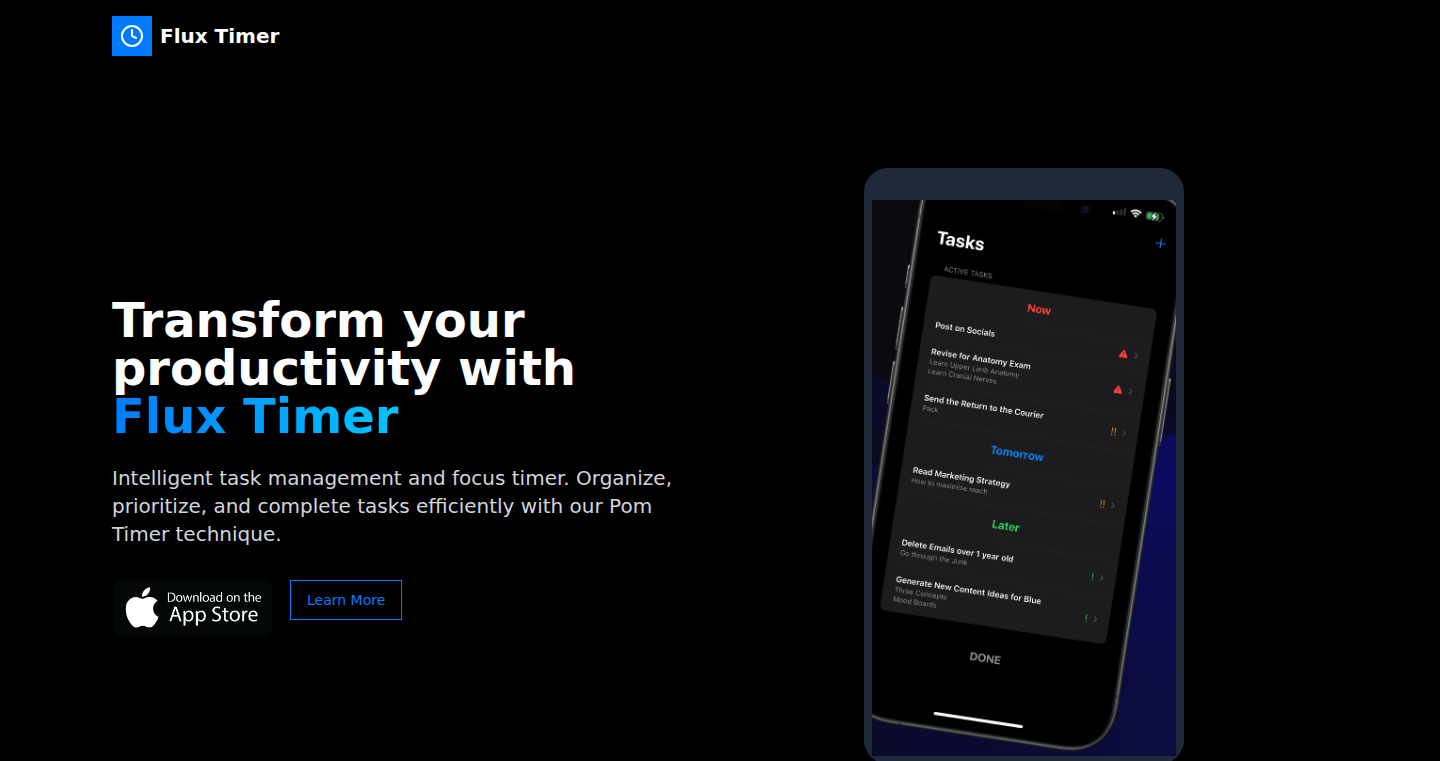
Author
zahirbmirza
Description
FluxTimer is a minimalist task manager combined with a Pomodoro timer, designed to combat task management overload. It prioritizes tasks based on time-based urgency (Today, Tomorrow, Later) rather than complex priority levels. The integration of a focus timer eliminates the need to switch apps, creating a smoother workflow from task selection to focused work sessions. The core innovation lies in its streamlined, three-category system and the direct integration of a focus timer, simplifying the process of getting work done by minimizing decision fatigue.
Popularity
Points 1
Comments 0
What is this product?
FluxTimer simplifies task management by sorting tasks into three urgency categories: Today (urgent), Tomorrow (near-term), and Later (future). This eliminates the mental effort of prioritizing. It then integrates a Pomodoro timer, allowing users to start focused work sessions directly from a selected task. The underlying technology uses a simple database to store and categorize tasks. When a task is marked as 'Today' it shows at the top, and 'Tomorrow' and 'Later' tasks are organized below. This integrated system helps to reduce the cognitive load of task management, so you can focus on the work itself. So, it's a simplified, less overwhelming, and more focused task manager.
How to use it?
Developers can use FluxTimer by downloading it and starting to use it. The core use involves inputting tasks, assigning them to the three urgency categories, and then using the integrated timer to work on the 'Today' tasks. The timer can be customized to fit your preferred work/break intervals. For developers, it's about using a simplified approach to personal productivity that is less distracting than other complex tools. You can directly select a task, start the timer, and begin focused work without leaving the app. The simple interface reduces friction in your workflow.
Product Core Function
· {"applicationScenario":"Useful for any developer who feels overwhelmed by the complexity of their task manager. For example, if you are a developer building a complex application with multiple features, you can categorize the tasks (bugs, features) and the app prioritizes the things you need to deal with first.","functionName":"Three-Category Task Prioritization","technicalValue":"This uses a basic database structure with date-based sorting logic. The core value here is simplicity and usability. The backend is probably not complicated, but the UX is excellent. The value is in making the complex task of managing tasks simple.","description":"Tasks are categorized into Today, Tomorrow, and Later. Tasks due today automatically appear in the 'Today' list. This eliminates the need to manually prioritize, so you will spend less time thinking about what to do and more time doing."}
· {"applicationScenario":"Perfect for developers who want to use the Pomodoro technique. When developing software, use the timer to stay focused during specific coding sessions, then take a break, and restart the focused work, removing any of the distractions and context-switching.","functionName":"Integrated Pomodoro Timer","technicalValue":"The timer function is likely built with a simple JavaScript library or framework for timing and notifications. The main technical value is in the direct integration with task management, making a complete, integrated experience.","description":"A built-in timer allows users to start focused work sessions directly from a selected task, removing the need to switch apps, minimizing distractions and friction."}
Product Usage Case
· {"problem":"Switching between apps disrupts their focus, increasing the time it takes to start a coding session.","solution":"FluxTimer combines task management and a Pomodoro timer. The developer selects a task, starts the timer directly within the app and begins focused work in one place. So it provides a better, more integrated user experience and reduces the mental overhead.","scenario":"A developer is constantly switching between their task manager, and the Pomodoro timer app."}
· {"problem":"They are spending too much time sorting and labeling tasks instead of coding.","solution":"FluxTimer's three-category system quickly sorts tasks by urgency. The developer can focus on the tasks due 'Today', then move to the 'Tomorrow' tasks, and they don't have to spend a lot of time deciding what to do. The reduced complexity and simplified workflow boosts productivity.","scenario":"A developer is overwhelmed by a complex task manager that demands significant time on organizing and categorizing tasks, and not on getting work done."}
60
M3ripple: React Library for Material 3 Ripple Effects

Author
yuyake-litrain
Description
M3ripple is a React library that recreates the visually appealing ripple effect with sparkles, similar to the one introduced in Android 12 and inspired by the Material 3 design system. It addresses the challenge of bringing this dynamic and engaging visual feedback to web applications, enhancing user interaction and providing a modern, polished look. The library provides developers with an easy-to-use component that can be seamlessly integrated into React projects, allowing for a more interactive and visually rich user experience. This project focuses on creating a subtle but effective visual cue for user interaction, moving beyond simple button presses and making the web interface feel more alive and responsive.
Popularity
Points 1
Comments 0
What is this product?
M3ripple is a React library designed to add a dynamic ripple effect with sparkles to web UI elements. It's built to replicate the visual feedback seen in Android's Material Design, particularly the ripple effect. The core innovation lies in its ability to implement this visually complex effect efficiently using React. The developer uses techniques like CSS animations and potentially WebGL (depending on the complexity of the sparkles) to create the visual effect. The library focuses on providing a clean and performant implementation, ensuring the animations don't negatively impact application performance. It's a practical solution to a purely aesthetic problem, making web UIs feel more responsive and modern. So, this makes your website look modern and engaging, and it is also reusable in multiple projects.
How to use it?
Developers integrate M3ripple into their React projects by installing the package using npm or yarn and importing the component into their code. They then wrap UI elements (buttons, icons, etc.) with the M3ripple component to apply the effect. The library is designed to be easy to configure, allowing customization of ripple colors, sizes, and other visual aspects. This allows developers to integrate ripple effects into existing designs without major refactoring. For instance, you can add it to a button by simply wrapping it with `<M3ripple> <button>Click me</button> </M3ripple>`. So, you can quickly and easily enhance your website's visual appeal without writing complex animation code.
Product Core Function
· Ripple Effect Rendering: The core functionality, which generates the ripple effect upon user interaction. This is implemented using CSS animations to create a smooth and visually pleasing effect. This lets your website's buttons and interactive elements react with a cool visual effect when a user clicks or taps them.
· Customization Options: Allows developers to customize the ripple color, size, and other properties to match the design of their website or application. This ensures that the effect fits seamlessly into the overall design and enhances the user experience without looking out of place. So, it ensures that the effect looks great and matches the design of your site.
· Performance Optimization: The library is designed to be performant, ensuring the ripple effect doesn't impact the responsiveness of the application. The developer has optimized the CSS animations or leveraged other techniques to minimize the overhead of rendering the effect, ensuring a smooth user experience. So, your website will look great without slowing down, and users will have a fluid interaction experience.
· Easy Integration: The library is designed to be easily integrated into existing React projects without a steep learning curve. This allows developers to quickly add the ripple effect to their UIs without needing to rewrite or refactor significant portions of their code. So, you can easily add cool animations to your existing website, making it stand out with minimal effort.
Product Usage Case
· Adding Ripple Effects to Buttons: Developers can use M3ripple to enhance the visual feedback of buttons in their web applications. For example, when a user clicks a button, a ripple effect with sparkles appears, providing immediate visual confirmation of the click. This makes the user feel more in control. This improves the user experience by making the buttons more visually appealing and responsive to user interaction.
· Improving Navigation Interactions: M3ripple can be applied to navigation elements like menu items or links. When a user clicks a menu item, a subtle ripple effect can highlight the selected item, offering clear visual feedback and helping the user to understand what's happening in their applications. This enhances the navigation experience and can potentially provide visual feedback within the UI and guide users.
· Enhancing UI Elements in Forms: The ripple effect can be applied to form elements, such as input fields, to indicate focus or activation. When a user taps on an input field, a ripple can appear around it, making the form feel more alive and engaging. This can guide users and offer a more visual feedback in form interactions.
61
HeadTalker: The AI-Powered Talking Head Video Editor

Author
devhustler
Description
HeadTalker is an AI-powered video editor specifically designed for 'talking head' videos – the kind where someone is speaking directly to the camera. The core innovation is its use of AI to automate tedious editing tasks such as removing filler words (like 'um' and 'ah'), creating smooth transitions, and adding dynamic captions. It addresses the common problem of time-consuming video editing and lowers the barrier to creating engaging video content. This simplifies video editing with intelligent automation, saving creators significant time and effort.
Popularity
Points 1
Comments 0
What is this product?
HeadTalker leverages Artificial Intelligence to simplify video editing. It uses AI models trained to identify and remove filler words, create clean cuts, and automatically generate synchronized captions. Think of it as having an AI editor that does the grunt work for you. It's an innovative approach because it automates tasks that previously required manual editing, making video creation much faster and easier, even for those with little to no editing experience. So this leverages AI to handle tedious video editing tasks, and the result is a simpler, easier, and faster video editing experience.
How to use it?
Developers can use HeadTalker through a simple interface, likely by uploading their video. The AI then processes the video, performs the editing tasks automatically, and provides a final, edited version. This project could be useful for developers looking to integrate automated video editing into their own applications, perhaps through an API integration. So, if you're developing a platform that involves video, you can integrate HeadTalker’s AI capabilities. It can be integrated to an API, or other video editing software to get the automated functions.
Product Core Function
· {"functionName":"Automatic Filler Word Removal","description":"The AI identifies and removes common filler words like 'um', 'ah', and pauses. This produces a cleaner, more professional-sounding video. So this provides a more streamlined viewing experience, reducing distractions and improving the overall quality of the video content."}
· {"functionName":"Intelligent Cut Creation","description":"The AI analyzes the video and creates smooth, natural transitions between sentences and ideas, removing dead air and awkward pauses. So this allows video creators to focus on content creation, rather than laboring over the precise cut points."}
· {"functionName":"Automated Captioning","description":"The AI automatically generates synchronized captions for the video, improving accessibility and viewer engagement. So this significantly improves video accessibility for people who are hard of hearing and also makes it easier to consume video content in silent environments."}
· {"functionName":"Speech-to-Text Transcriptions","description":"Provides the functionality to automatically generate the text of the video. So this helps to quickly create transcripts from the videos to use the text for the different purposes."}
Product Usage Case
· {"scenario":"Educational Content Creation","description":"A teacher or educator wants to create video lessons. They can upload the video to HeadTalker, which automatically removes filler words, creates clean cuts, and adds captions, significantly shortening the time it takes to produce polished educational videos. So it makes creating educational videos faster and more professional, saving educators valuable time."}
· {"scenario":"Marketing Video Production","description":"A small business owner needs to create marketing videos but lacks editing expertise. HeadTalker automates the editing process, allowing them to quickly produce engaging videos for their website or social media. So it allows non-technical users to produce professional videos for their marketing efforts quickly and easily."}
· {"scenario":"Developer Documentation Videos","description":"Developers can use it to create documentation videos that automatically removes the filler words and generates the subtitles for those videos. So it helps to have better quality videos for their developer community."}
62
SolarScope: AI-Powered Solar Potential Analyzer
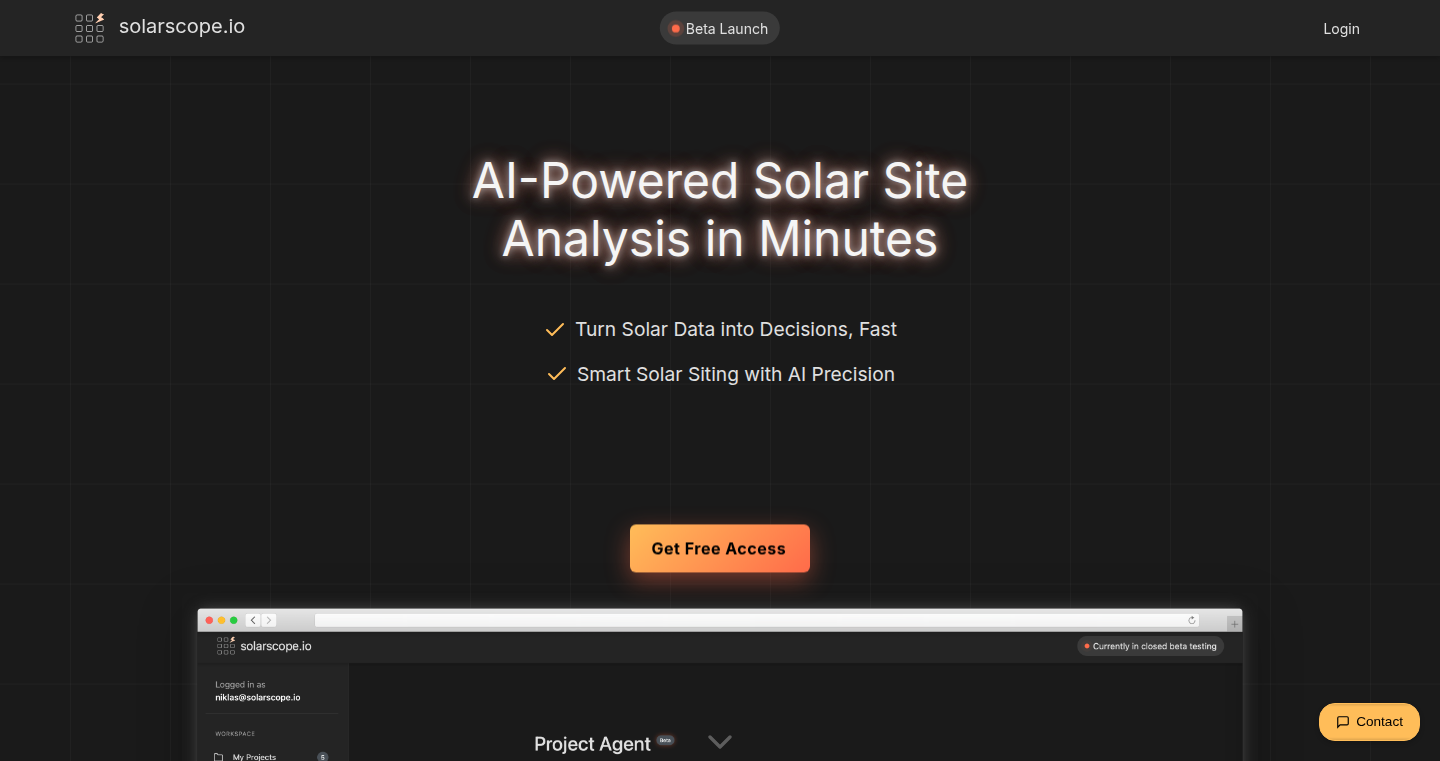
Author
niklaslissjos
Description
SolarScope is a tool that analyzes solar energy potential for any location worldwide. It combines NASA satellite data with AI to provide insights for solar developers and engineers. The core innovation lies in using AI to interpret and understand complex NASA data, offering a user-friendly interface and natural language analysis capabilities. It tackles the problem of making complex solar irradiance data accessible and understandable for non-experts. So this allows you to quickly assess solar potential without needing to be a data scientist.
Popularity
Points 1
Comments 0
What is this product?
SolarScope uses data from NASA satellites, which has been collecting information about the sun's energy for over 20 years, and uses AI to make sense of this data. It transforms raw data into actionable insights. It is built using Python/Flask for the backend, NASA's POWER API for solar irradiance data and OpenAI for natural language analysis. The AI helps interpret the raw numbers and present them in a clear and concise format, so users can easily understand how much solar energy is available in a specific location. This is an innovation because it simplifies a complex process with AI and provides a more intuitive user experience. So this helps you understand the solar energy situation in any location, even if you're not a solar energy expert.
How to use it?
Developers can use SolarScope by visiting the website and entering a location. They can then see information regarding solar irradiance, which is then interpreted by the AI to produce data on solar energy potential. They can also use the chat functionality to ask specific questions. SolarScope can be used in various contexts. It can be integrated into other applications through API access. So this allows you to quickly find solar energy potential and analyze it to start building a solar panel farm or to decide the best location to start one.
Product Core Function
· {"functionName":"Location-Based Solar Irradiance Analysis","techValue":"Leverages NASA's POWER API to access and process historical solar irradiance data. Uses a backend built with Python/Flask to handle data requests and provide the results. This provides a centralized information hub for solar energy potential.","description":"This feature allows users to input a location and get detailed information about solar energy potential for that area, calculated from NASA satellite data. It presents the data in a user-friendly format, making it easy to understand. So this lets you analyze the solar potential of any location, helping you decide on the best placement for your solar panels."}
· {"functionName":"AI-Powered Insight Generation","techValue":"Integrates OpenAI's natural language processing capabilities to provide insights from complex datasets. This approach simplifies data interpretation and user interaction, turning complex data into useful information and analysis.","description":"This is the core innovation. The system uses AI (OpenAI) to analyze the raw data and provide human-readable insights and summary reports. The AI also powers a chat function, allowing users to ask specific questions about solar potential. So this helps you understand the raw data and make accurate assumptions without being a data scientist."}
· {"functionName":"User-Friendly Interface","techValue":"Uses a clean dashboard design built with Flask. Aims to provide a simple interface for users to easily interact with complex datasets. This simplifies the process of assessing solar potential.","description":"The tool's interface is designed to be intuitive, allowing users to easily navigate and understand the information presented. It provides a clear dashboard with AI-powered insights. So this helps you quickly access and understand complex solar potential data, without having to deal with complicated graphs or spreadsheets."}
Product Usage Case
· {"scenario":"Solar Farm Planning","description":"A solar developer is planning to build a new solar farm. They can use SolarScope to analyze different locations and determine the areas with the highest solar potential, helping them maximize the farm's energy output. So this will help you make sure you are maximizing the efficiency of your solar farm and get the most energy possible.","technicalBenefit":"Utilizing NASA's data combined with AI insights provides developers with quick access to important data for solar farm projects."}
· {"scenario":"Property Assessment","description":"A homeowner is considering installing solar panels. They can use SolarScope to assess the solar potential of their property and determine if solar panels are a viable option, thus saving the home owner time and money. So this will help you to make the best choice for your house.","technicalBenefit":"Provides instant analysis of any location, empowering homeowners and businesses to make informed decisions about solar energy adoption."}
63
WebTableExtractor: Image-to-JSON for Dynamic Tables
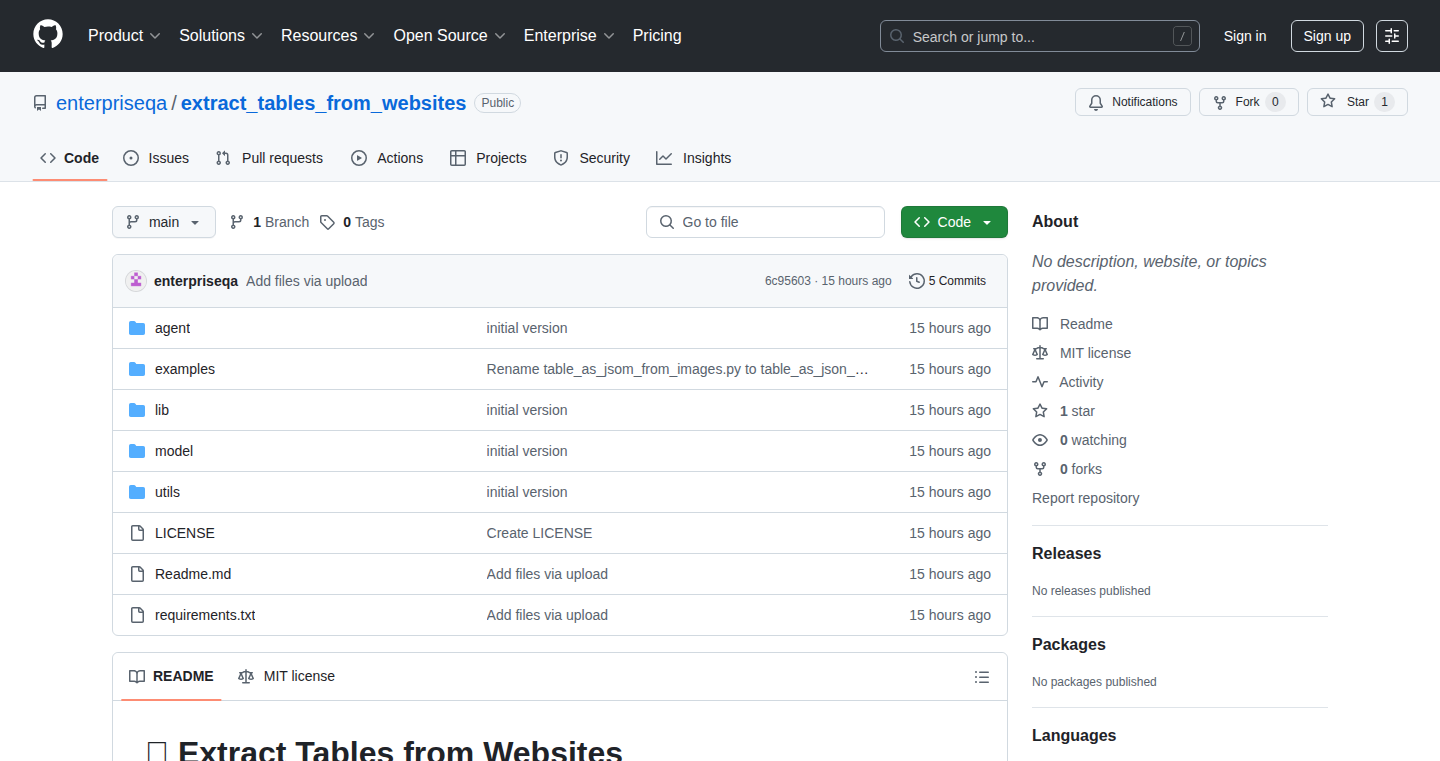
Author
valliappanr
Description
WebTableExtractor is a two-step open-source tool designed to extract tables from any website, even those that are notoriously difficult to parse. It cleverly bypasses the limitations of traditional HTML parsing by first capturing tables as images using a 'headless' browser (a browser that runs in the background). Then, it uses Optical Character Recognition (OCR) to convert these images into structured JSON data. This approach is particularly valuable when dealing with complex website designs, dynamically rendered content, and tables with merged cells or intricate styling. So, it’s useful for anyone who needs data from the web, regardless of how challenging the website is.
Popularity
Points 1
Comments 0
What is this product?
WebTableExtractor addresses the problem of inconsistent table extraction from websites. Its secret sauce is the combination of image capture and OCR. First, it uses a 'headless browser' (think of it as a robot browser) to visit the website and take a picture of the tables. This is essential for handling websites that use fancy techniques (like JavaScript) to build their tables, which often confuse regular parsing tools. Second, it uses OCR, which is like magic for text. It reads the text from the picture of the table and converts it into organized JSON data, a format that's easy for computers to understand and work with. This method allows extracting tables from websites where standard HTML parsing fails because of dynamic rendering or complex styling. So, it solves the problem of needing to extract data from websites that intentionally make it difficult.
How to use it?
Developers can integrate WebTableExtractor into their projects through its open-source code available on GitHub. The basic process involves sending the website URL to the tool, which then outputs the extracted table data in JSON format. This JSON data can then be easily used in various applications, like data analysis tools, databases, or other web services. The project includes example uses to provide guidance. So, it empowers developers to automate data extraction from websites, saving time and effort in data acquisition.
Product Core Function
· {"functionName":"Headless Browser Table Capture","description":"This function uses a headless browser to take screenshots of tables on a webpage. This is crucial because it allows the tool to see the website as it appears to a user, including any content generated with JavaScript. So, it's useful when you need data from sites that dynamically render their tables.","value":"Capturing tables as images ensures the tool can handle websites that use complex styling, merged cells, or dynamic content. This method preserves the visual layout and accurately extracts the table data regardless of how it is built on the website."}
· {"functionName":"OCR-Based Data Conversion","description":"This function takes the image of the table and uses OCR to convert it into a structured JSON format. OCR analyzes the image, recognizes text, and organizes it into rows and columns. So, it transforms the visual representation of a table into a usable data format.","value":"By leveraging OCR, the tool avoids the limitations of HTML parsing. This enables extracting accurate data even from websites with unusual table structures or rendering techniques, creating a data-ready format for applications."}
Product Usage Case
· {"solution":"The tool captures the table as an image, uses OCR to extract the data, and delivers the organized table data in JSON for quick use in any data analysis software.","scenario":"Data Scraping for Research","description":"A researcher needs data from a website that displays financial statistics in a complex table format. Using WebTableExtractor, they can automatically extract the data, format it, and import it into their research analysis tool. So, it helps researchers efficiently gather data for their studies."}
· {"solution":"WebTableExtractor can be scheduled to scrape data from the websites regularly. The JSON output is then parsed, formatted, and input into an automated reporting system.","scenario":"Automated Report Generation","description":"A marketing team wants to monitor competitor pricing from multiple websites. By running WebTableExtractor periodically, they can automatically extract the price data and use it to generate reports. So, it facilitates automating competitive analysis."}
64
Contextual File Manager with MCP Integration
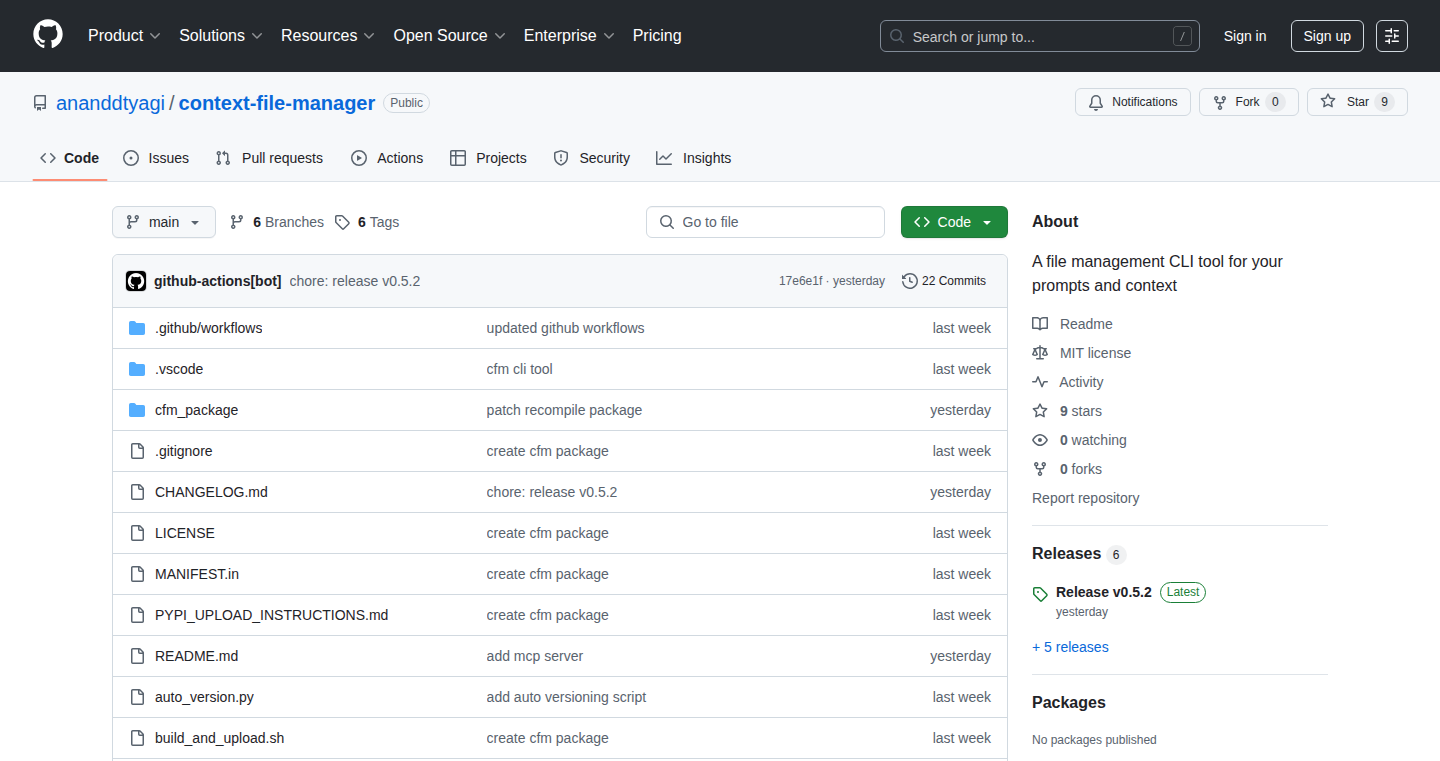
Author
ananddtyagi
Description
This project is a 'context file manager' designed to easily share and manage important documentation and instructions (context files) across different software projects. The innovation lies in its integration with tools like Claude Code, Claude Desktop, and Cursor through a feature called 'MCP'. This means you can directly access and update your documentation right within your coding or writing environment. This solves the common problem of repeatedly copying and pasting the same instructions and documentation across different projects, streamlining your workflow.
Popularity
Points 1
Comments 0
What is this product?
This is a tool that acts as a central hub for your project documentation and related files. It uses a 'context file' approach, meaning you store information like project instructions, GitHub workflow details, or even specific prompts for AI tools like Claude. The integration with MCP (likely a method to facilitate communication) allows you to connect this file manager directly to your coding and writing environments. So, instead of manually transferring files, you can quickly save, fetch, and update your essential information. So, this is useful because it centralizes your information and integrates it directly where you need it.
How to use it?
Developers would use this by installing the context file manager (the exact method isn't specified, but likely through package managers or direct download). Once installed, you would store your context files within the manager. Then, by connecting the manager to tools like Claude Code or Cursor using the MCP, you can seamlessly retrieve and update these files while you are working on your code. For example, when working on a new feature, you can easily pull in the relevant project instructions stored in a context file. So, you can avoid searching through multiple locations to find what you need.
Product Core Function
· {"function":"Context File Storage and Organization","description":"The core function is storing and organizing all your project-related documents. This might use a folder structure or a specific indexing system. This is valuable because it creates a single, well-organized place for all essential documentation, making it easy to find and reuse information.","value":"So this is useful for keeping all the info you need in one place, rather than scattered across different locations."}
· {"function":"MCP Integration with Coding/Writing Environments","description":"The key innovation. The MCP allows the file manager to be directly integrated with tools like Claude and Cursor. This integration likely allows you to easily insert, retrieve, and update content from your context files within those tools. This might involve API calls or plugins that allow you to work on information as you type.","value":"So this saves you a lot of time by removing the need to manually copy and paste, or switch back and forth between applications."}
· {"function":"File Sharing and Collaboration","description":"While not explicitly stated, the file manager likely supports easy sharing of context files among team members. This would likely be implemented through common file sharing tools or methods.","value":"So you can easily share key documents with your team, ensuring everyone has the most up-to-date information."}
Product Usage Case
· {"scenario":"Software Project Onboarding","description":"A new developer joins a project. Instead of searching through multiple documents to get up to speed, they can directly access a context file with the project’s setup instructions, coding style guide, and API documentation directly within their coding environment (e.g., Cursor). This way they get the information immediately available, making the onboarding process significantly faster.","value":"So, this helps new team members quickly get up to speed without long onboarding processes."}
· {"scenario":"AI Prompt Engineering","description":"A developer is using Claude (or a similar AI tool) to generate code or documentation. They store prompt templates, and specific project instructions within context files. The MCP integration allows them to quickly access and modify these templates in Claude, enabling them to use AI efficiently to create better code.","value":"So this gives you a great way to quickly customize and use AI tools for writing code or other documentation."}
· {"scenario":"Cross-Project Documentation Reuse","description":"A developer working on multiple projects. They have some standard configurations they use. They store those configurations in context files within the manager and connect the manager to each coding environment. The developer can reuse documentation easily among the various projects, without having to create them from scratch.","value":"So you can reuse important project documentation across different projects."}
65
Cadence Sync – Personalized Music-Driven Running
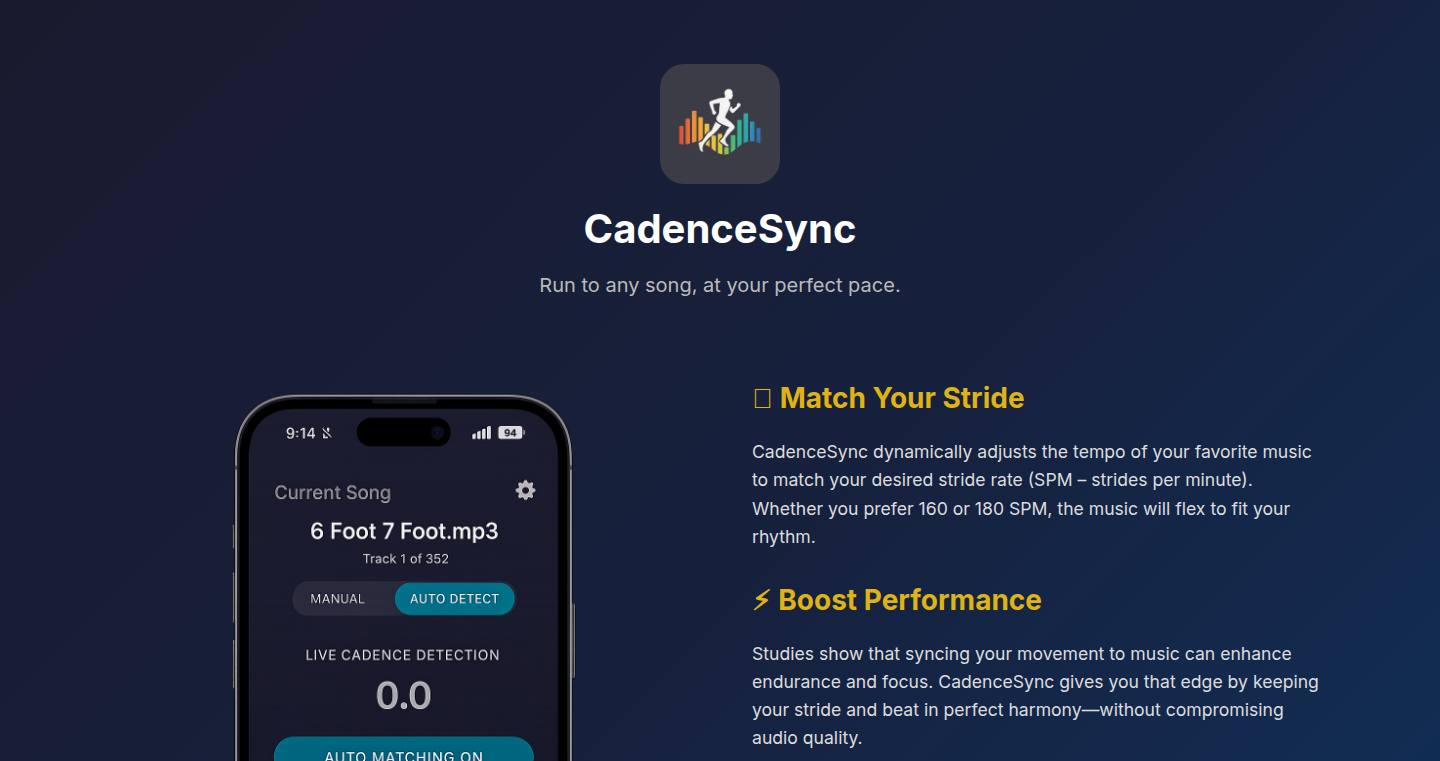
Author
EddieLomax
Description
Cadence Sync is an app designed to match the tempo of any song to your perfect running pace. It tackles the common problem of songs not perfectly aligning with your desired running cadence. It analyzes the song's beats per minute (BPM) and adjusts the playback speed, allowing you to run in sync with any track, eliminating the need to search for songs at the exact right tempo. This leverages audio analysis techniques for real-time tempo adjustment, offering a personalized and optimized running experience.
Popularity
Points 1
Comments 0
What is this product?
Cadence Sync uses audio analysis to identify a song's beats per minute (BPM). Think of BPM as the song's tempo, how fast or slow it is. The app then lets you set your ideal running cadence, measured in steps per minute. The app will then subtly speed up or slow down the music in real-time to match your desired pace. The innovative part is that it works with *any* song, and does so dynamically – it's like having a personal music DJ for your runs! So this is a bit like having a smart music player tailored just for your running.
How to use it?
Runners can use Cadence Sync by simply uploading or selecting a song from their library. They then input their target running cadence (e.g., 170 steps per minute). The app does the rest, adjusting the song's tempo on the fly to match their pace. For developers, this implies an API or SDK could emerge, where you can integrate this tempo-matching technology into other fitness apps or music players. For example, imagine integrating with a fitness tracker that automatically adjusts music based on your heart rate or distance covered. So, you can control your running tempo by the music tempo.
Product Core Function
· {"feature":"Real-time BPM Analysis","description":"The core technology analyzes the audio of a song to determine its BPM. This involves sophisticated algorithms that identify the rhythmic patterns within the music. This lets the app know how fast the song is. So, it understands the music.","value":"Provides the fundamental data needed to synchronize the music with the runner's cadence. You no longer need to choose your music according to tempo, the music is adapted for you."}
· {"feature":"Dynamic Tempo Adjustment","description":"The app adjusts the playback speed of the song to match the user's target cadence. This is where the magic happens, using time-stretching or pitch-shifting techniques, so that the song sounds good at a different tempo. So, the music adapts to your pace.","value":"Enables a seamless running experience where the music complements the runner's pace, enhancing motivation and performance. The runner gets the right beat at the right moment."}
· {"feature":"User-Defined Cadence Setting","description":"Allows users to input their desired running cadence. The app can change the tempo to match the runner's choice. So, you can set the tempo.","value":"Personalizes the running experience, catering to individual preferences and training goals. This is highly customizable, for personalized experiences."}
Product Usage Case
· {"scenario":"Integration with Fitness Trackers","problemSolved":"Provides real-time music synchronization based on physiological data, enhancing the training experience. The music becomes a part of the fitness app.","description":"Imagine a fitness app that automatically adjusts the music tempo based on your real-time running speed or heart rate, determined by your fitness tracker. If your heart rate is too low, or the speed is too slow, the music will increase its BPM for better motivation. So the technology can be applied in a vast set of applications."}
· {"scenario":"Customized Workout Music","problemSolved":"Provides a consistent and dynamic audio experience without having to switch between playlists or look for songs with the right tempo.","description":"A runner wants to warm up to a slower pace and then gradually increase the tempo. Cadence Sync allows a single playlist to shift in tempo to match the training plan. So, you can automatically change the tempo of your music."}
66
JSXSpreadsheet - Declarative Spreadsheet Generation with JSX

Author
xkjyeah
Description
JSXSpreadsheet is a clever tool that lets you create spreadsheets using a very familiar technology: JSX, the way you build user interfaces in React and other modern JavaScript frameworks. Instead of wrestling with complex spreadsheet libraries, you can define your spreadsheet's structure and data in a clean, declarative way using JSX components. This solves the common problem of generating spreadsheets from JavaScript, which often involves tedious manual formatting and data mapping. Essentially, it's like writing HTML to build your spreadsheet!
Popularity
Points 1
Comments 0
What is this product?
JSXSpreadsheet leverages the power of JSX to provide a declarative way to define spreadsheets. It works by allowing you to write JSX code (the same code you'd use to build a website's interface) to represent your spreadsheet's structure (rows, columns, cells). The library then translates this JSX into a spreadsheet file (like Excel's .xlsx). This is a big win because: 1) JSX is generally easy to learn and use. 2) It lets developers focus on the *what* (the data and structure) instead of the *how* (complex library calls). 3) It improves code readability and maintainability. This uses custom renderers under the hood, efficiently translating your component tree into spreadsheet elements. Think of it as writing code that says 'I want a table with this data' instead of 'now, go find the spreadsheet library, and manually create these cells...'. So this is a powerful way to generate spreadsheets using code you probably already know.
How to use it?
Developers use JSXSpreadsheet by importing the library into their JavaScript projects and then writing JSX code to define their spreadsheet. You structure your spreadsheet using JSX components, similar to how you would create a table in HTML. You specify rows, columns, and cell data. You then use the library to export the defined structure to a spreadsheet file format. You can integrate it into any project that needs dynamic spreadsheet generation, such as: data reporting tools, generating reports from a database, exporting data from your application, creating complex financial models programmatically. So, if you need to automate the creation of spreadsheets, this is for you.
Product Core Function
· {"name":"Declarative Spreadsheet Definition with JSX","description":"The core feature: allows you to define spreadsheet structure and data using JSX. This provides a simple, intuitive, and readable way to represent spreadsheets within your JavaScript code. It abstracts away the low-level details of spreadsheet libraries, meaning you focus on what your spreadsheet needs to contain. This drastically reduces the complexity of generating spreadsheets.","value":"So this means less time spent wrestling with complex APIs and more time spent on your application's core logic. It makes your code cleaner and easier to understand."}
· {"name":"Custom Renderers for Spreadsheet Generation","description":"JSXSpreadsheet uses custom renderers to transform your JSX component tree into a spreadsheet structure. The system intelligently translates your component definitions (like `<Row>`, `<Cell>`) into the appropriate spreadsheet file formats (like .xlsx). This handles the file generation behind the scenes. The custom renderers handle the complicated parts of the process.","value":"So this means you don't need to worry about the technical intricacies of spreadsheet file formats. The tool handles it for you, reducing your coding workload and making your life easier."}
· {"name":"Data Binding and Dynamic Updates","description":"You can easily bind spreadsheet data to your application's data sources. When your data changes, the spreadsheet automatically updates. This facilitates dynamic report generation, live data feeds, and personalized reports for users. You can get your spreadsheet updated to match your application's current state easily.","value":"So this enables your application to automatically generate reports that always reflect the current state of your data. This means your reports are always up-to-date and accurate."}
Product Usage Case
· {"scenario":"Automated Financial Reporting","techSolve":"So this automates the report generation process, removing manual data entry and formatting. It also guarantees consistency and accuracy of the data.","description":"A financial application generates monthly reports. JSXSpreadsheet is used to define the structure of the reports and to bind data from the financial database. When a new month's data is available, the system automatically updates and generates the reports without manual intervention. This significantly speeds up report generation and ensures data consistency."}
· {"scenario":"Data Export from a Web Application","techSolve":"So this simplifies data export, providing users with a convenient way to get data out of the application in a commonly-used format.","description":"A web application allows users to create and manage customer lists. With JSXSpreadsheet, the developers enable a button to export customer data to an Excel file. When the user clicks the button, the app generates a well-formatted spreadsheet with all the customer details. This gives users an easy way to download and share data."}
· {"scenario":"Generating Dynamic Sales Dashboards","techSolve":"So this eliminates the need to manually create and update sales reports. It helps users easily see and understand key sales performance indicators.","description":"A sales team needs up-to-date sales performance data. Using JSXSpreadsheet, you define the layout of a sales dashboard report, including charts and key metrics. The tool then automatically pulls data from a sales database and renders it into an Excel file that can be readily shared and visualized."}
67
Typit.in: The Ephemeral & Effortless URL Sharer

url
Author
afrieirham
Description
Typit.in is a temporary URL shortener designed for quick, hassle-free link and file sharing. It addresses the problem of sharing links between devices without requiring accounts or complex setups. The core innovation lies in its ease of use – generating short, memorable URLs that are ideal for scenarios where speed and simplicity are paramount, like sharing links in a classroom or during presentations. It also supports file and note sharing, offering a more comprehensive solution for temporary content distribution. The ephemeral nature of the URLs ensures privacy and avoids the clutter of permanent short links. It's open-source, demonstrating the core hacker value of sharing and collaborative development.
Popularity
Points 1
Comments 0
What is this product?
Typit.in is a web-based service that creates short, easy-to-type URLs for sharing links, files, and notes. It works by taking a long, complex URL (like the one for a Google Slides presentation) and creating a much shorter one (e.g., typit.in/abc123). The innovation is in its simplicity and temporary nature. Unlike many URL shorteners that require sign-ups and create permanent links, Typit.in generates temporary URLs that are easy to remember and type, perfect for scenarios requiring immediate sharing without long-term storage. The technology behind it likely uses a database to store mappings between the short and long URLs, along with a mechanism to automatically delete the mappings after a certain time. The file upload and note-sharing features further expand its utility, using a similar principle of temporary storage.
How to use it?
Developers can use Typit.in for quickly sharing links within their teams, during presentations, or for temporary file sharing. You simply paste your link, file, or note into the service, and it generates a short, easy-to-type URL. Then, you share that URL with whoever needs it. For example, if a developer needs to quickly share a code snippet with a colleague during a remote debugging session, Typit.in provides a fast and convenient way to do so. The service is accessible through a web browser, making it platform-agnostic. The open-source nature allows developers to inspect the code, contribute to the project, or even host their own instance with custom settings.
Product Core Function
· {"applicationScenario":"Sharing a long URL for a project management document during a meeting where attendees need to manually type the URL.","functionName":"URL Shortening","technicalValue":"Addresses the usability challenges of complex, lengthy URLs, improving shareability, especially in environments where manual typing is necessary. Reduces potential for errors and increases efficiency.","description":"Generates short, easy-to-type URLs from longer ones. Uses a database to map the short URL to the original link and manages their lifetime."}
· {"applicationScenario":"Sharing a presentation file with a classmate from a device that doesn't have direct connection.","functionName":"File Upload","technicalValue":"Provides a convenient and ephemeral file-sharing mechanism, eliminating the need for email attachments or cloud storage links that can persist indefinitely.","description":"Allows users to temporarily upload and share files via generated short URLs."}
· {"applicationScenario":"Sharing a to-do list during a group study session.","functionName":"Note Sharing","technicalValue":"Streamlines the process of sharing text-based information, enhancing collaboration in scenarios requiring quick exchange of information without permanent storage.","description":"Enables the sharing of notes with a generated short URL, making simple temporary sharing of text content easy."}
· {"applicationScenario":"Sharing private information, such as a password, for quick access.","functionName":"Ephemeral URLs","technicalValue":"Ensures privacy by limiting the lifespan of shared links and content, reducing the risk of unintended exposure or access.","description":"URLs and content are temporary and are likely automatically deleted after a certain time or when they are not needed anymore."}
Product Usage Case
· {"scenario":"Classroom Collaboration","problemSolved":"Eliminates the need for account logins or more complex sharing methods, allowing faster sharing.","description":"A student needs to share a Google Slides presentation with the teacher's computer during a class. They use Typit.in to generate an easy-to-type URL, which they can quickly input on the teacher's computer without needing to sign in or use an email address."}
· {"scenario":"Quick Code Sharing","problemSolved":"Facilitates rapid, secure link sharing without signup, improving the speed of team collaboration.","description":"A developer quickly shares a URL to a small code snippet from a local environment to a teammate using Typit.in. No setup, just paste, share, and the receiver can access the link directly."}
· {"scenario":"Temporary File Transfer","problemSolved":"Bypasses the complexity of cloud storage access, providing a quick and clean method of temporary sharing.","description":"A user quickly needs to transfer a document to someone nearby without cloud storage. They upload the document to Typit.in and share the short URL generated."}